My most current blog entry:
Entries in Boats (36)
Chachoengsao: A Daytrip East of Bangkok
 Sunday, December 17, 2017 at 1:52PM
Sunday, December 17, 2017 at 1:52PM 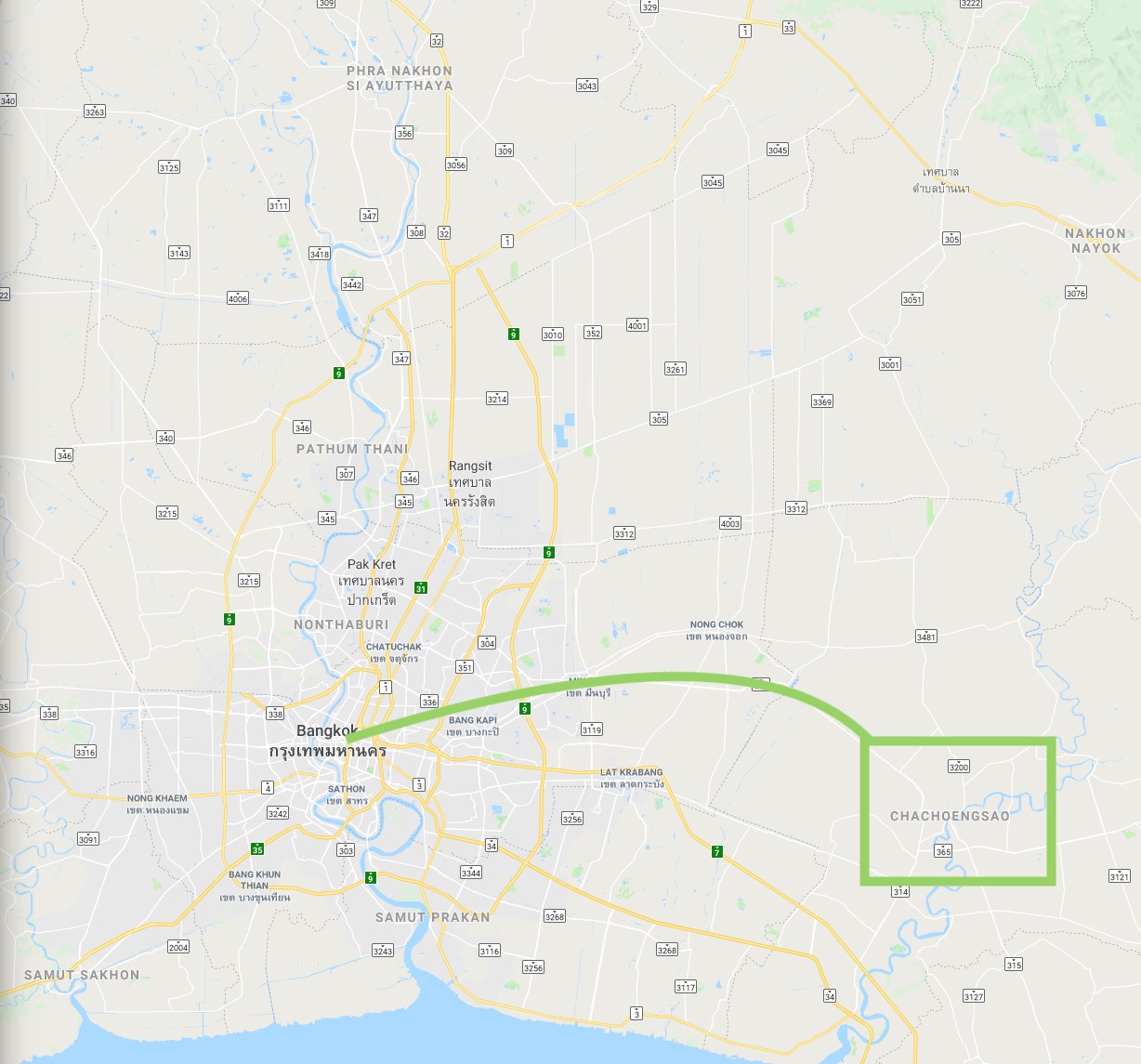 Although the city/region of Chachoengsao is not far from Bangkok, I had never visited this part of Thailand in the 20+ years I have lived here.
Although the city/region of Chachoengsao is not far from Bangkok, I had never visited this part of Thailand in the 20+ years I have lived here.
PART ONE: A RURAL ANCIENT MARKET
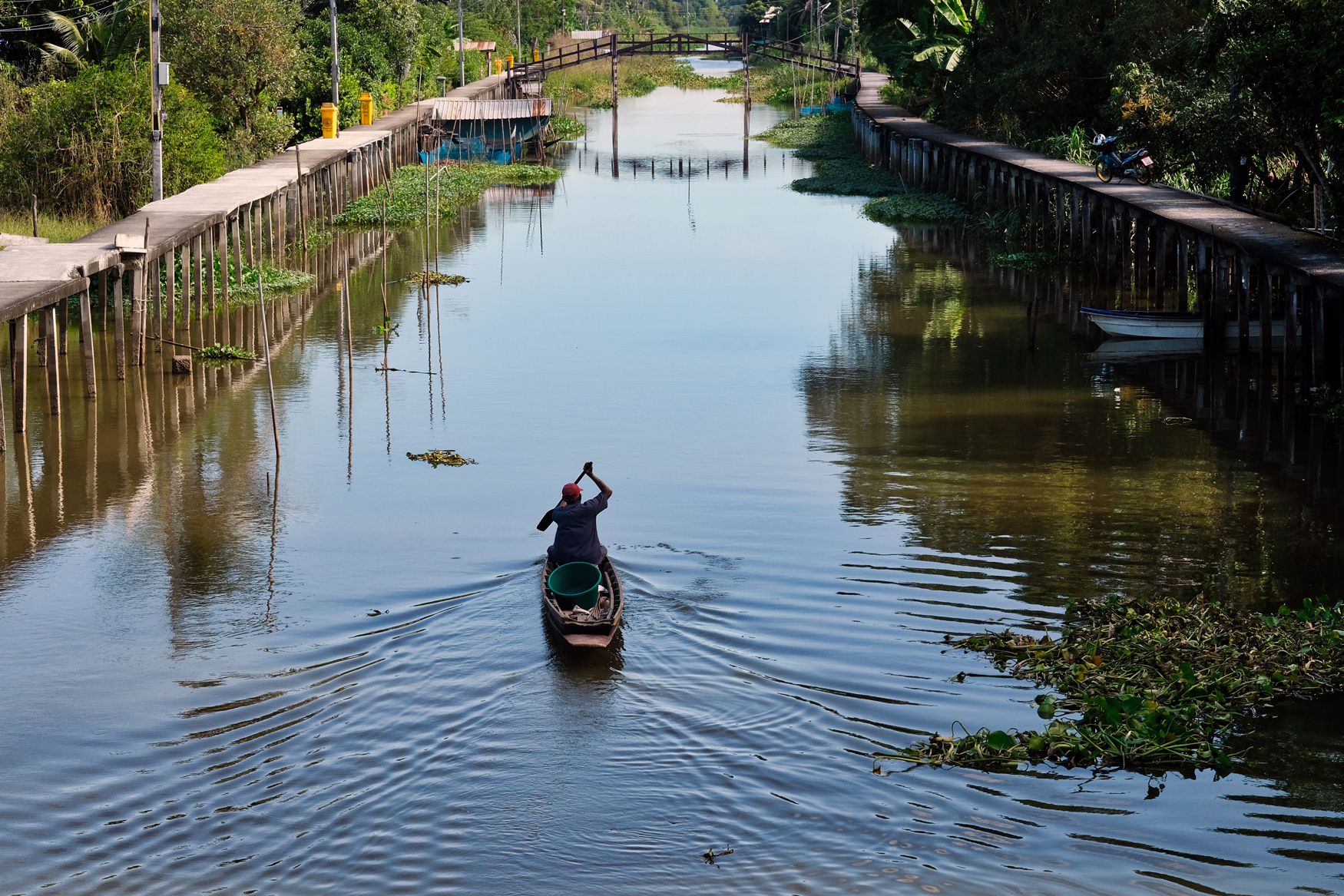 Our first stop, based on a roadside sign, was to the Chachoengsao Ancient Market.
Our first stop, based on a roadside sign, was to the Chachoengsao Ancient Market.
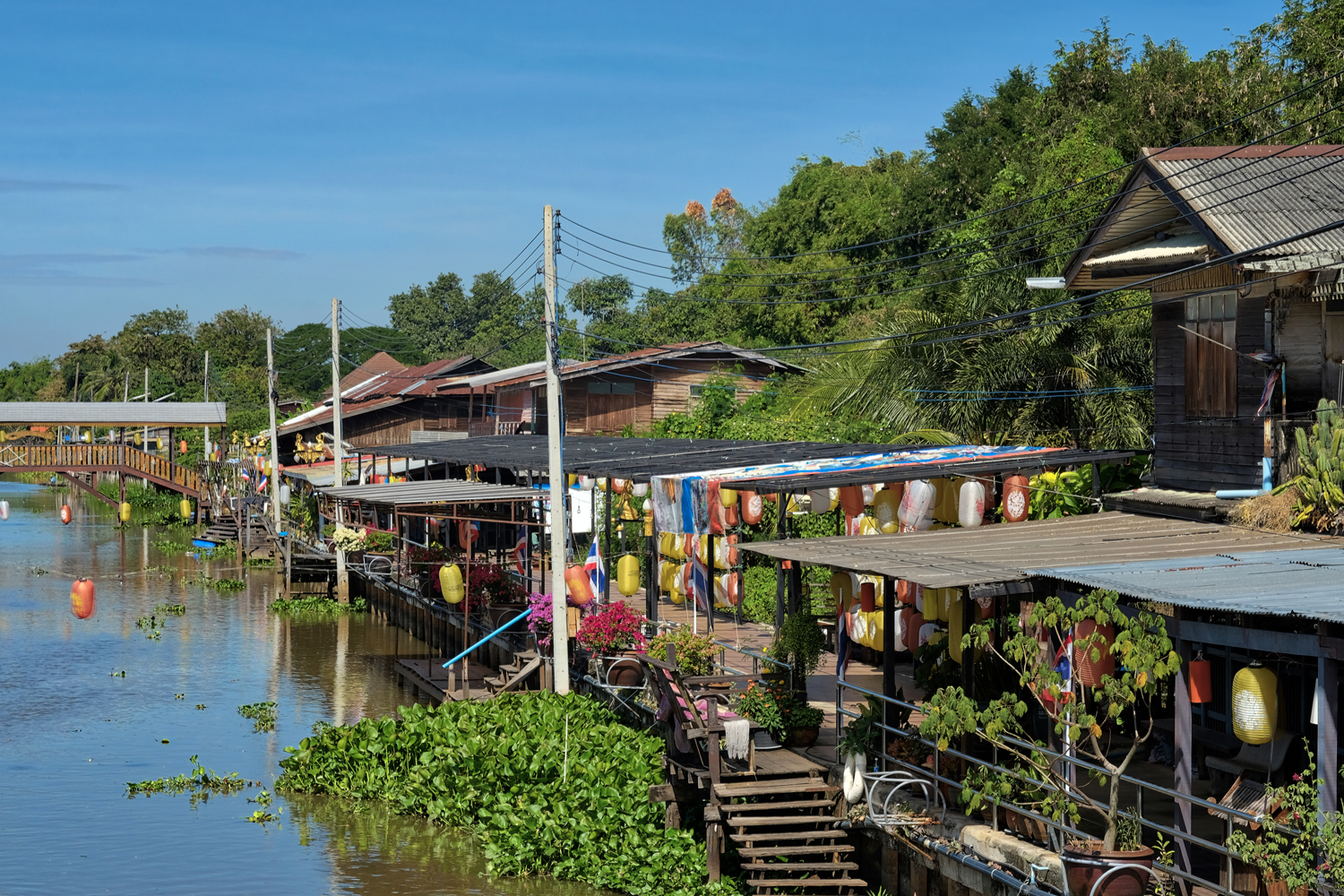 The market is on a klong system which has many old houses alongside.
The market is on a klong system which has many old houses alongside.
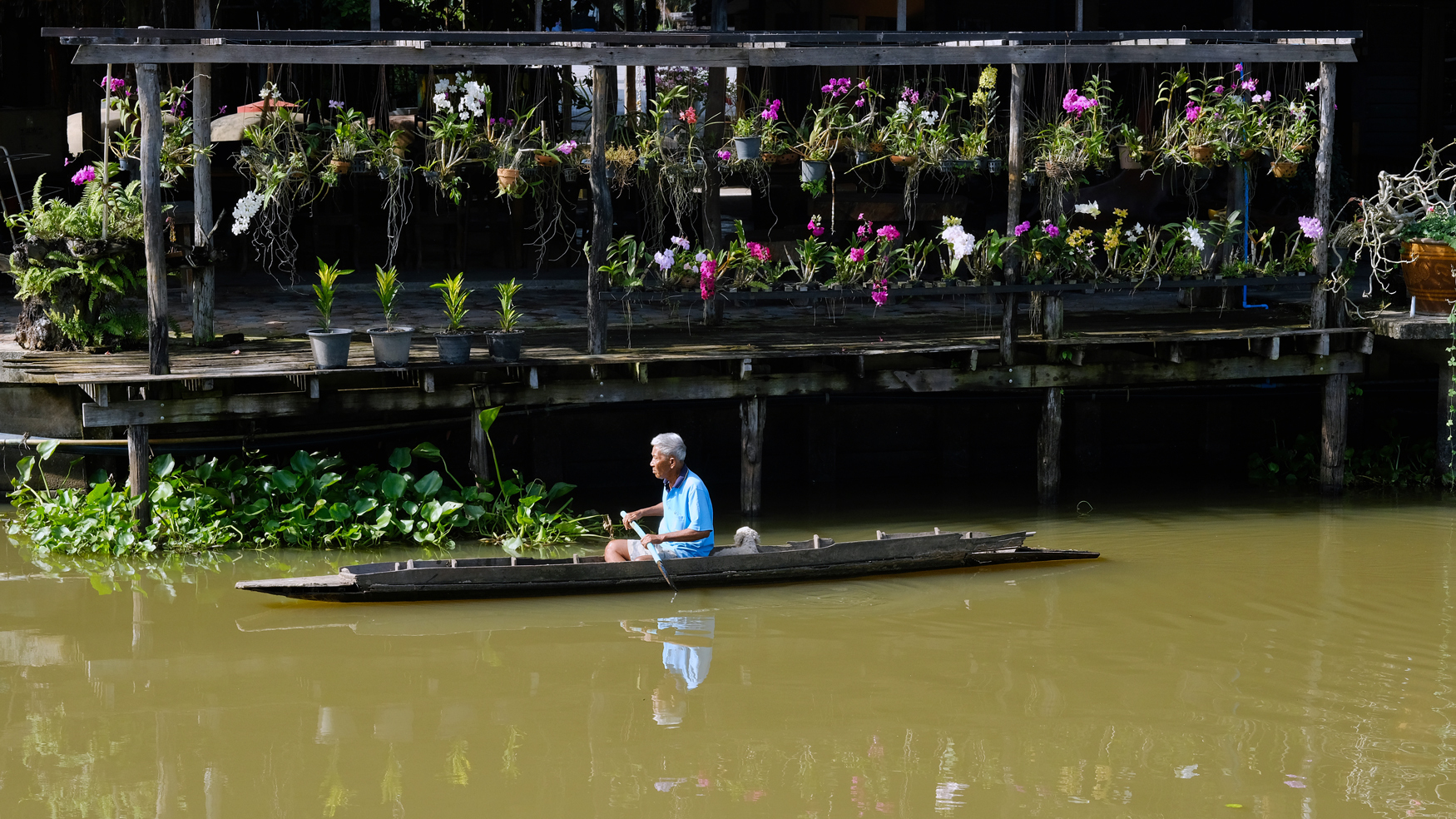 This very photogenic fisherman and his dog appeared as if from nowhere . . .
This very photogenic fisherman and his dog appeared as if from nowhere . . .
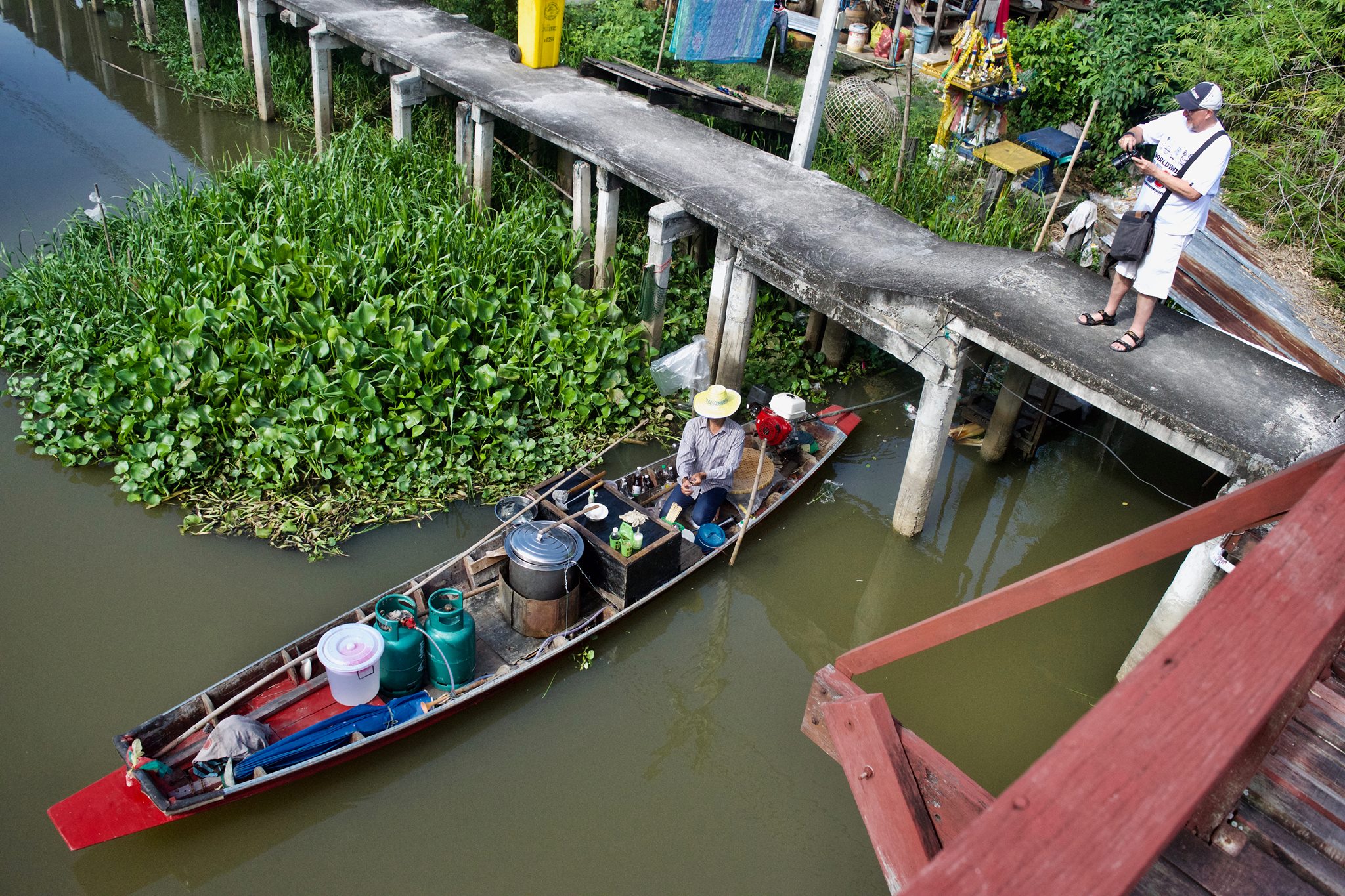 My friend John Stiles went with me on this ramble . . . and took this photo of me enjoying myself and my new Fuji X-T2 camera.
My friend John Stiles went with me on this ramble . . . and took this photo of me enjoying myself and my new Fuji X-T2 camera.
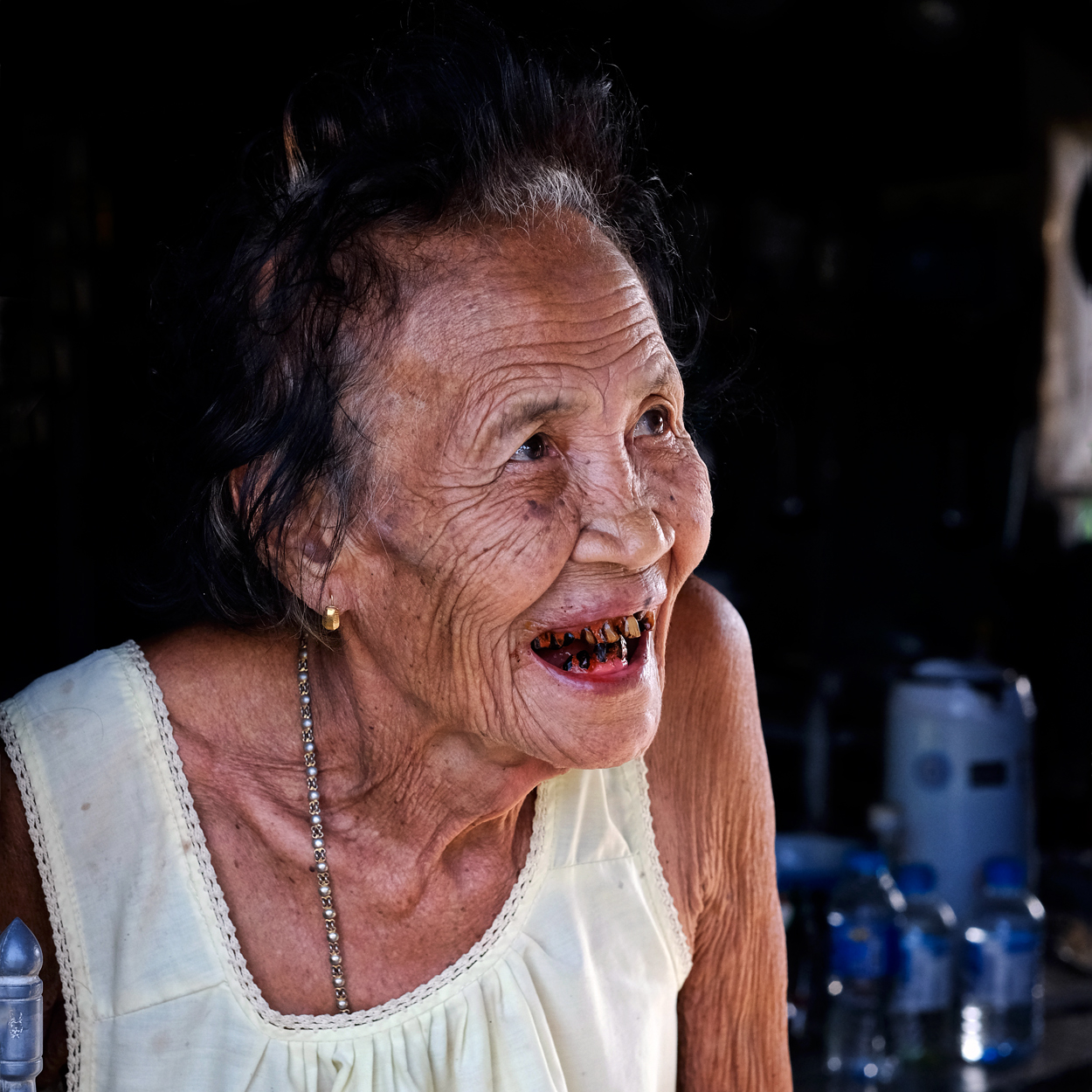 82 years old and a regular betel-nut user . . . she was very glad to chat with us while she visited her friend next door.
82 years old and a regular betel-nut user . . . she was very glad to chat with us while she visited her friend next door.
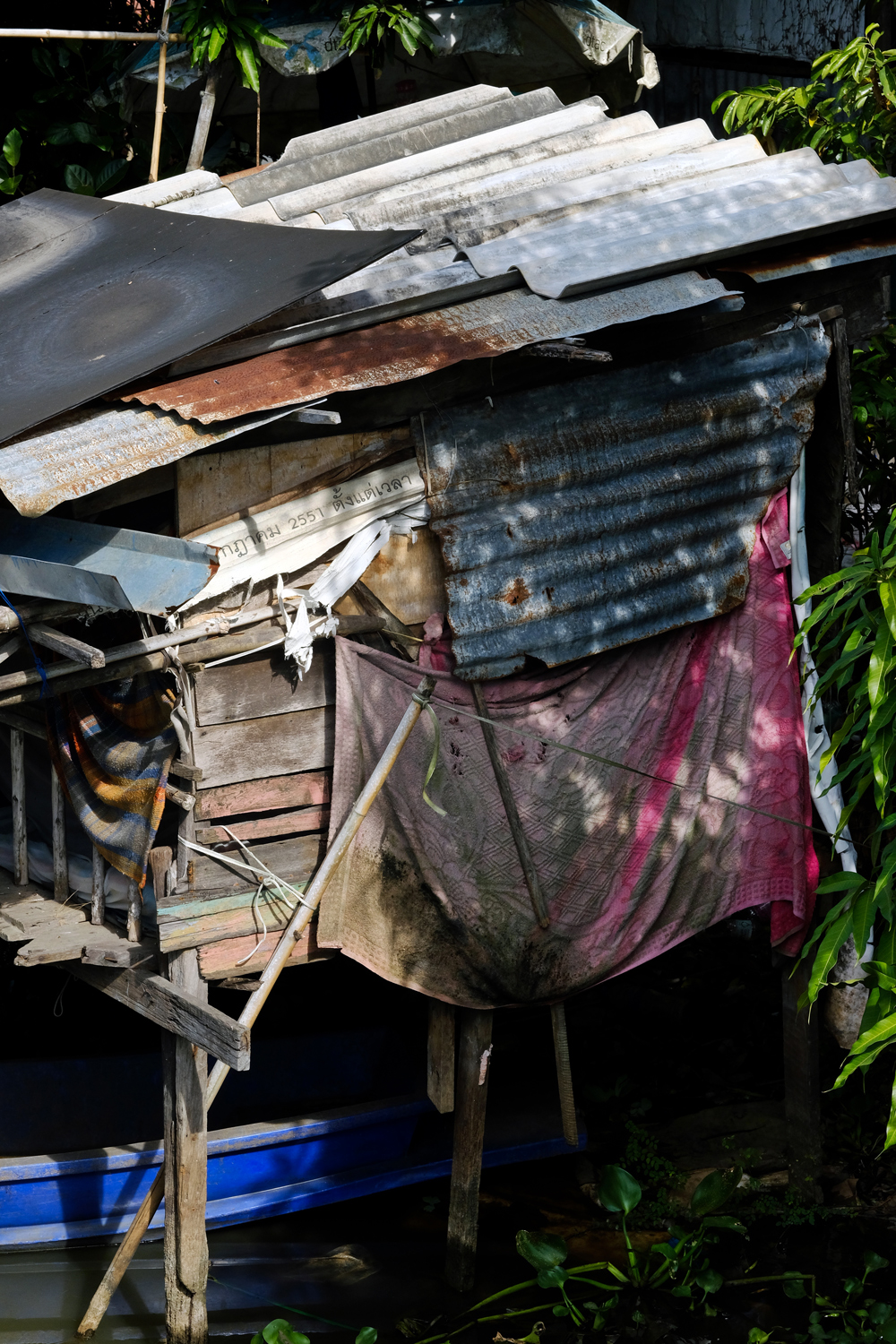 Next door was the old woman's 'home' -- a hovel along the klong. Abject poverty.
Next door was the old woman's 'home' -- a hovel along the klong. Abject poverty.
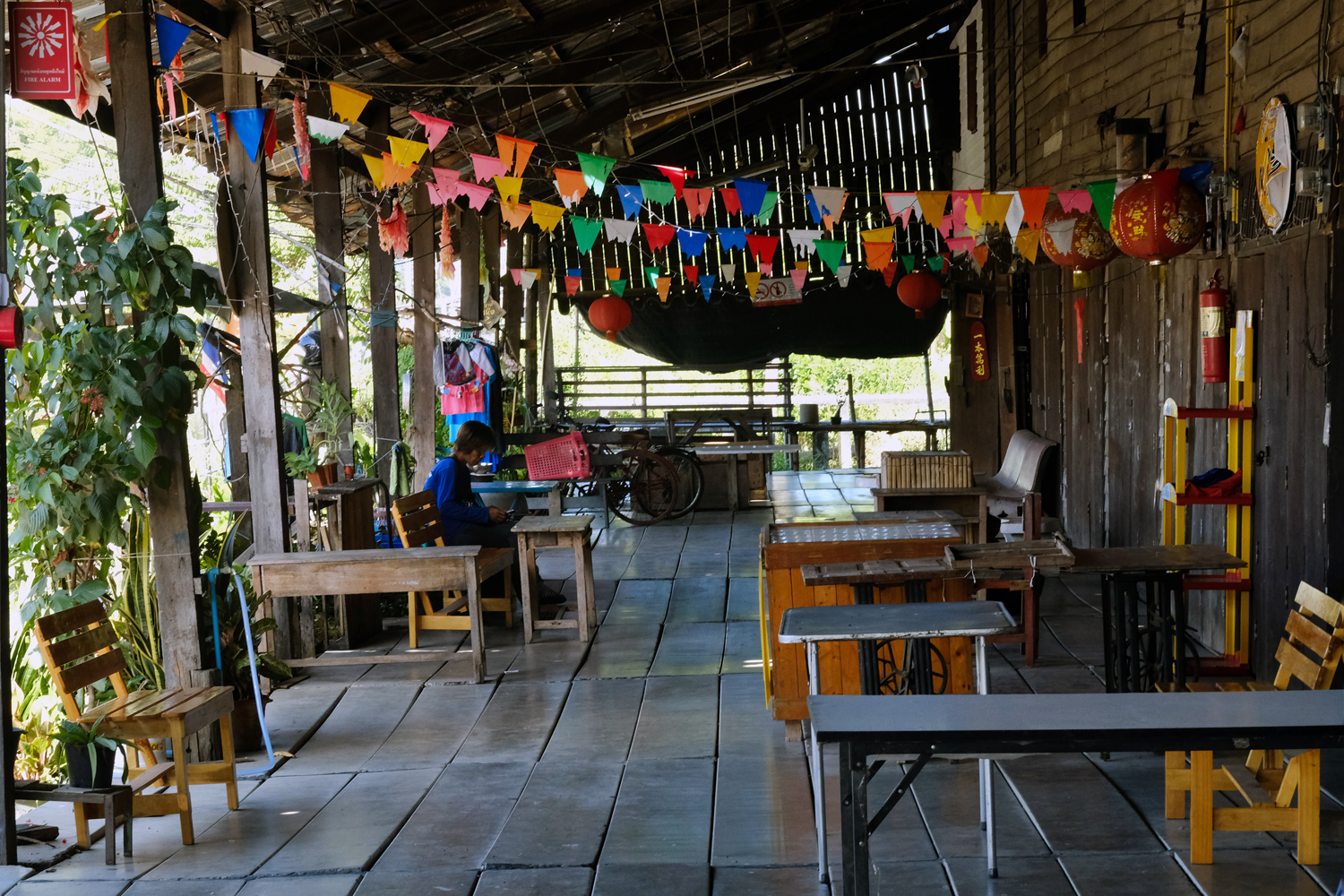 The market is opened only on week-ends, but we were there on a Monday, and glad of it. The old wooden structures built on stilts over the klong made a picturesque environment.
The market is opened only on week-ends, but we were there on a Monday, and glad of it. The old wooden structures built on stilts over the klong made a picturesque environment.
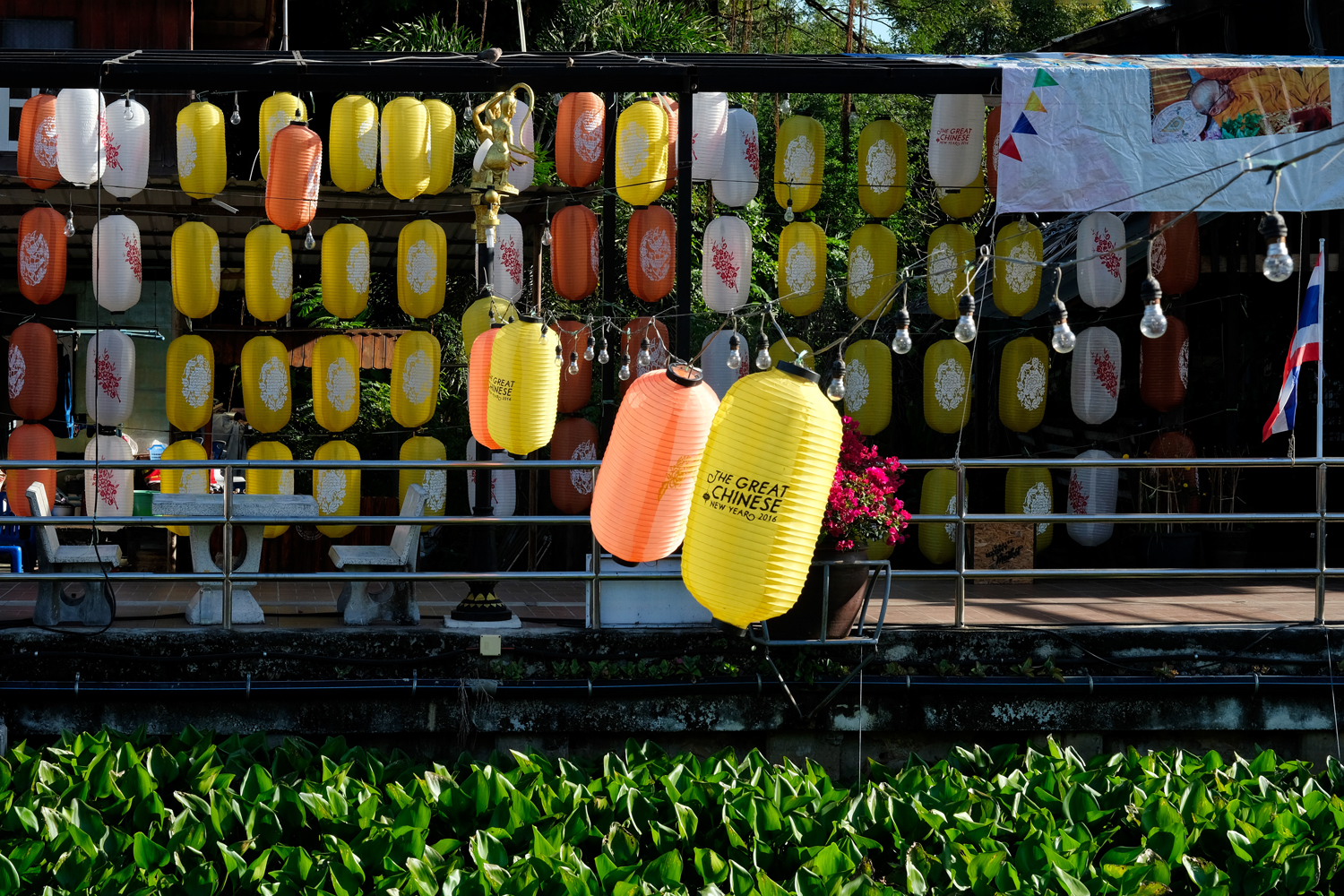 Lanterns from last years' Chinese New Years still festooned the old market.
Lanterns from last years' Chinese New Years still festooned the old market.
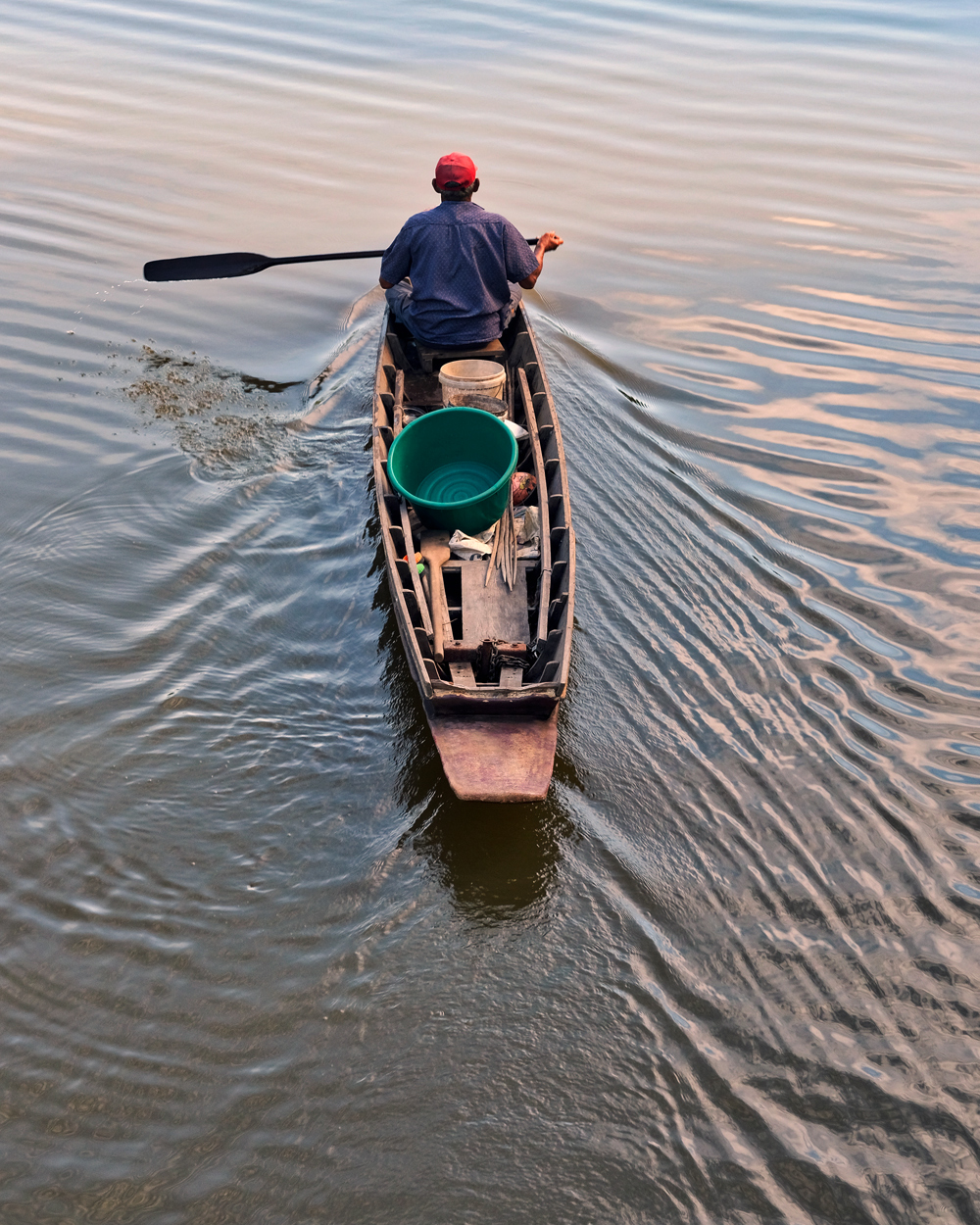 A klong boatman, Chachoengsao.
A klong boatman, Chachoengsao.
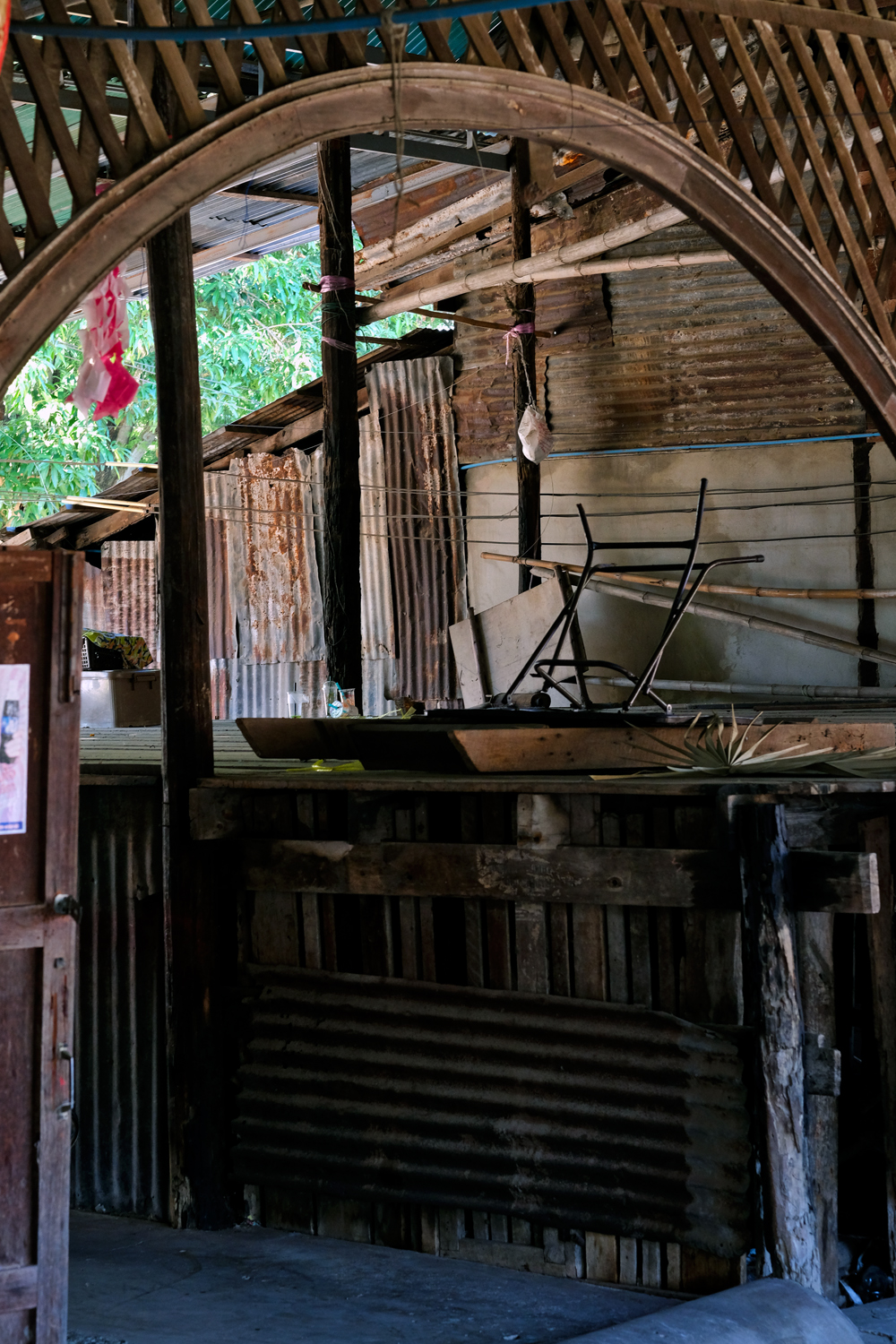 The old market looked like it had seen better days: here an old stage for ceremonies and performances.
The old market looked like it had seen better days: here an old stage for ceremonies and performances.
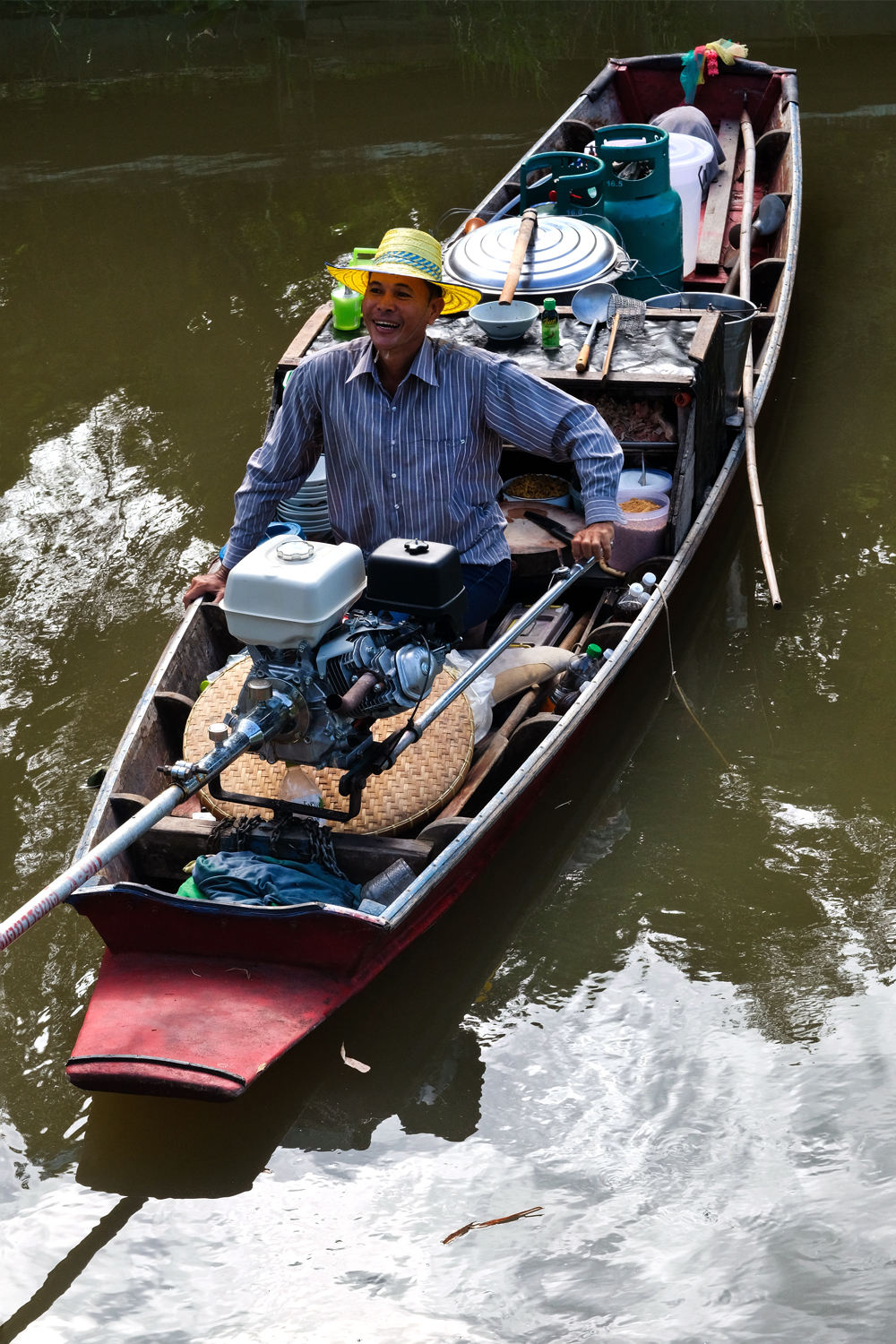 Although the market was closed, some of the vendors live permanently at the site. This man sold lunch to the local residents.
Although the market was closed, some of the vendors live permanently at the site. This man sold lunch to the local residents.
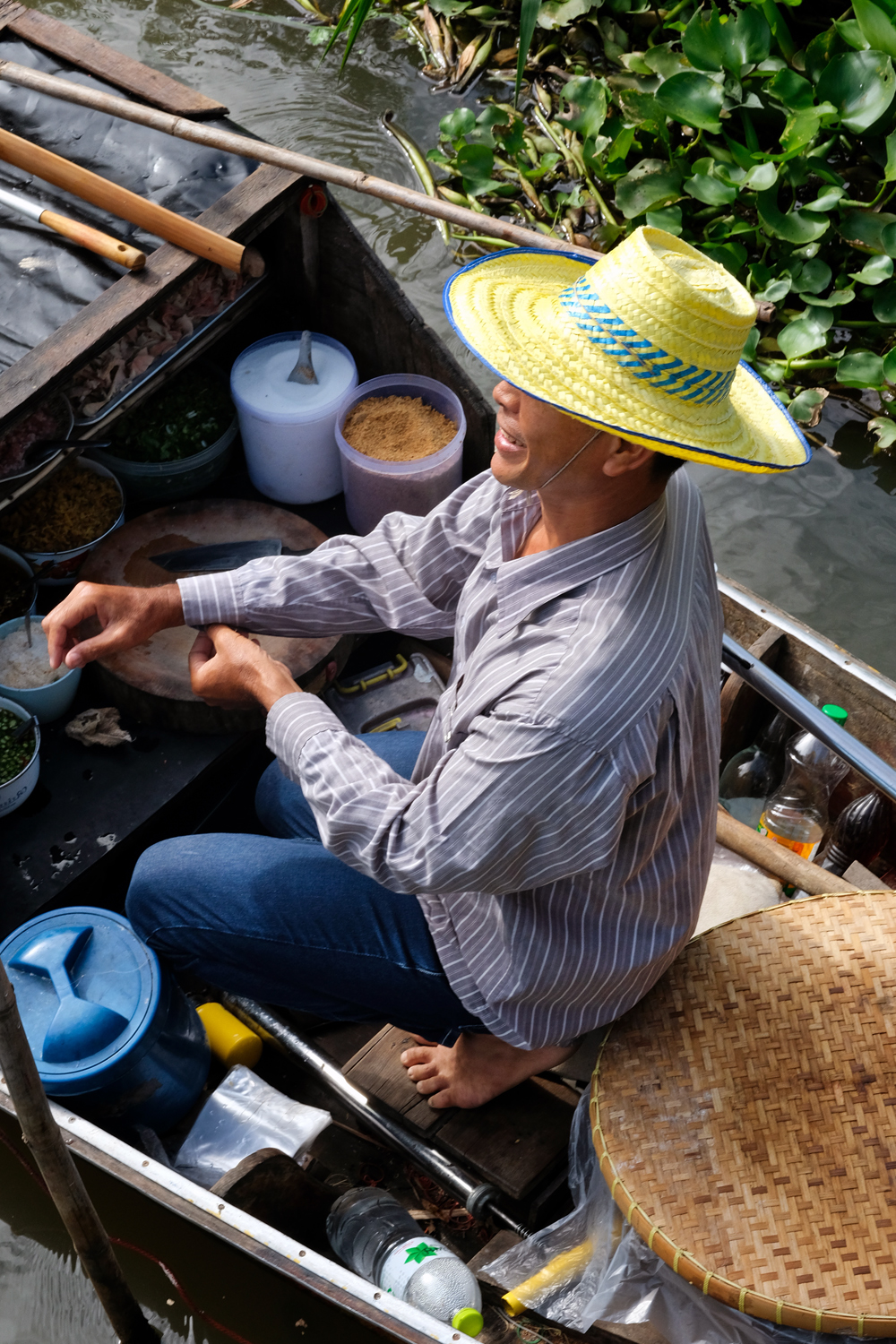 Taking an order.
Taking an order.
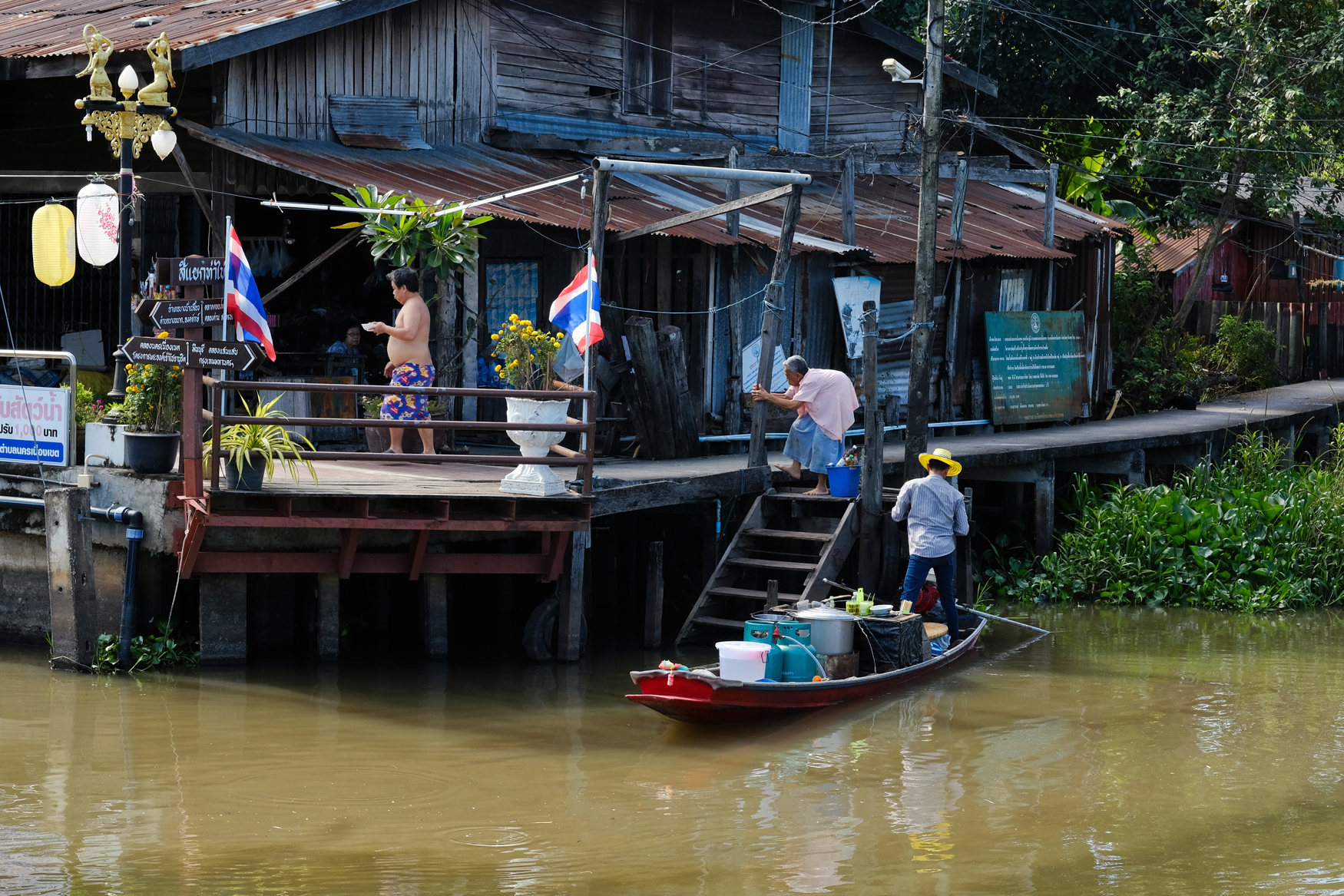 Life along the klong . . . at lunchtime.
Life along the klong . . . at lunchtime.
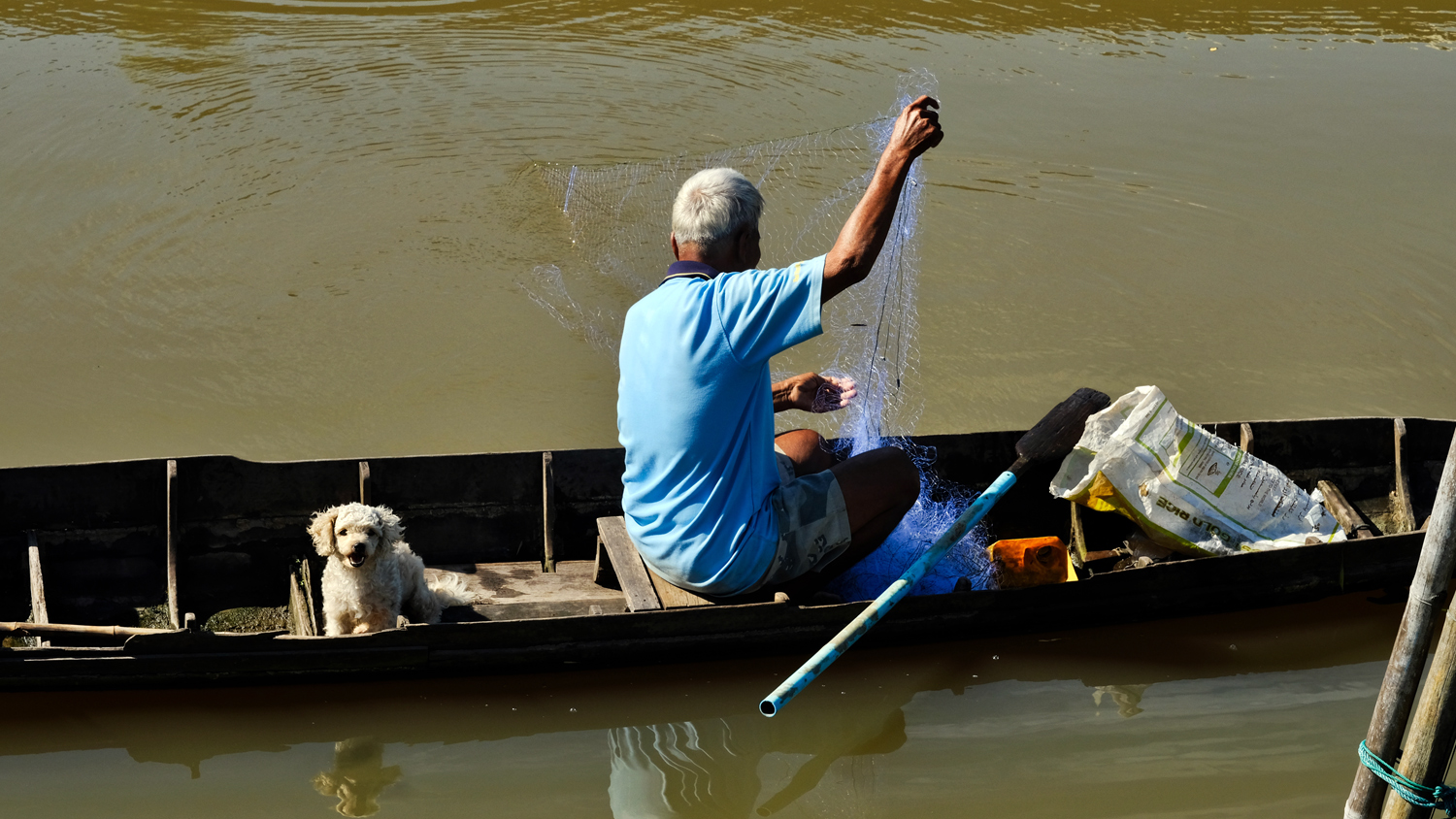 A fisherman and his dog. We did not see him catch any fish . . . he said there weren't very many to catch, when asked.
A fisherman and his dog. We did not see him catch any fish . . . he said there weren't very many to catch, when asked.
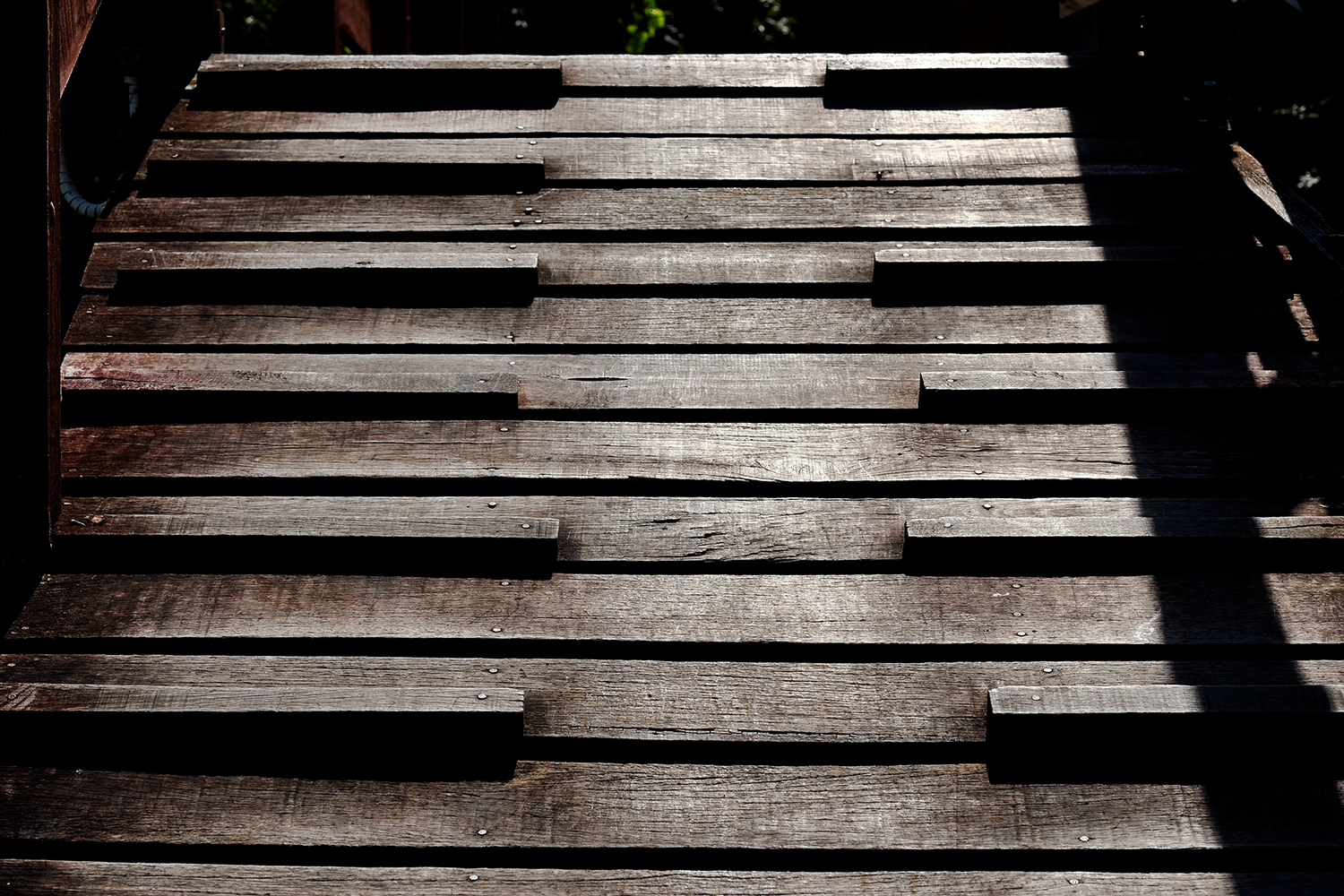 The old weathered wood and sharp light made for some nice 'minimalist' photos.
The old weathered wood and sharp light made for some nice 'minimalist' photos.
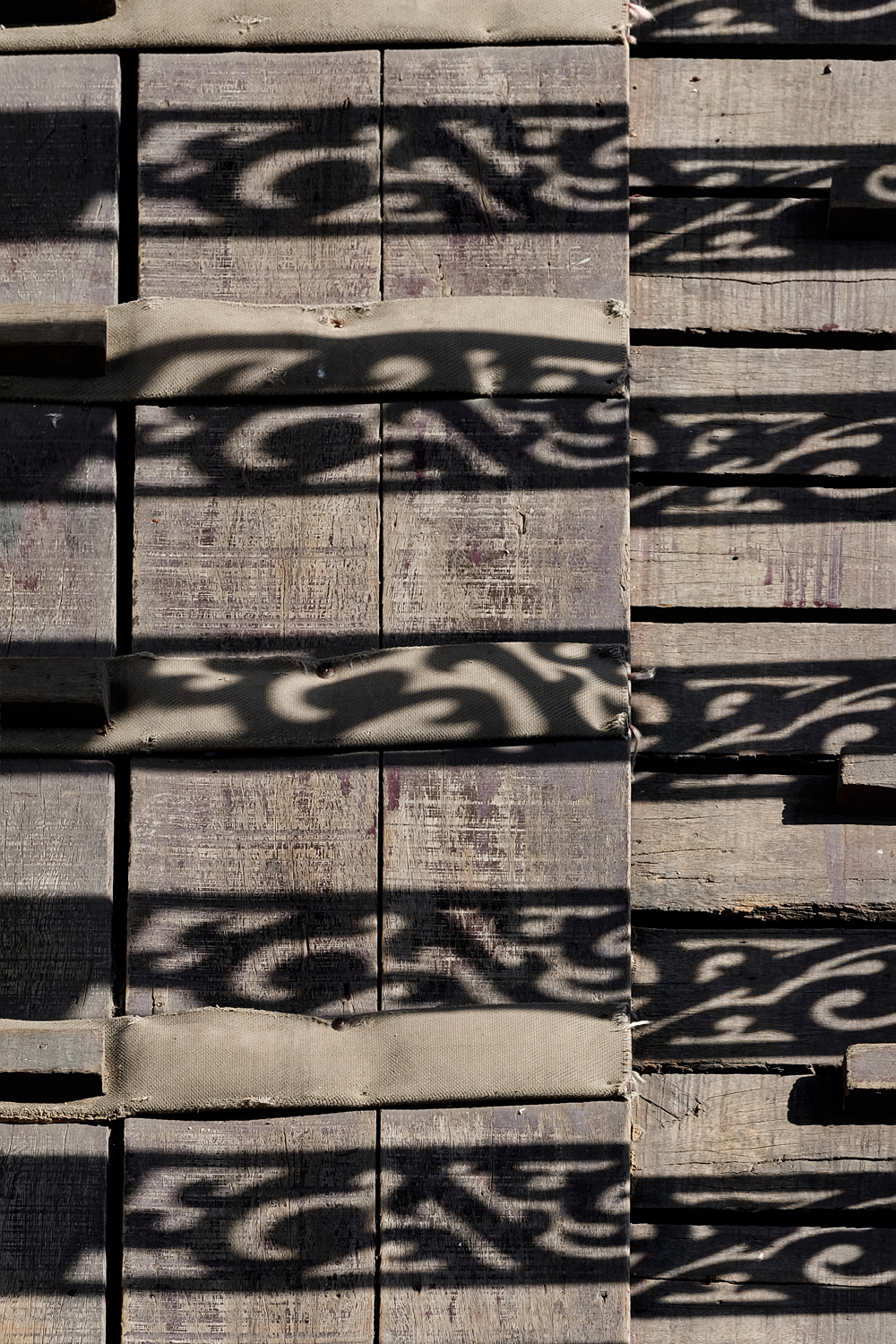 Light, shadow, texture . . . a bridge.
Light, shadow, texture . . . a bridge.
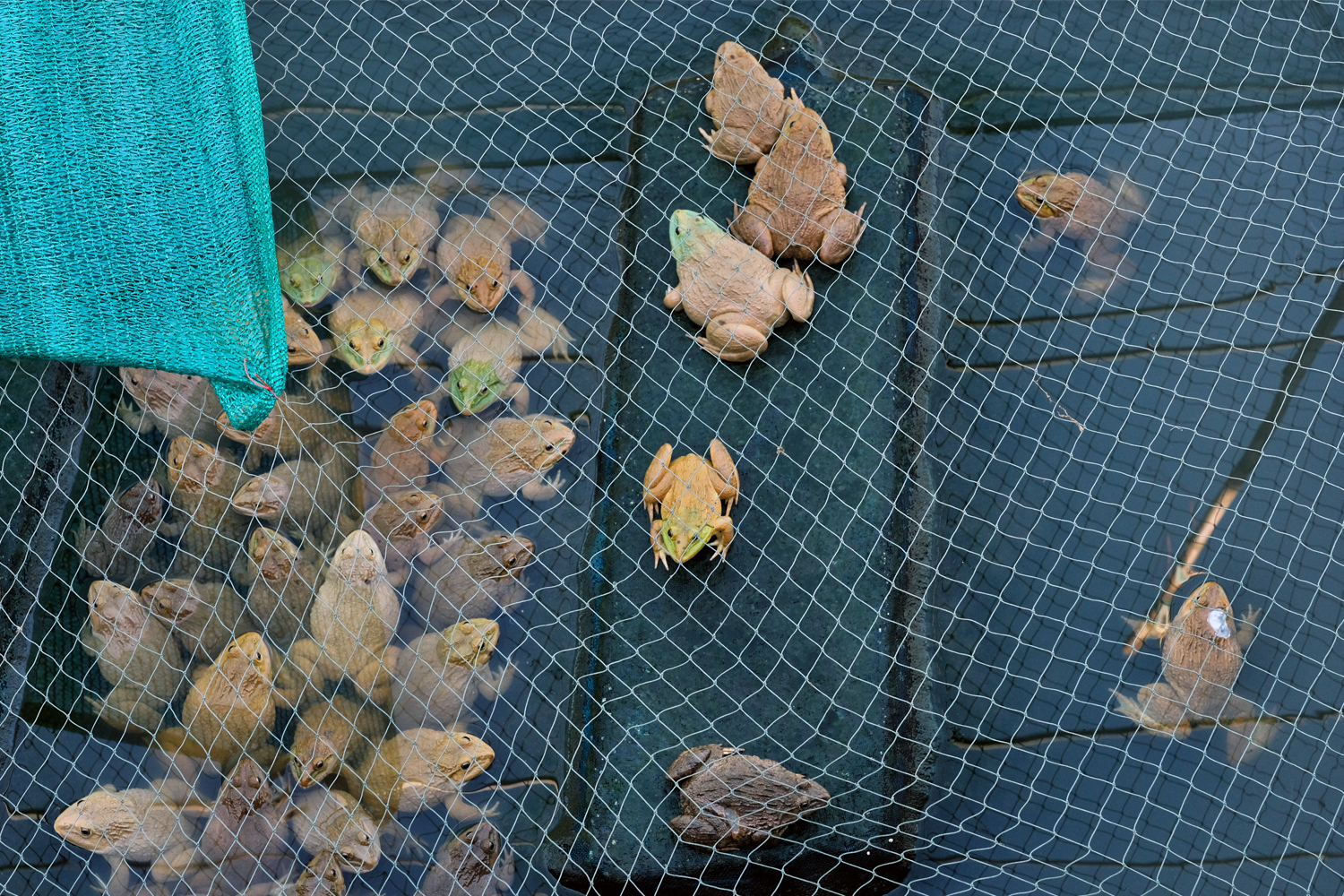 There was some aquaculture along the klongs . . . frog farming.
There was some aquaculture along the klongs . . . frog farming.
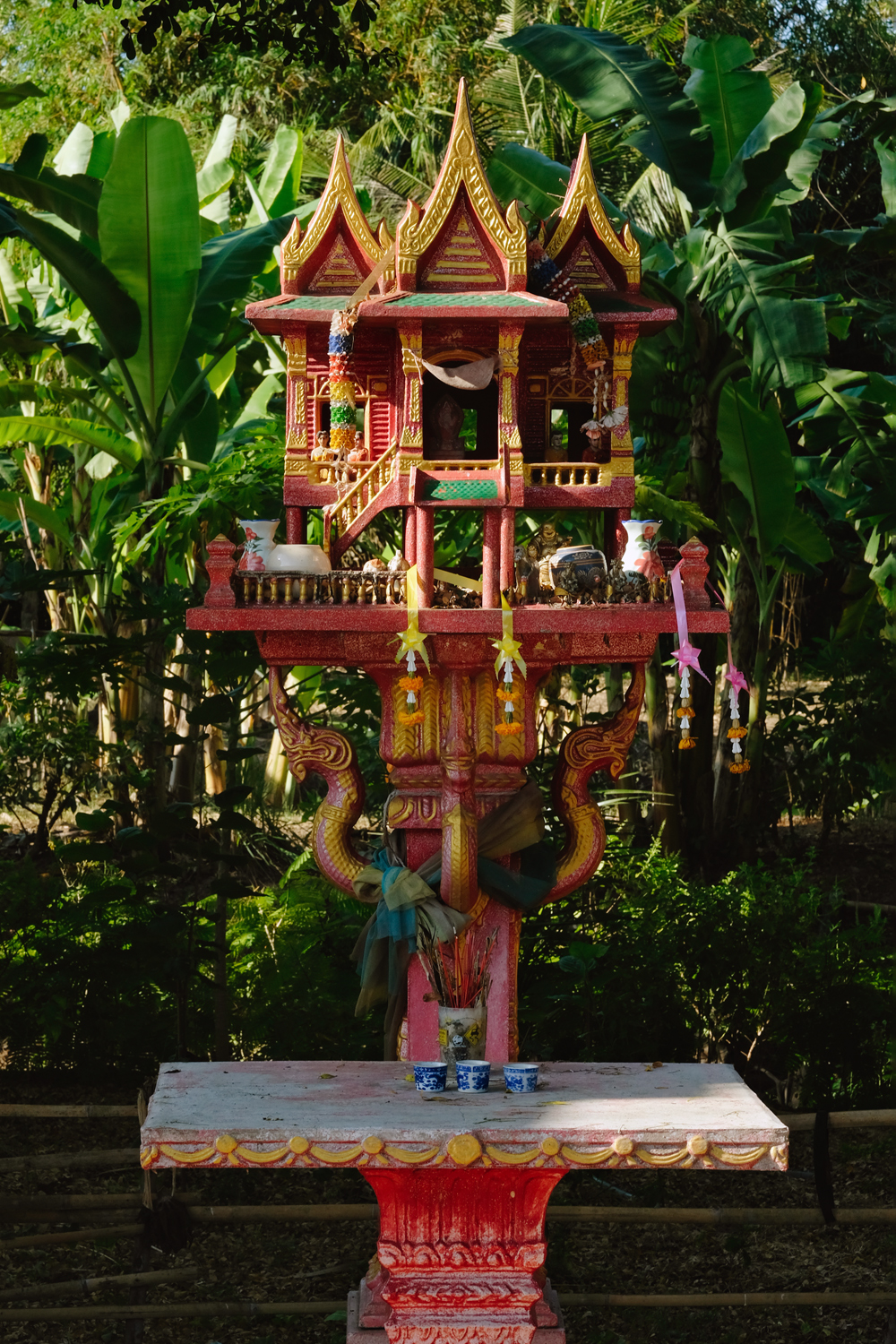 And, as always, the ubiquitous spirit houses.
And, as always, the ubiquitous spirit houses.
 The doors of the closed market shops were in themselves things of beauty.
The doors of the closed market shops were in themselves things of beauty.
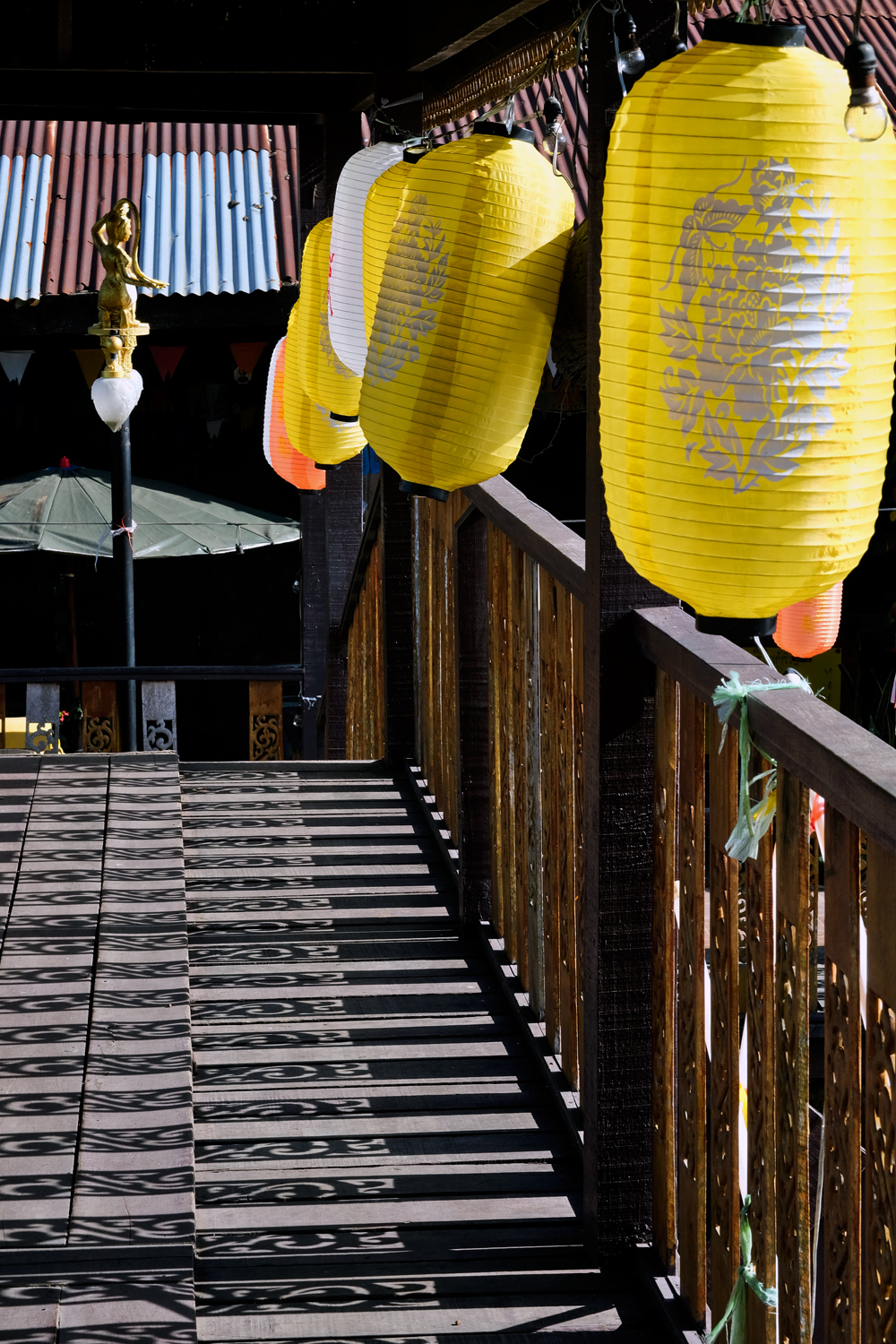 We walked around for several hours finding an endless number of interesting things to photograph.
We walked around for several hours finding an endless number of interesting things to photograph.
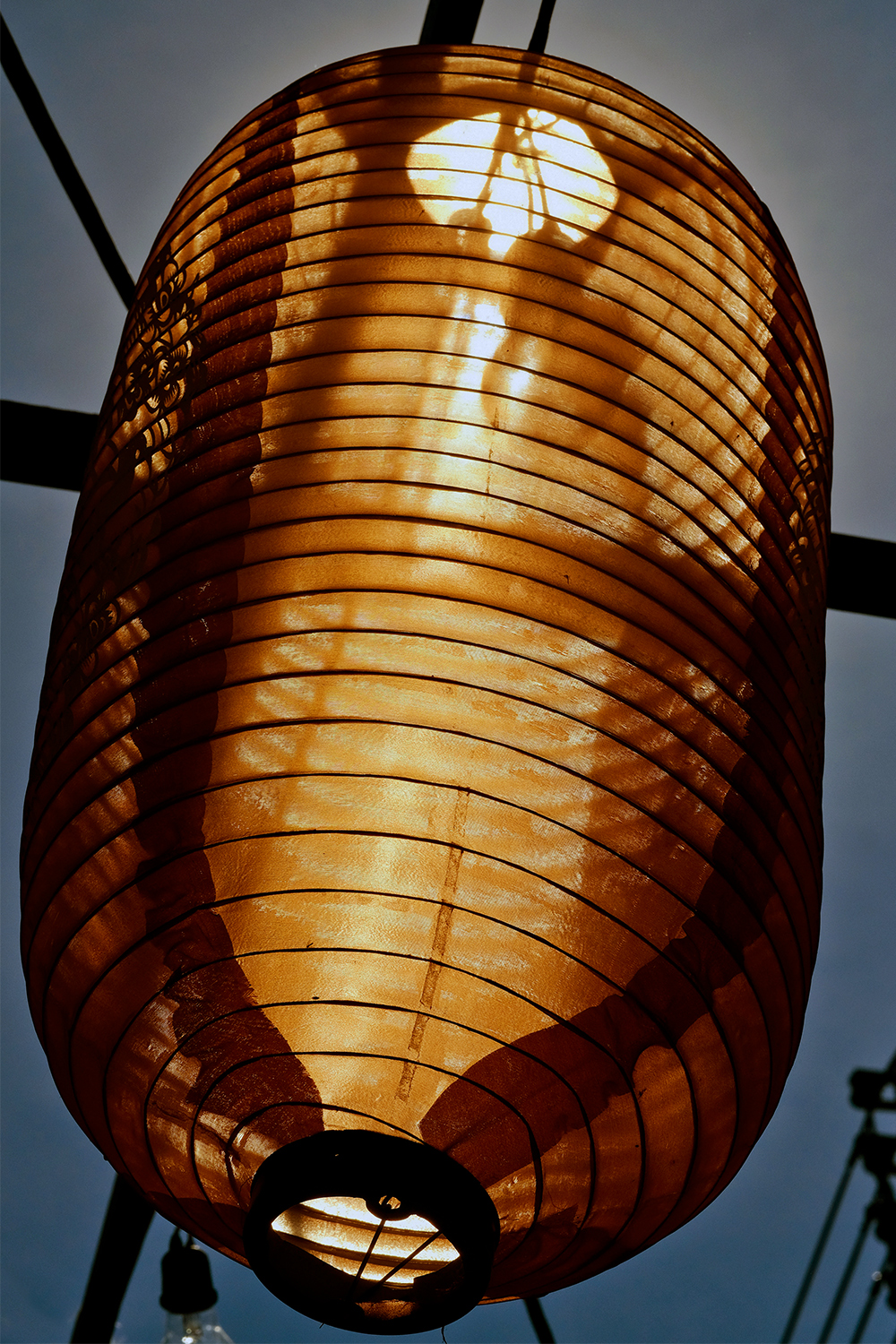 Sun behind a lantern.
Sun behind a lantern.
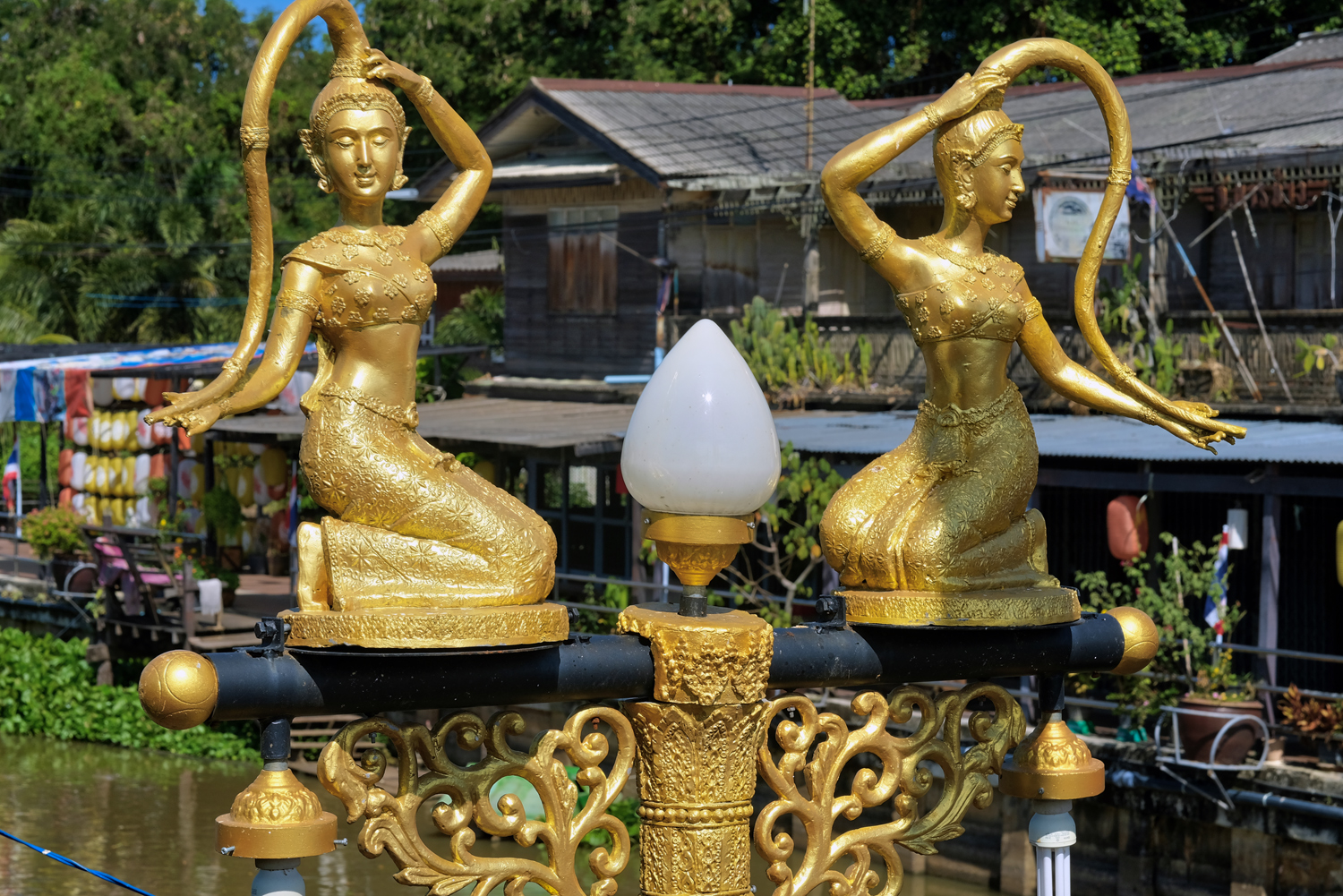 Signs of coordinated development: the market was lined with these very attractive street lights.
Signs of coordinated development: the market was lined with these very attractive street lights.
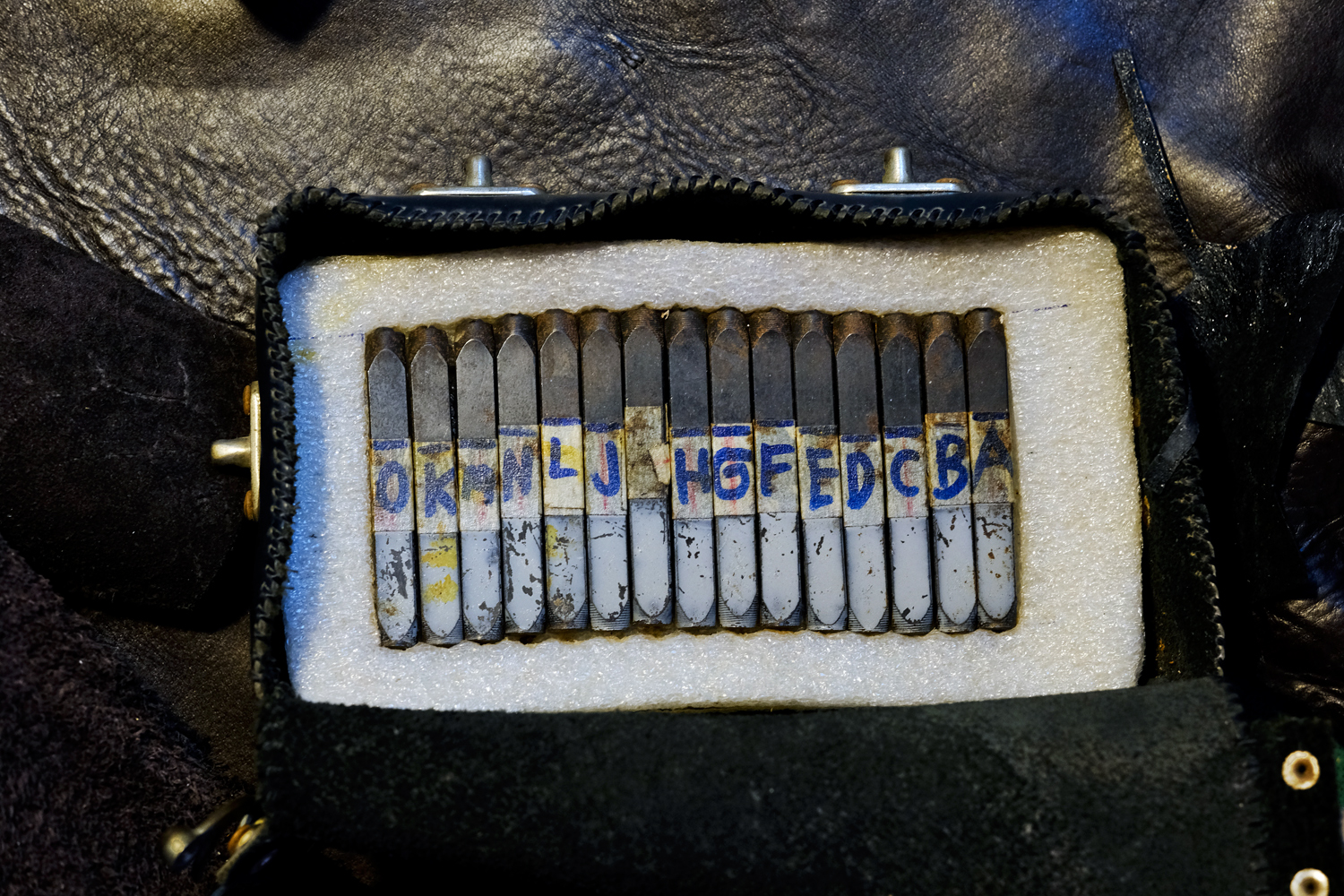 I bought a leather pouch for my sunglasses and the seller put my name on it with these old tools.
I bought a leather pouch for my sunglasses and the seller put my name on it with these old tools.
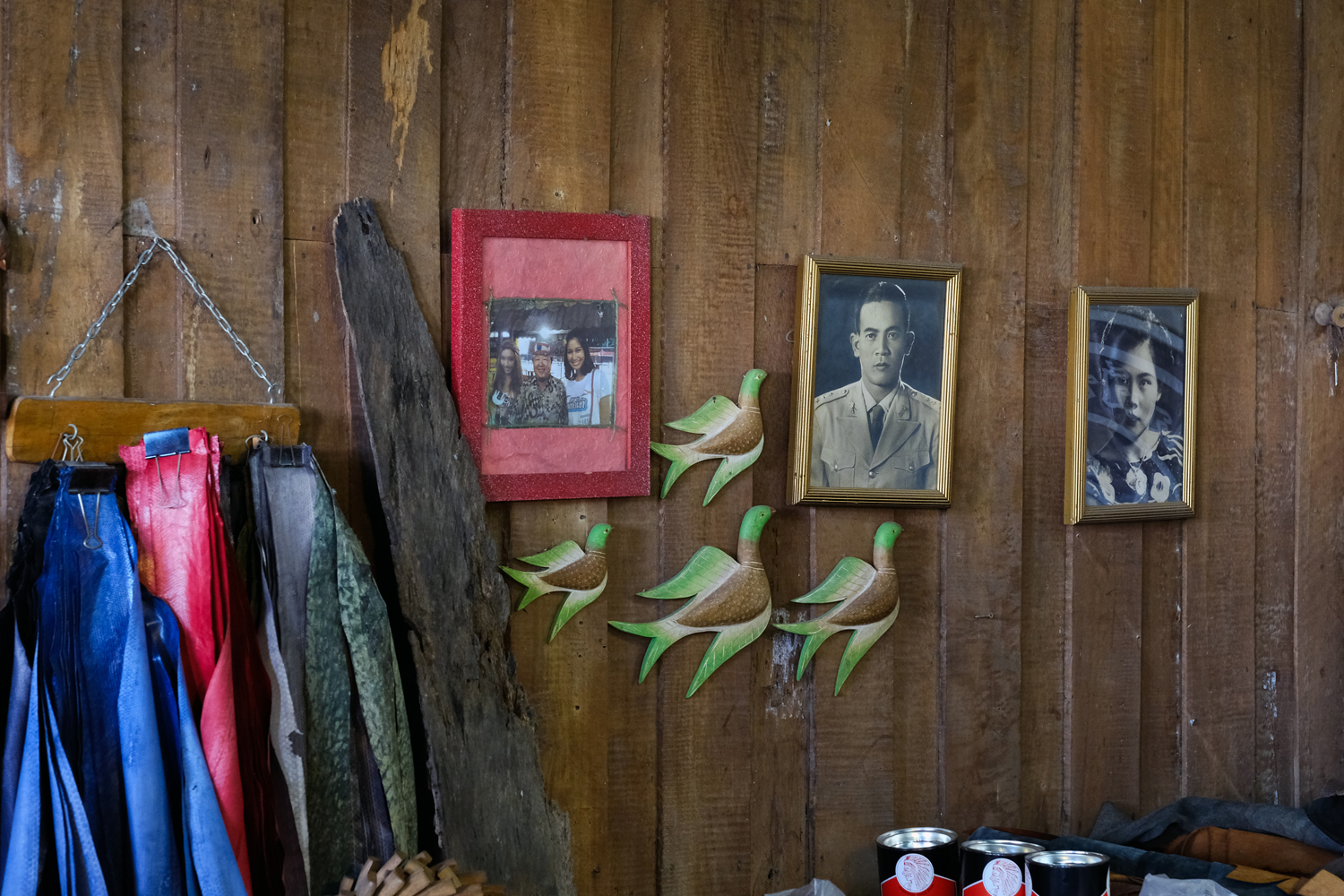 A wall in the leather shop with framed photos of the owner's wife's parents. Very touching.
A wall in the leather shop with framed photos of the owner's wife's parents. Very touching.
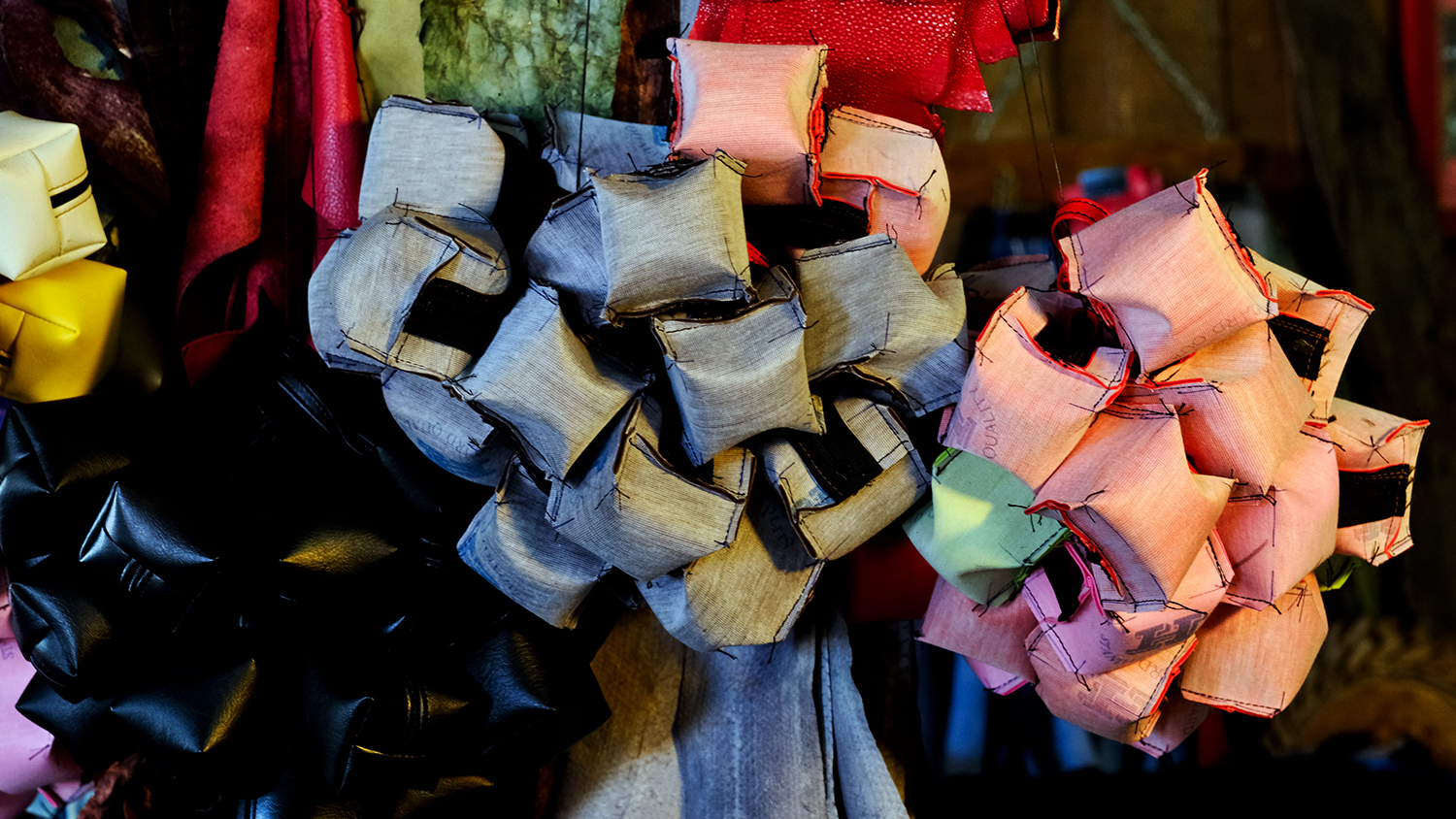 The leathergoods shop had these for sale, but I could not figure out what they were for.
The leathergoods shop had these for sale, but I could not figure out what they were for.
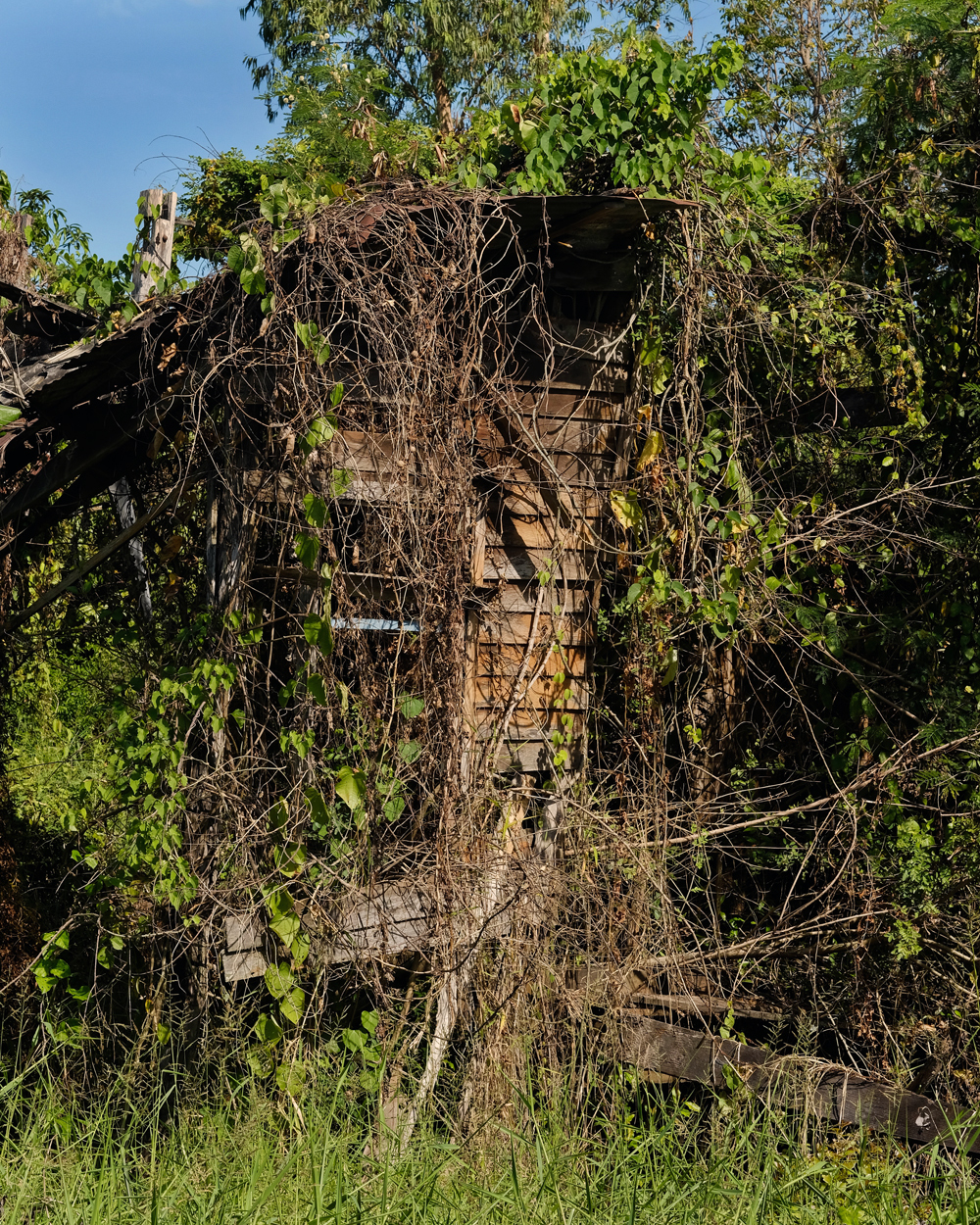 There were a number of empty, abandoned houses.
There were a number of empty, abandoned houses.
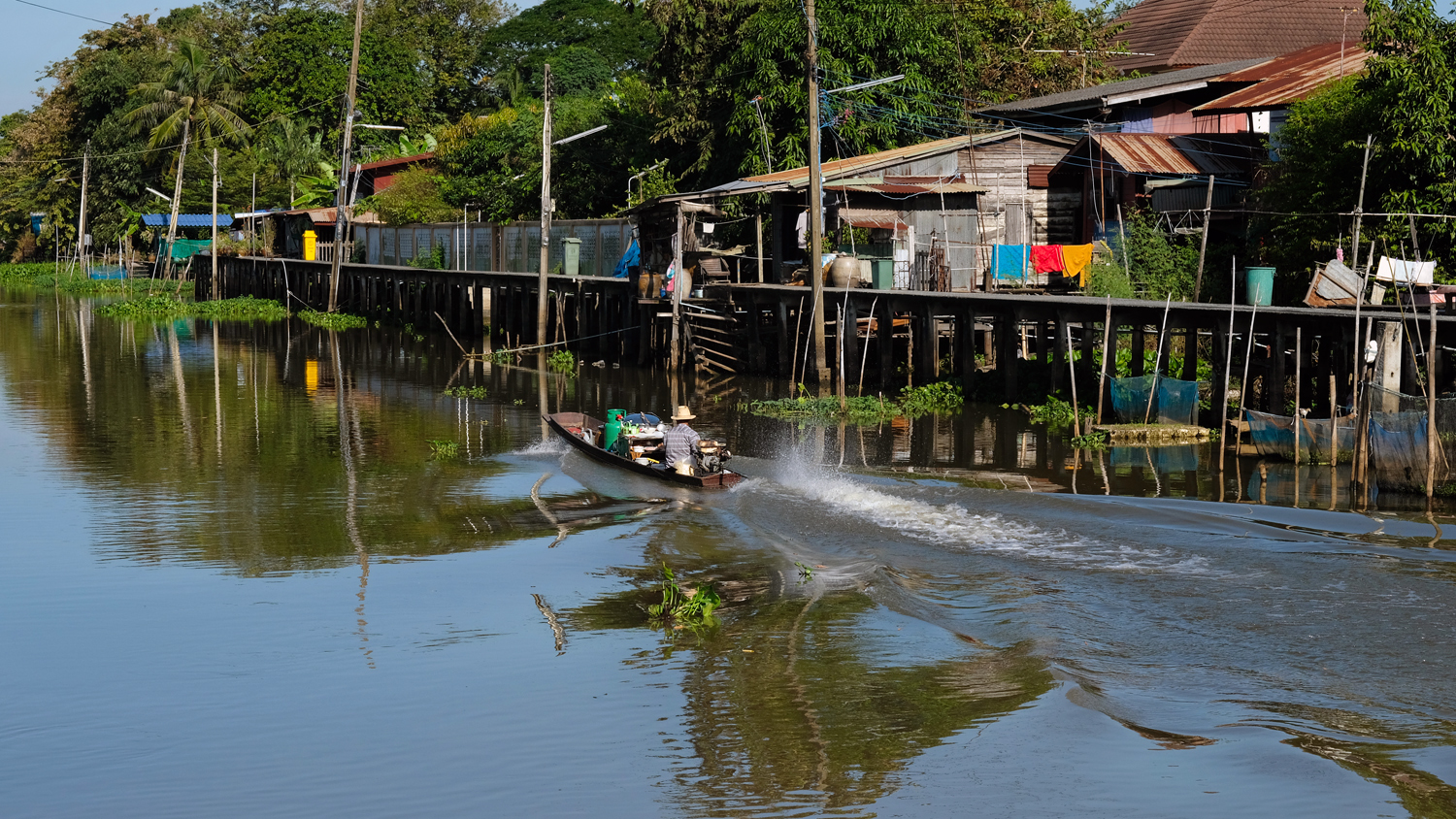 A lovely morning spent along the old klongs of rural Thailand.
A lovely morning spent along the old klongs of rural Thailand.
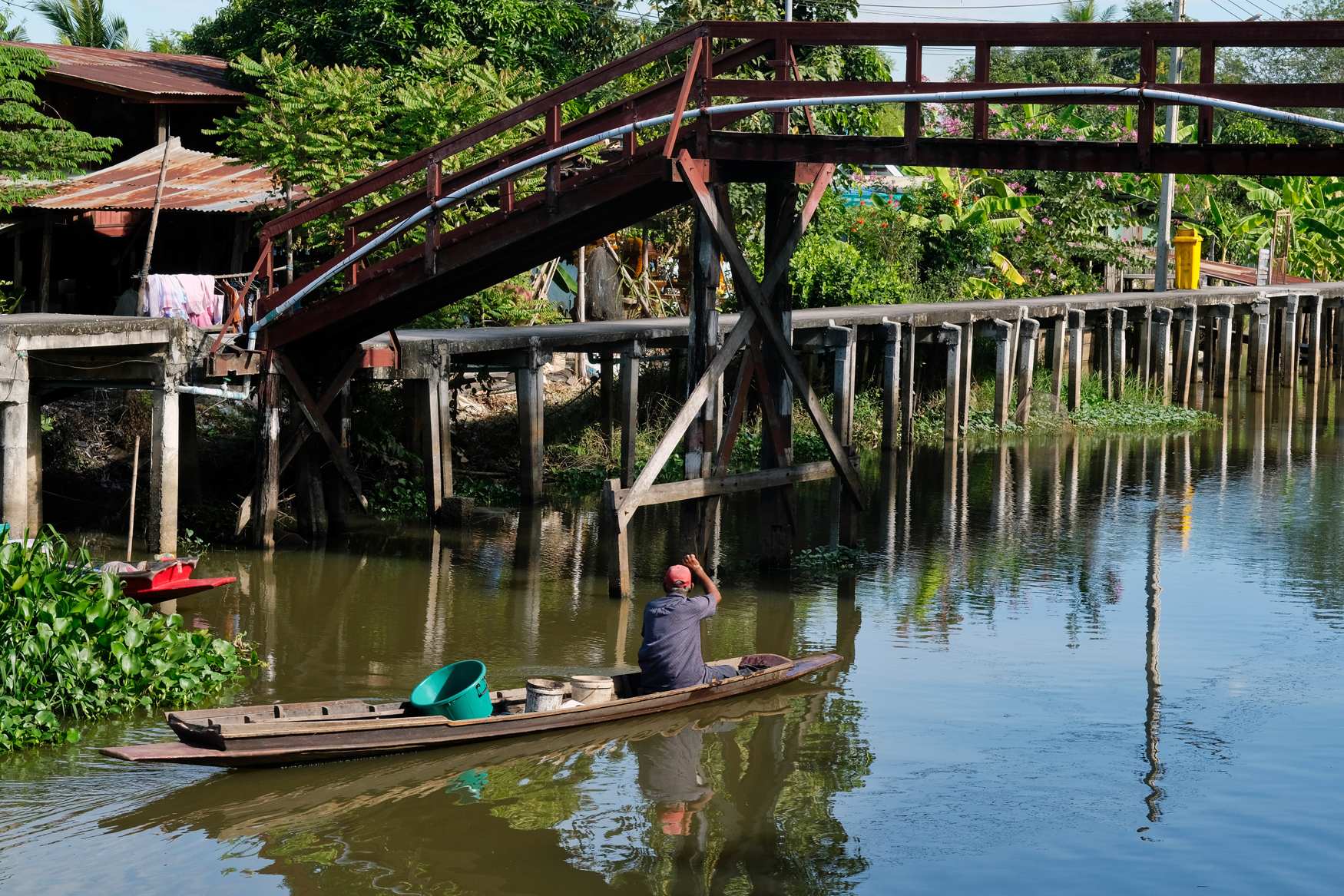 I could have stayed all day in this peaceful place . . but we moved on up the road.
I could have stayed all day in this peaceful place . . but we moved on up the road.
PART TWO: A RURAL WAT
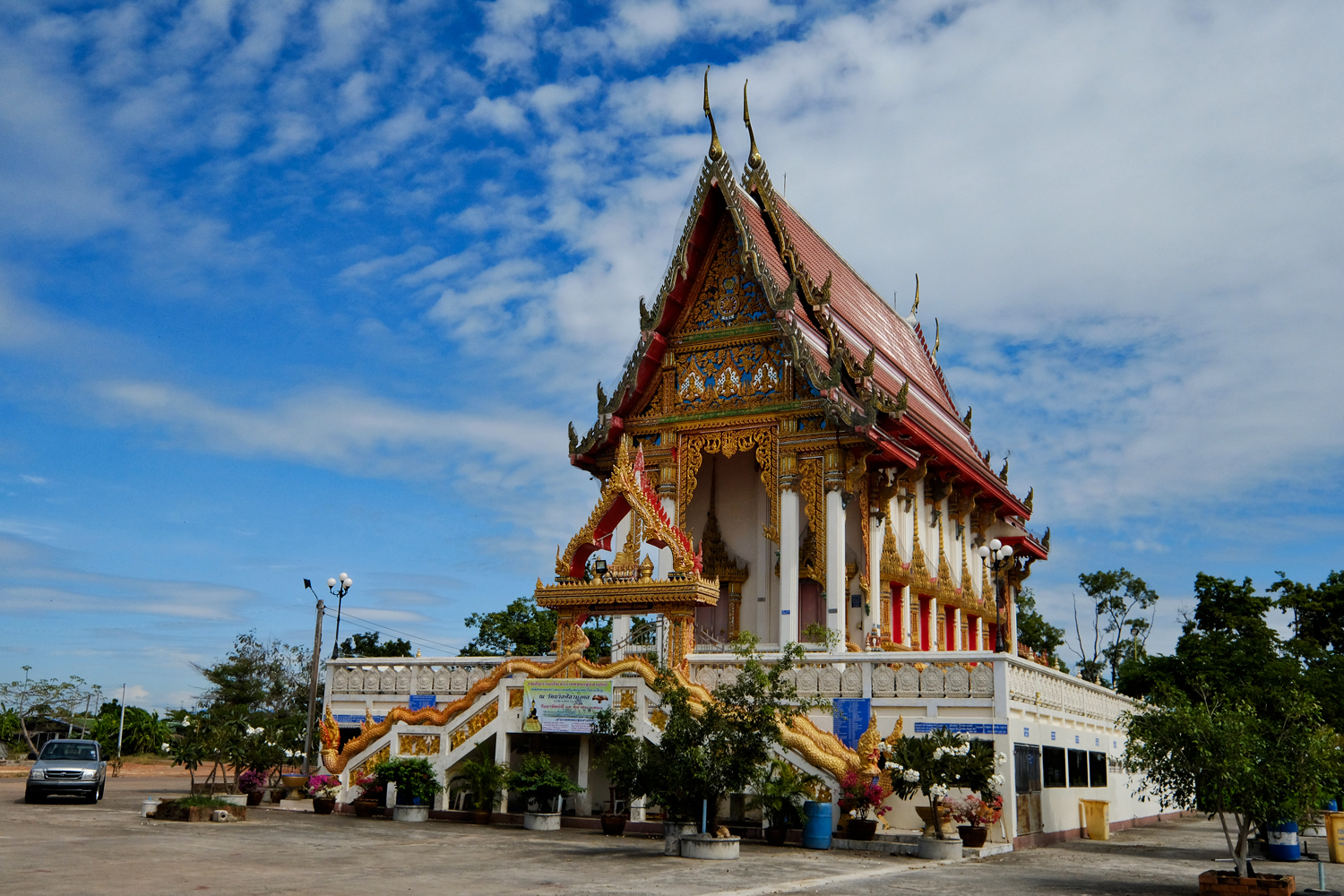 We set the GPS to the town and headed up the road . . . and missed our turn and instead discovered this wonderful Wat.
We set the GPS to the town and headed up the road . . . and missed our turn and instead discovered this wonderful Wat.
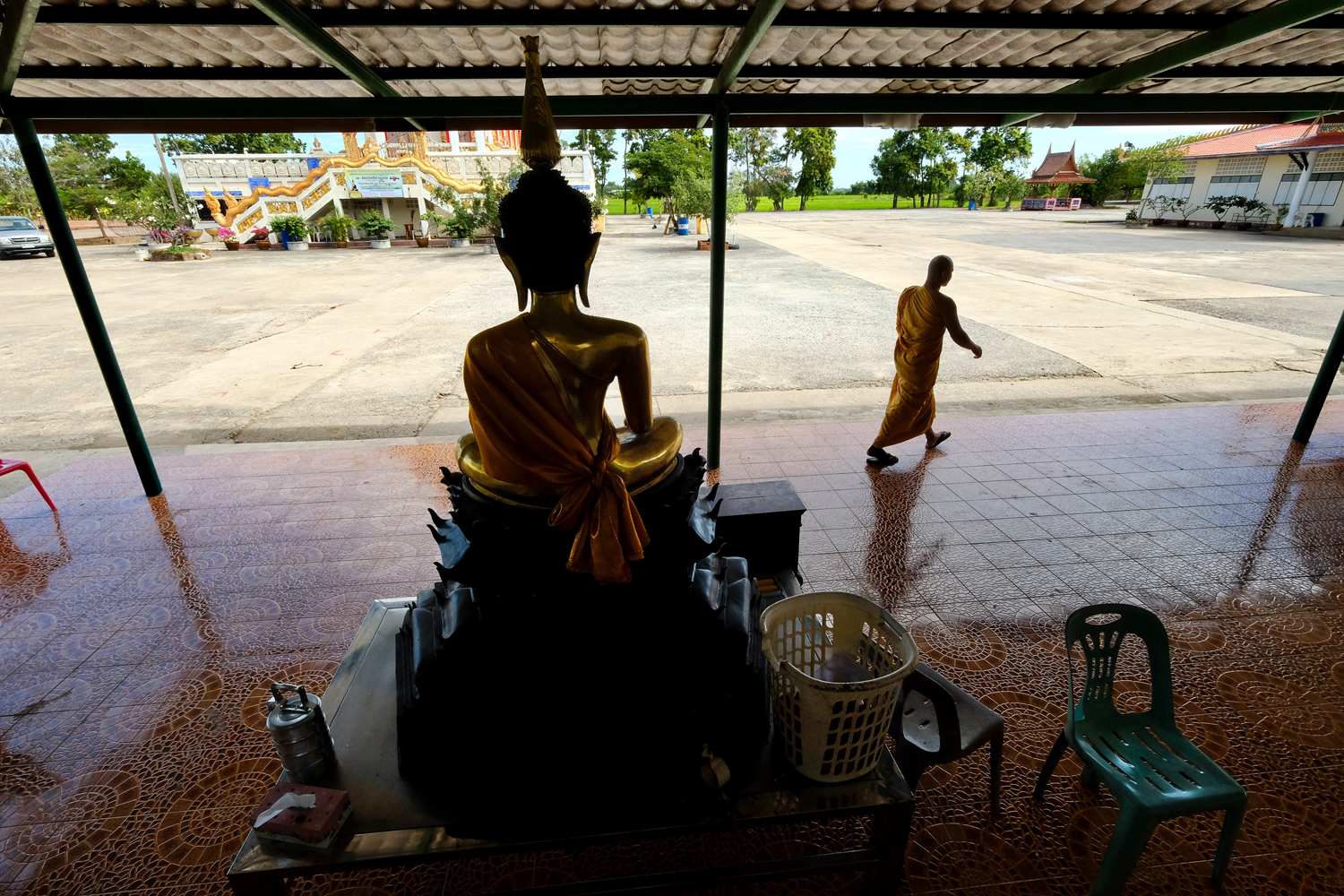 This Wat was a long way from any village or town . . . a very peaceful place.
This Wat was a long way from any village or town . . . a very peaceful place.
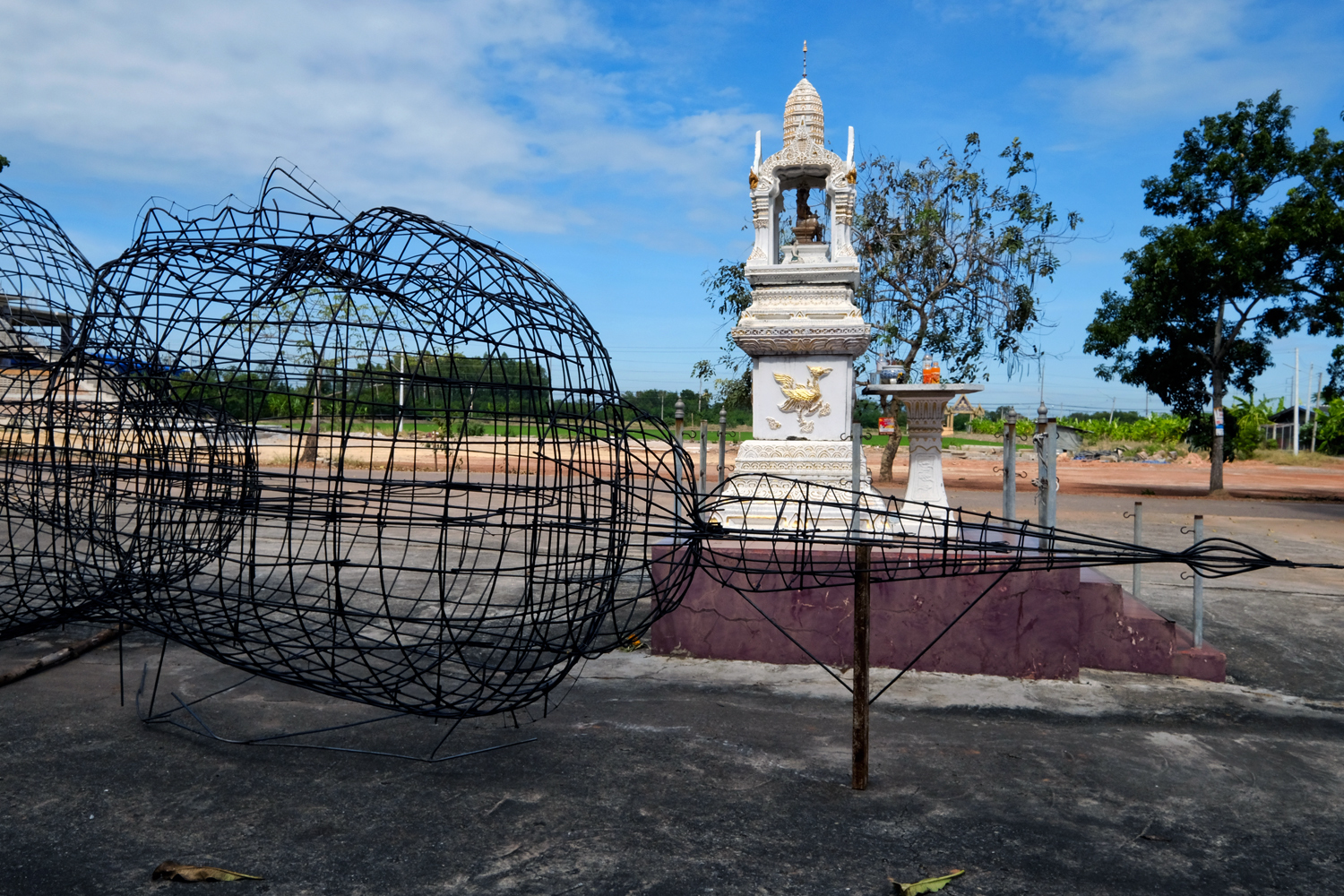 The Wat was at the beginning phase of erecting a colossal Buddha image. It was interesting to see the rebar mesh getting ready to be plastered.
The Wat was at the beginning phase of erecting a colossal Buddha image. It was interesting to see the rebar mesh getting ready to be plastered.
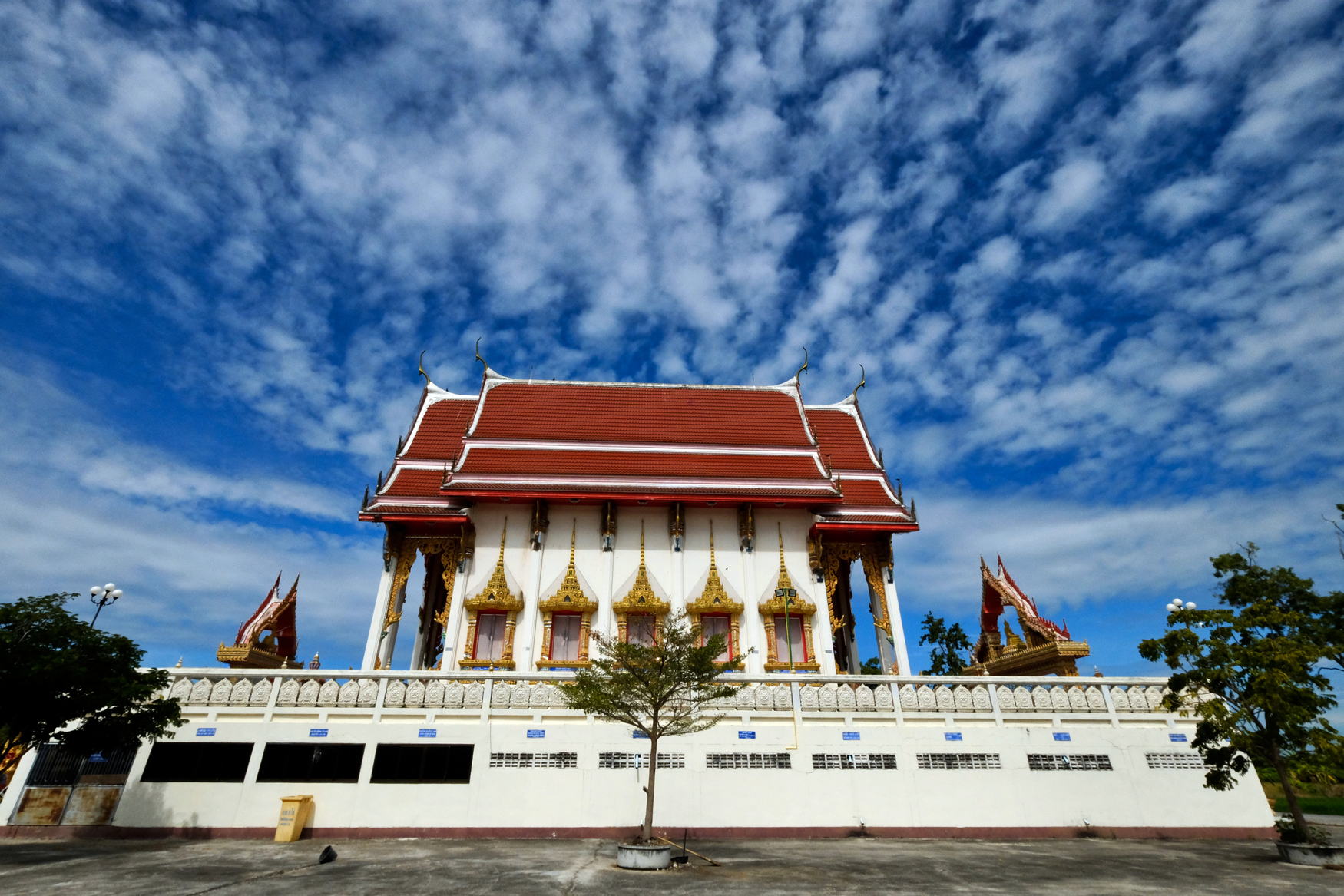 A beautiful rural wat under a giant sky. We are all so small in the scheme of things . . . if there is a scheme.
A beautiful rural wat under a giant sky. We are all so small in the scheme of things . . . if there is a scheme.
PART THREE: A CHACHOENGSAO NEIGBORHOOD WAT
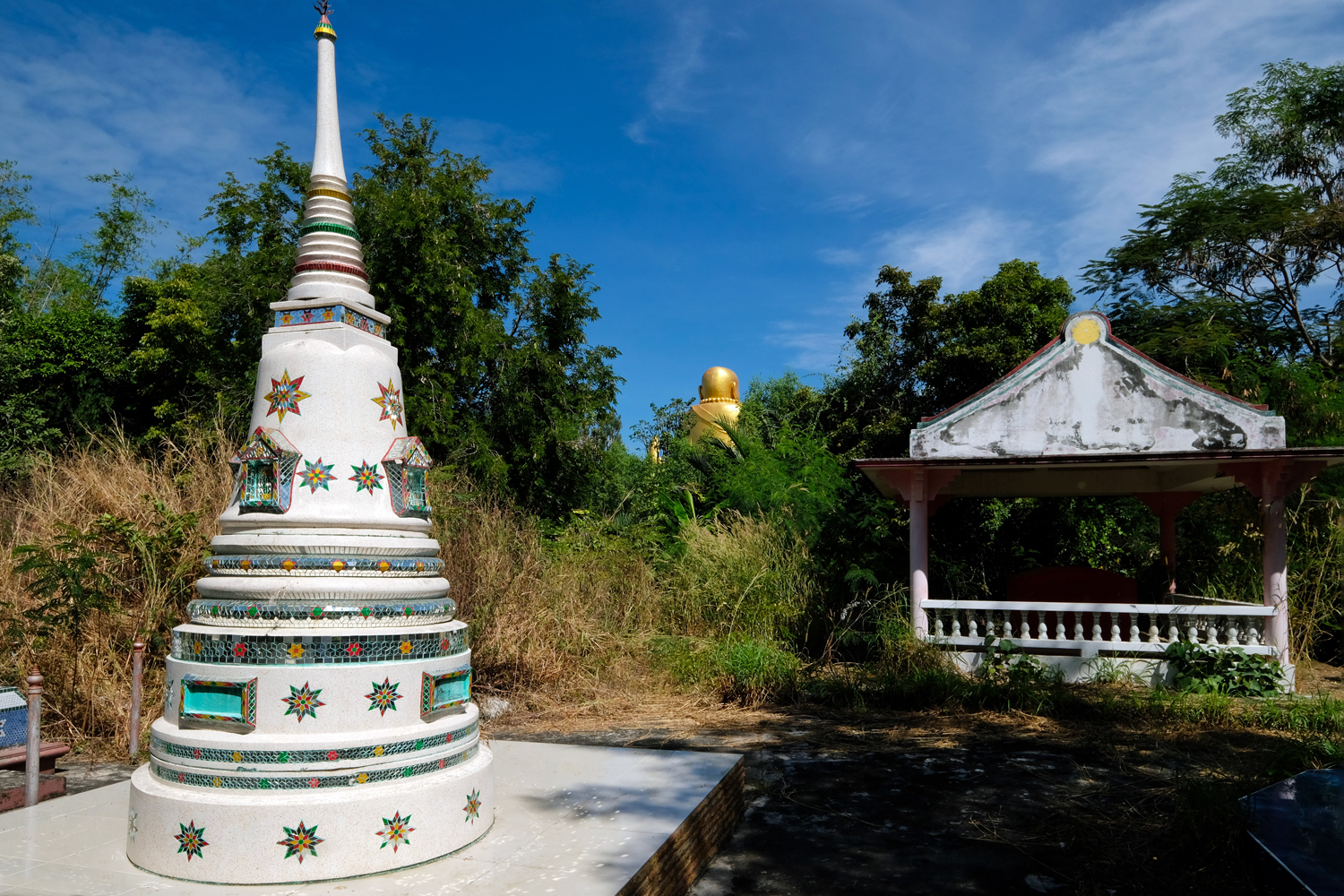 We got a little lost in the small lanes the GPS decided to send us on . . . until we spotted a giant Buddha up between the trees . . and followed an ally to where we thought it might be . . . it wasn't the 'right' Wat, but it was very interesting in its own right.
We got a little lost in the small lanes the GPS decided to send us on . . . until we spotted a giant Buddha up between the trees . . and followed an ally to where we thought it might be . . . it wasn't the 'right' Wat, but it was very interesting in its own right.
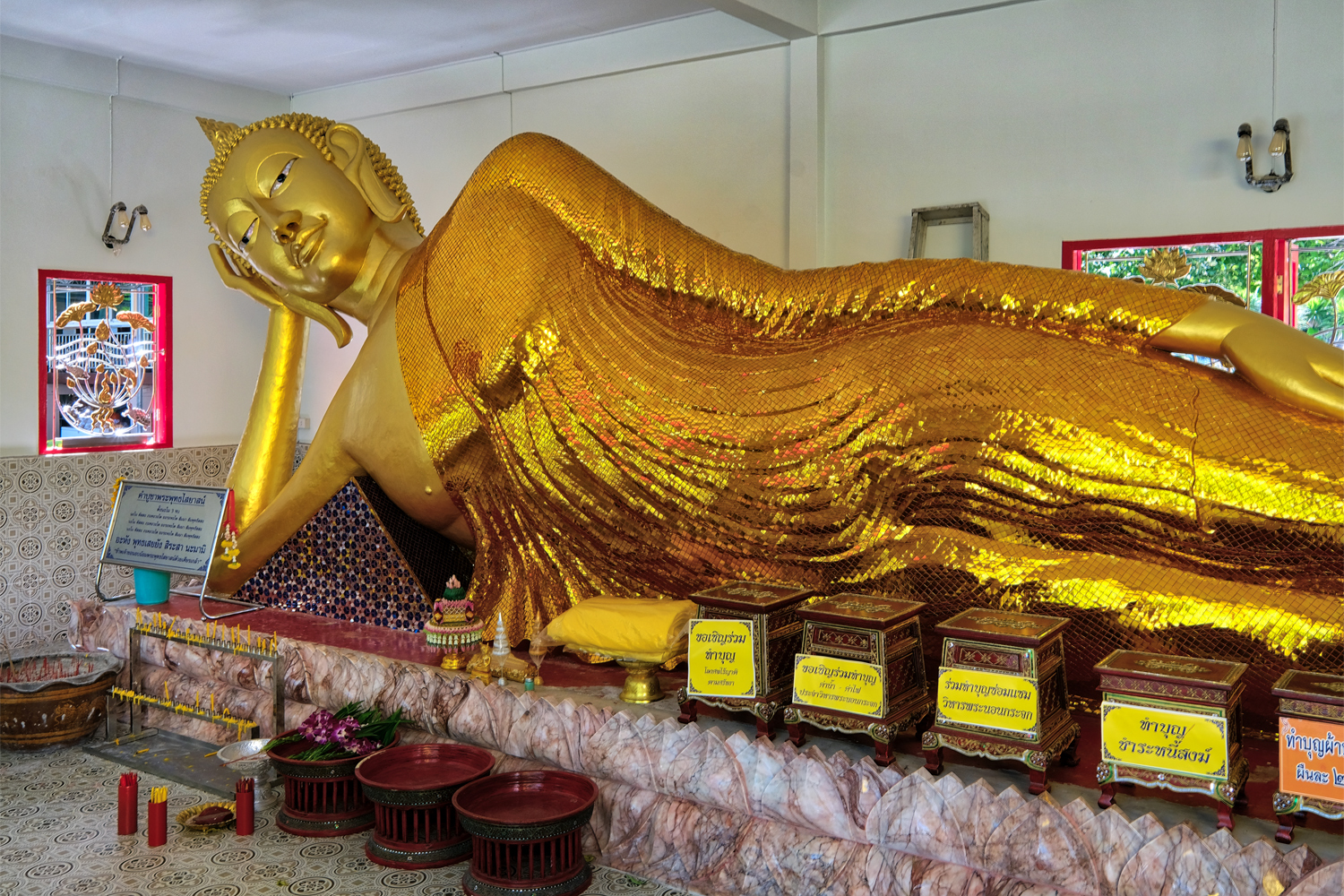 It was an interesting old wat that backed up to a klong . . . a klong that separated us from the giant Buddha we spotted from the road. We decided to walk and see if there was a bridge . . .
It was an interesting old wat that backed up to a klong . . . a klong that separated us from the giant Buddha we spotted from the road. We decided to walk and see if there was a bridge . . .
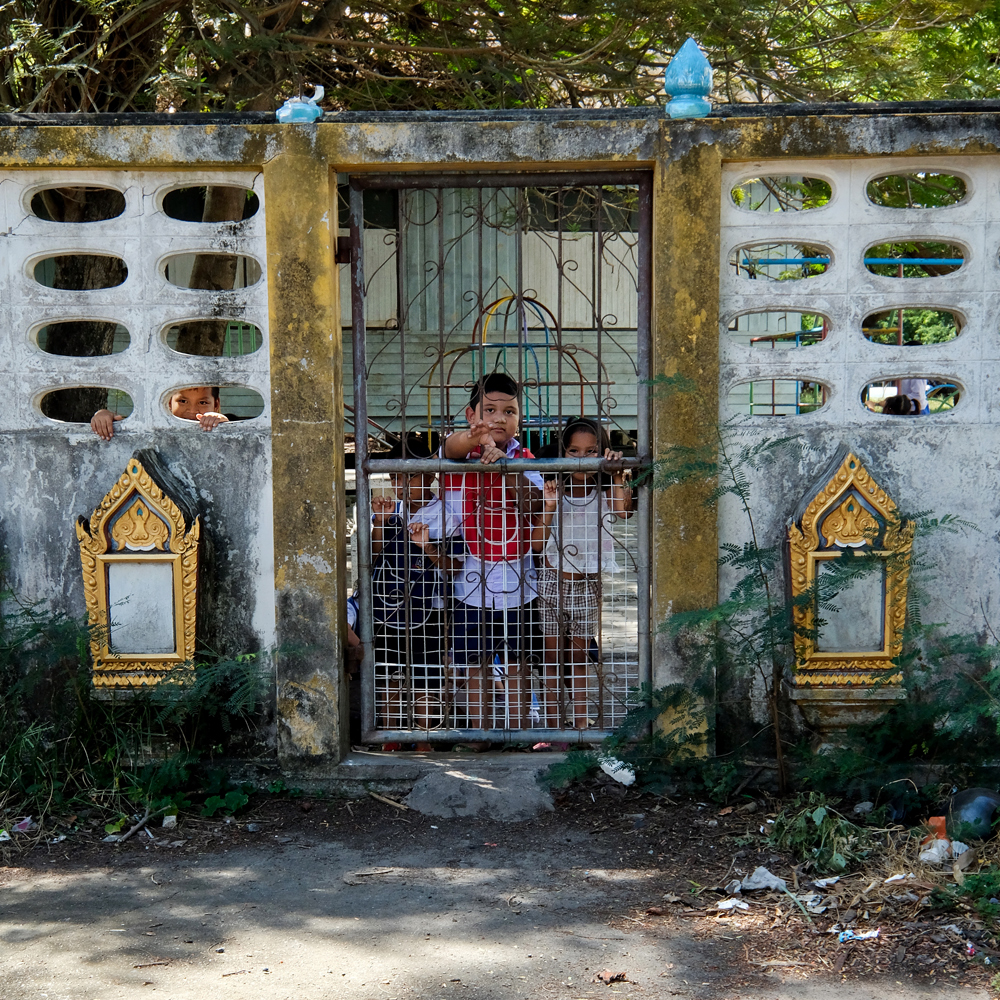 Our walk took us through a cemetery next door to a school.
Our walk took us through a cemetery next door to a school.
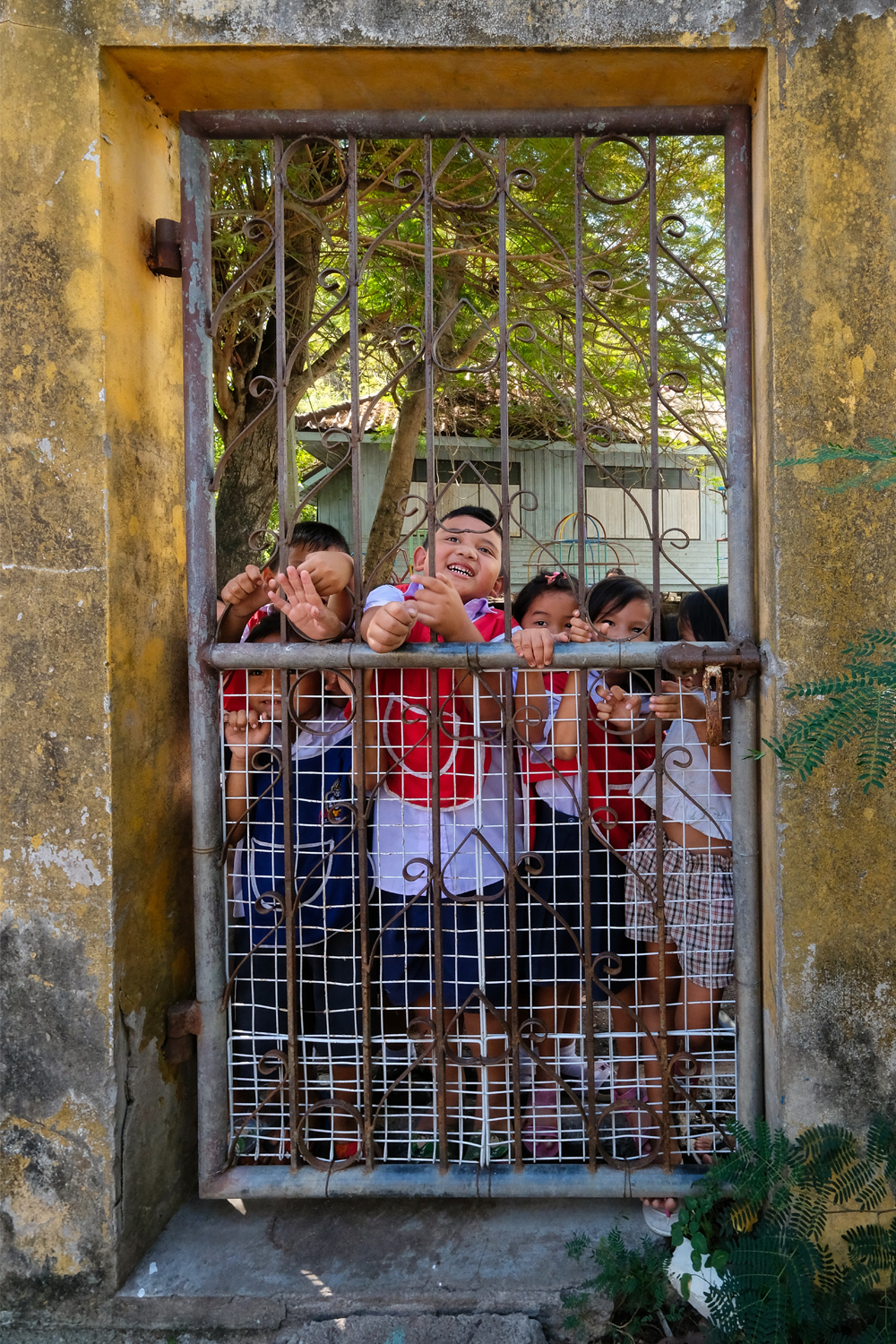 The school kids found us very interesting.
The school kids found us very interesting.
 My first thought was . . . this is what happens if you let your granddaughter choose your crypt color . . . you get a pink crypt!
My first thought was . . . this is what happens if you let your granddaughter choose your crypt color . . . you get a pink crypt!
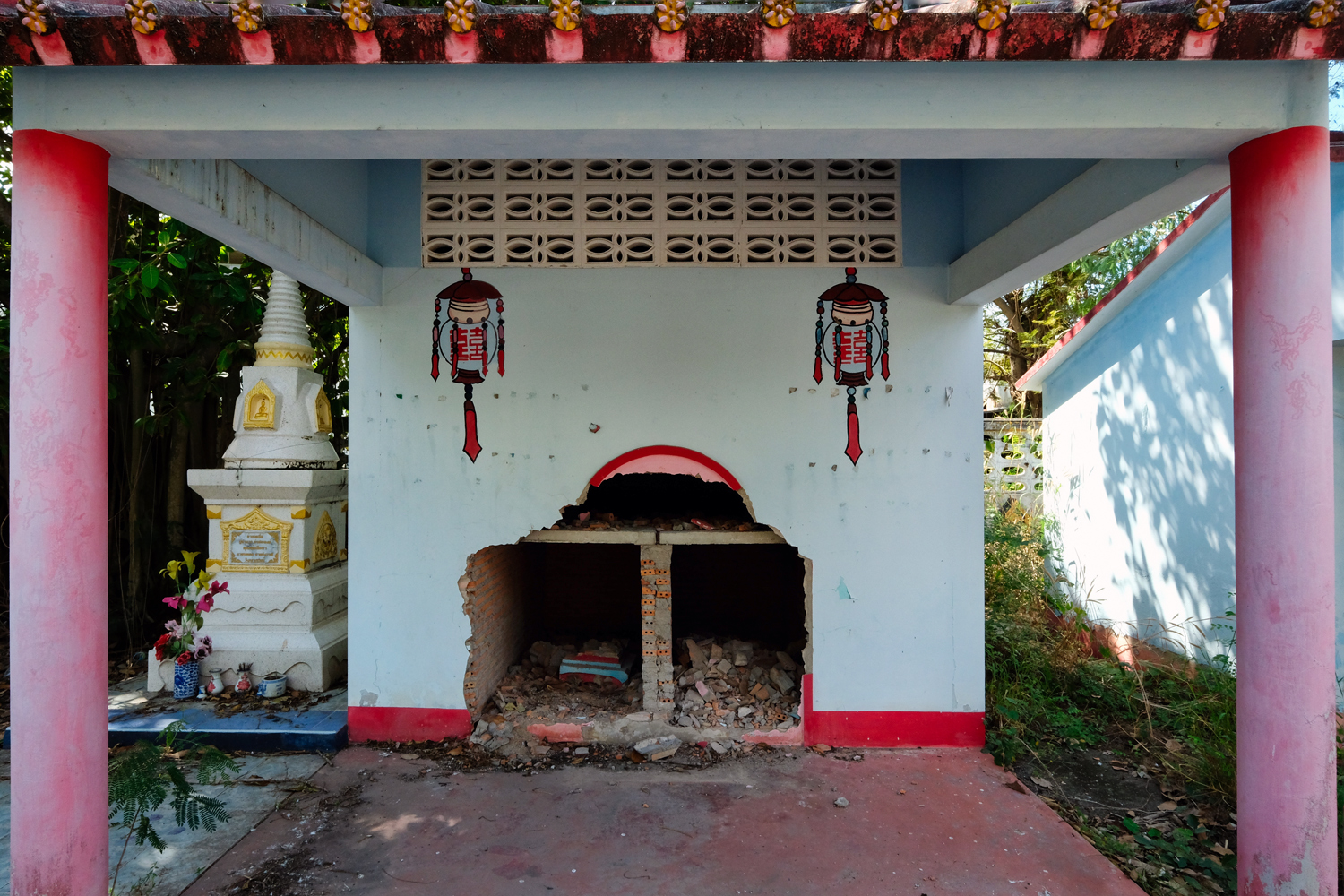 I asked John if he thought someone had busted into these crypts . . . or busted out? He said he didn't want to think about that.
I asked John if he thought someone had busted into these crypts . . . or busted out? He said he didn't want to think about that.
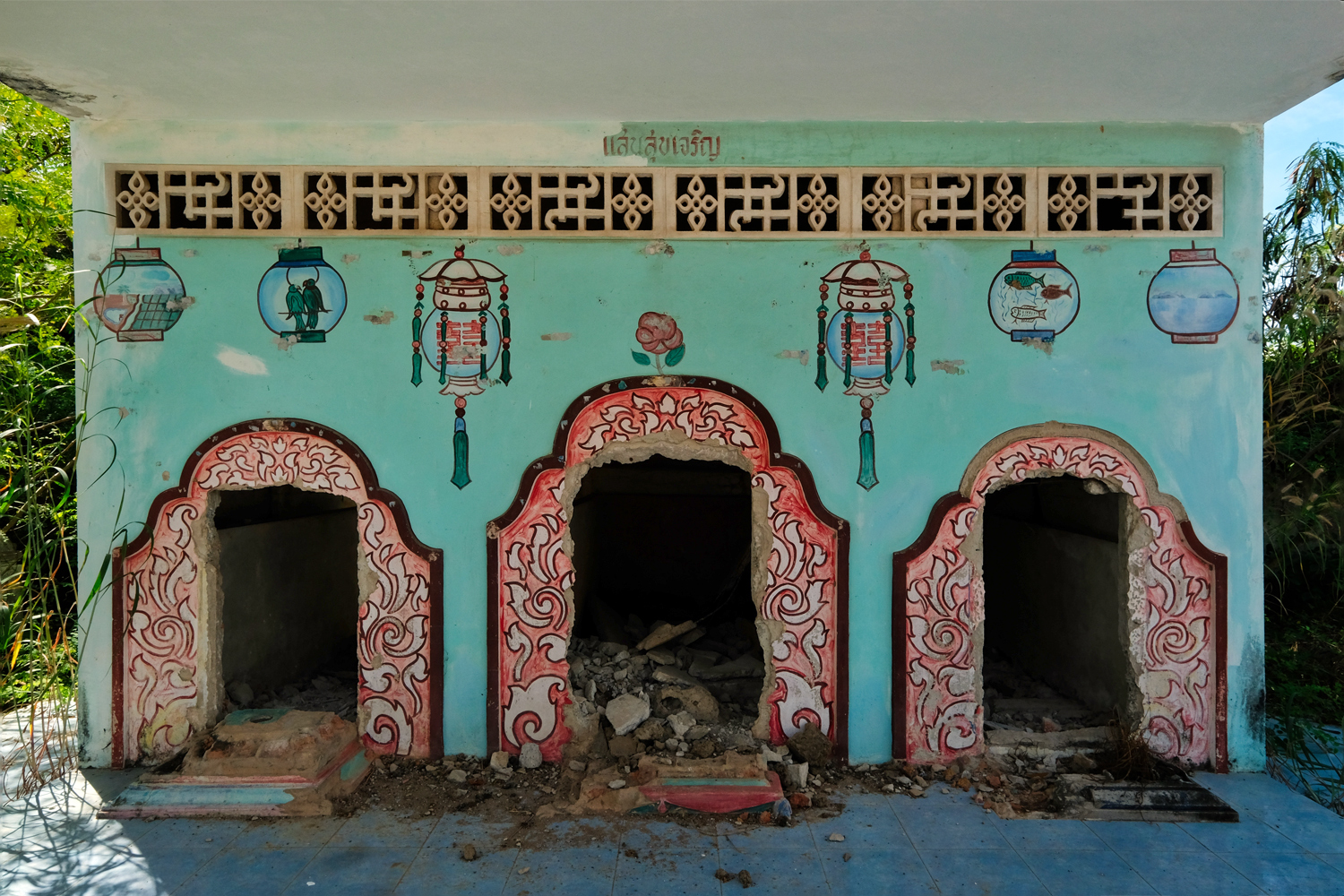 I speculated that a family had gone 'upscale' with their ancestor burials . . . meaning they came into some money, or moved from the area, and wanted to move the Dearly Departed to a new grave site. I hope I'm right.
I speculated that a family had gone 'upscale' with their ancestor burials . . . meaning they came into some money, or moved from the area, and wanted to move the Dearly Departed to a new grave site. I hope I'm right.
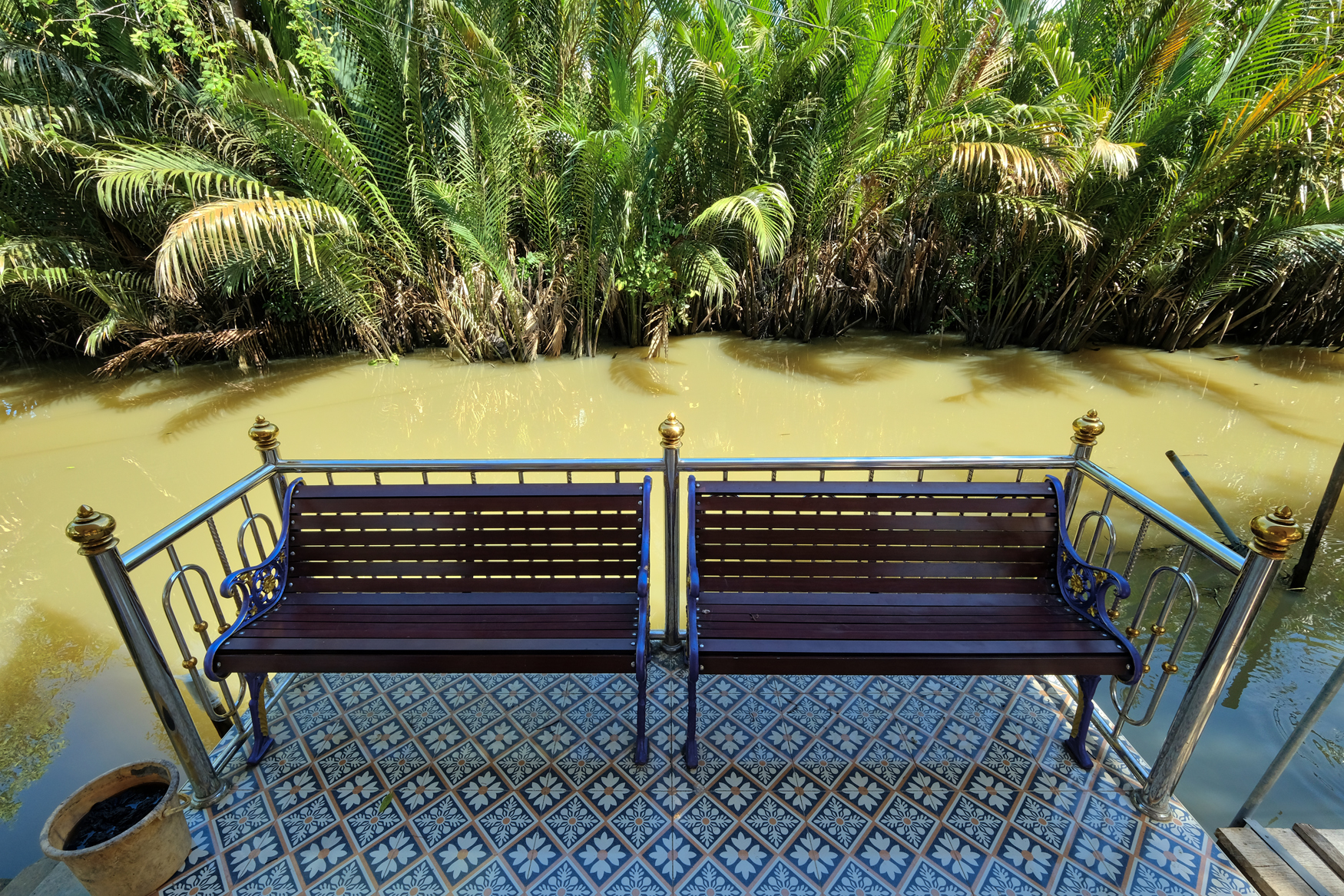 We didn't find a bridge over to the giant Buddha, but we did find some beautiful scenes.
We didn't find a bridge over to the giant Buddha, but we did find some beautiful scenes.
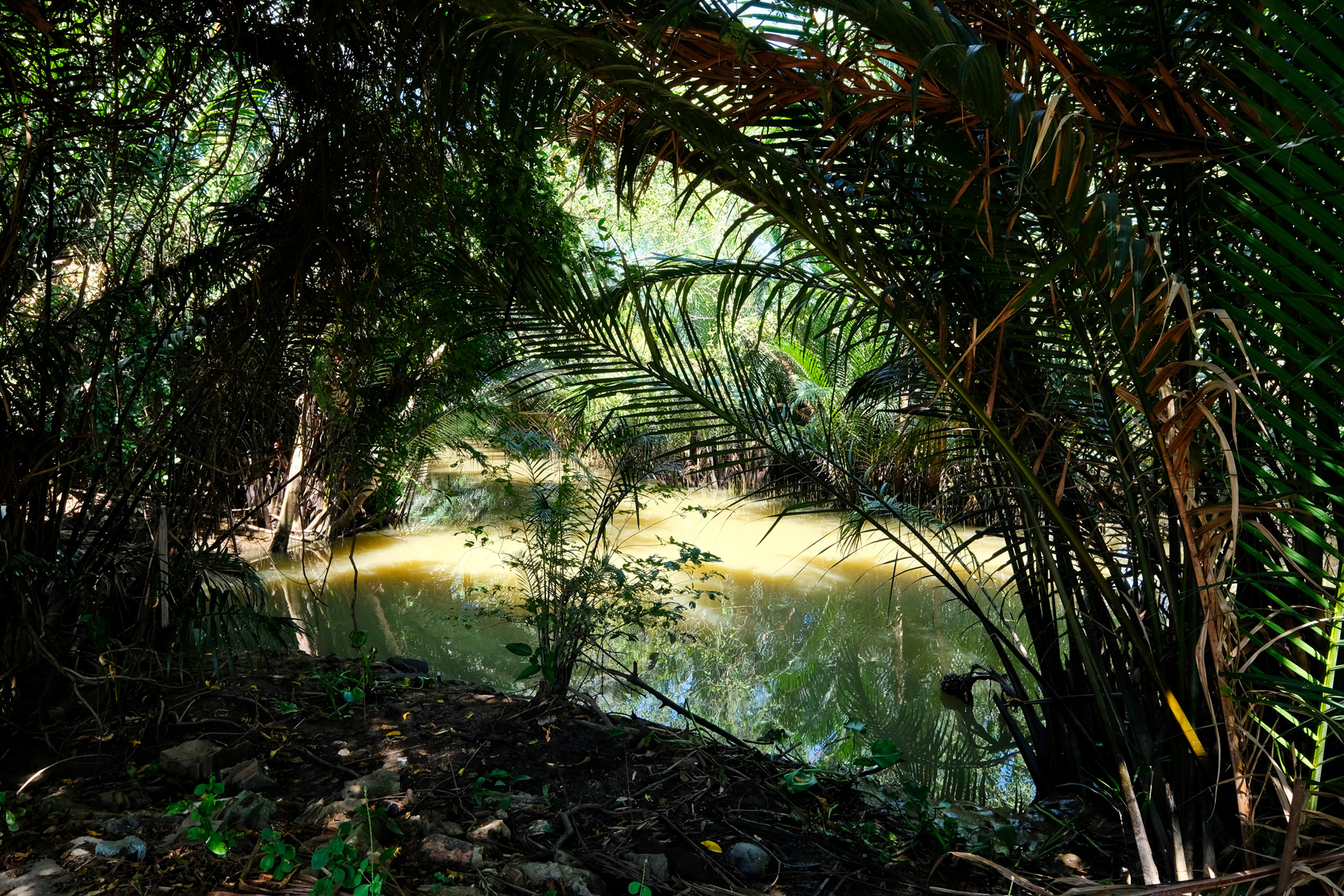 There was no way through the swamp to the other side.
There was no way through the swamp to the other side.
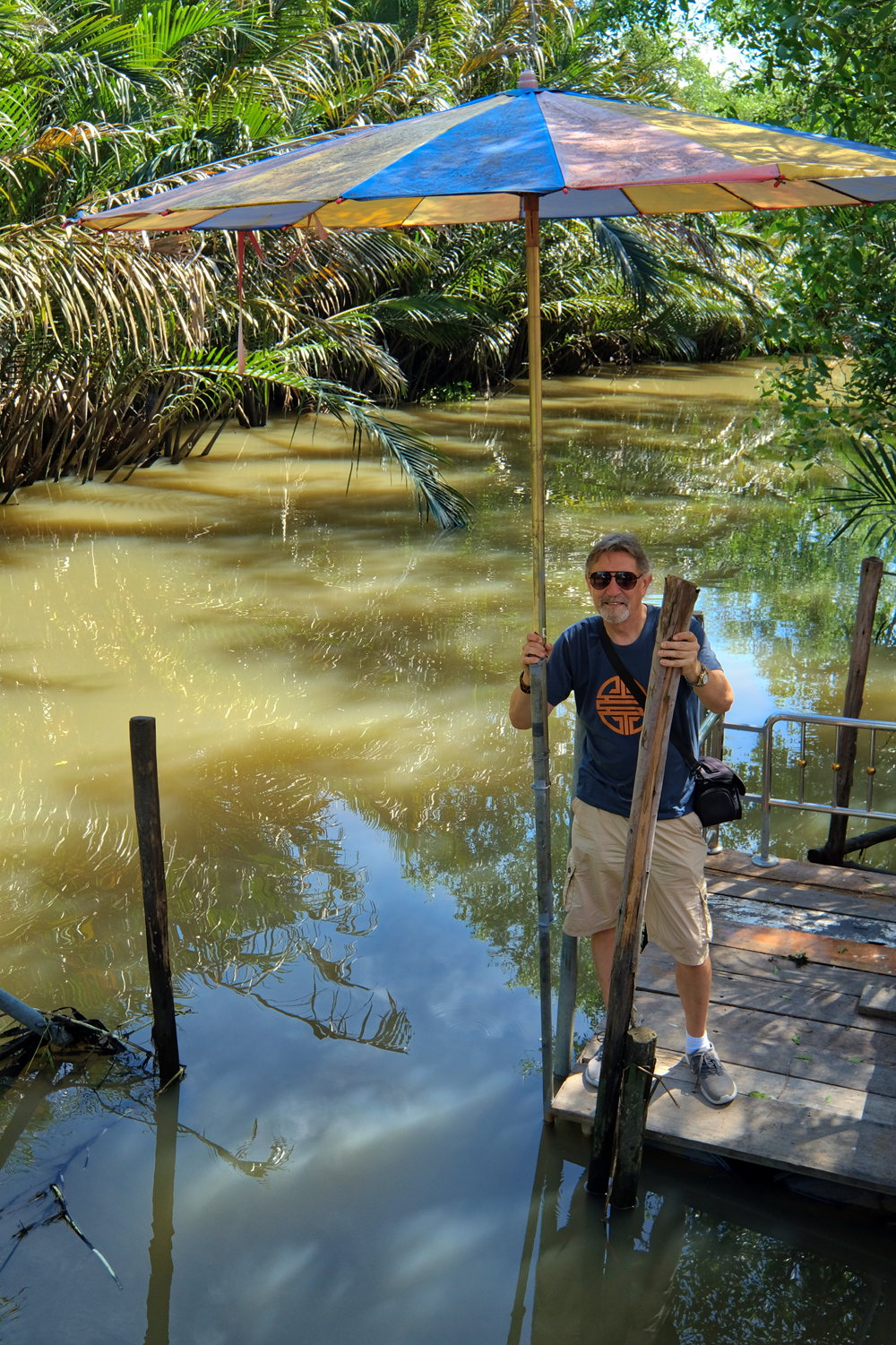 So, John and I decided to get in my truck and see if we couldn't find the giant Buddha.
So, John and I decided to get in my truck and see if we couldn't find the giant Buddha.
PART FOUR: CHINESE CULTURAL CENTER
 At last! We found the Chinese Cultural Center . . . just opened last year . . . and brand spanking new. Beautiful!
At last! We found the Chinese Cultural Center . . . just opened last year . . . and brand spanking new. Beautiful!
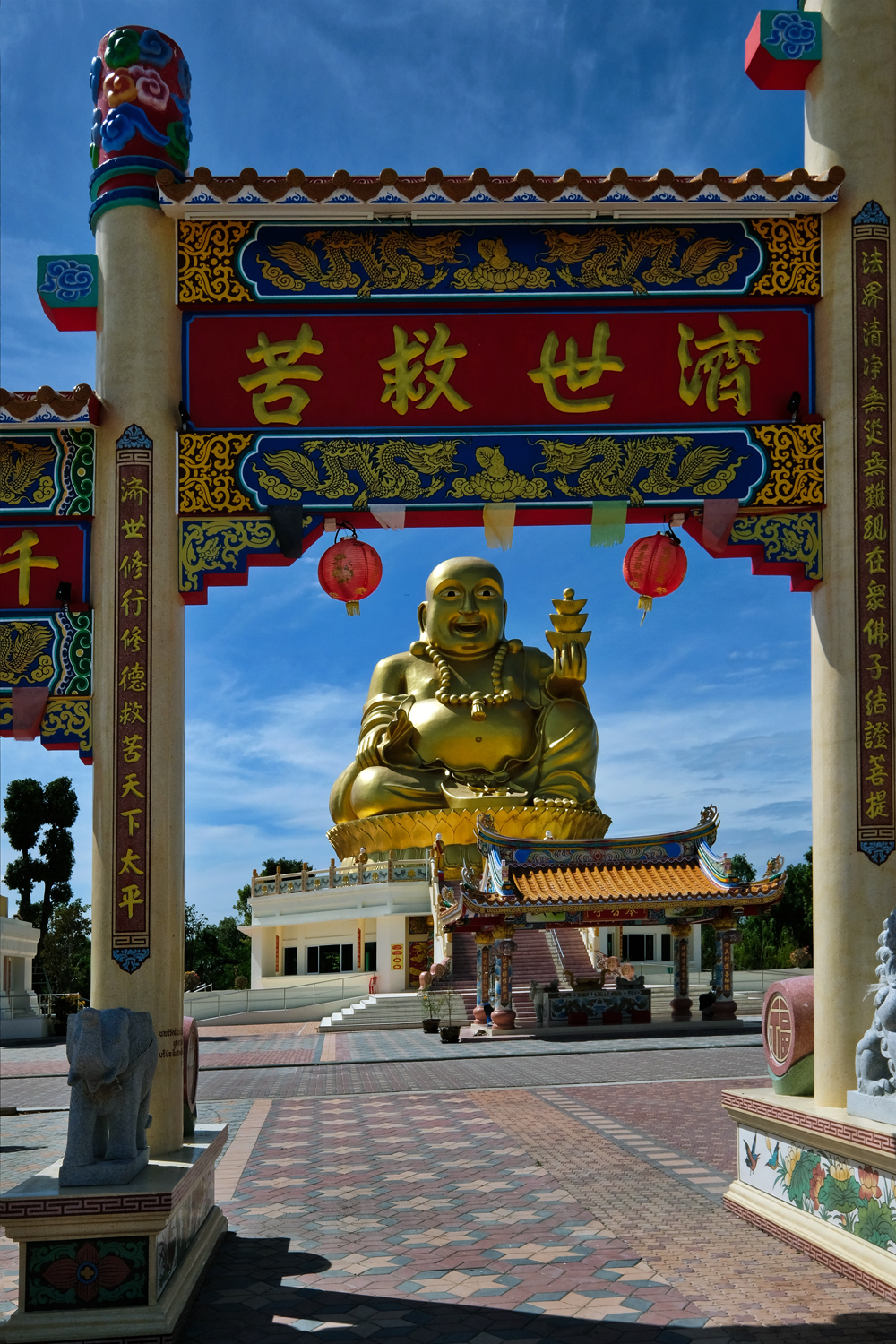 We paid a small donation and a guide took us around to the various altars and showed us the ropes.
We paid a small donation and a guide took us around to the various altars and showed us the ropes.
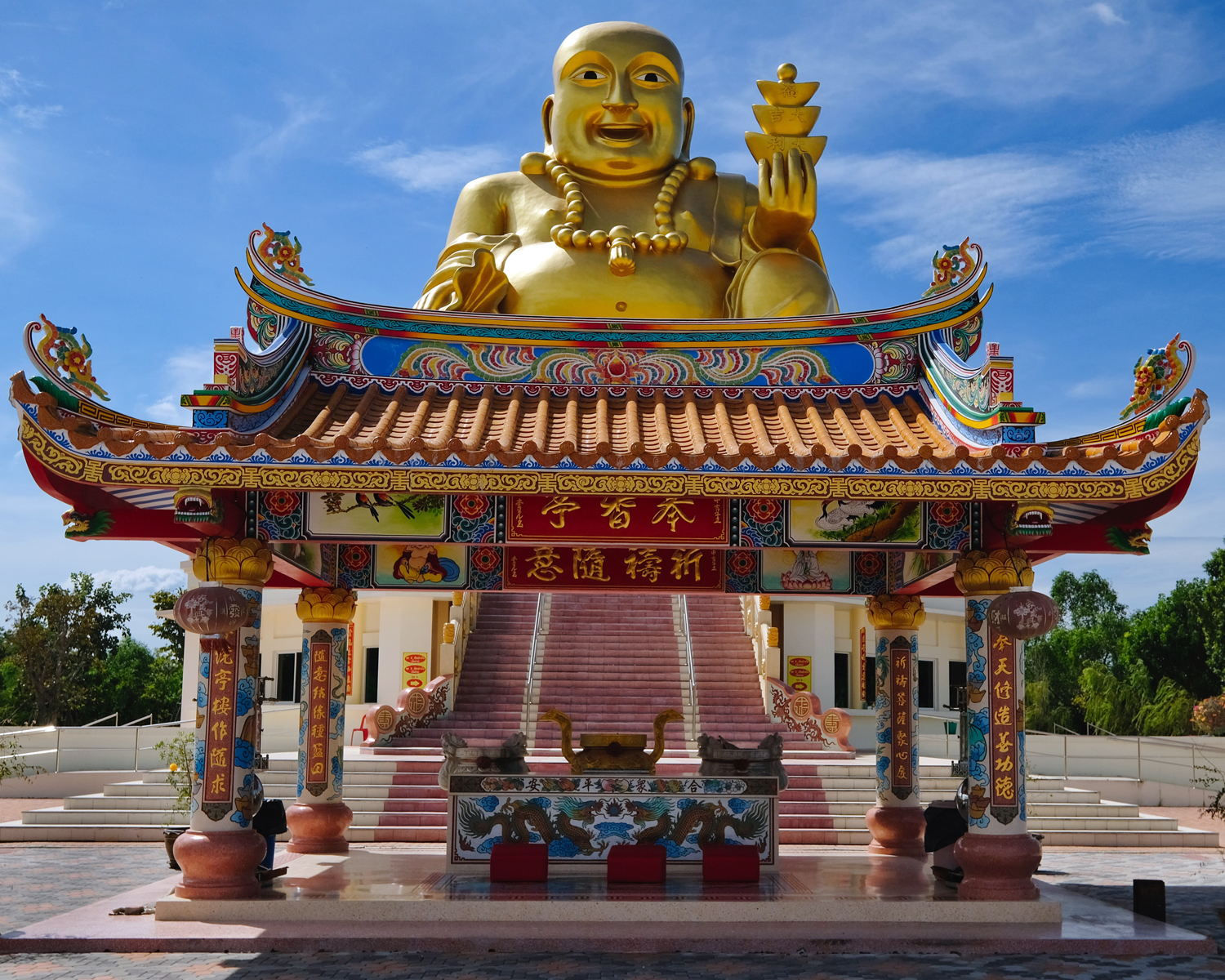 Gorgeous colossal statuary.
Gorgeous colossal statuary.
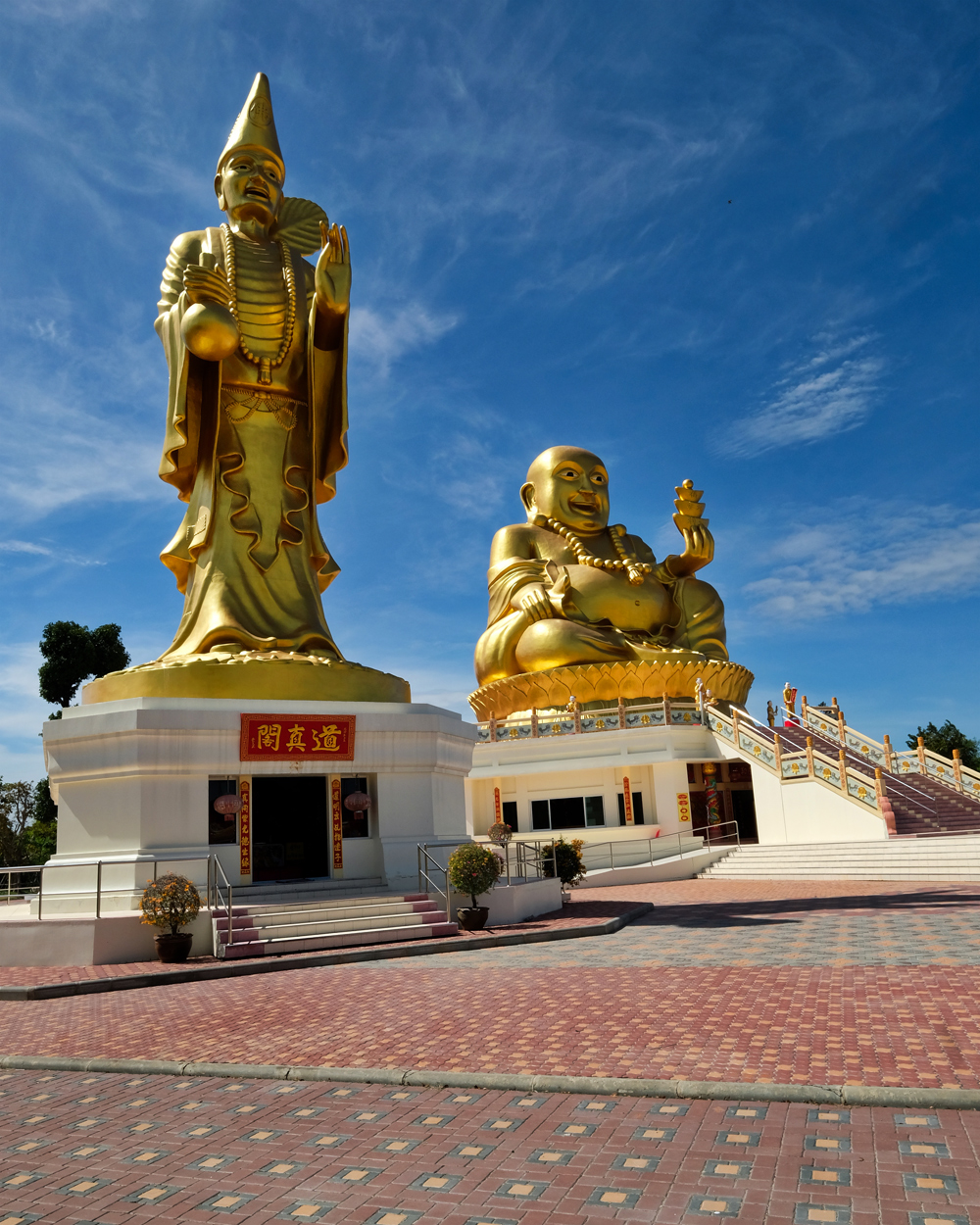 I was especially excited about this temple because I am a follower and admirer of my old buddy Ji Gong, the idiosyncratic Chinese monk who was a defender of the weak against injustice.
I was especially excited about this temple because I am a follower and admirer of my old buddy Ji Gong, the idiosyncratic Chinese monk who was a defender of the weak against injustice.
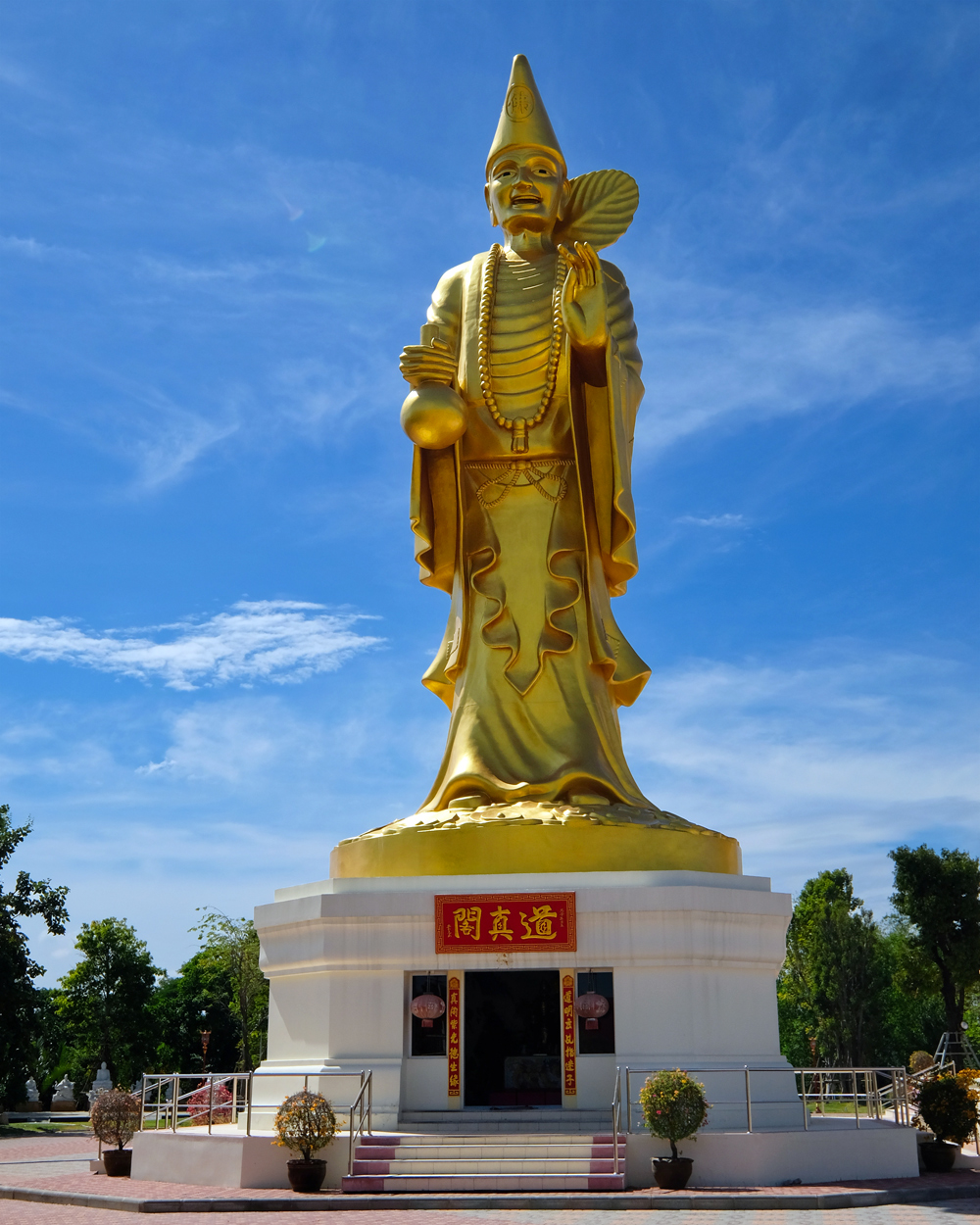 Ji Gong, my old buddy. (Ask me why I always say 'my old buddy' when I mention Ji Gong next time we meet.)
Ji Gong, my old buddy. (Ask me why I always say 'my old buddy' when I mention Ji Gong next time we meet.)
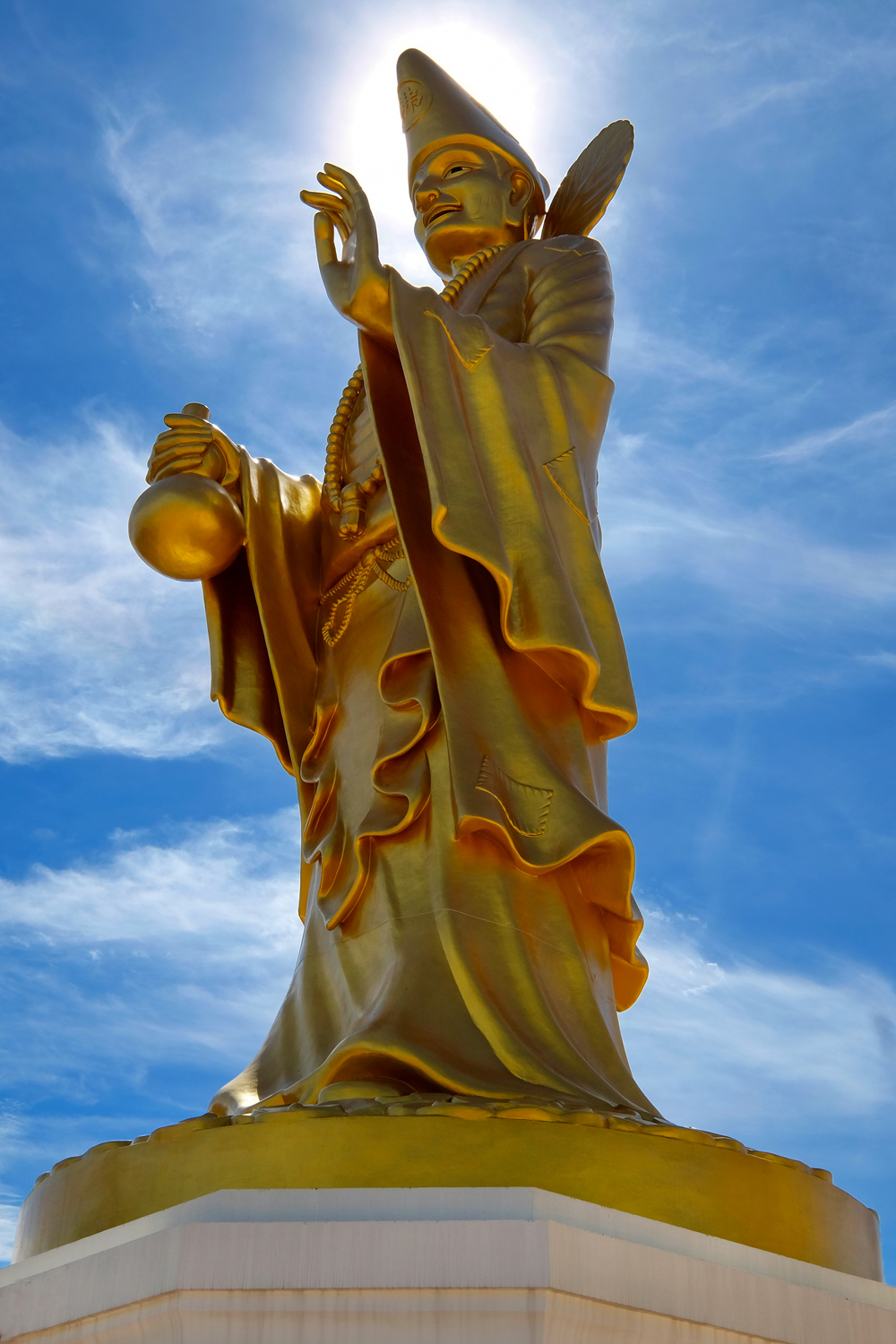 My old buddy, Ji Gong.
My old buddy, Ji Gong.
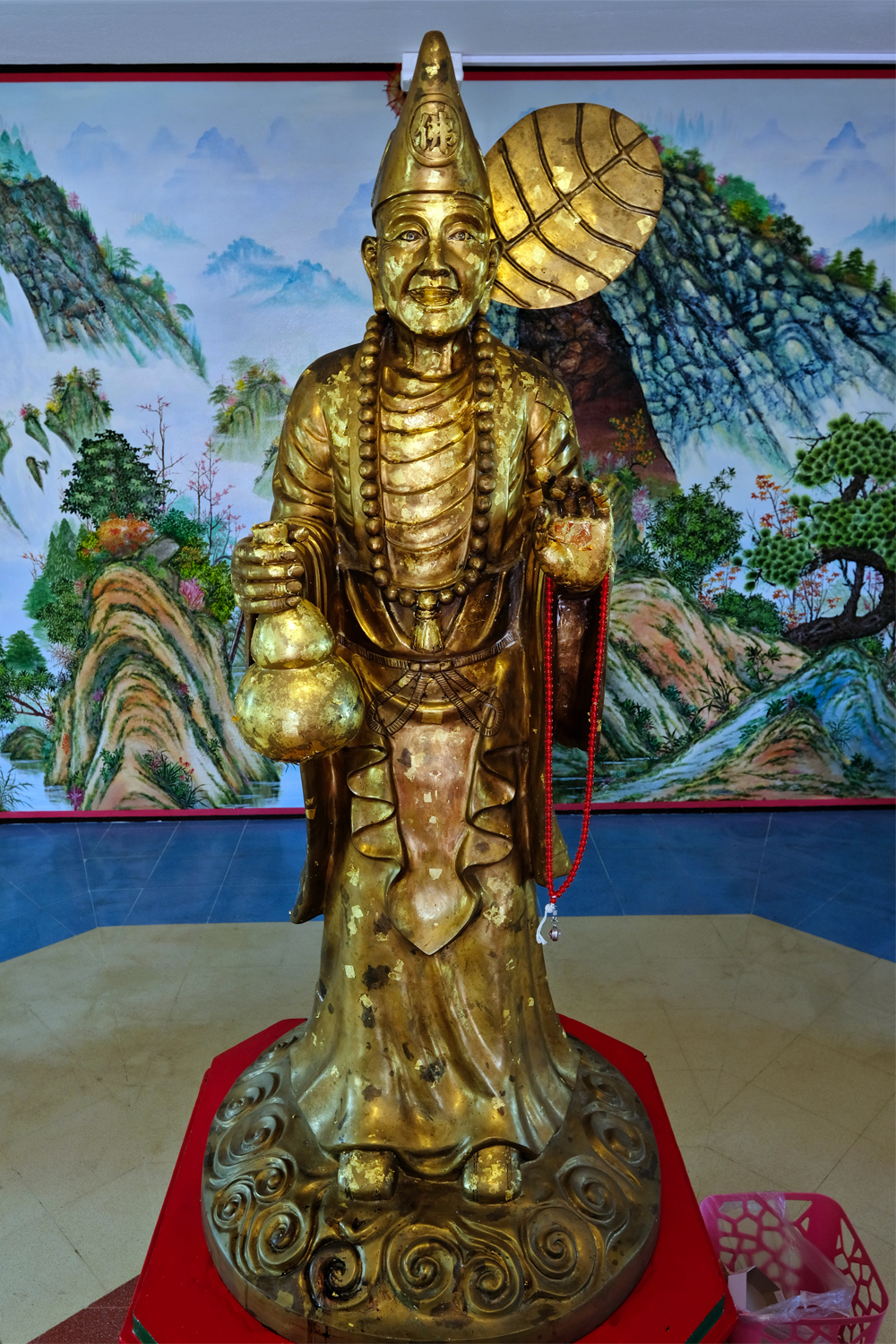 I went into the Ji Gong shrine at the base of the giant statue and paid my respects.
I went into the Ji Gong shrine at the base of the giant statue and paid my respects.
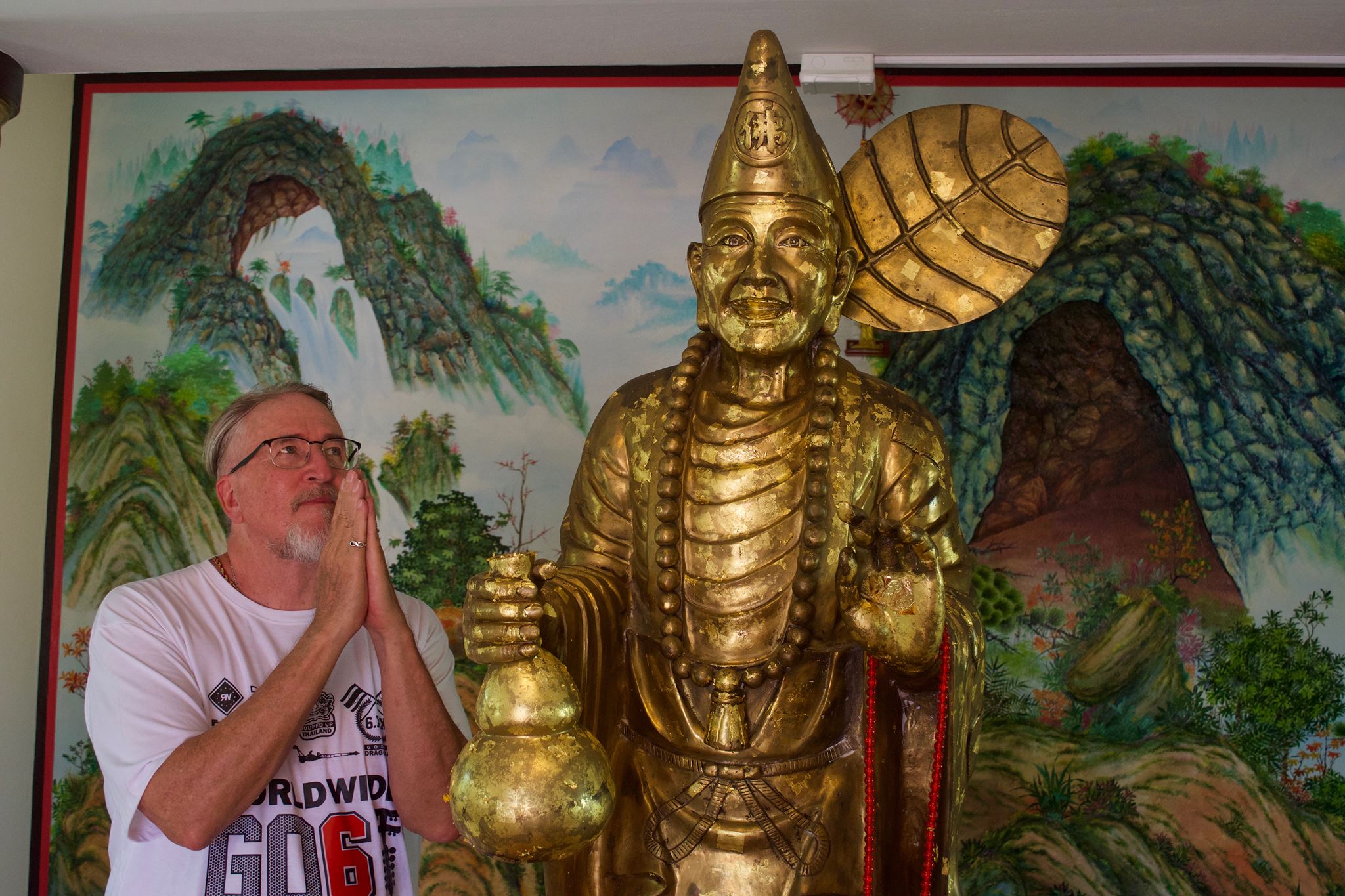 Showing respect to my old buddy, Ji Gong.
Showing respect to my old buddy, Ji Gong.
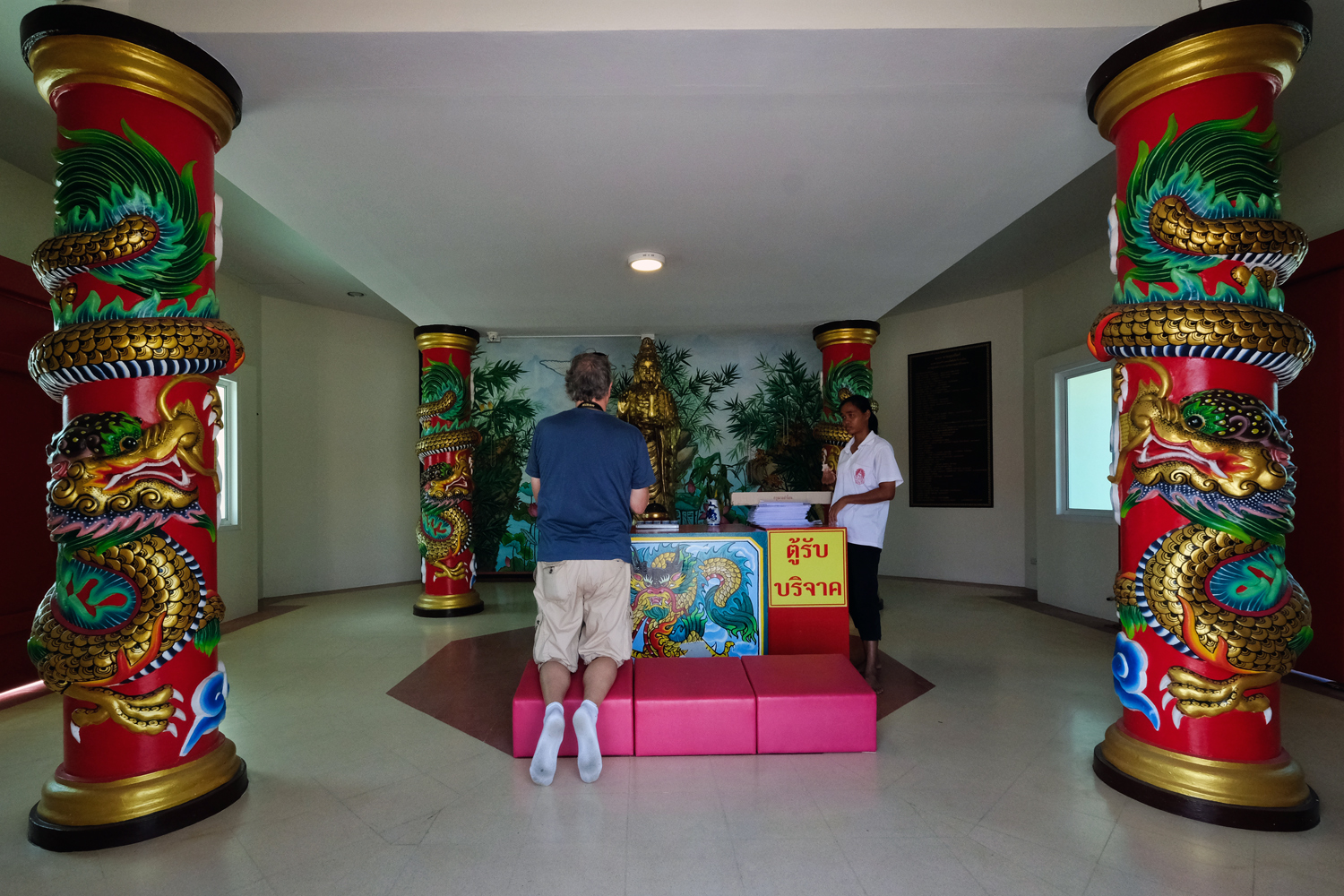 The guide showing John the proper ceremonial details.
The guide showing John the proper ceremonial details.
 I go to many Chinese religious temples in Bangkok, but this was not an old temple as I as used to . . . it was brand new!
I go to many Chinese religious temples in Bangkok, but this was not an old temple as I as used to . . . it was brand new!
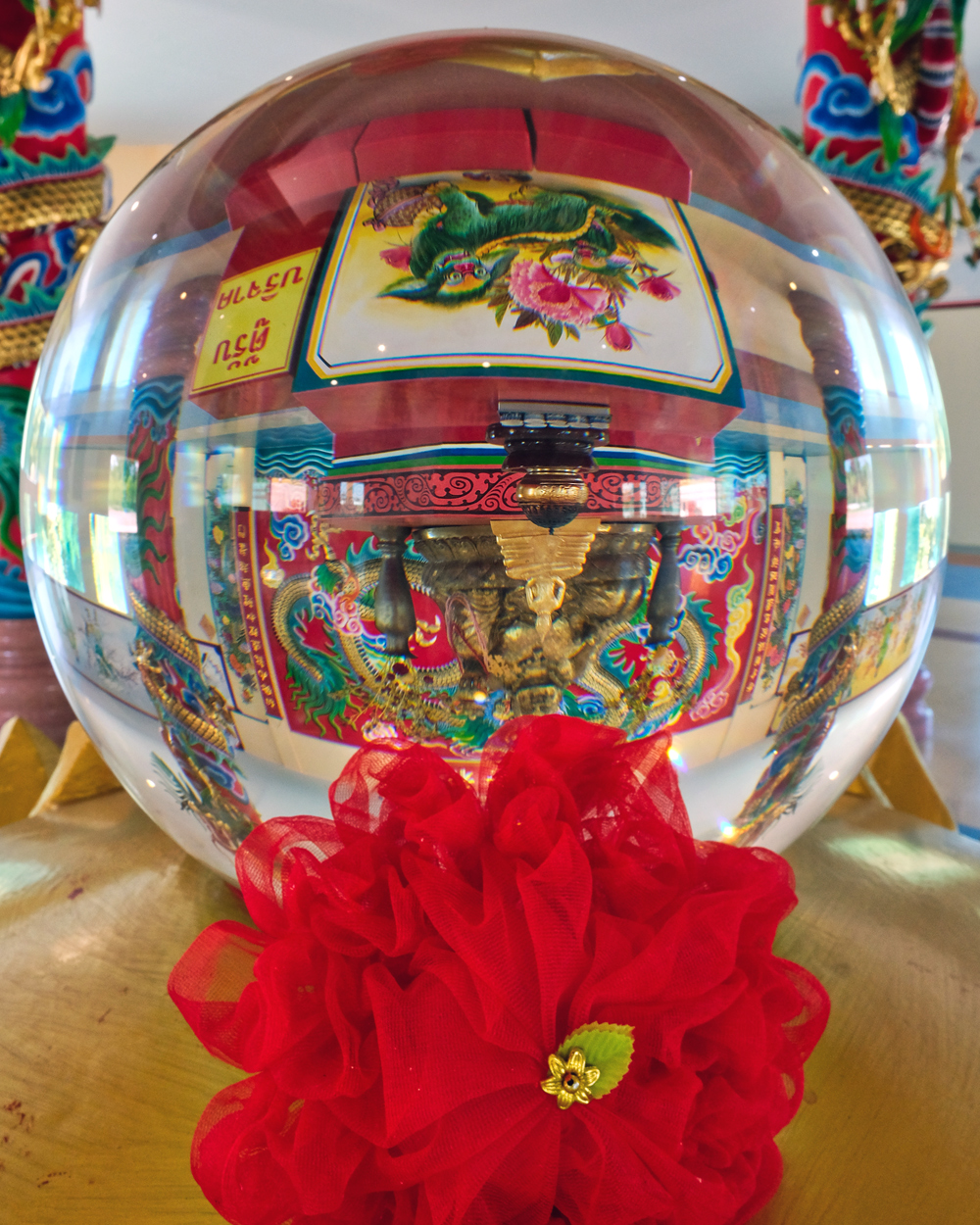 Fascinating images inside the shrines.
Fascinating images inside the shrines.
 Temple Buddhas.
Temple Buddhas.
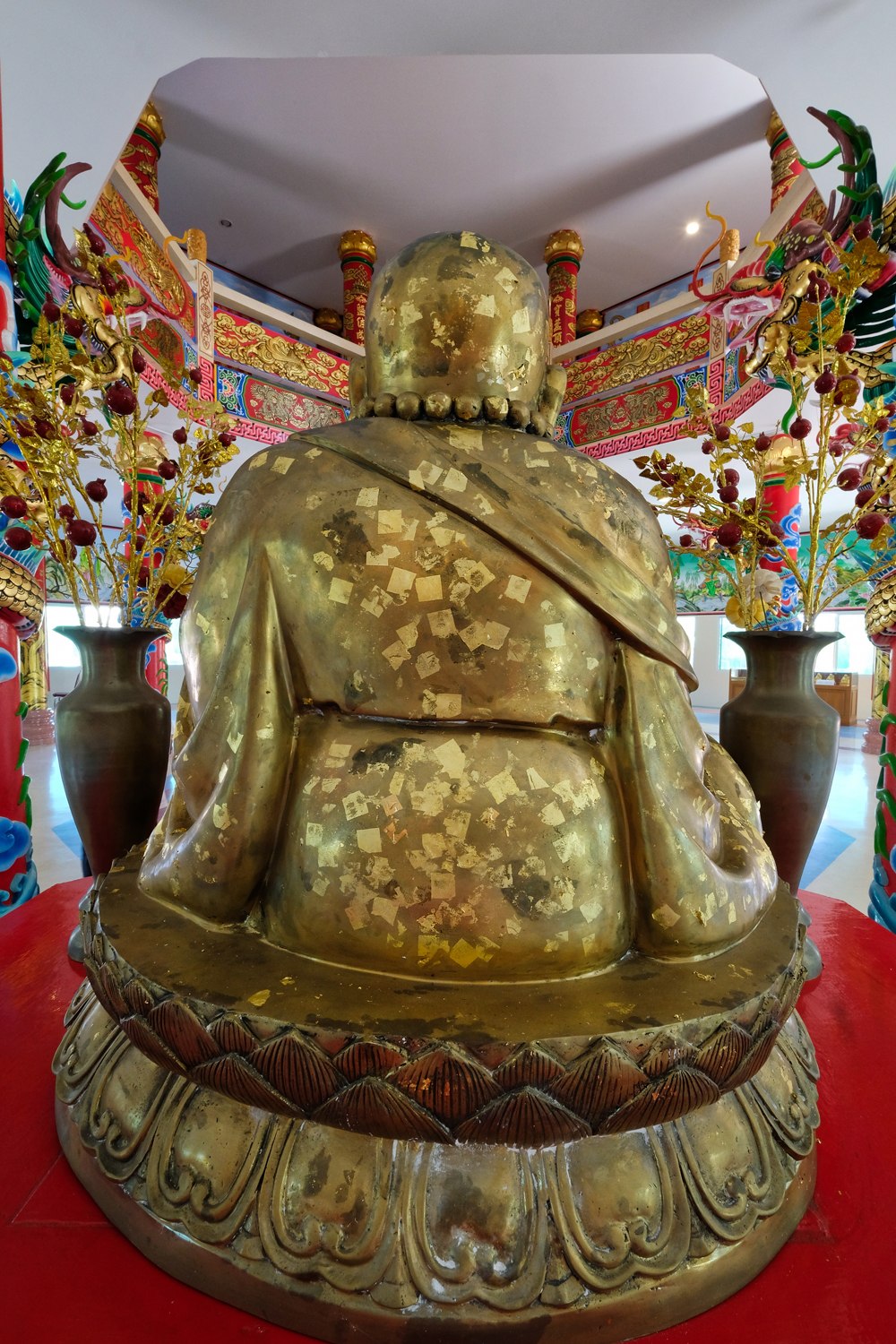 The back of a temple Buddha. John and I placed a square of gold onto several Buddhas here . . . they were included in the cost of the donation.
The back of a temple Buddha. John and I placed a square of gold onto several Buddhas here . . . they were included in the cost of the donation.
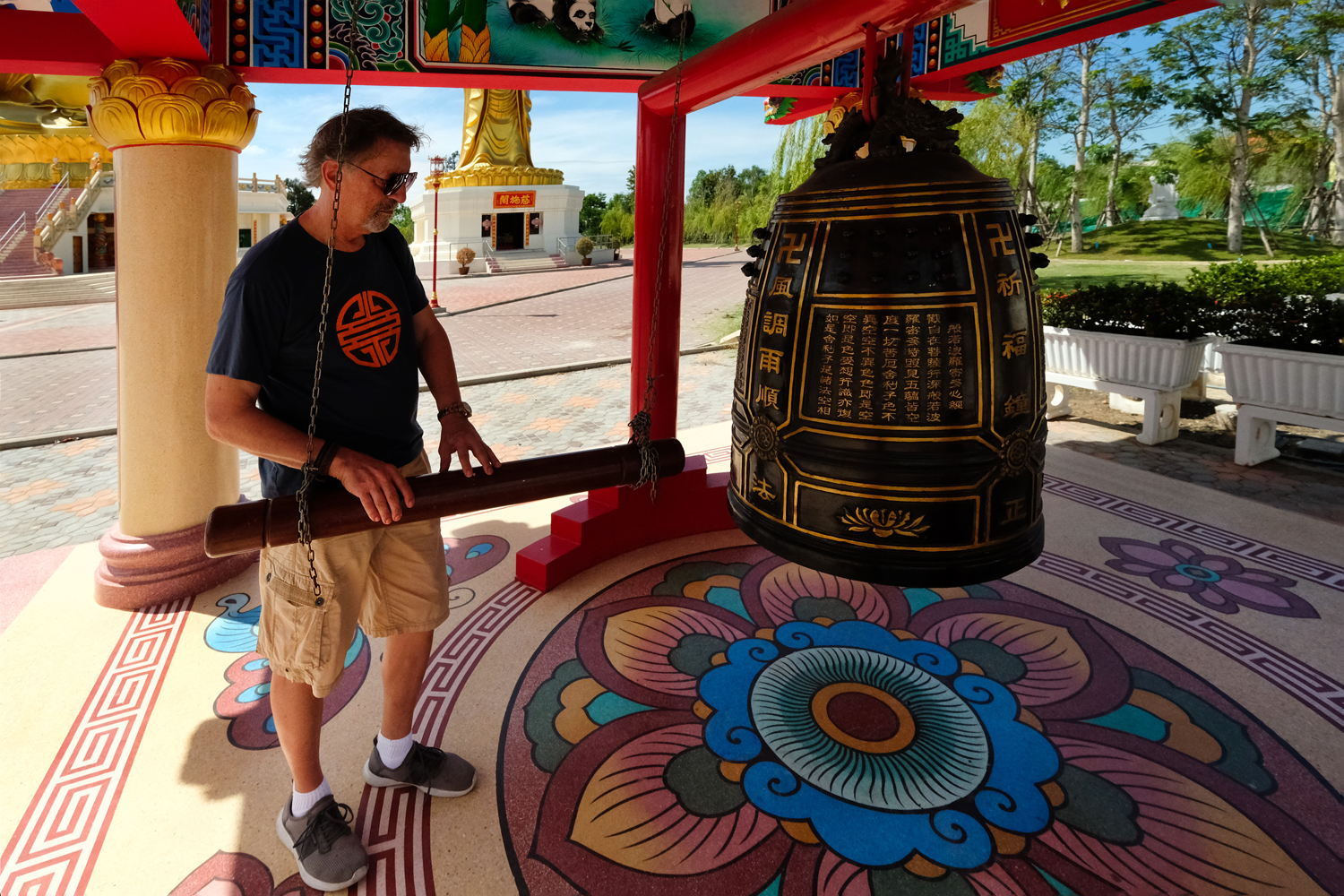 After showing respect at the shrines, our guide instructed us to ring the big bell . . .
After showing respect at the shrines, our guide instructed us to ring the big bell . . .
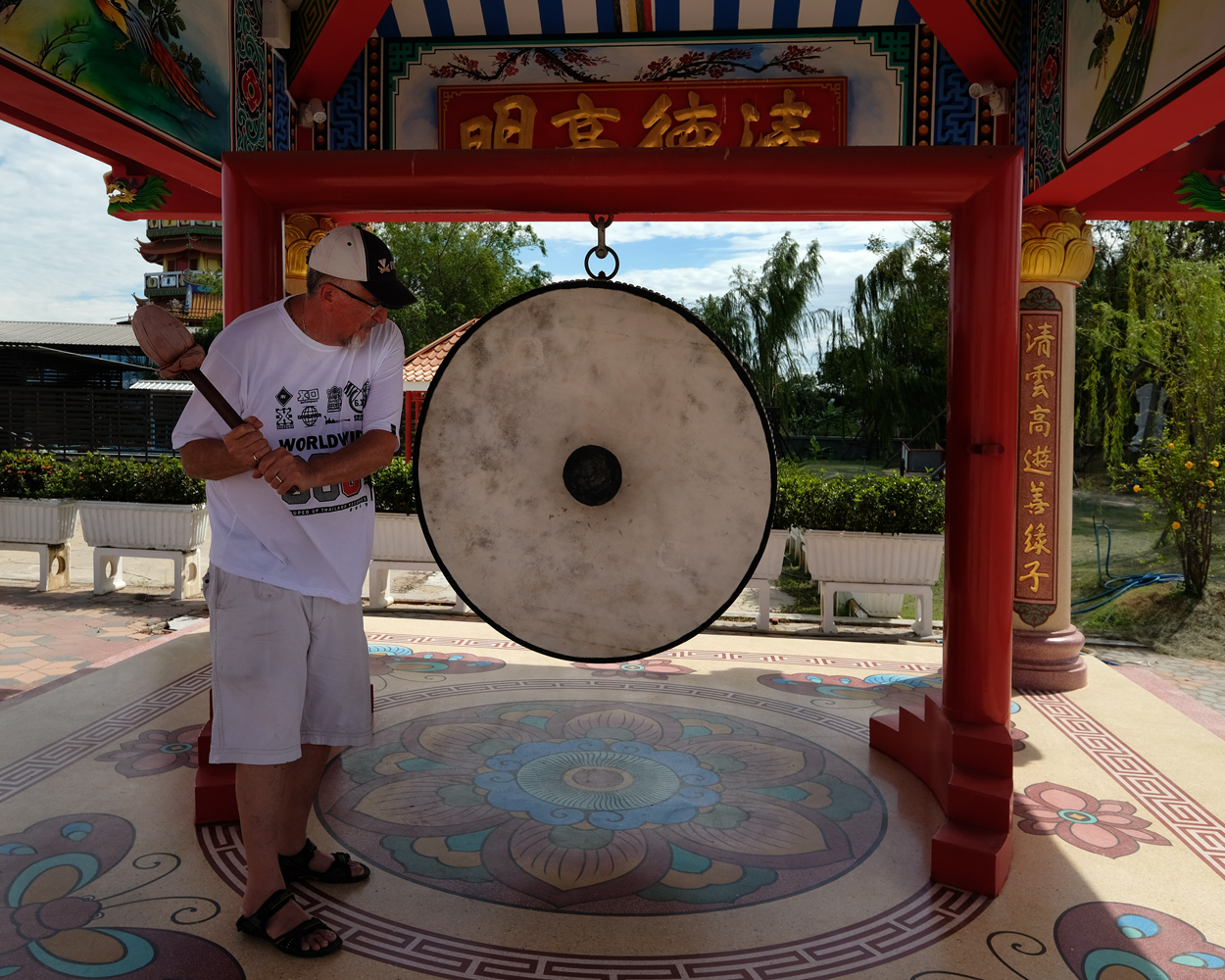 . . . and bang the big drum, each three times. We duly complied.
. . . and bang the big drum, each three times. We duly complied.
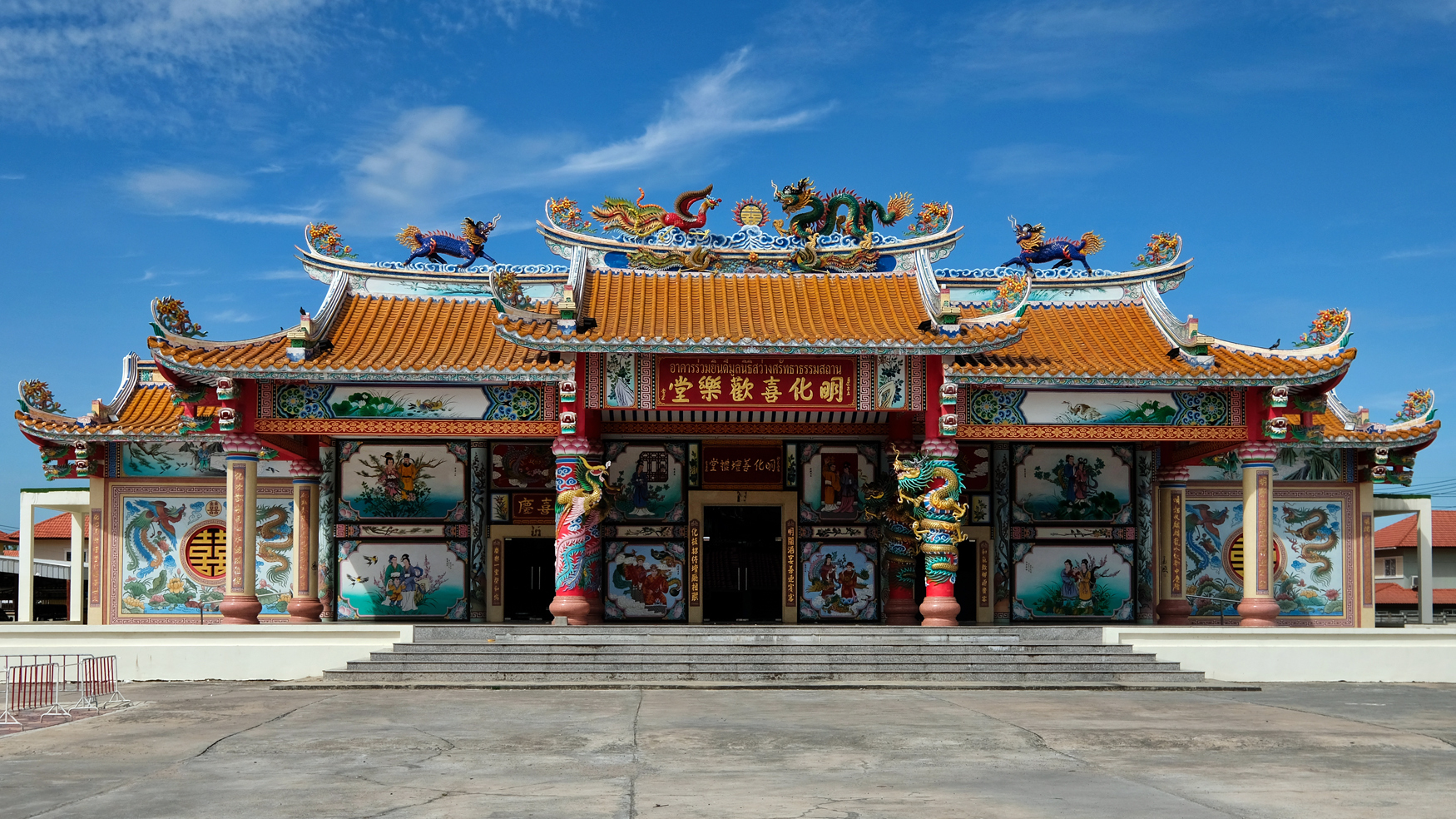
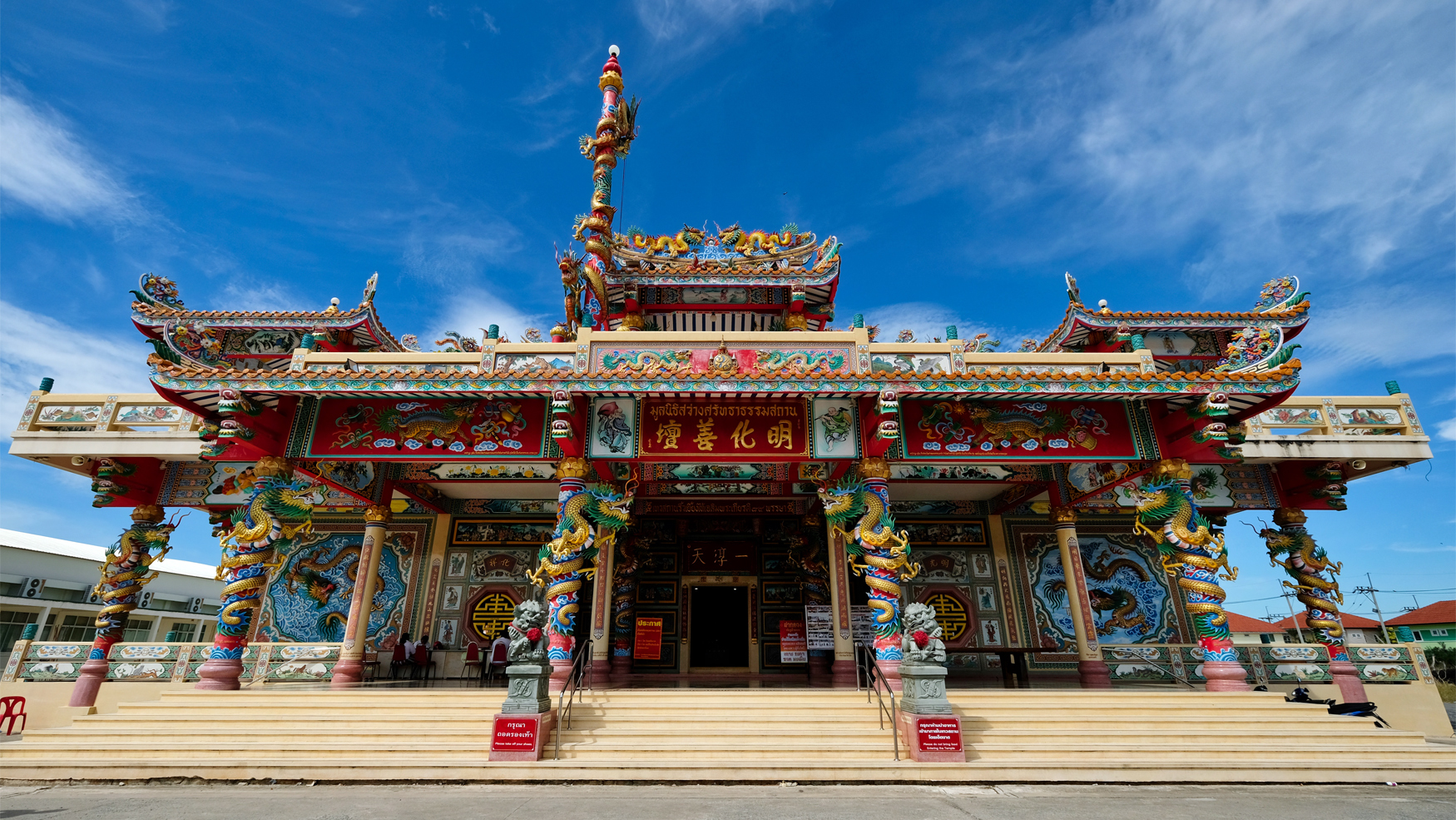 After we completed the proper ceremonies at the giant statues, they gave us some free ice water and said we were free to explore the temple buildings on our own.
After we completed the proper ceremonies at the giant statues, they gave us some free ice water and said we were free to explore the temple buildings on our own.
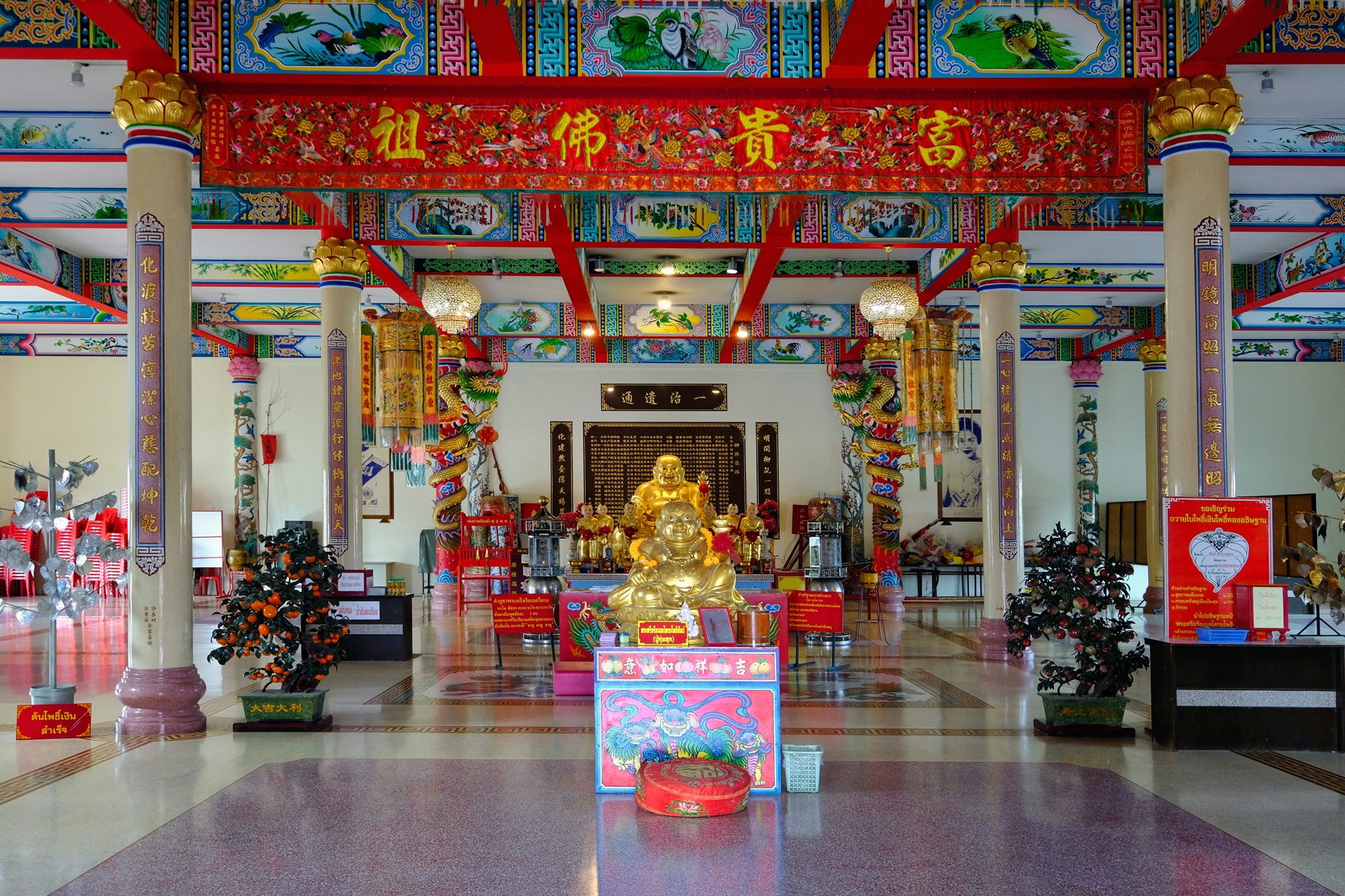 And my-o-my! The temple interiors were fantastical. Enjoy the following photos!
And my-o-my! The temple interiors were fantastical. Enjoy the following photos!
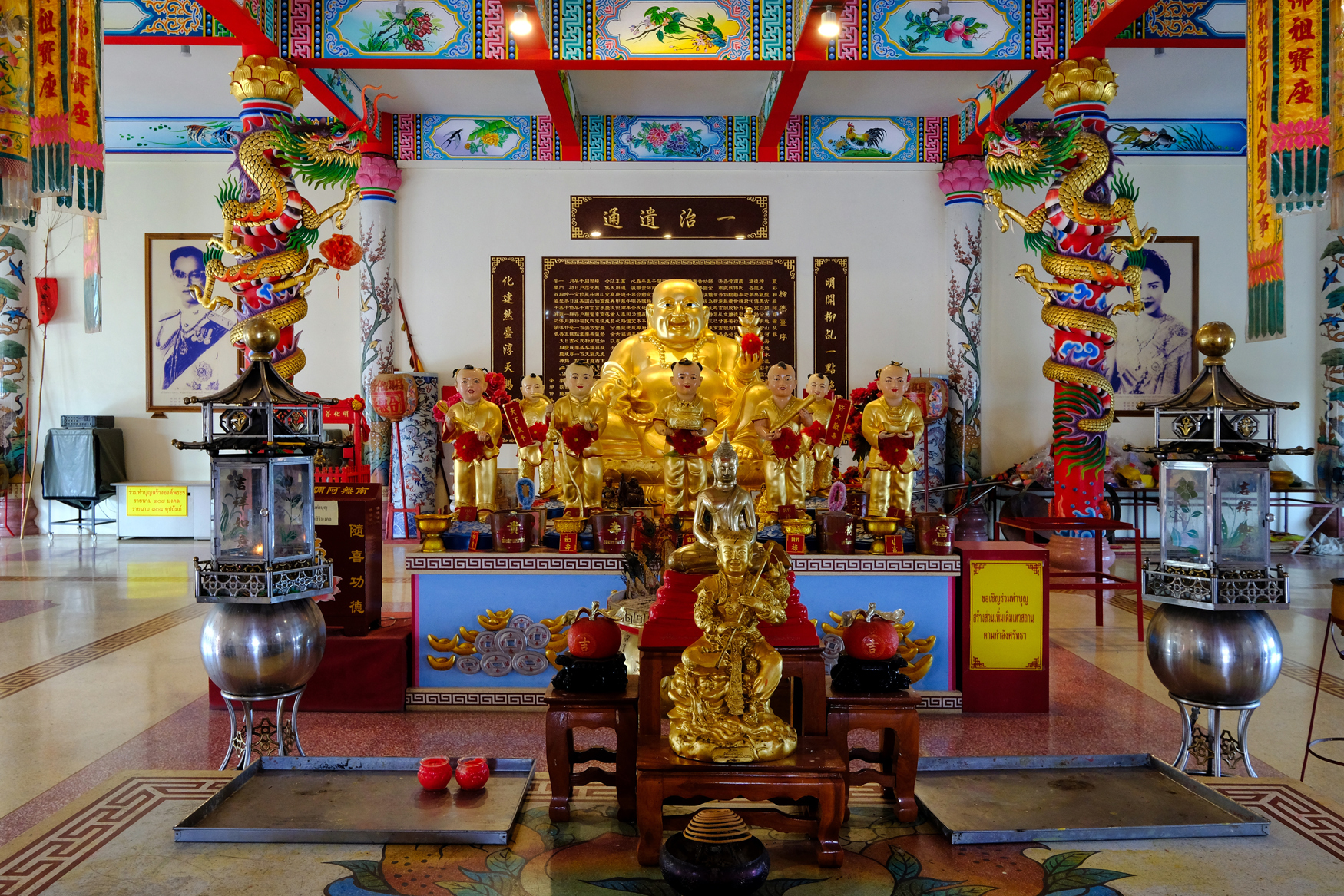
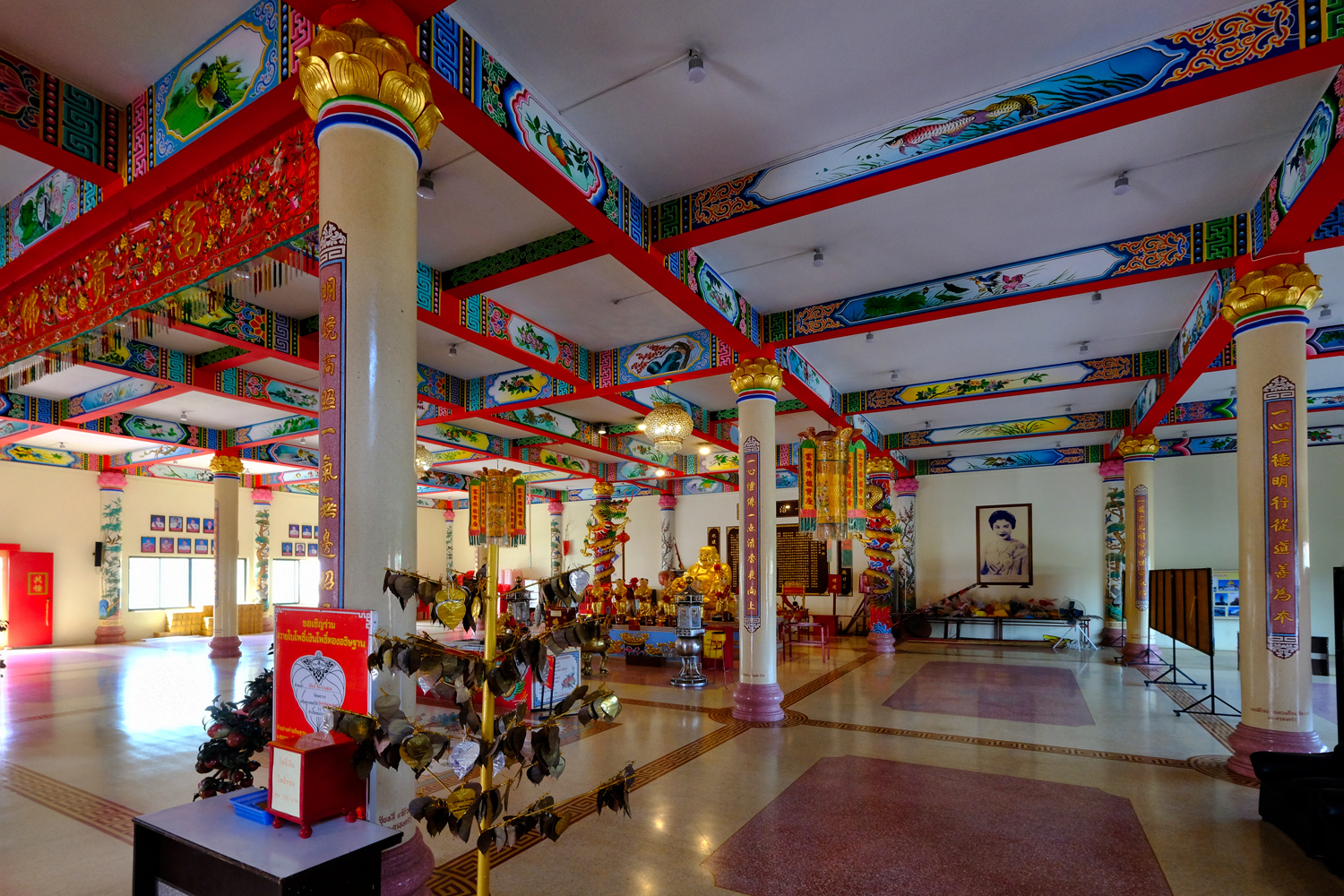
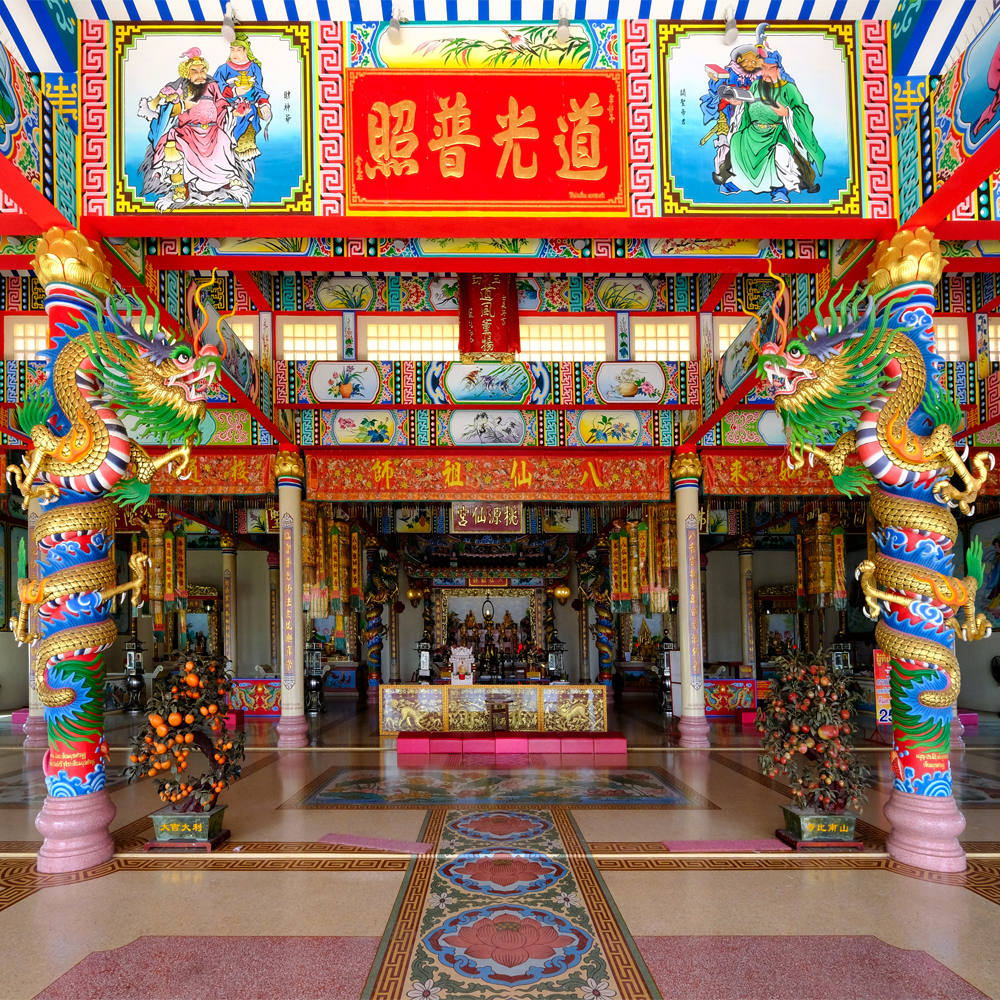
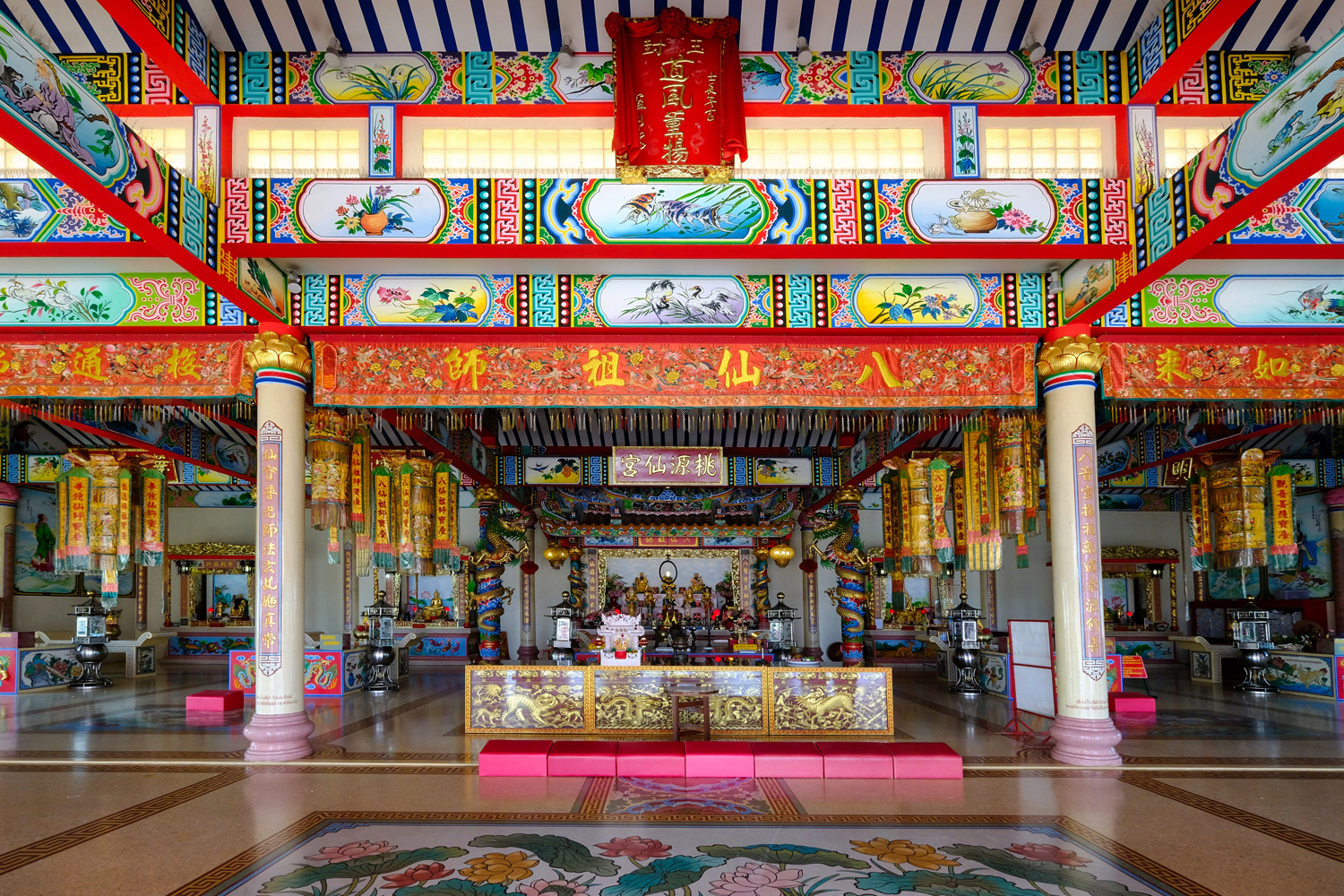
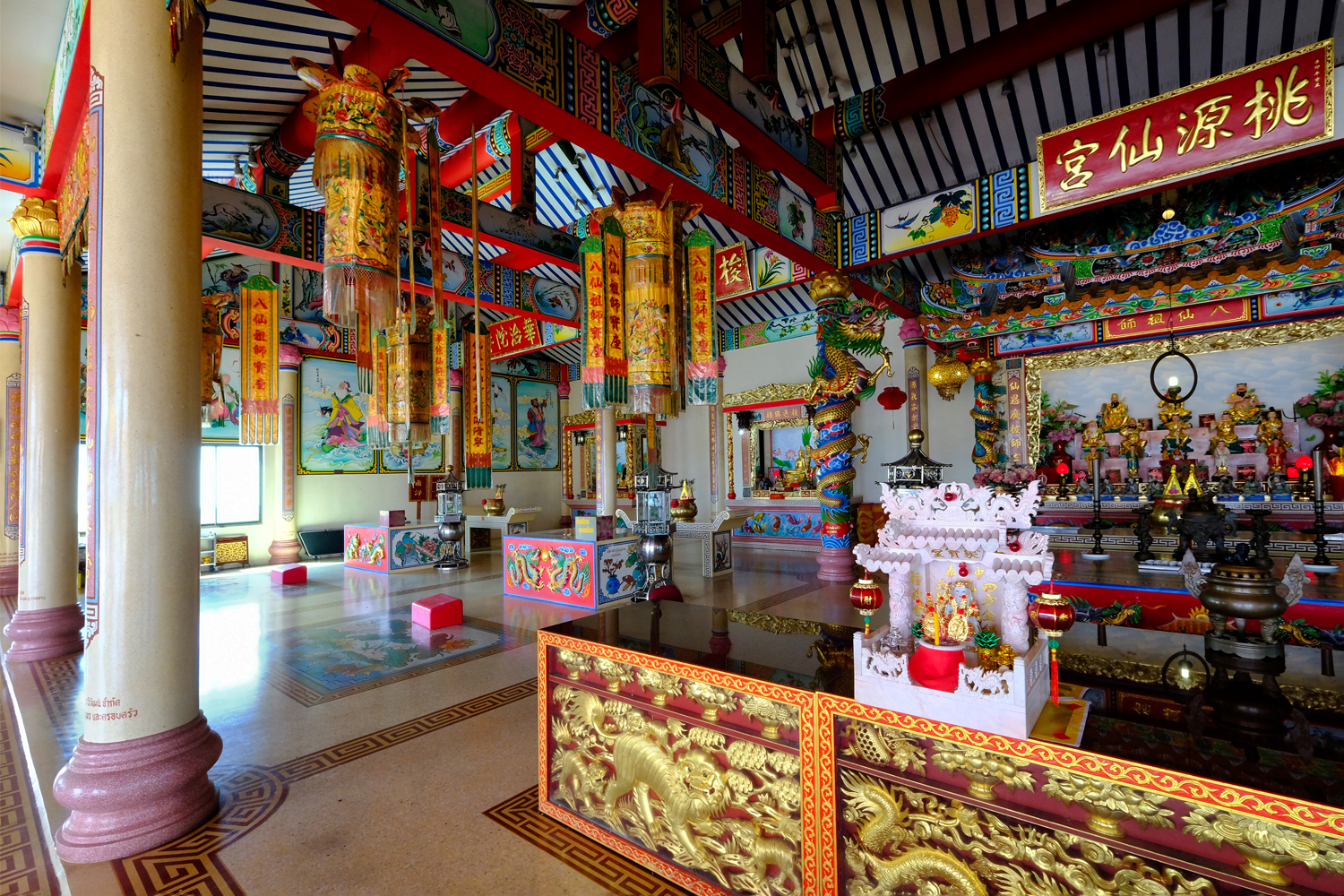
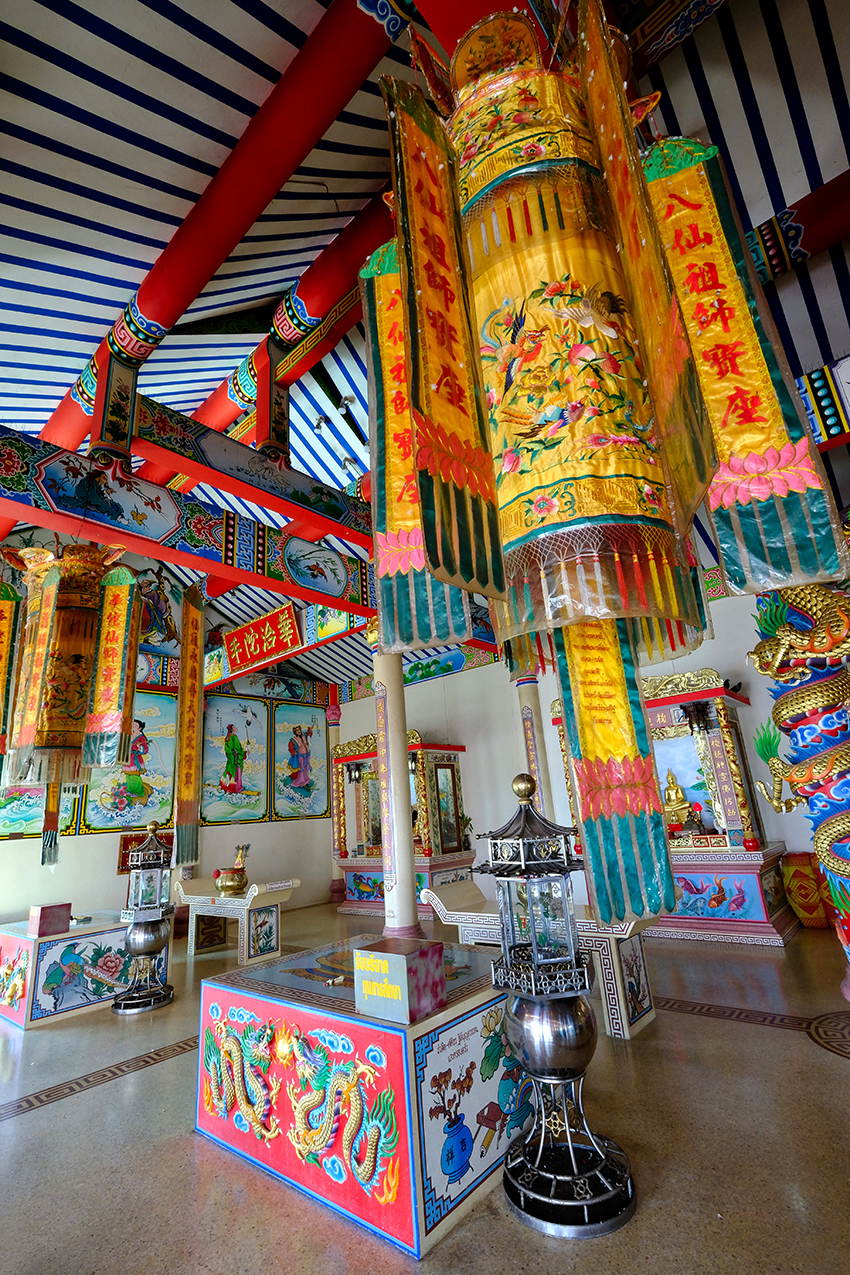
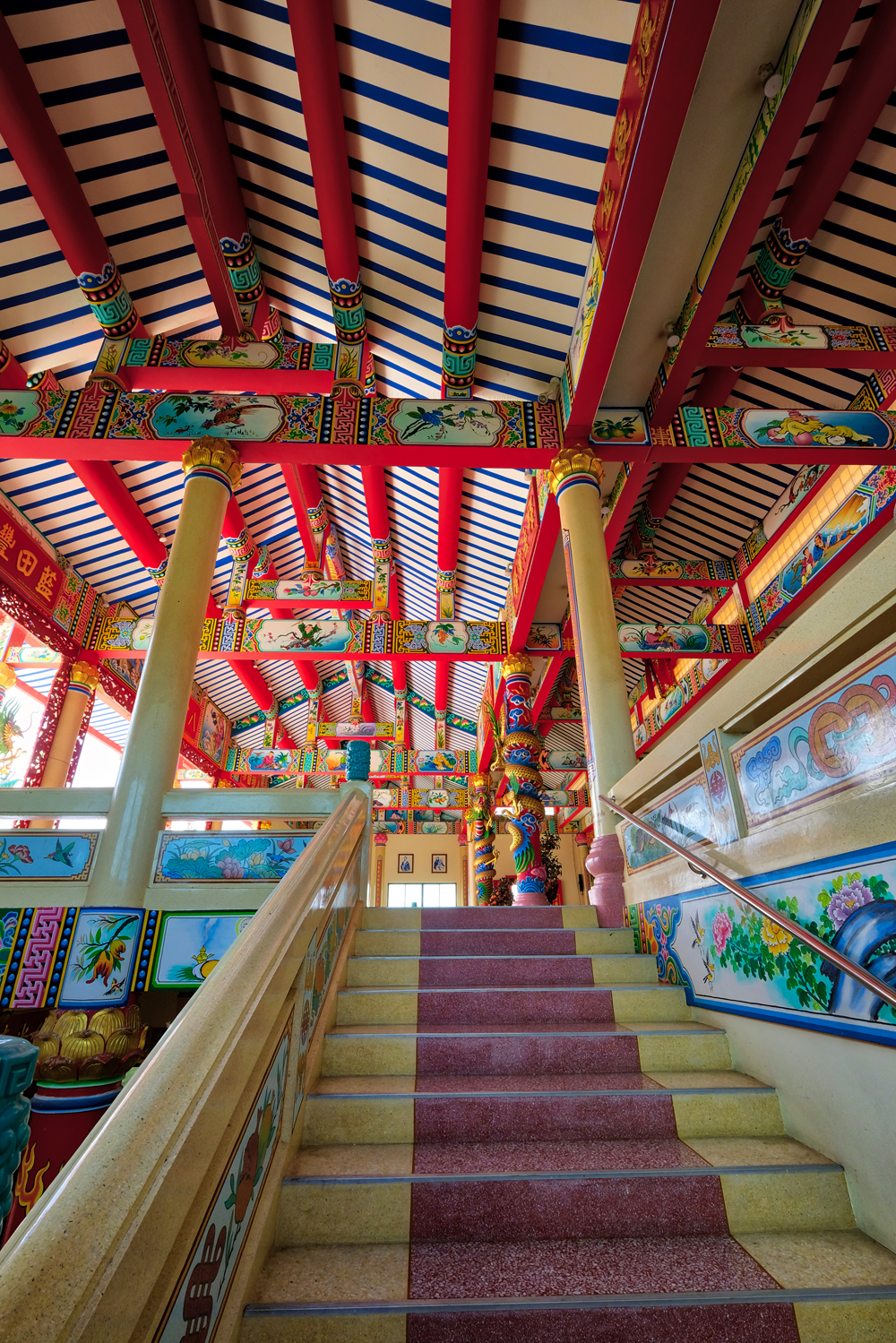
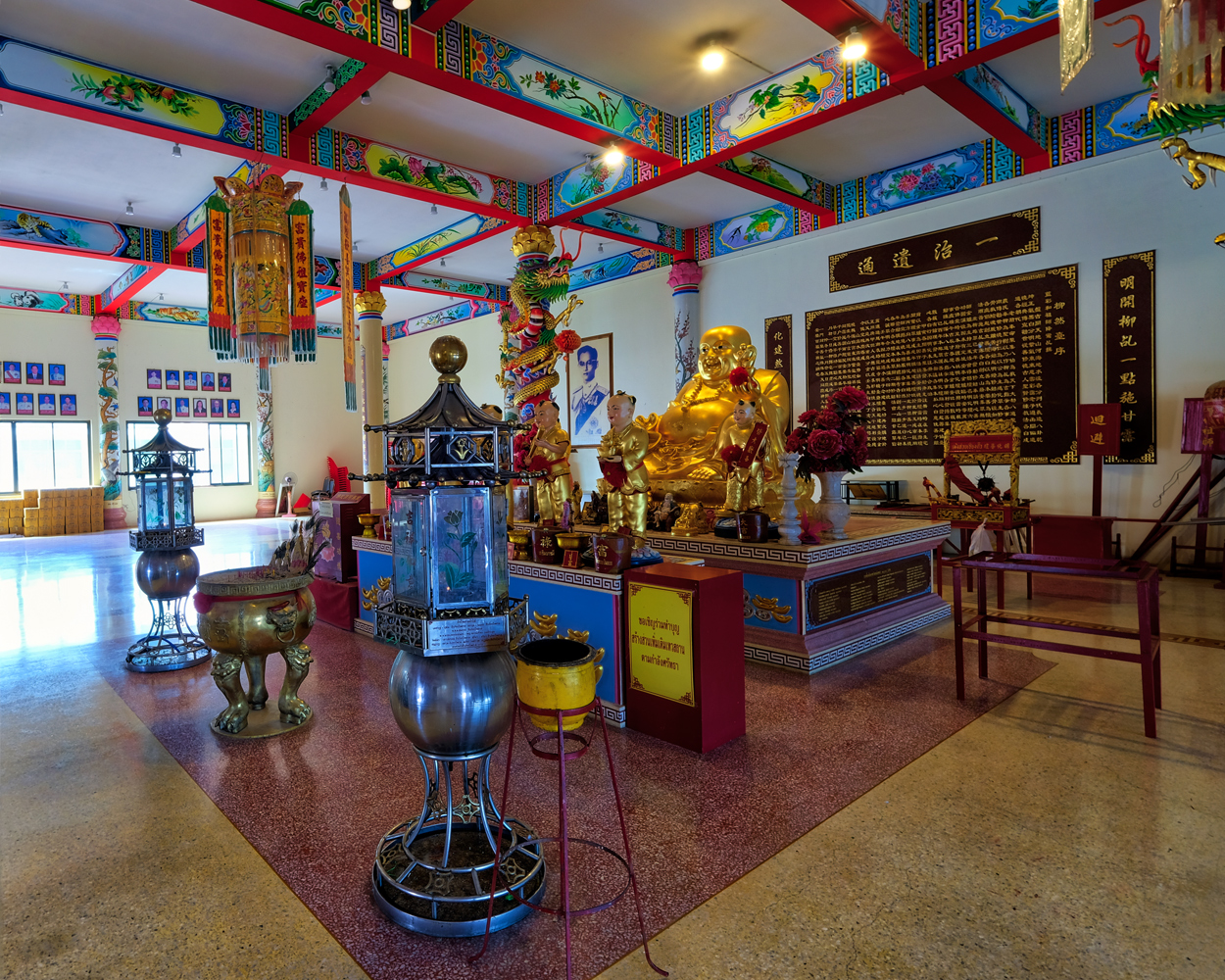
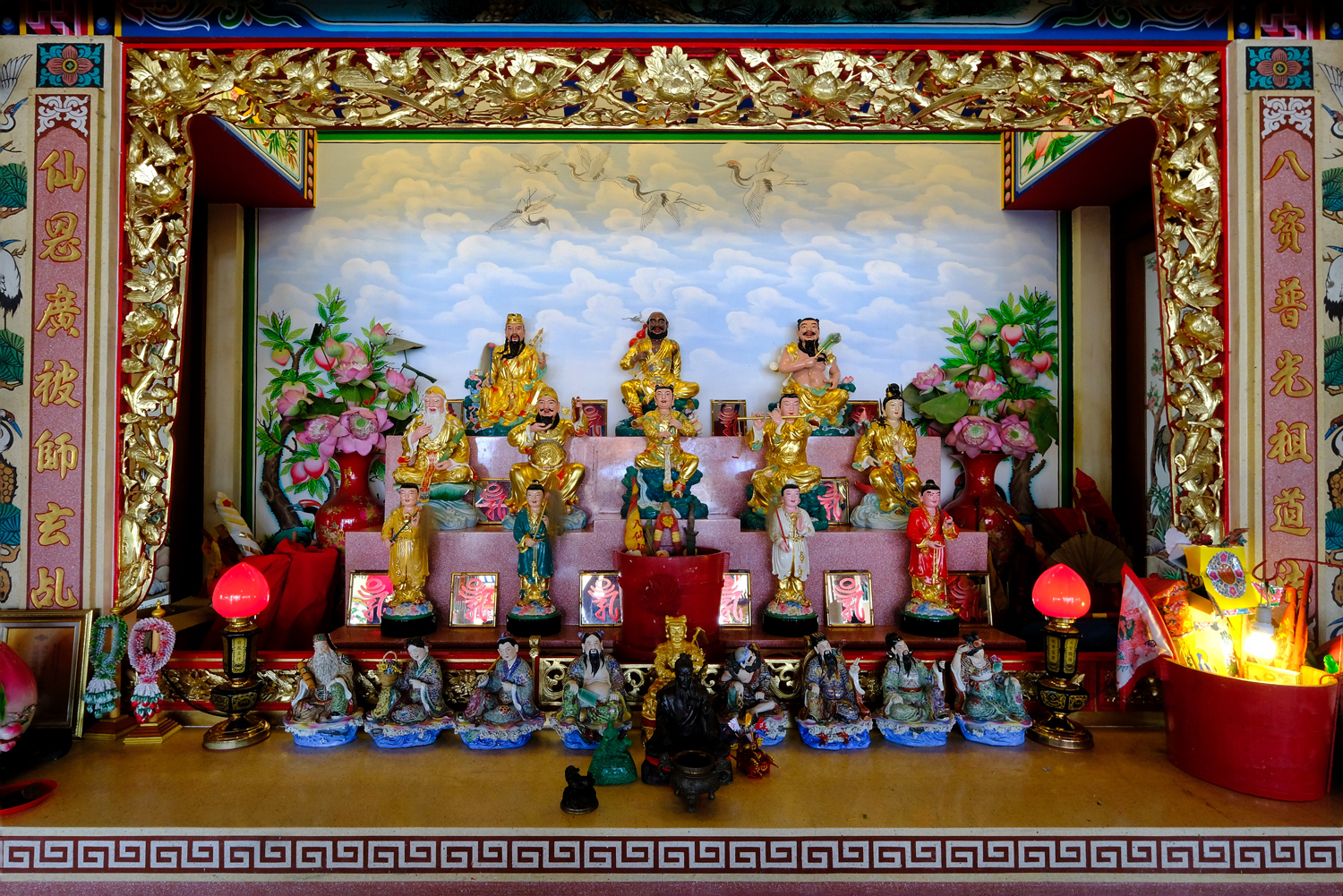
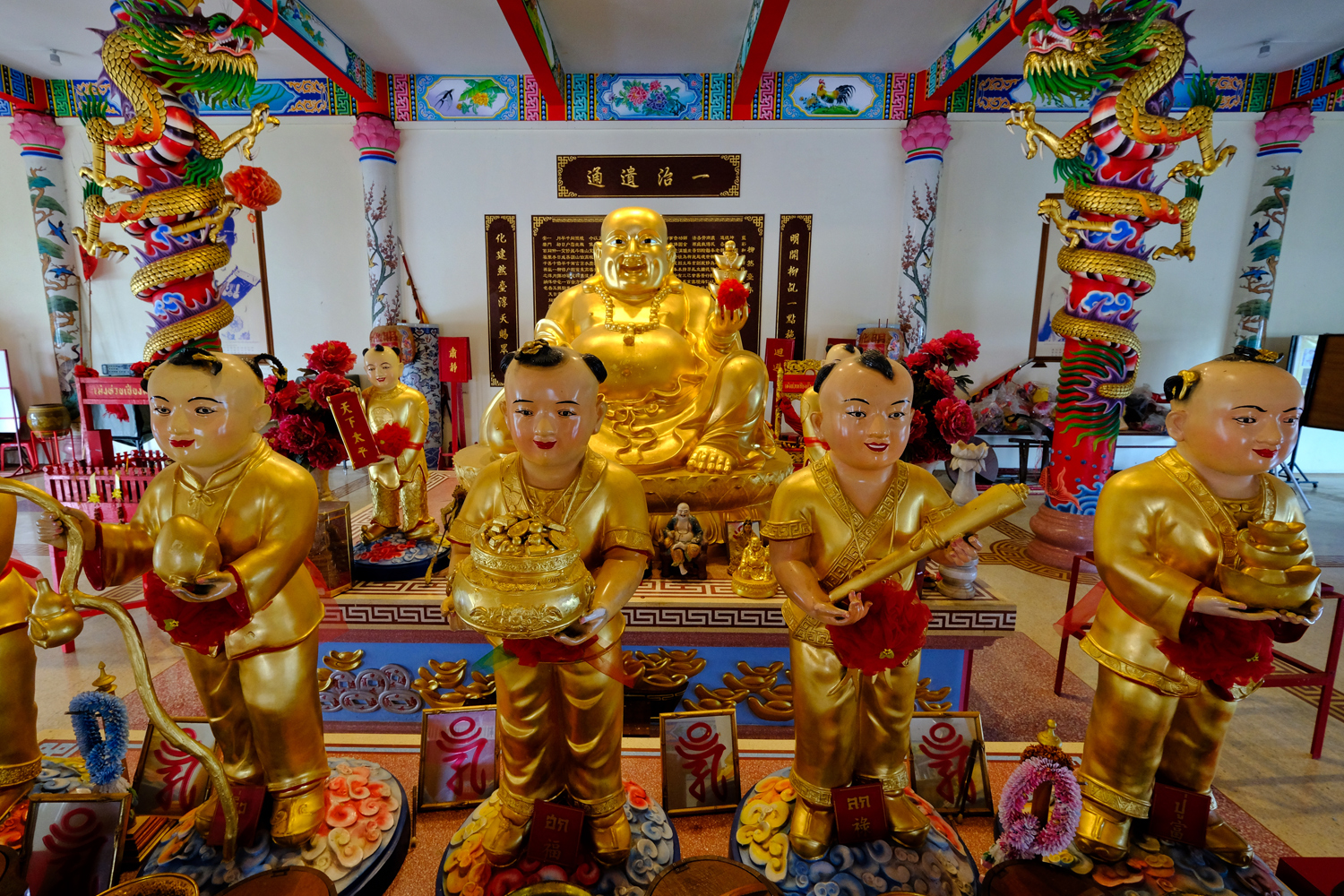
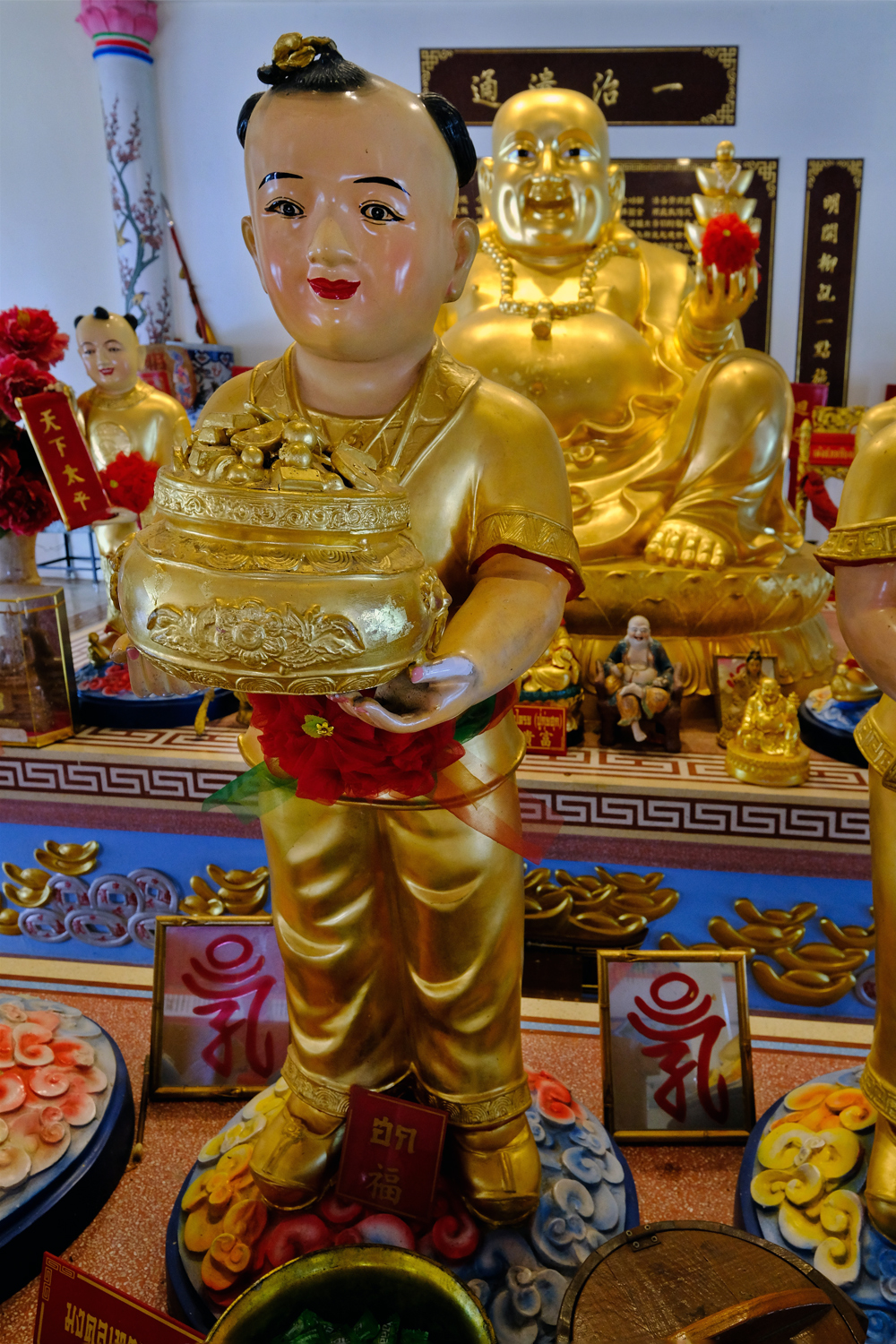
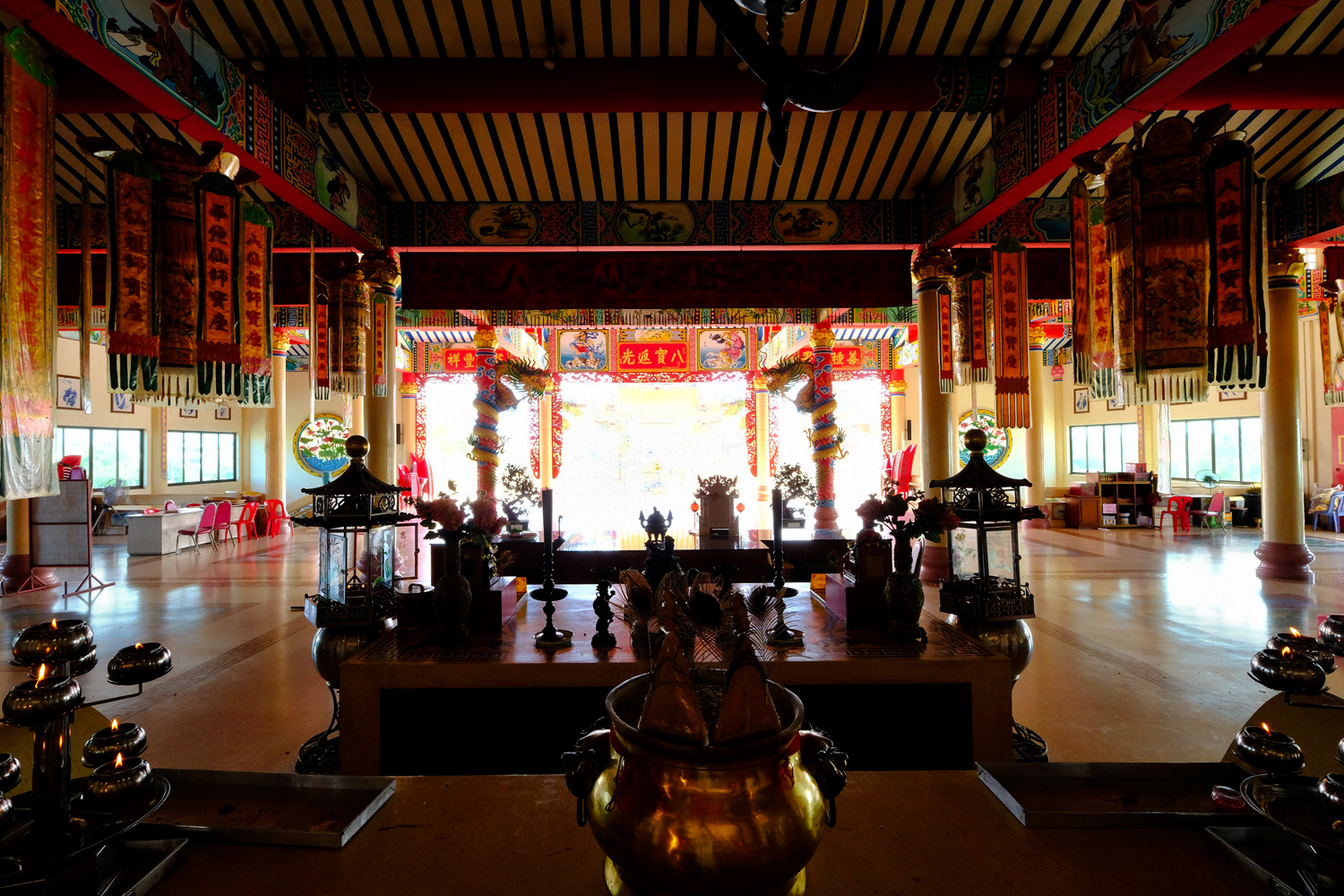 After wandering around for some time in these fantastic temple interiors we both realized we were hungry and decided to head into the old Chinese quarter of Chachoengsao along the river.
After wandering around for some time in these fantastic temple interiors we both realized we were hungry and decided to head into the old Chinese quarter of Chachoengsao along the river.
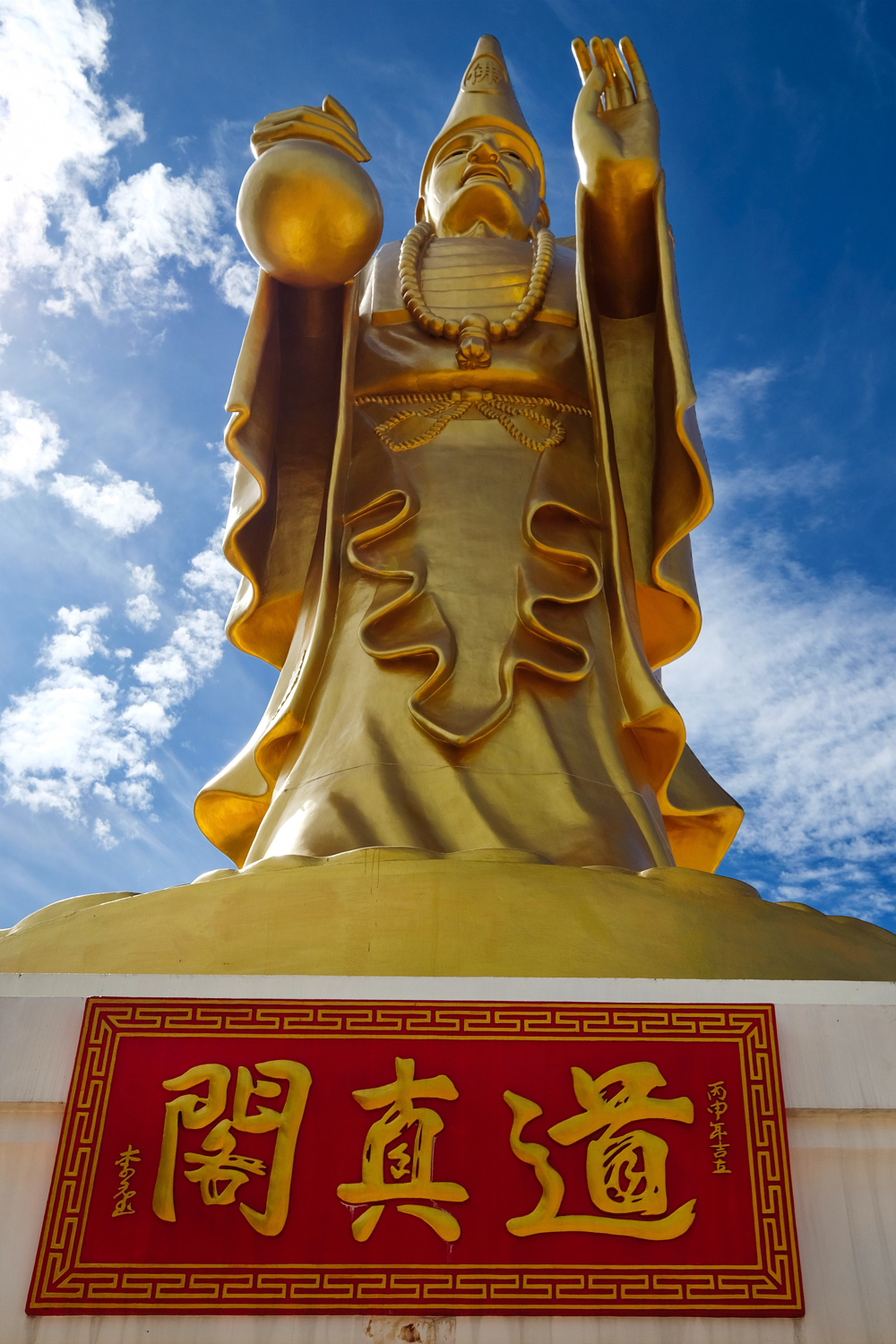 I paid my last respects to my old buddy Ji Gong and we were on our way again.
I paid my last respects to my old buddy Ji Gong and we were on our way again.
PART FIVE: THE OLD CHINESE QUARTER OF CHACHOENGSAO
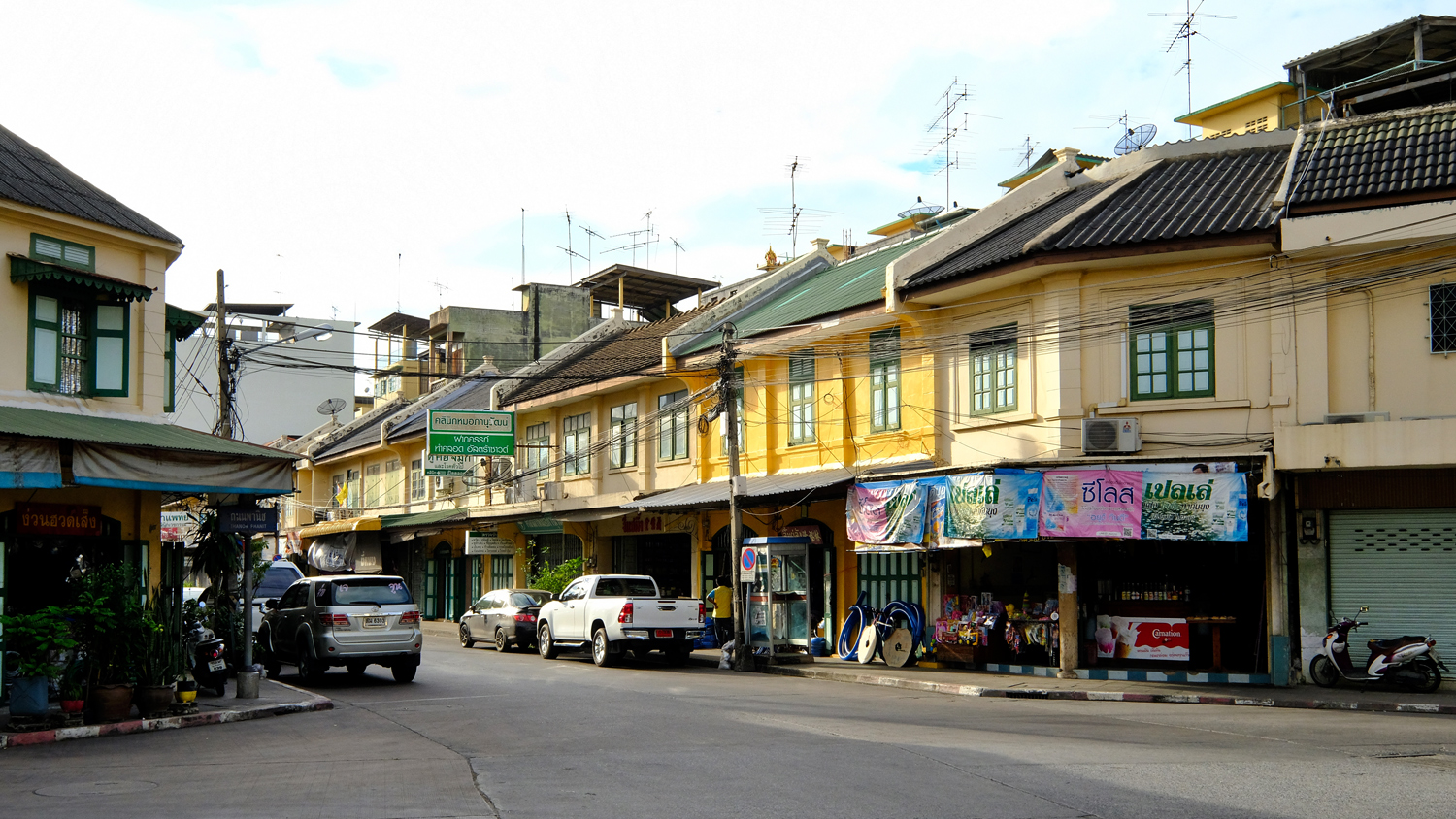 We drove into the old Chinese quarter and looked for a place to park. The architecture reminds me a lot of Penang, Malaysia.
We drove into the old Chinese quarter and looked for a place to park. The architecture reminds me a lot of Penang, Malaysia.
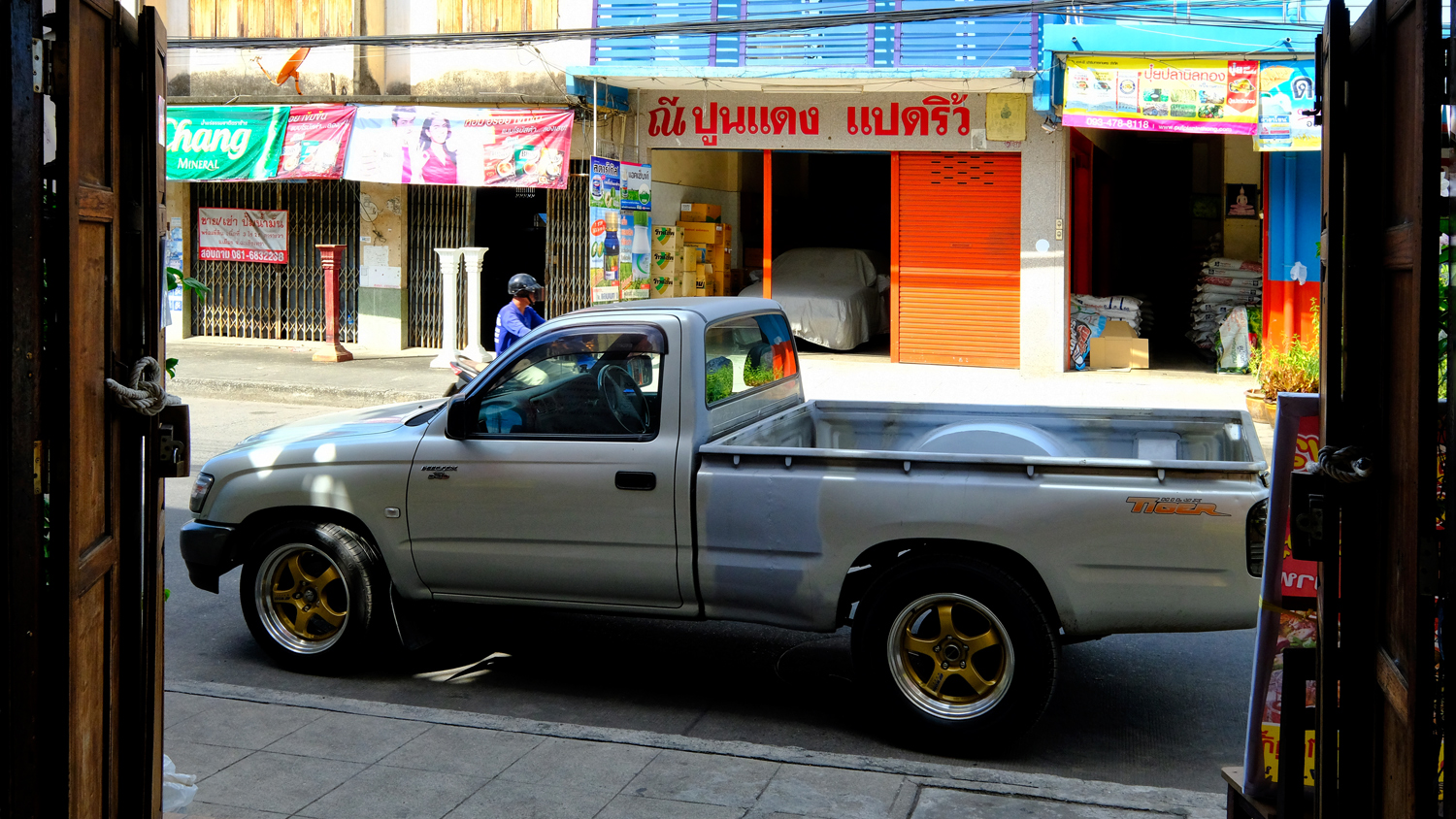 My current old school 'muscle car' project in mid-modification (V8, shortened, narrowed chassis, tubbed, big-braked, and custom-painted) on the streets of Chachoengsao.
My current old school 'muscle car' project in mid-modification (V8, shortened, narrowed chassis, tubbed, big-braked, and custom-painted) on the streets of Chachoengsao.
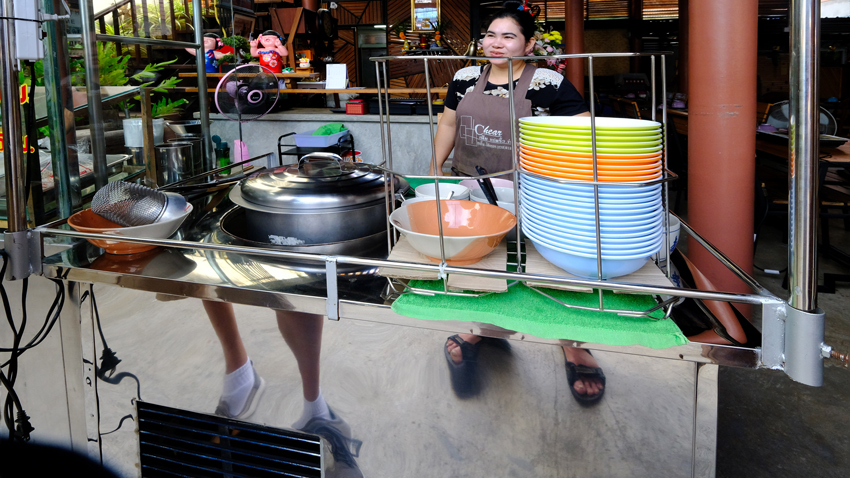 We found a nice noodle shop for our first course . . . .
We found a nice noodle shop for our first course . . . .
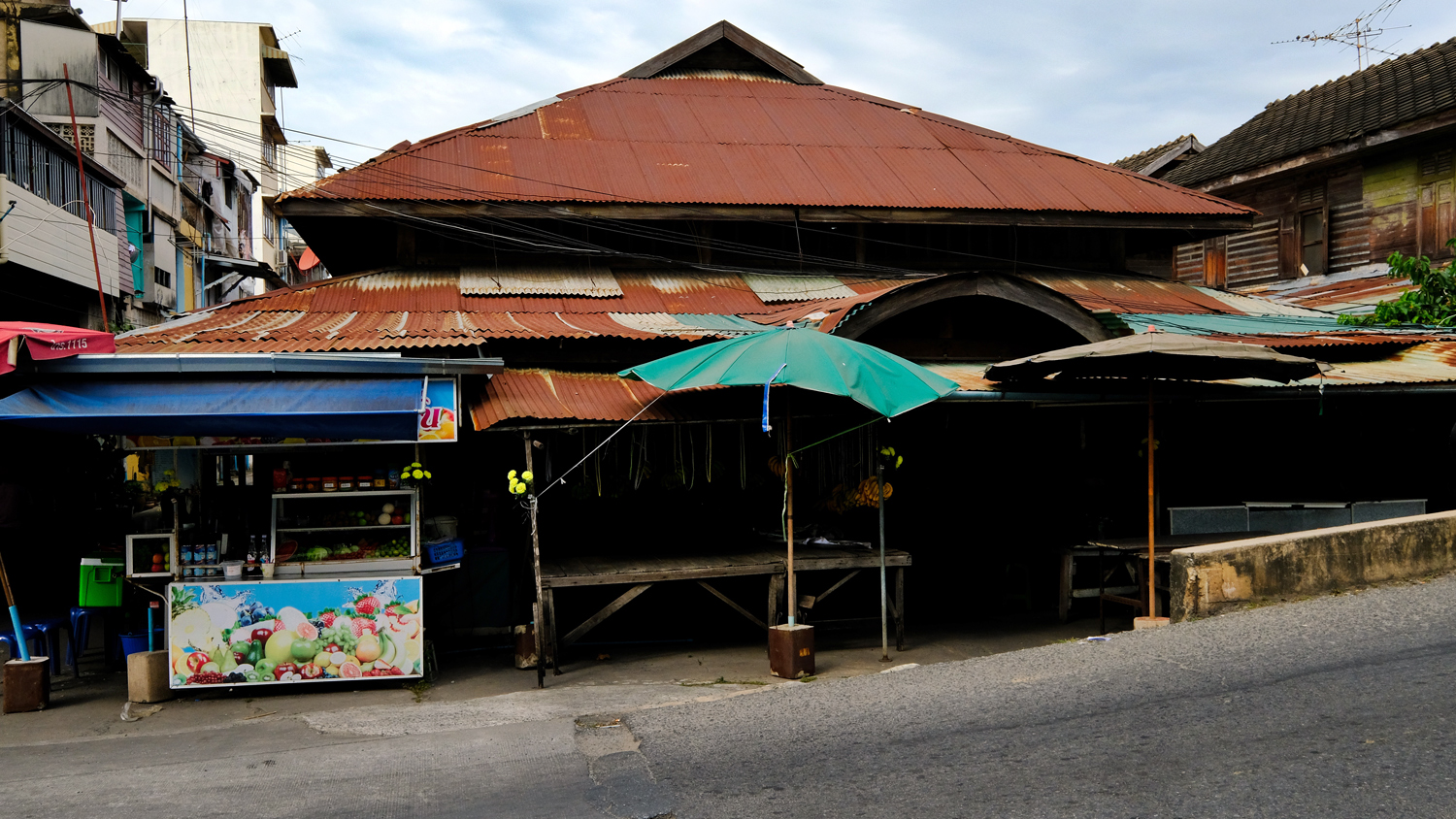 After a quick snack, we headed out on a walk around this fascinating old town. Here, the 100+ year old town market.
After a quick snack, we headed out on a walk around this fascinating old town. Here, the 100+ year old town market.
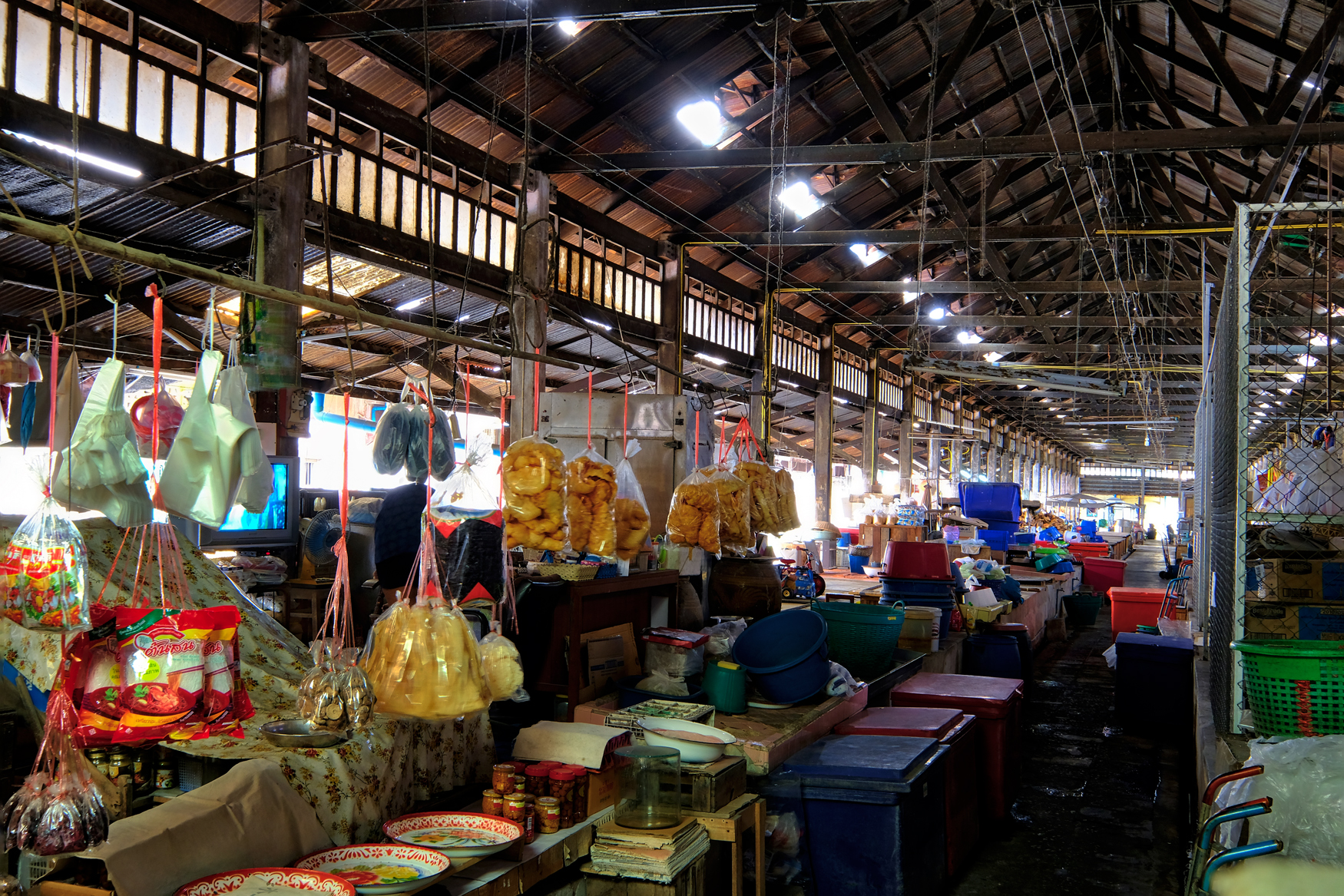 The old city market interior . . . still in use.
The old city market interior . . . still in use.
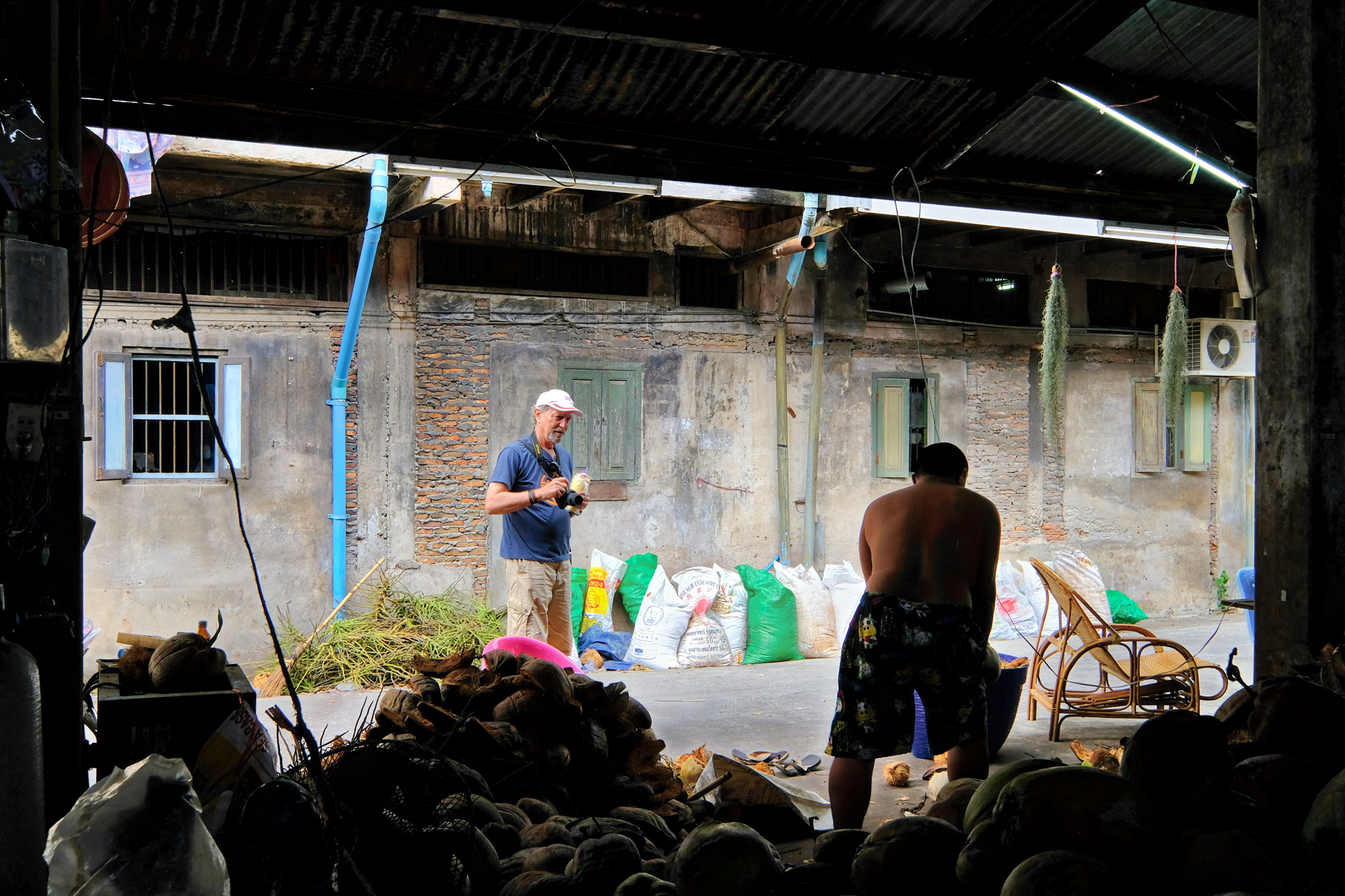 There were just too may photographic subjects to cover . . we were just a couple street shooters snapping on the run.
There were just too may photographic subjects to cover . . we were just a couple street shooters snapping on the run.
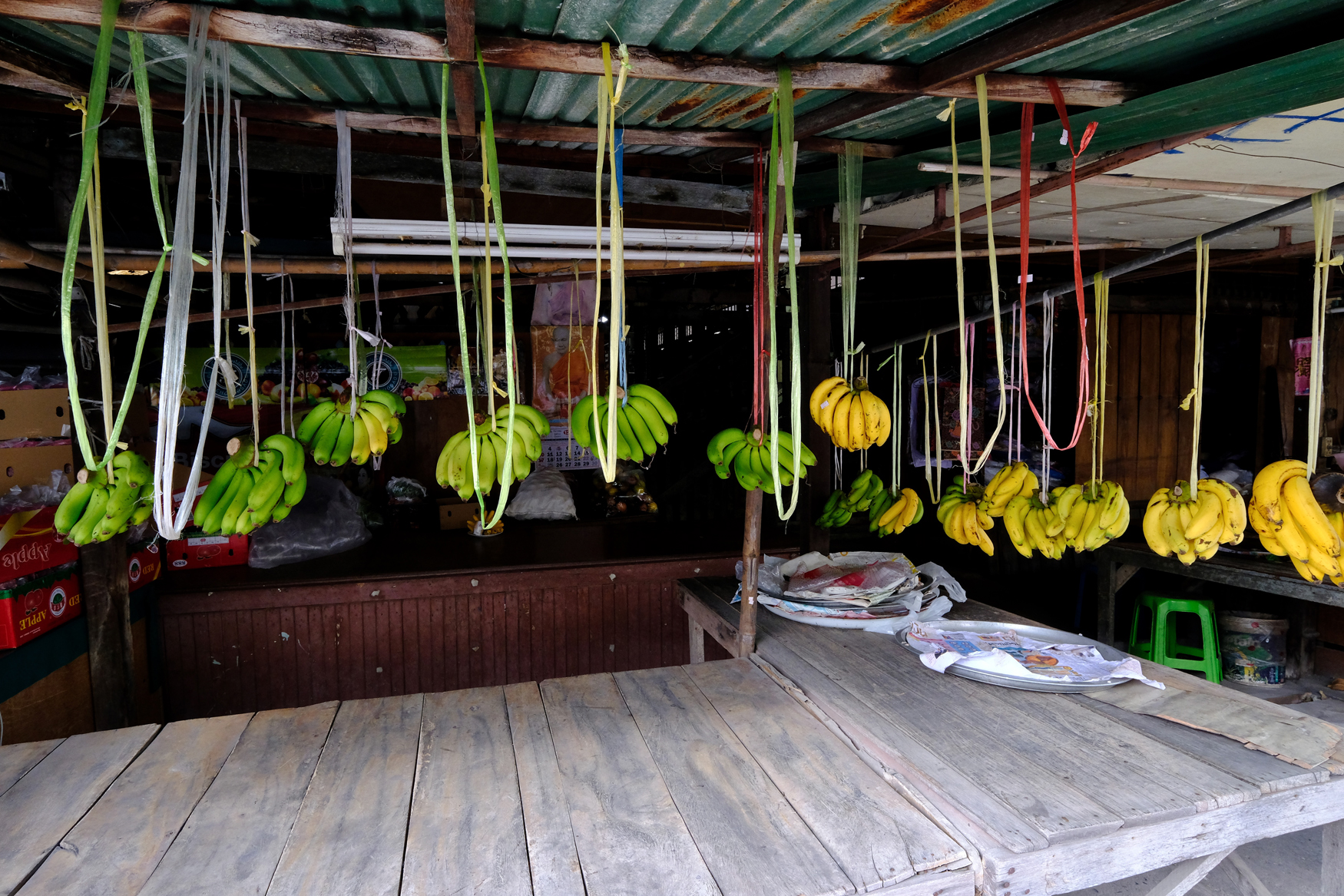 The light in the old market spaces was marvelous.
The light in the old market spaces was marvelous.
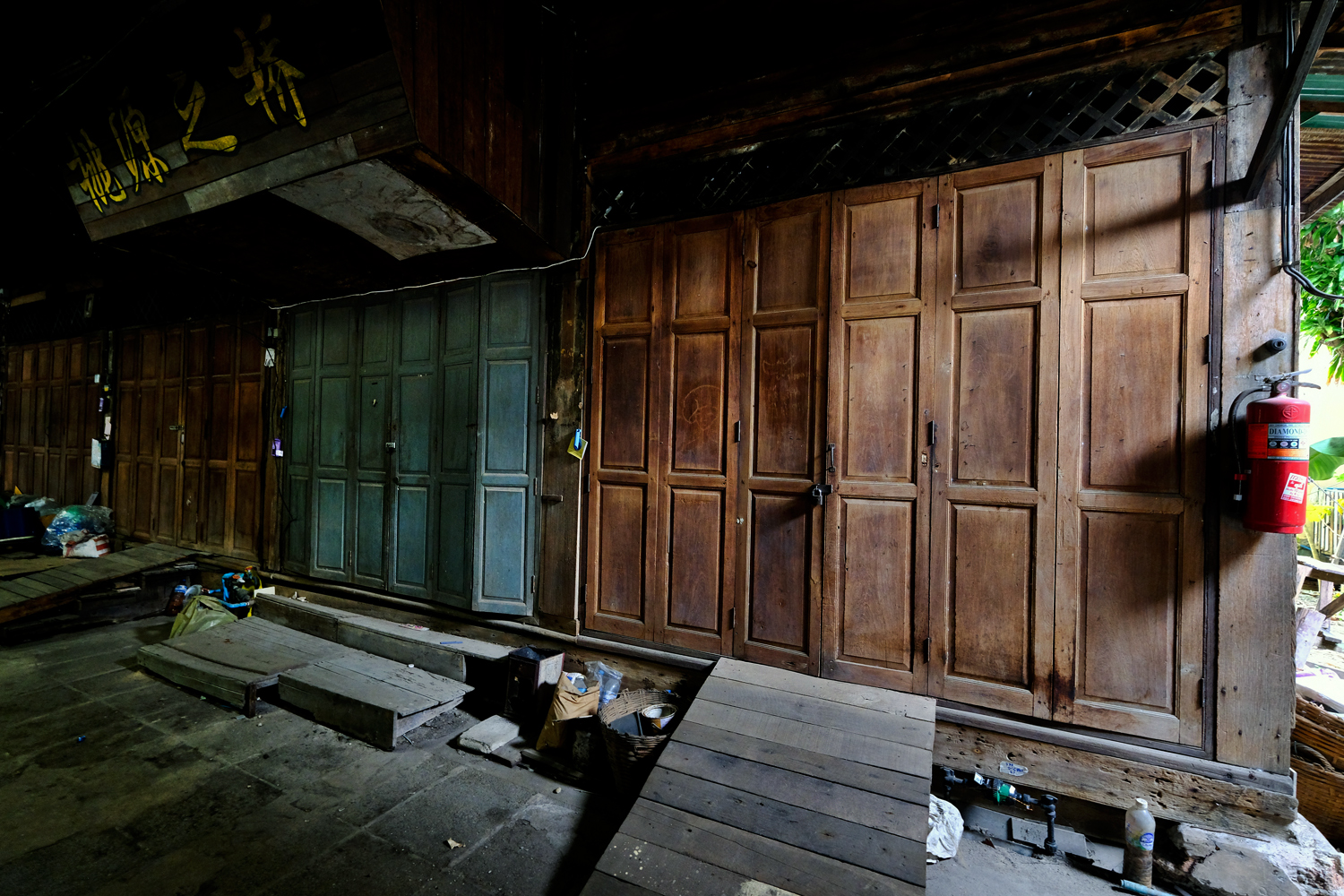 At some point in the past these old shops must have been very successful, being located next to the town market.
At some point in the past these old shops must have been very successful, being located next to the town market.
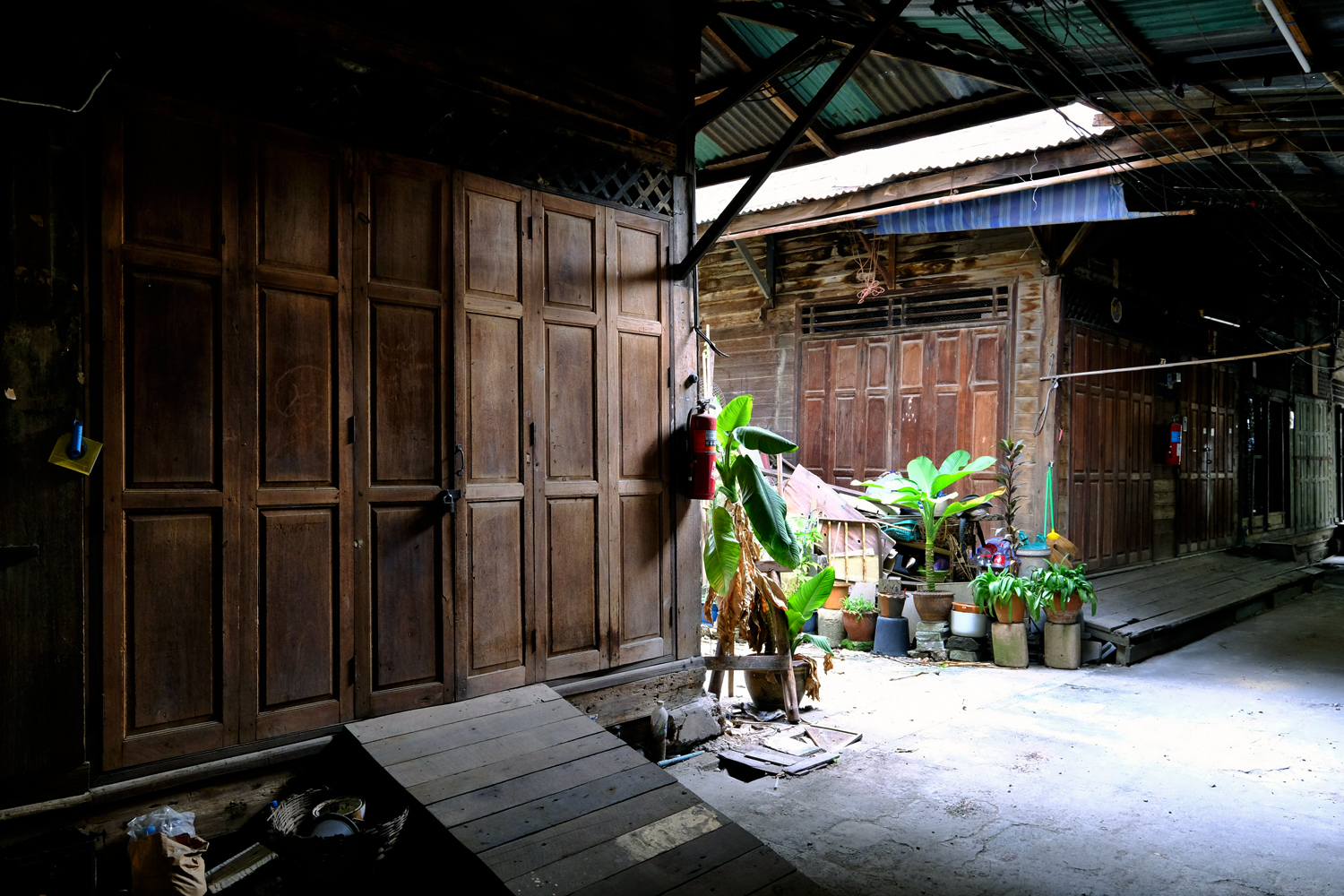 The oldest shops in the city.
The oldest shops in the city.
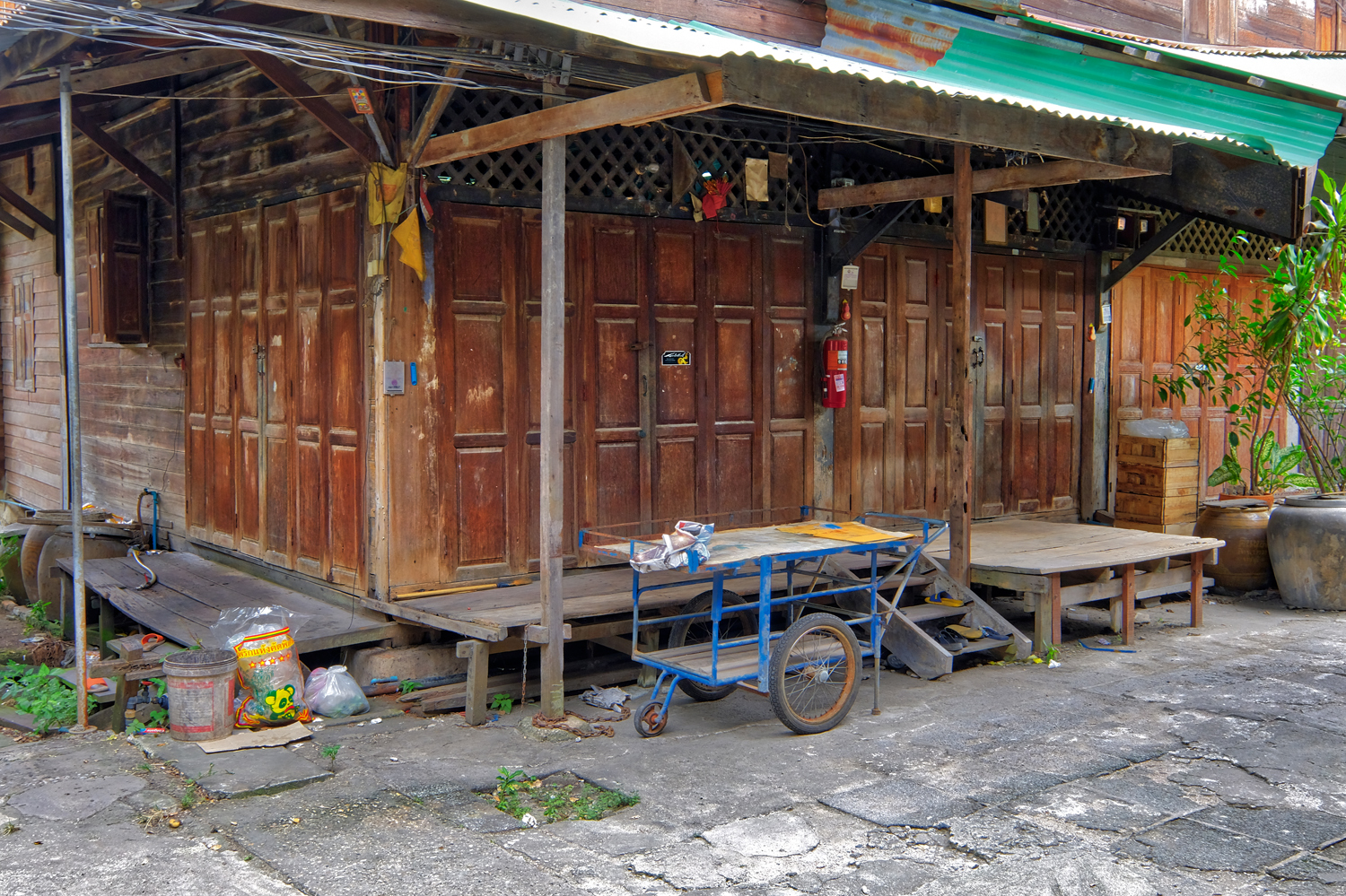 Some of these old shops are still in use by traders.
Some of these old shops are still in use by traders.
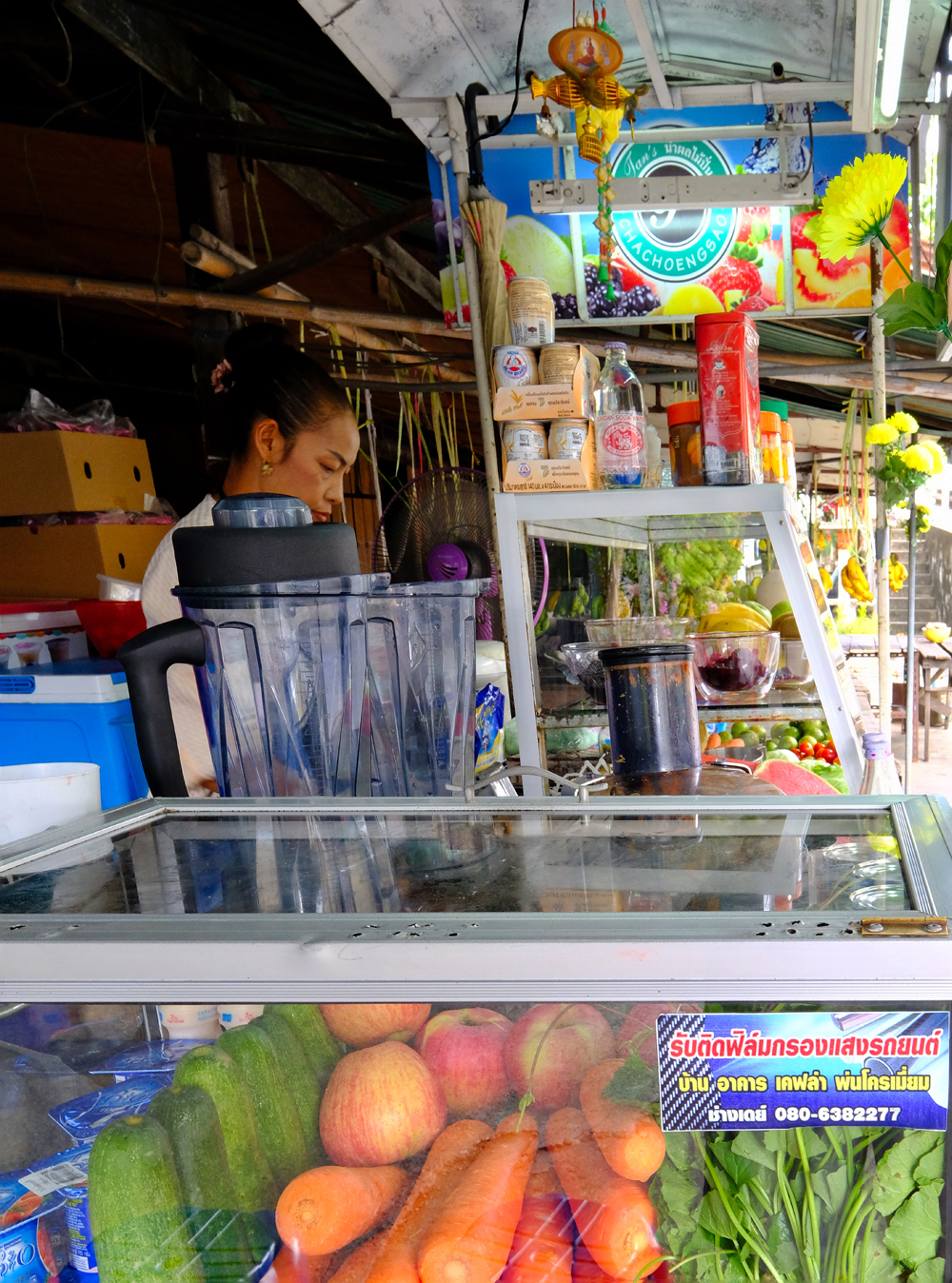 We stopped for fresh fruit juice smoothies. I had a carrot and apple one.
We stopped for fresh fruit juice smoothies. I had a carrot and apple one.
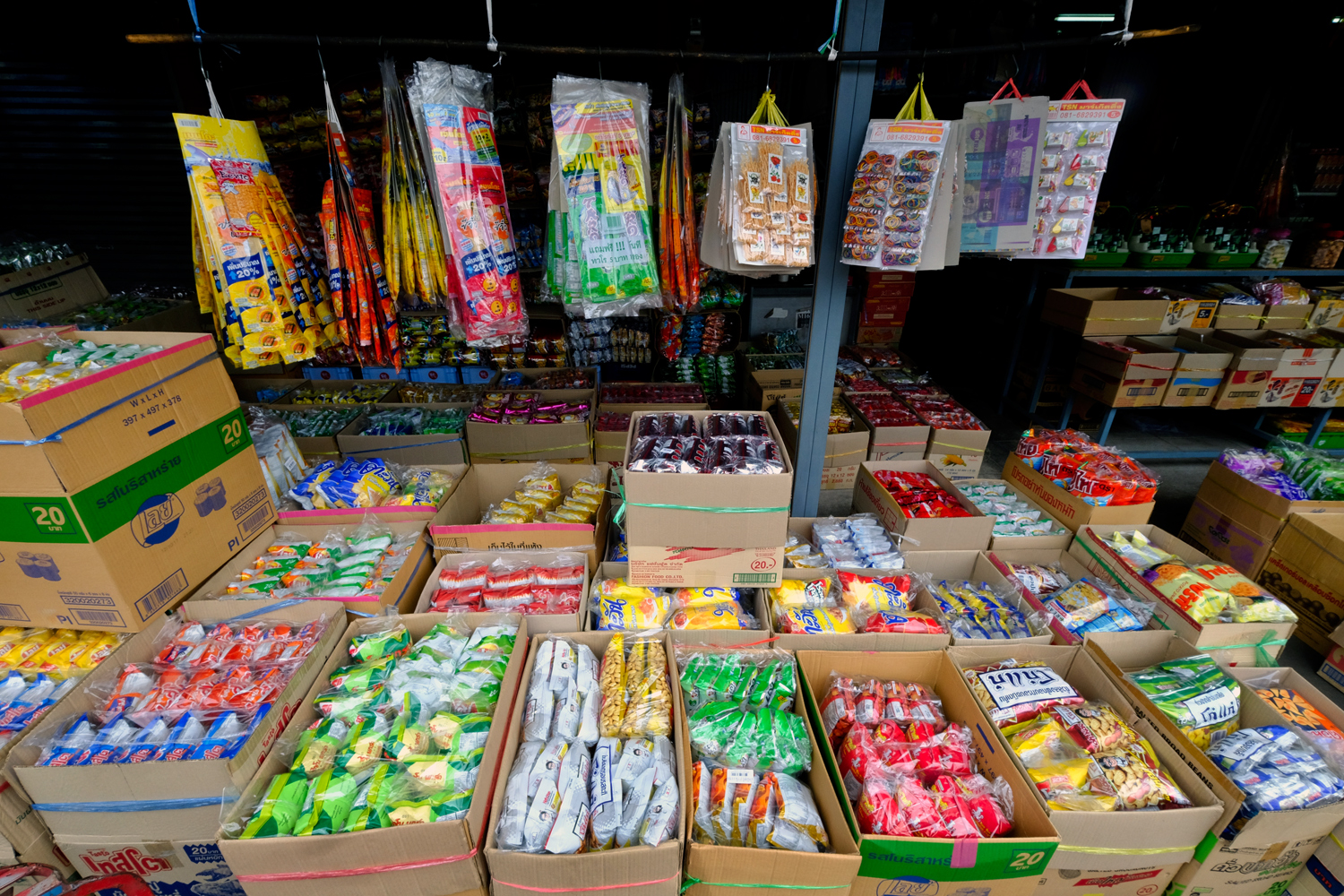 There is a growing obesity problem in Thailand (pun intended). It's no wonder . . . look at the chip and snack wholesaler's shop.
There is a growing obesity problem in Thailand (pun intended). It's no wonder . . . look at the chip and snack wholesaler's shop.
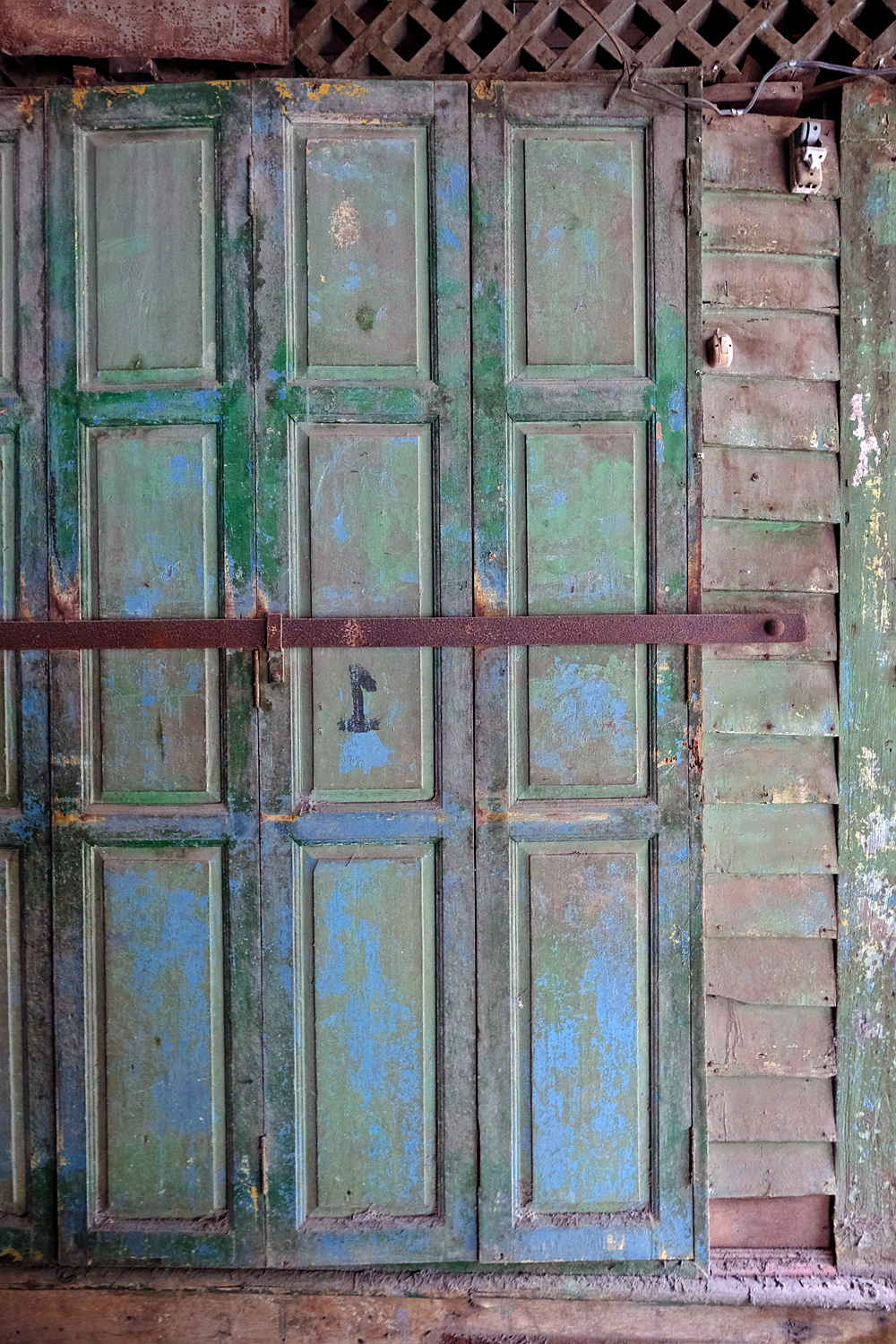 These well-worn shop doors were things of beauty.
These well-worn shop doors were things of beauty.
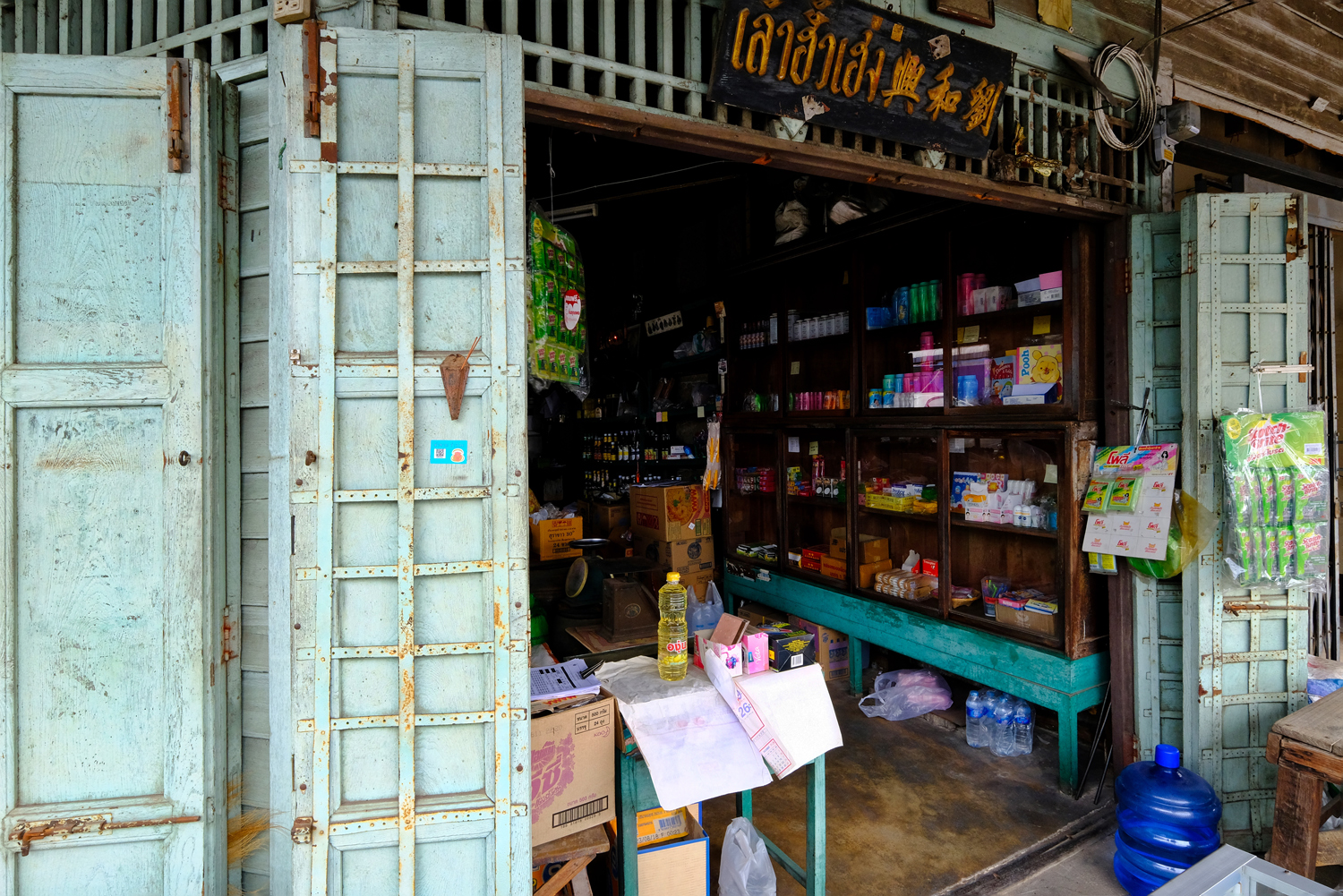 The shopkeepers here told us that this shop had been operated by their family for over 100 years.
The shopkeepers here told us that this shop had been operated by their family for over 100 years.
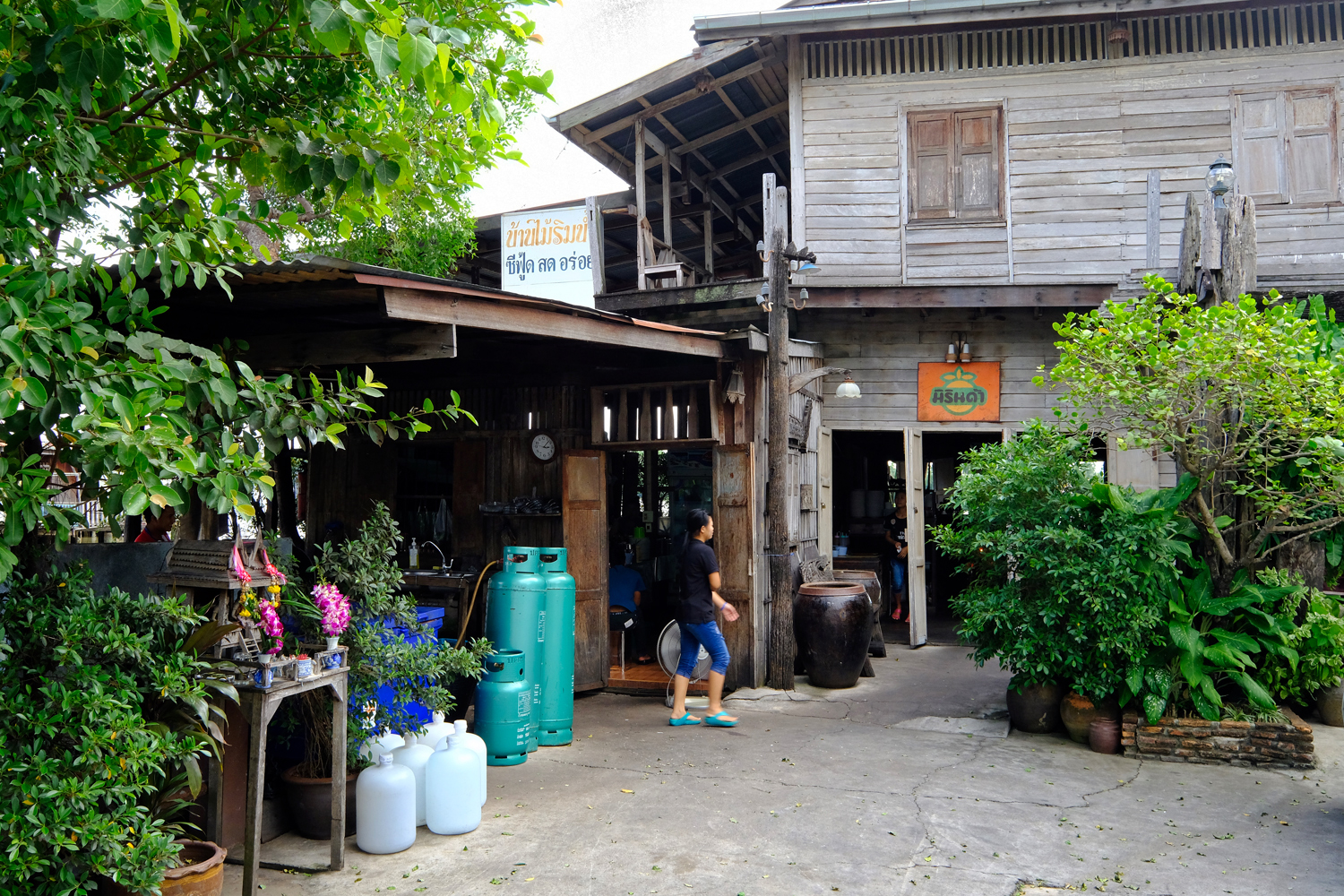 We stopped in at this riverfront restaurant for a full Thai meal that couldn't be beat. Ate way too much, but was happy.
We stopped in at this riverfront restaurant for a full Thai meal that couldn't be beat. Ate way too much, but was happy.
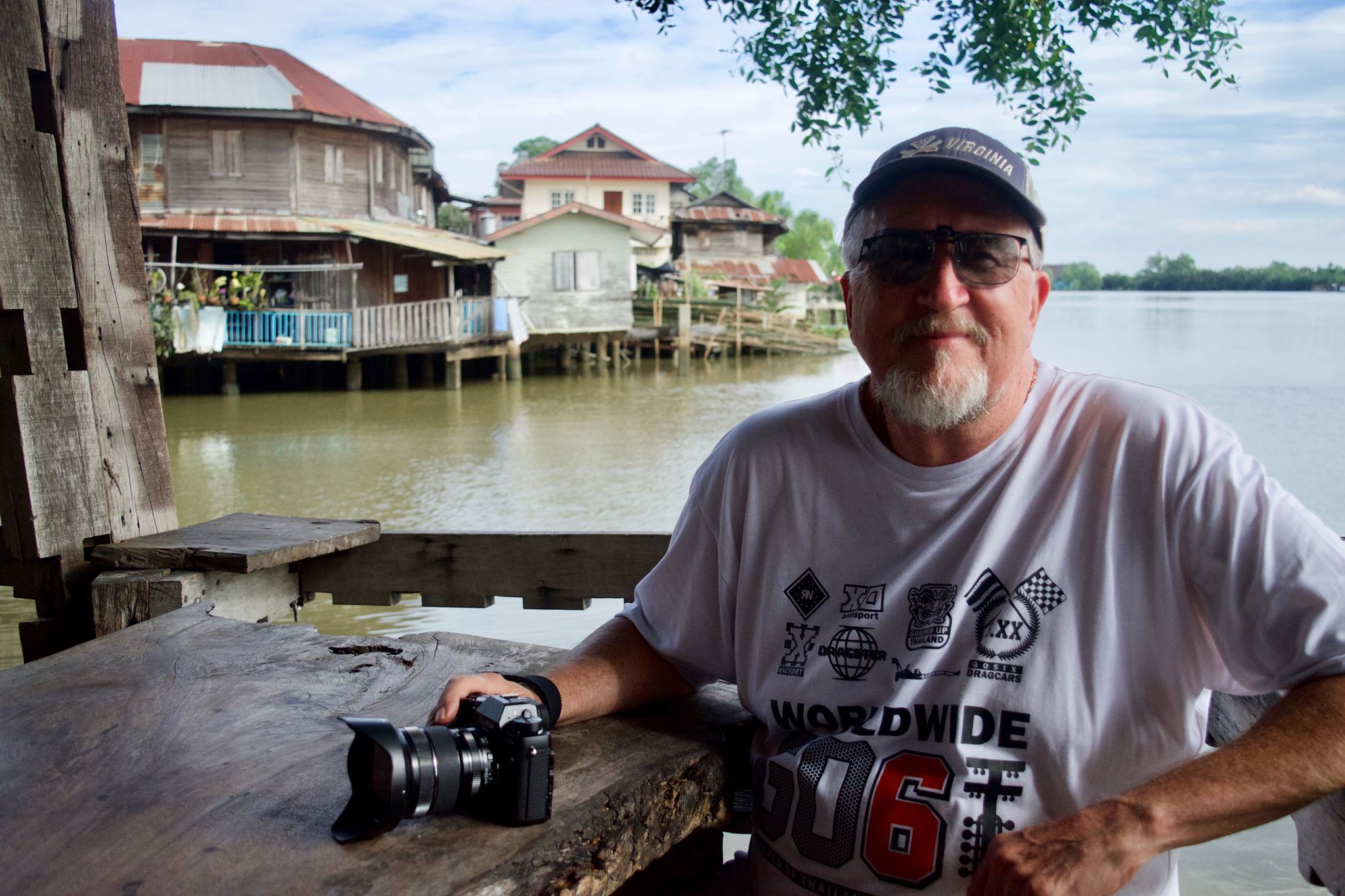 Your intrepid photographer out and about . . . and getting ready to have a wonderful meal.
Your intrepid photographer out and about . . . and getting ready to have a wonderful meal.
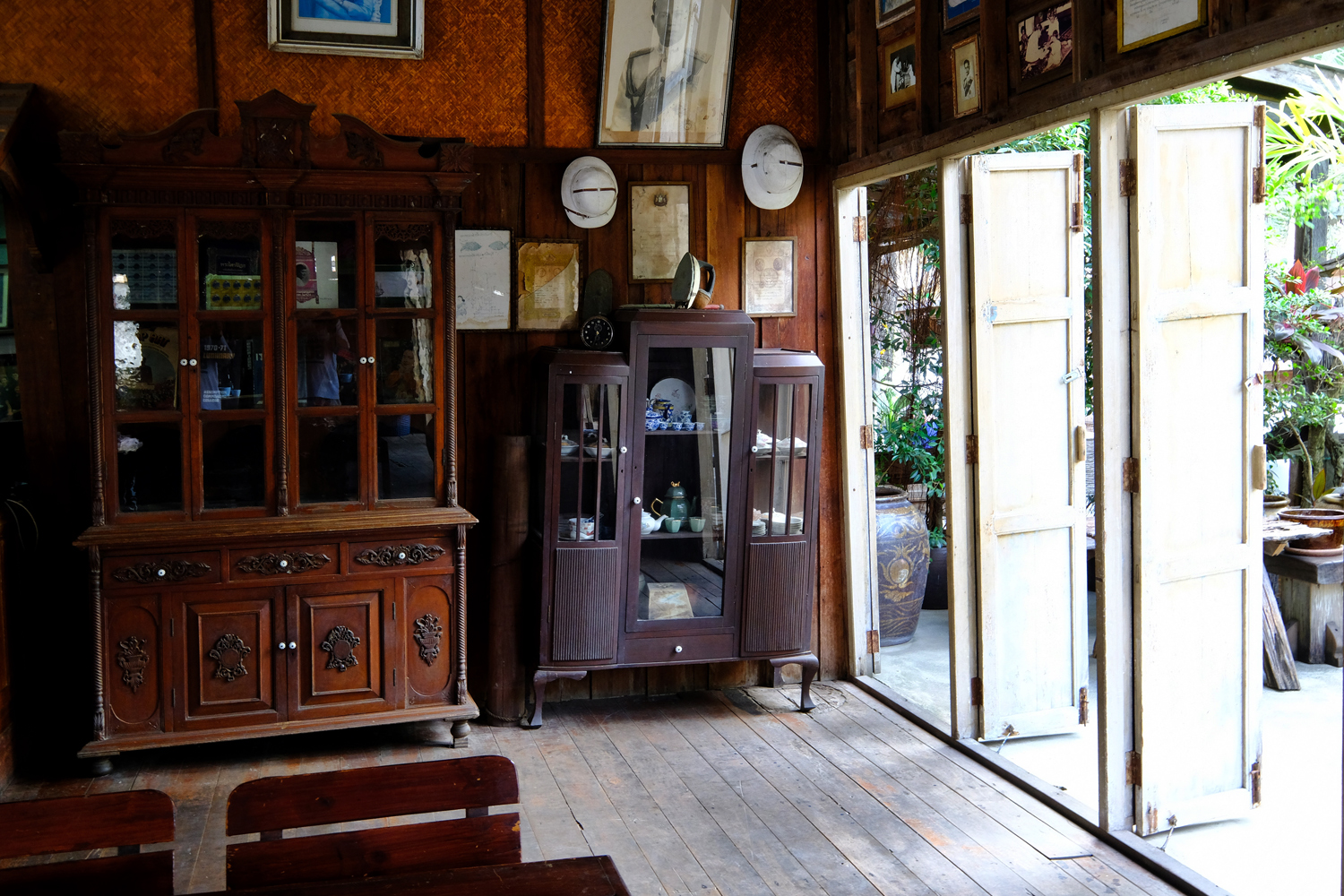 Before our meal arrived, I took the liberty to look around the old atmospheric wooden building.
Before our meal arrived, I took the liberty to look around the old atmospheric wooden building.
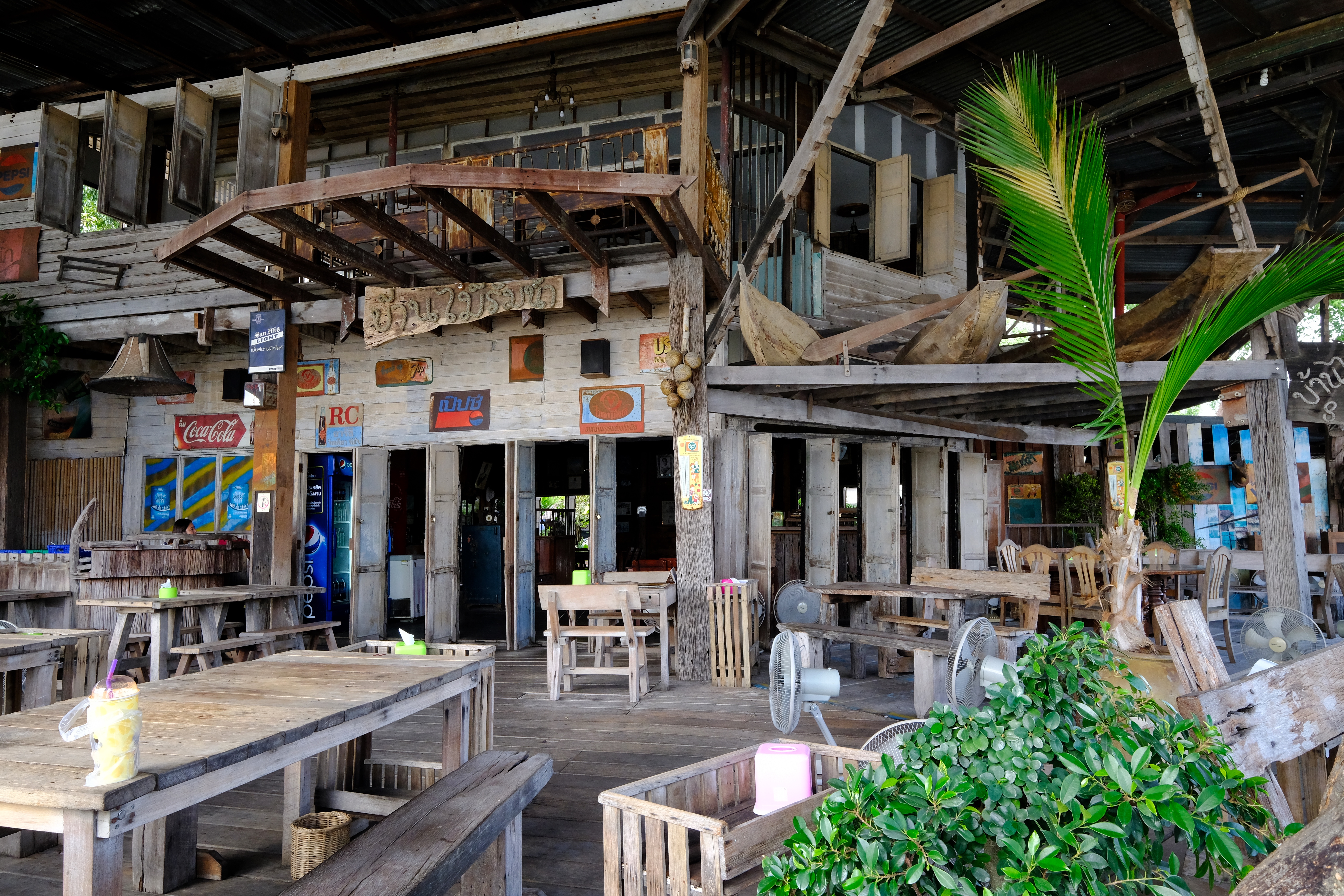 The restaurant interior was amazing . . . and very artfully done.
The restaurant interior was amazing . . . and very artfully done.
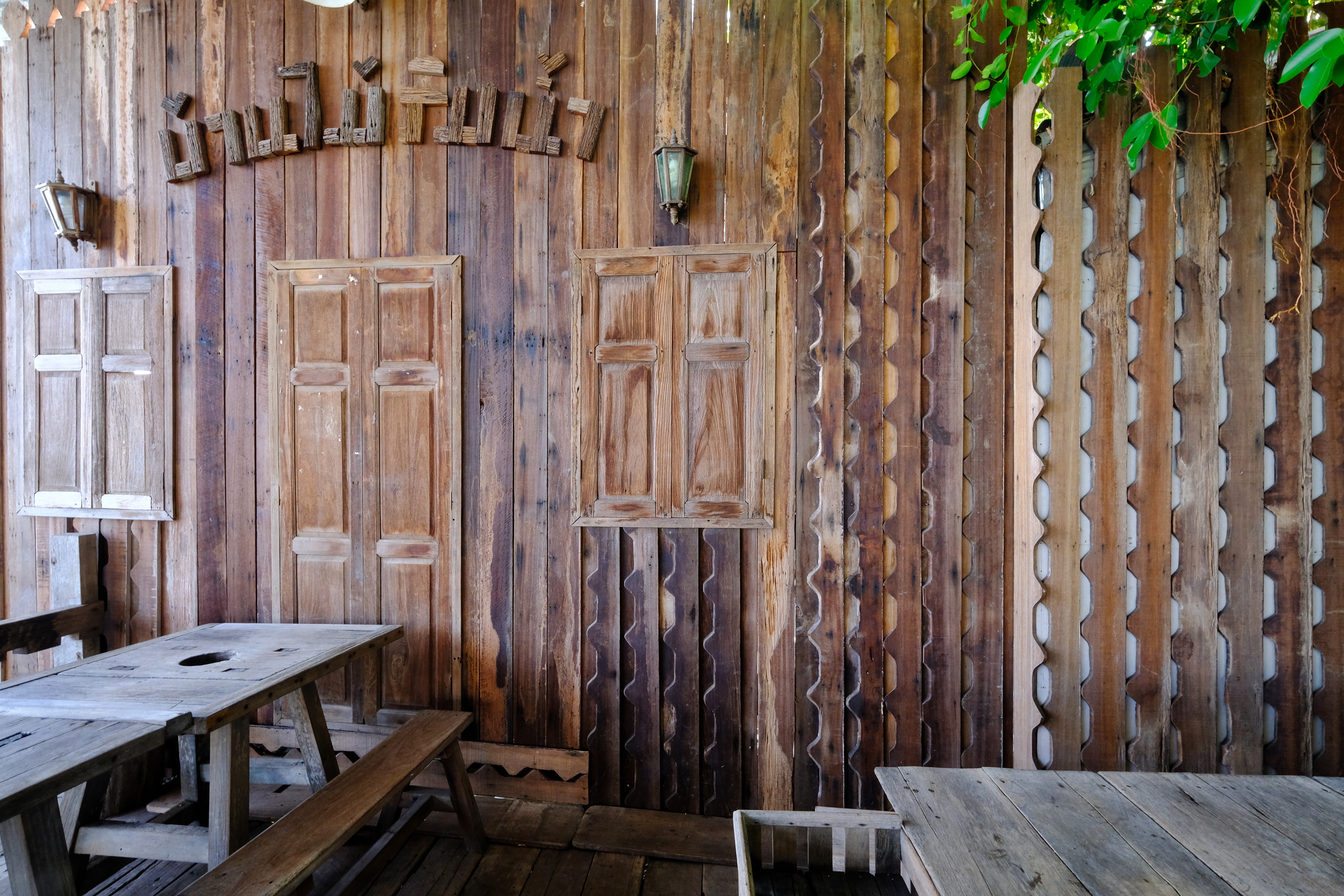 An interior wall at the restaurant.
An interior wall at the restaurant.
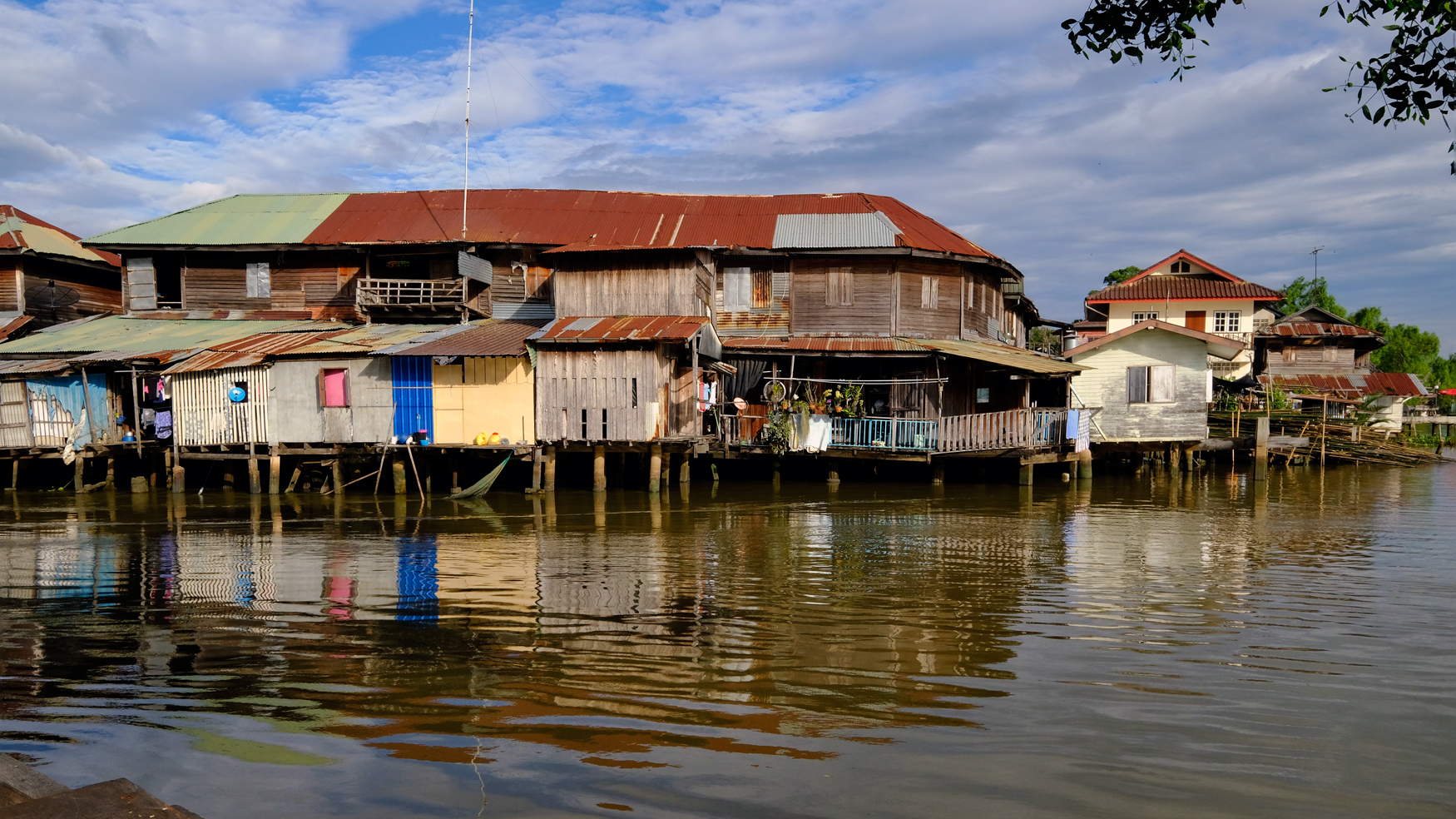 The view from our diner table!
The view from our diner table!
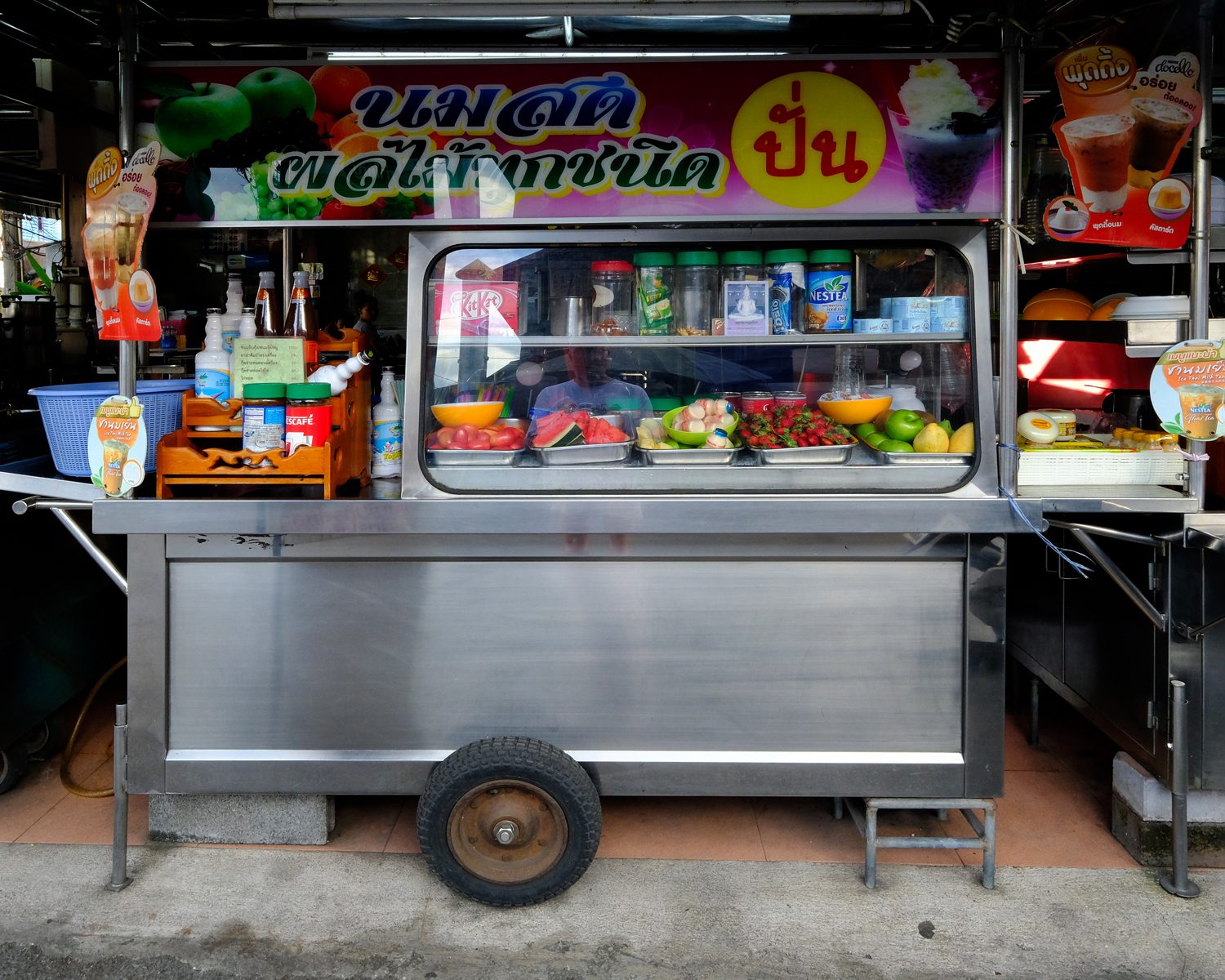 After our big late lunch we went out walking again . . . what did we see? More food!
After our big late lunch we went out walking again . . . what did we see? More food!
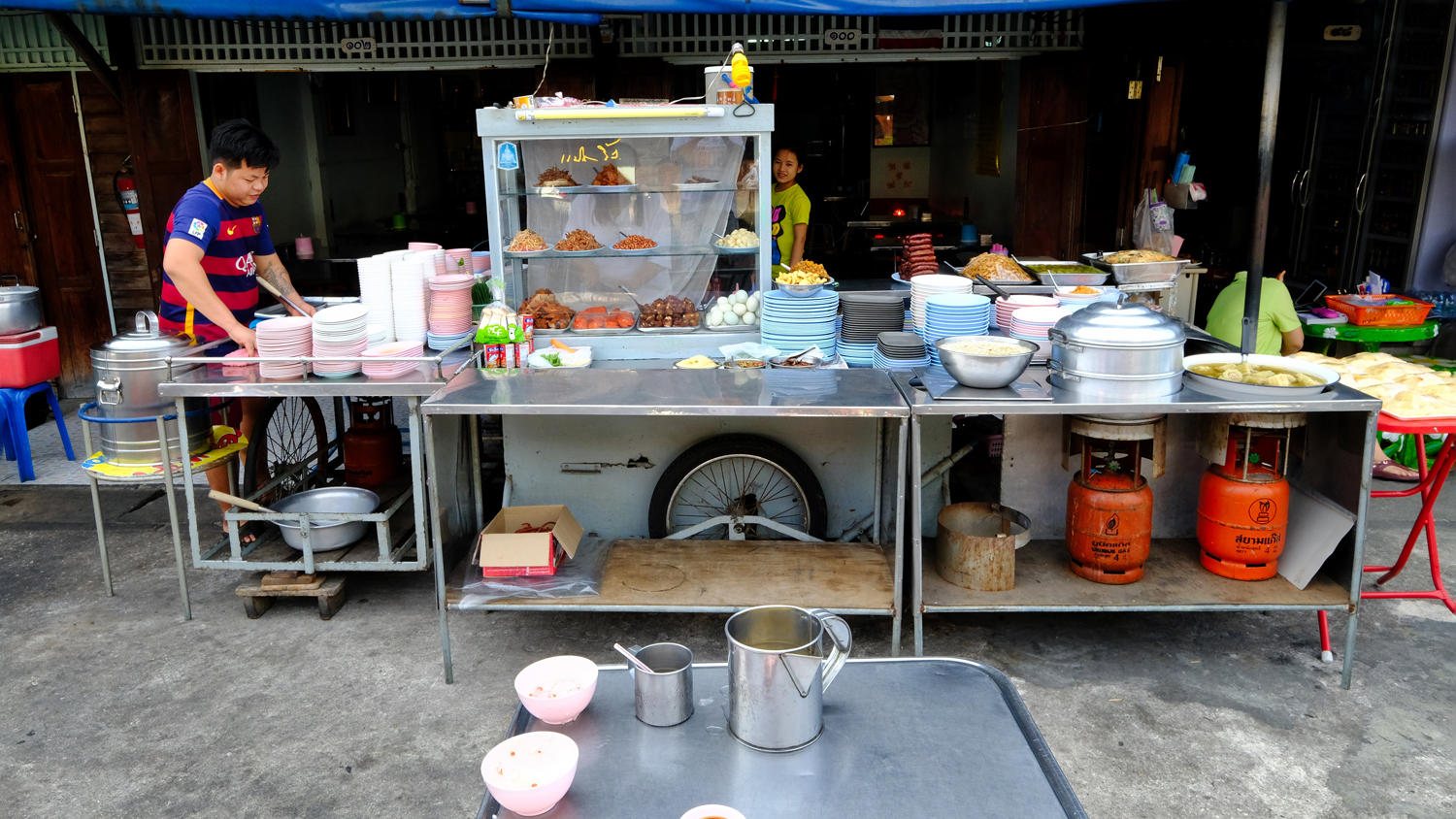 The vendors were all busy getting ready for the evening rush.
The vendors were all busy getting ready for the evening rush.
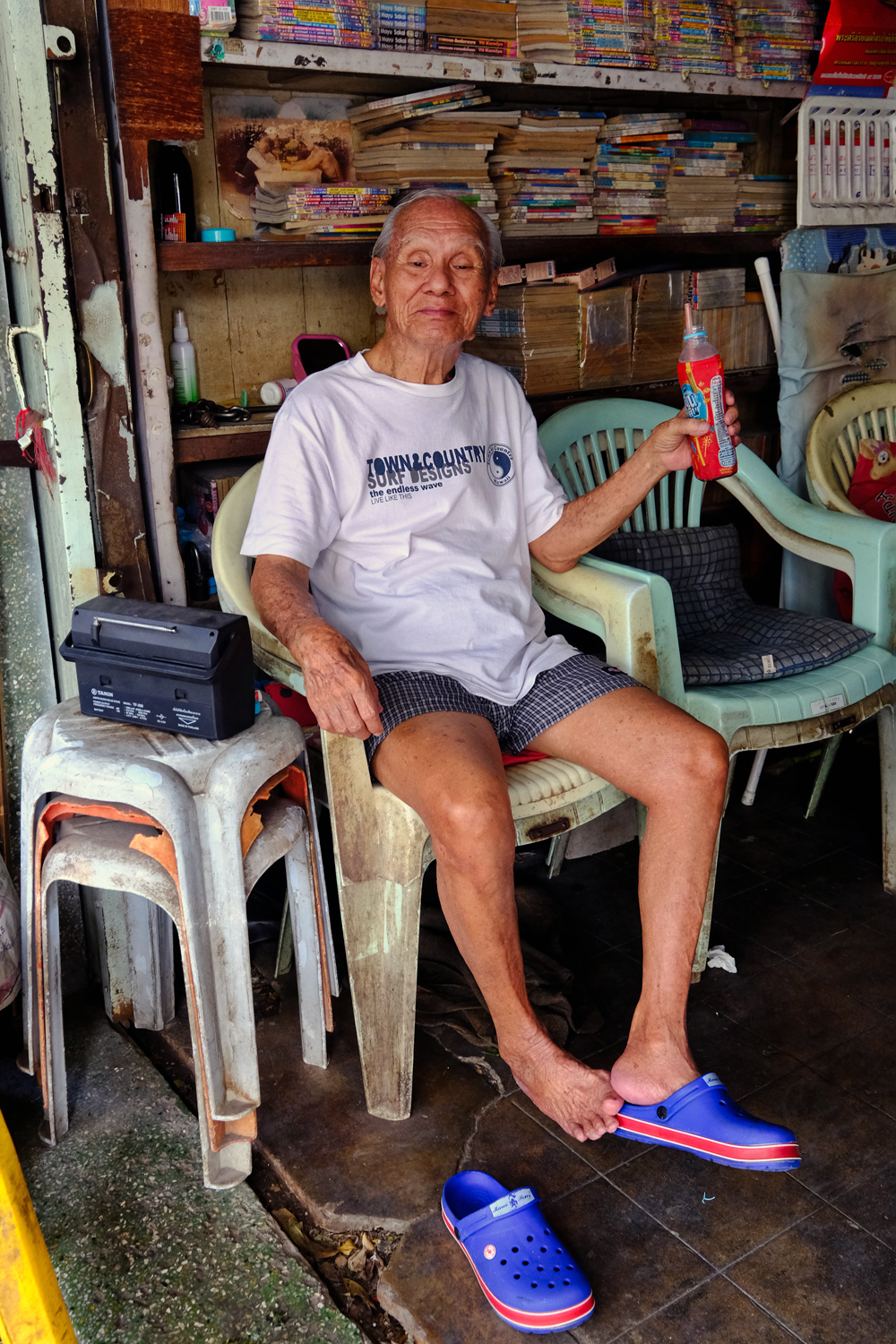 We asked this shopkeeper how long he had been sitting there . . . he said, "62 years."
We asked this shopkeeper how long he had been sitting there . . . he said, "62 years."
 Tai street food is delicious . . . but we were already too full.
Tai street food is delicious . . . but we were already too full.
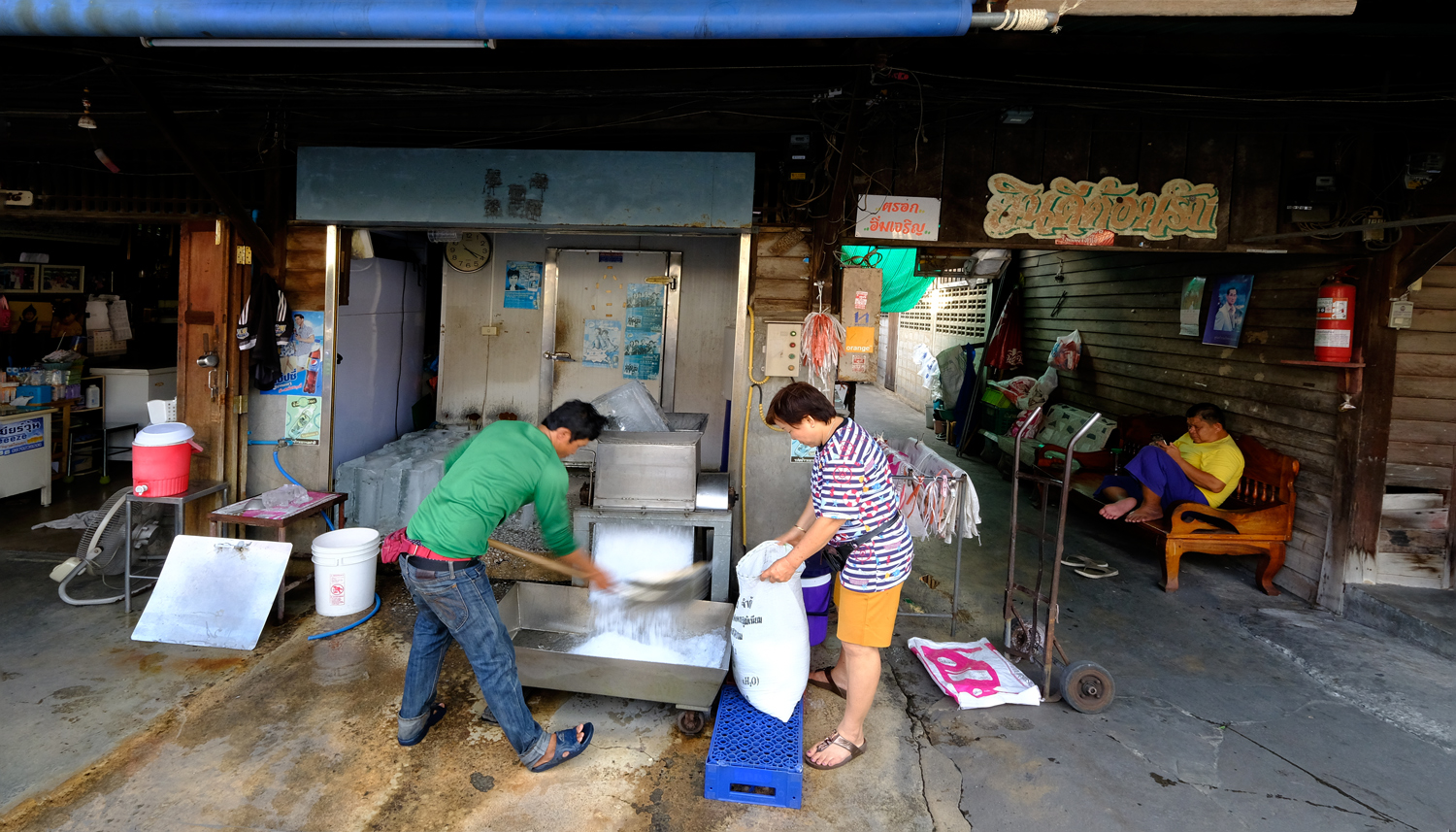 We walked around a working town . . . an iceman packing his product with help.
We walked around a working town . . . an iceman packing his product with help.
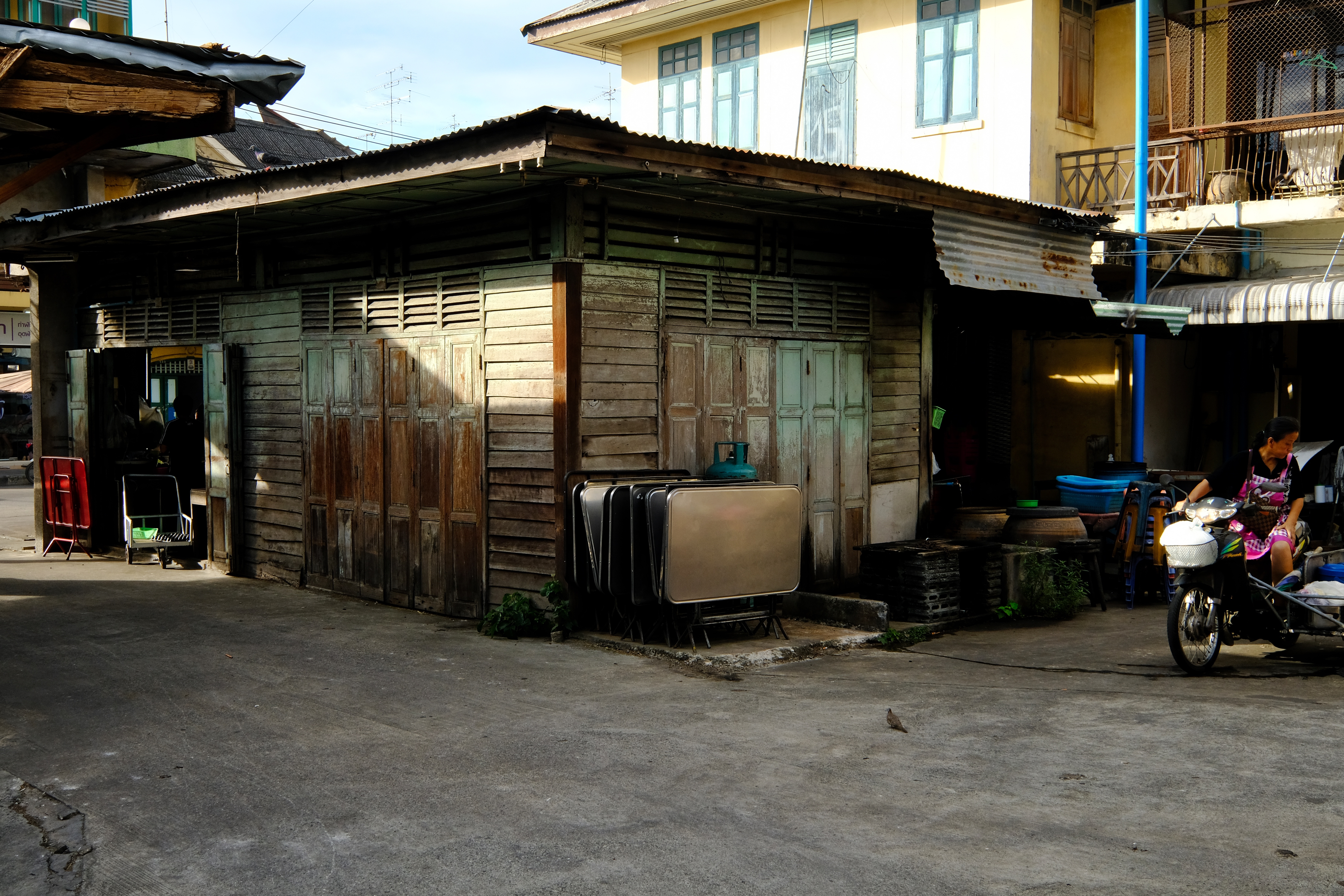 An old shop house in the city center of Chachoengsao, Thailand.
An old shop house in the city center of Chachoengsao, Thailand.
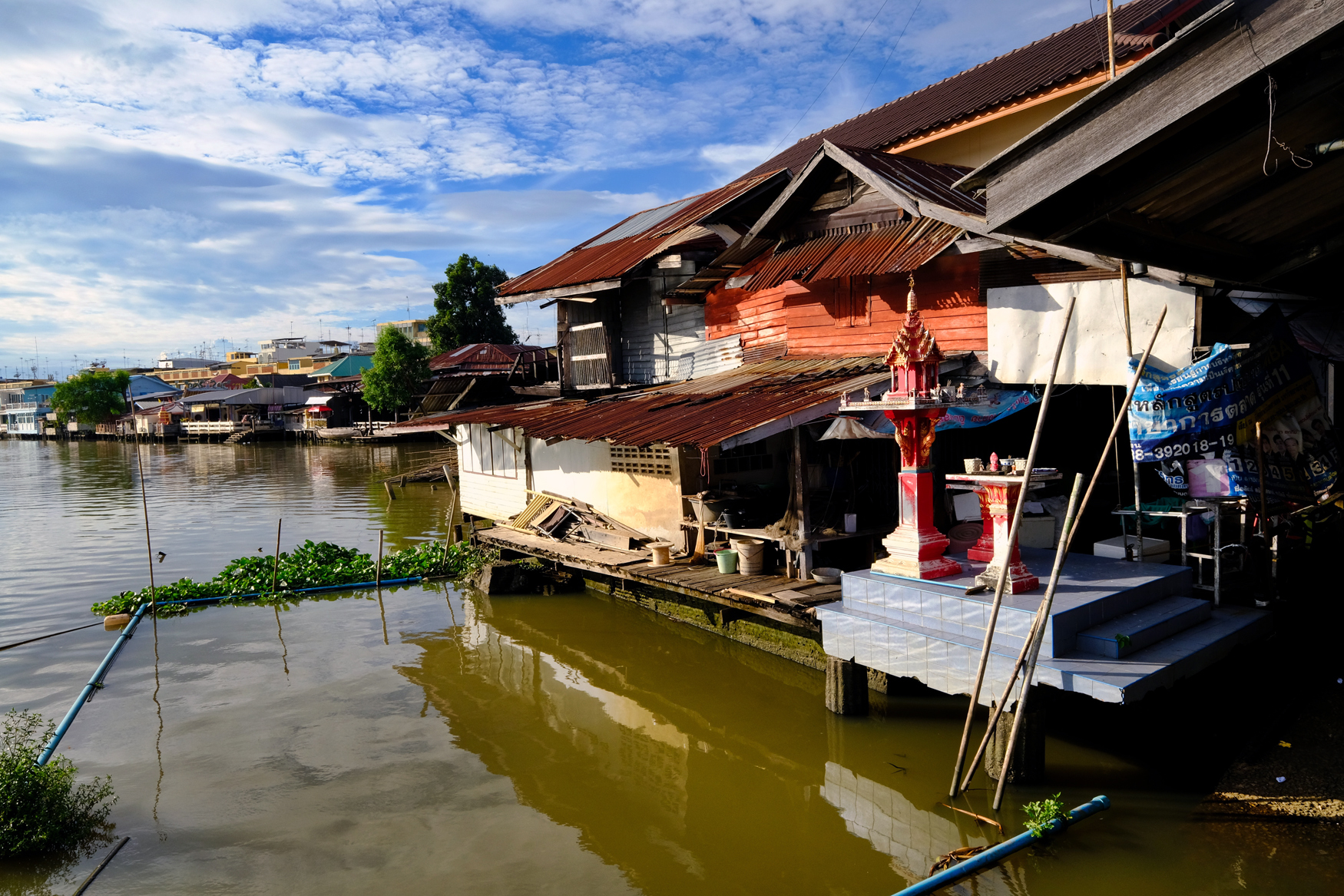 Chachoengsao riverfront.
Chachoengsao riverfront.
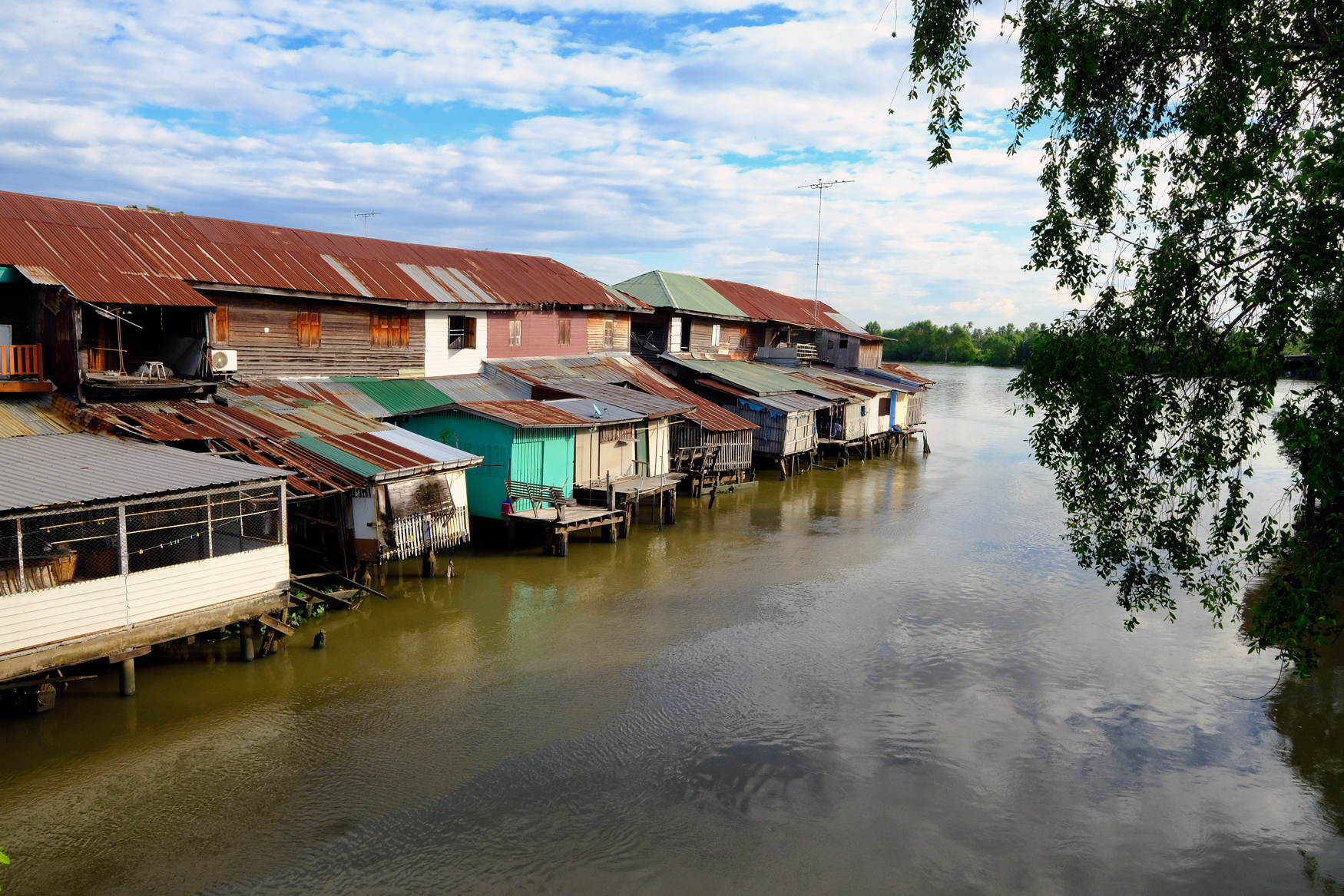 Such a beautiful place . . . but time to leave this part of town . . we still have a famous Wat and Buddha to see.
Such a beautiful place . . . but time to leave this part of town . . we still have a famous Wat and Buddha to see.
PART SIX: Wat Sathorn Wararam Worawihan
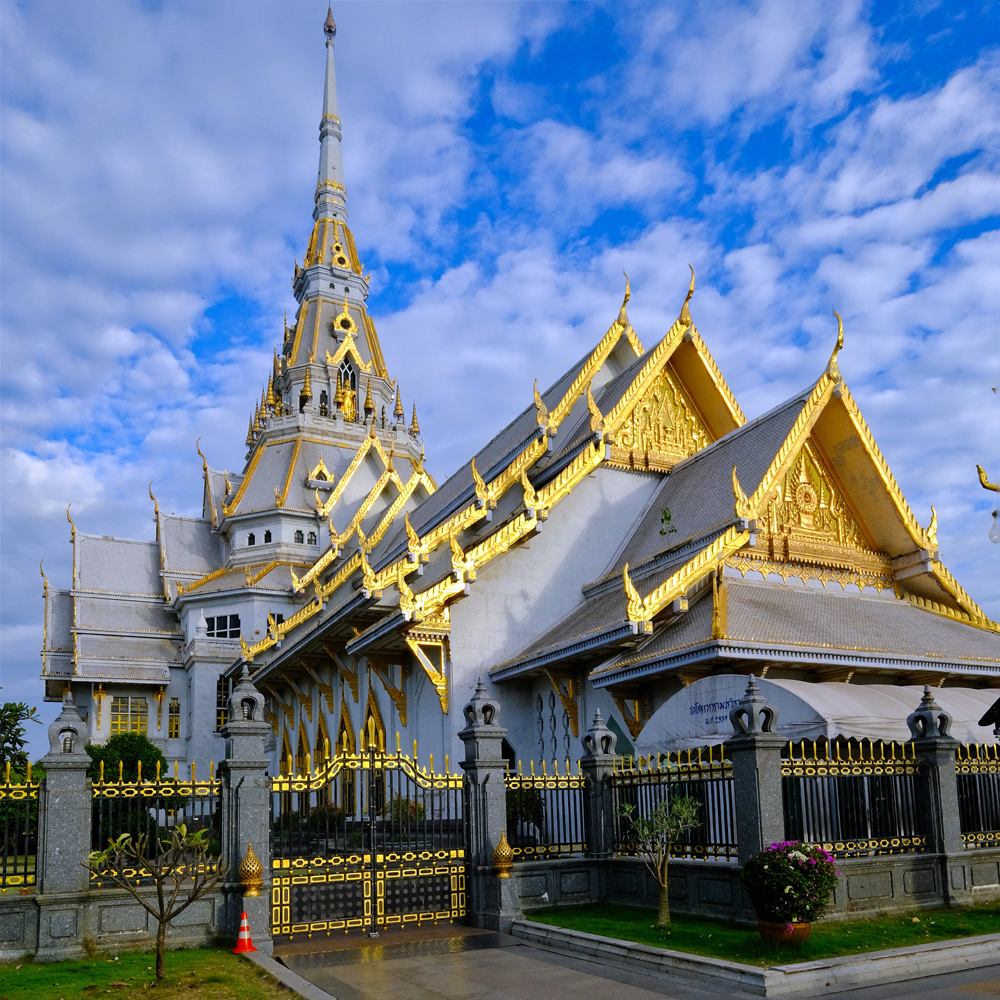 Wat Sothonwararam is located near the river in another part of Chachoengsao. It is one of the most famous Buddhist temples in the world, and is also possibly the largest Buddhist temple in the world. The temple has the ‘Luangpho Phuttha Sothon,’ the revered Buddha image.
Wat Sothonwararam is located near the river in another part of Chachoengsao. It is one of the most famous Buddhist temples in the world, and is also possibly the largest Buddhist temple in the world. The temple has the ‘Luangpho Phuttha Sothon,’ the revered Buddha image.
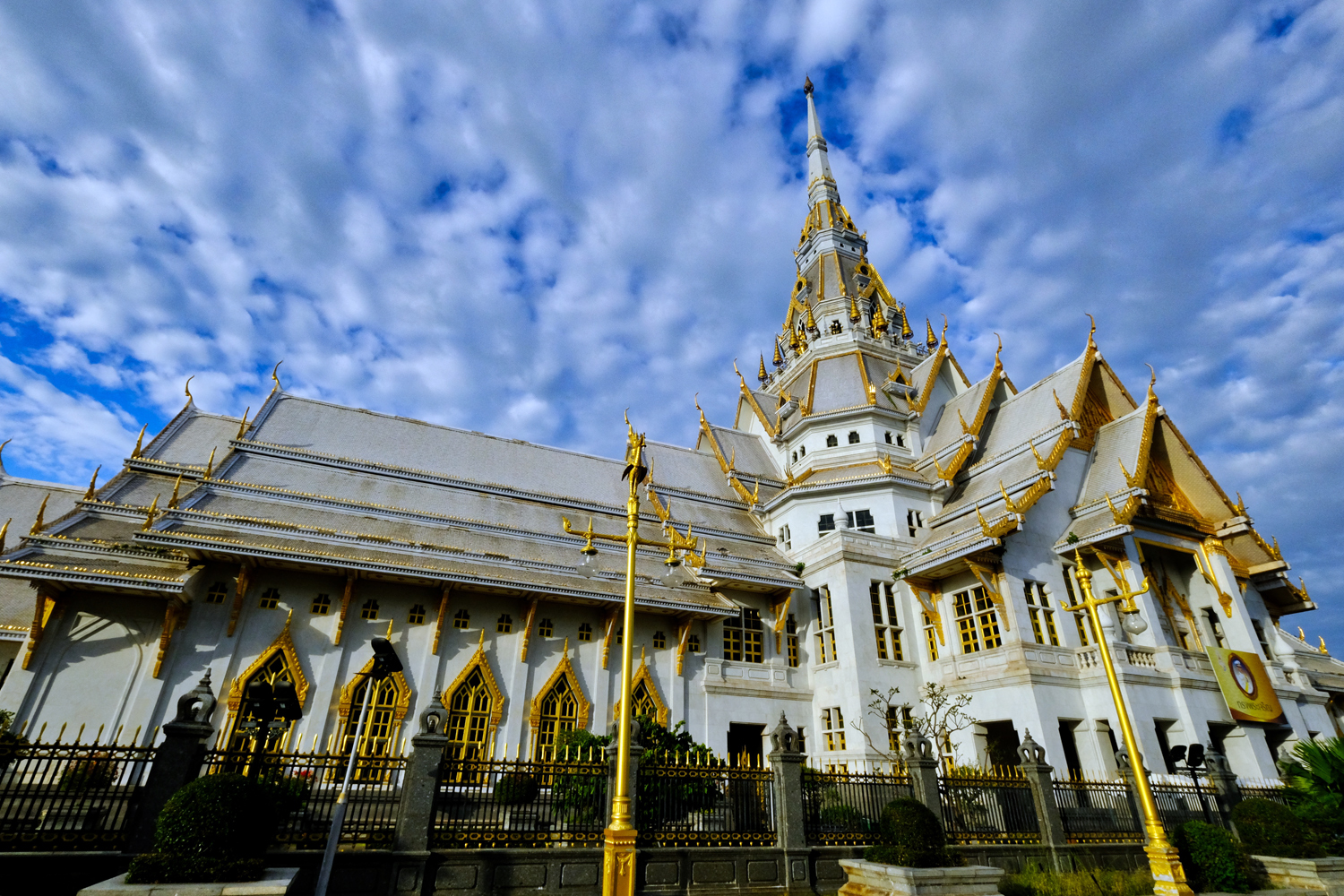 One of the most beautiful, and unique Buddhist Wats I have seen in Thailand.
One of the most beautiful, and unique Buddhist Wats I have seen in Thailand.
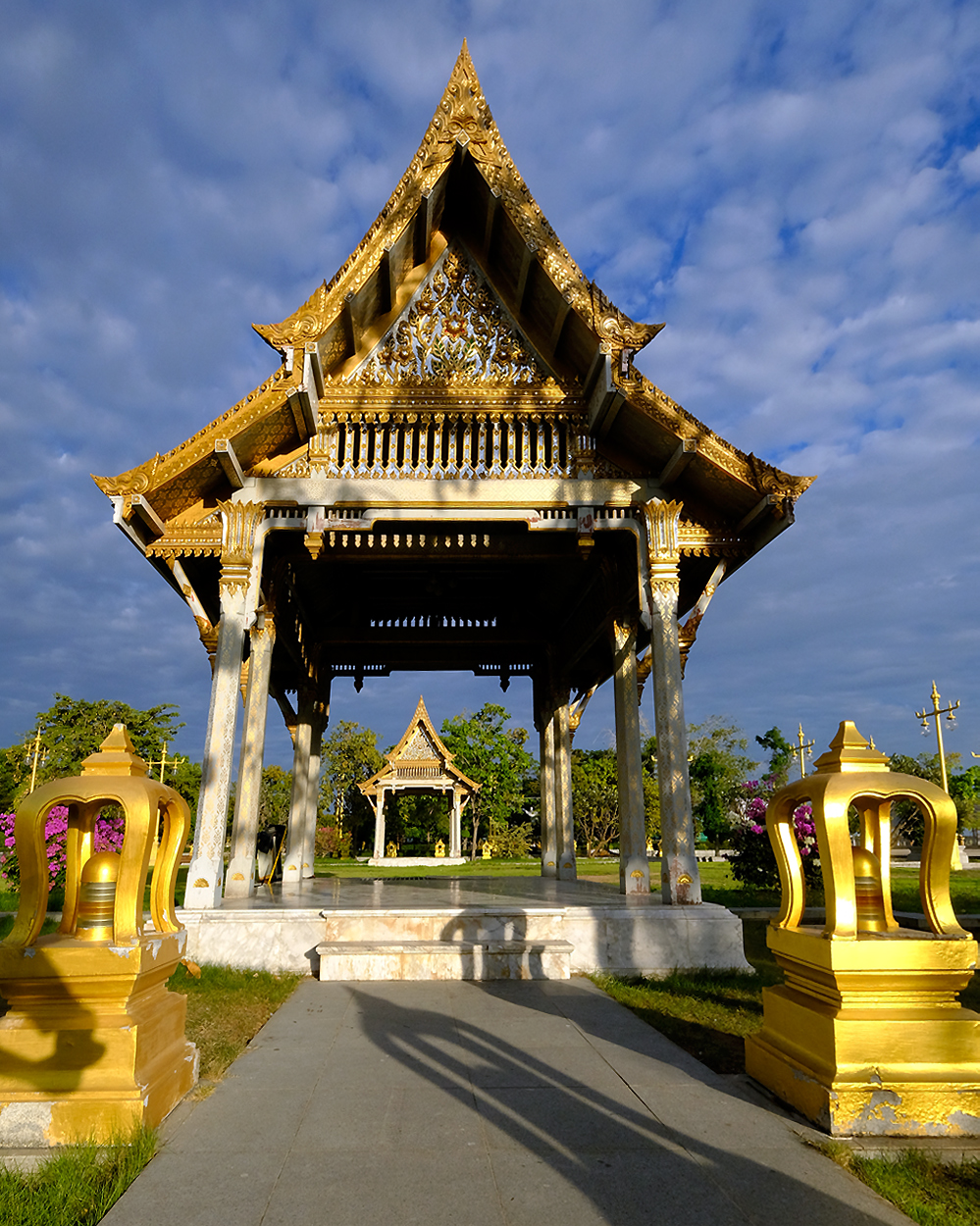 Many golden salas surround the Wat.
Many golden salas surround the Wat.
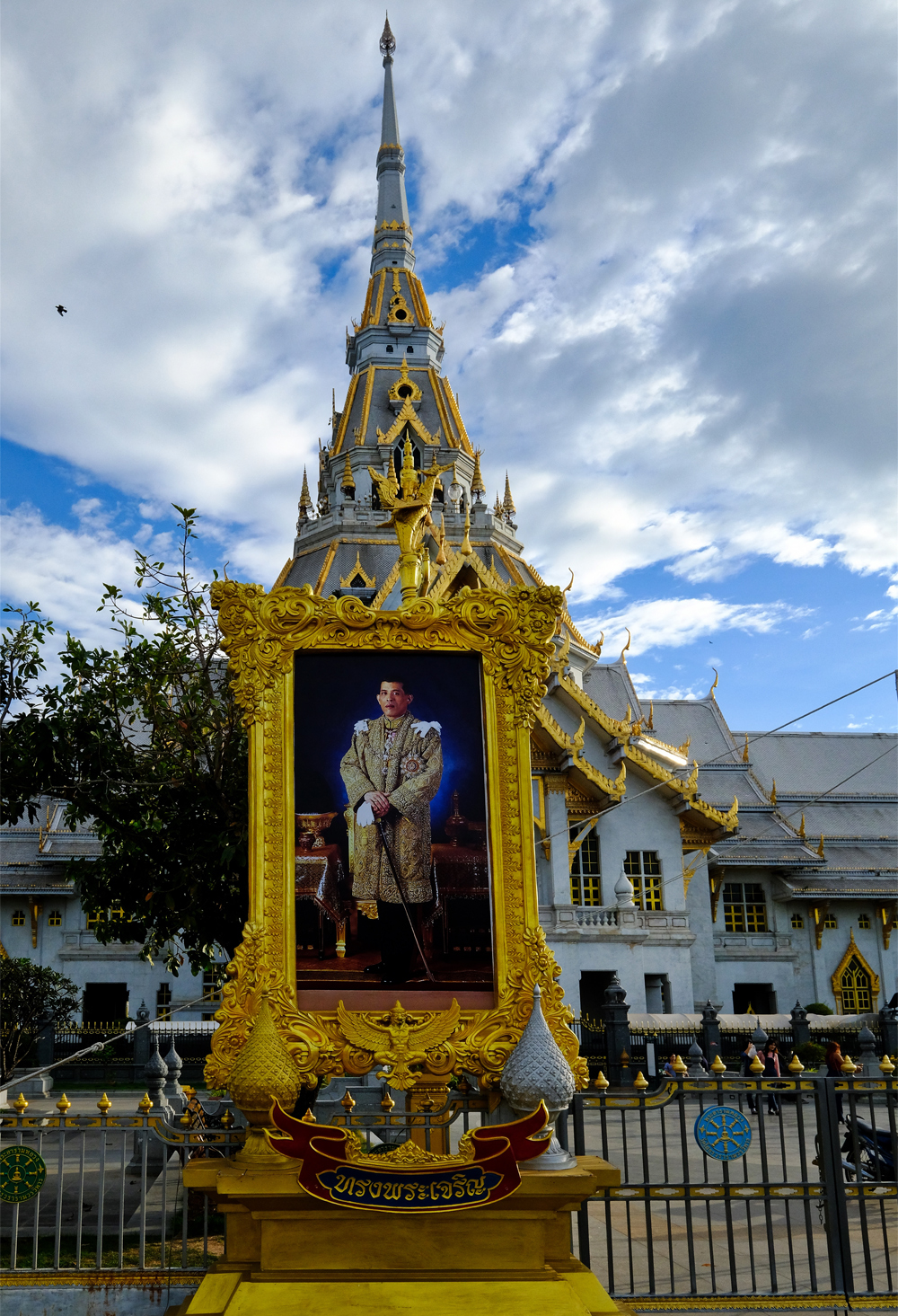 The Wat is under royal patronage. Here: a photo of the new King of Thailand.
The Wat is under royal patronage. Here: a photo of the new King of Thailand.
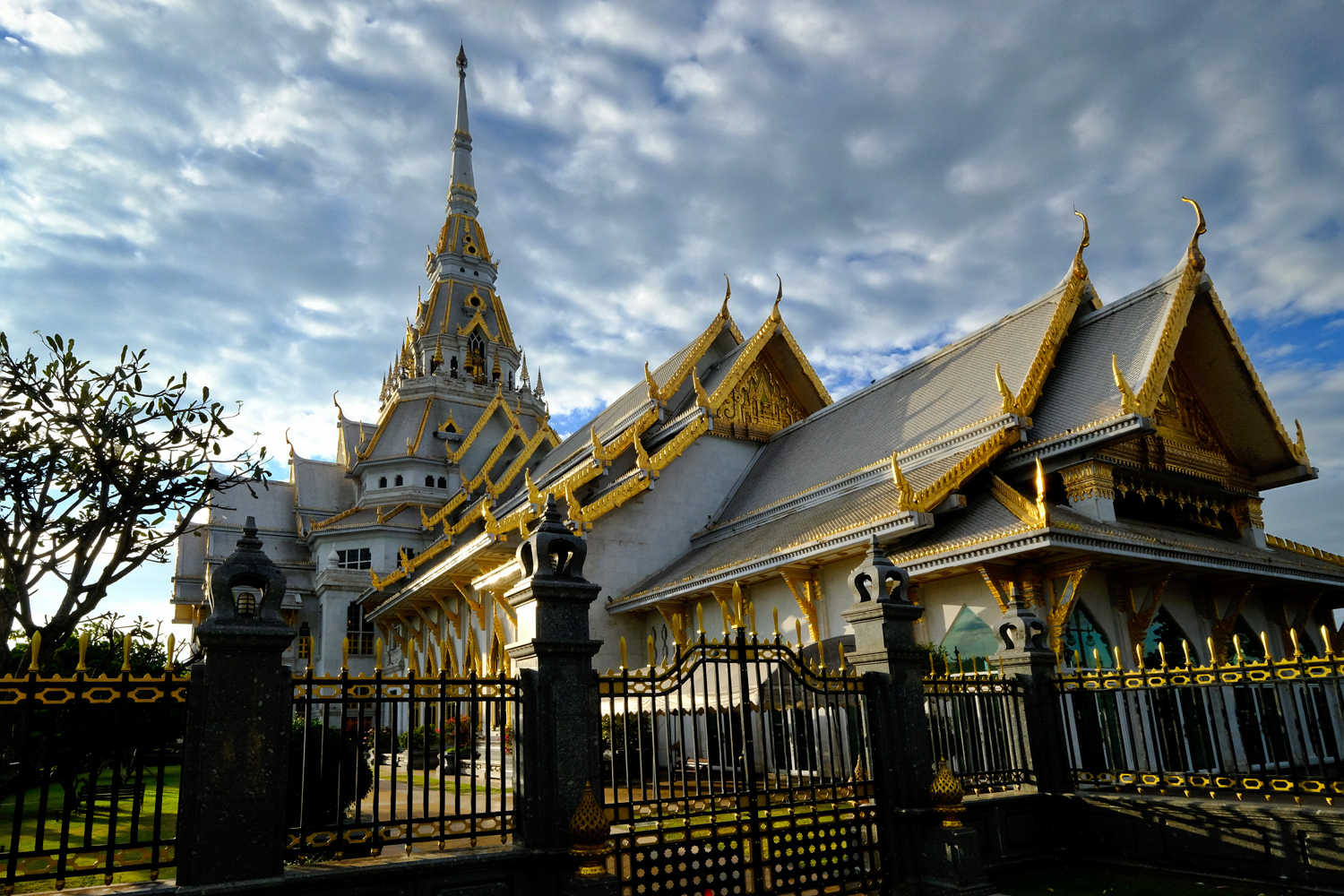 We had come to see the famous Buddha likeness inside, but, alas, we were too late . . . it closed at 5:00pm. What to do now? Let's go see some bats!
We had come to see the famous Buddha likeness inside, but, alas, we were too late . . . it closed at 5:00pm. What to do now? Let's go see some bats!
PART SEVEN: A BAT TEMPLE
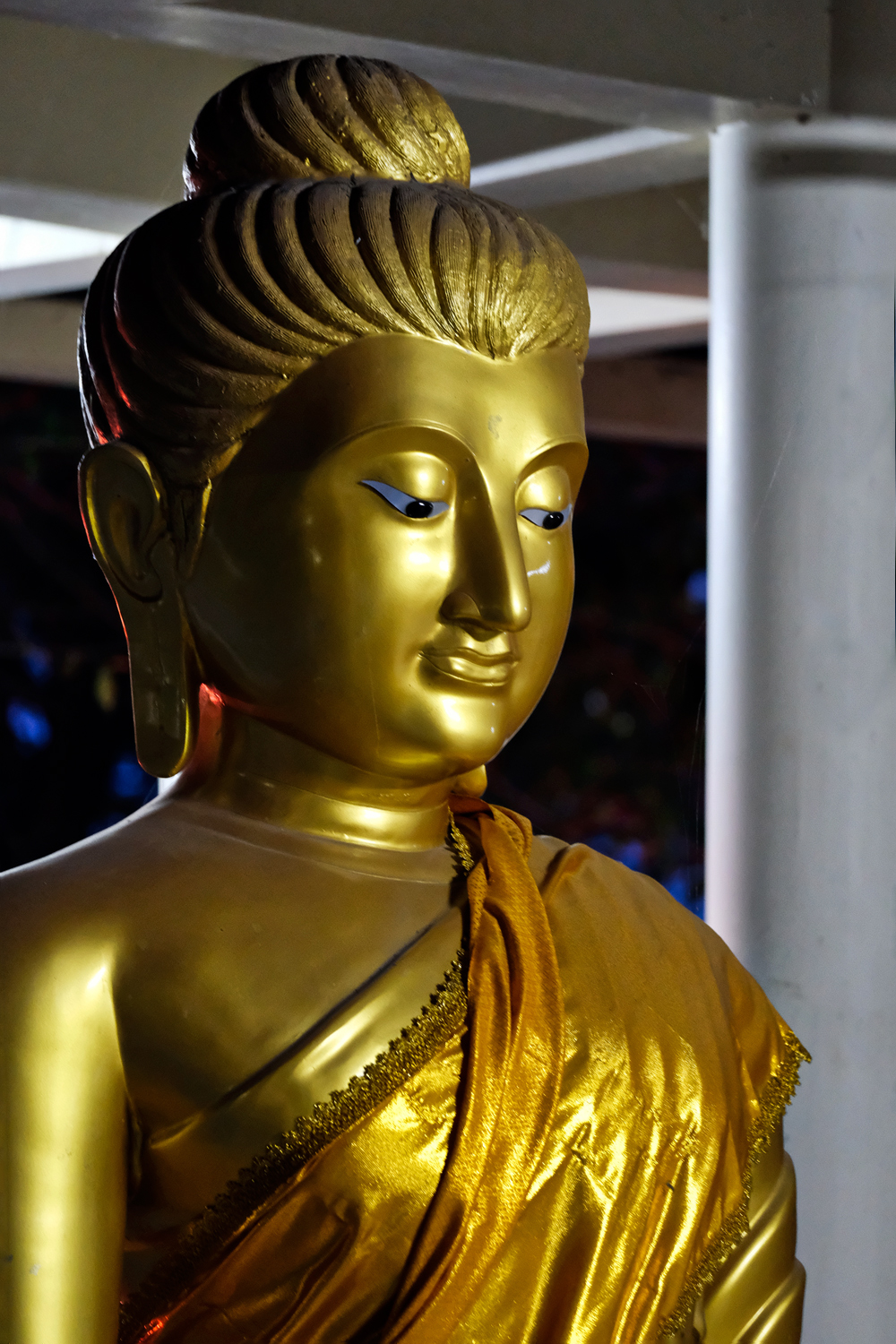 John read online that there was a Buddhist temple on the way back to Bangkok that had a mass flight of fruit bats from it's trees every evening and if we hurried we could see it. So we went on some very small rural roads and arrived just as it turned dark. A beautiful Wat . . . I took photos of the Buddhas first.
John read online that there was a Buddhist temple on the way back to Bangkok that had a mass flight of fruit bats from it's trees every evening and if we hurried we could see it. So we went on some very small rural roads and arrived just as it turned dark. A beautiful Wat . . . I took photos of the Buddhas first.
Very old and revered Buddha images.
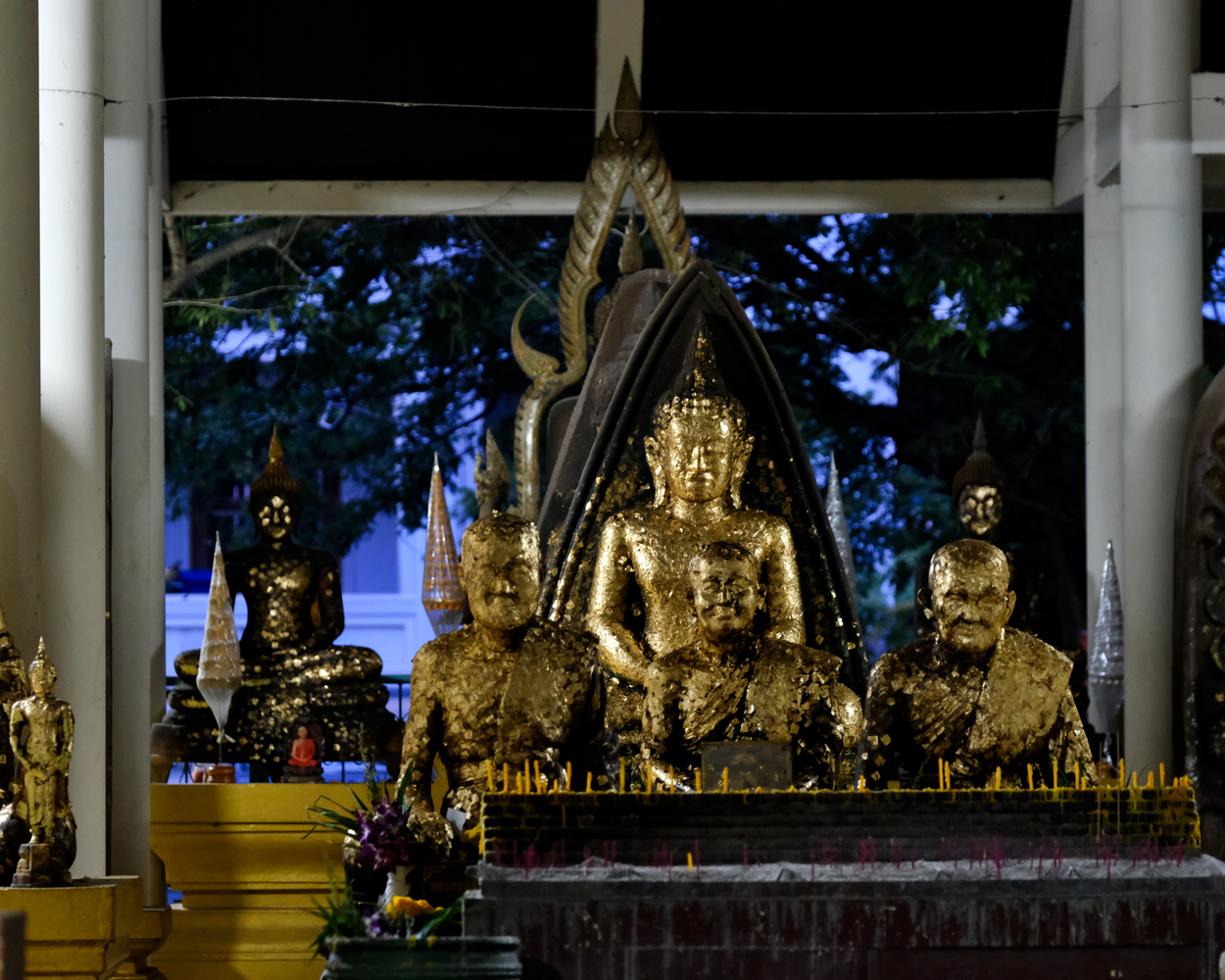 More revered Buddha images at the bat Wat.
More revered Buddha images at the bat Wat.
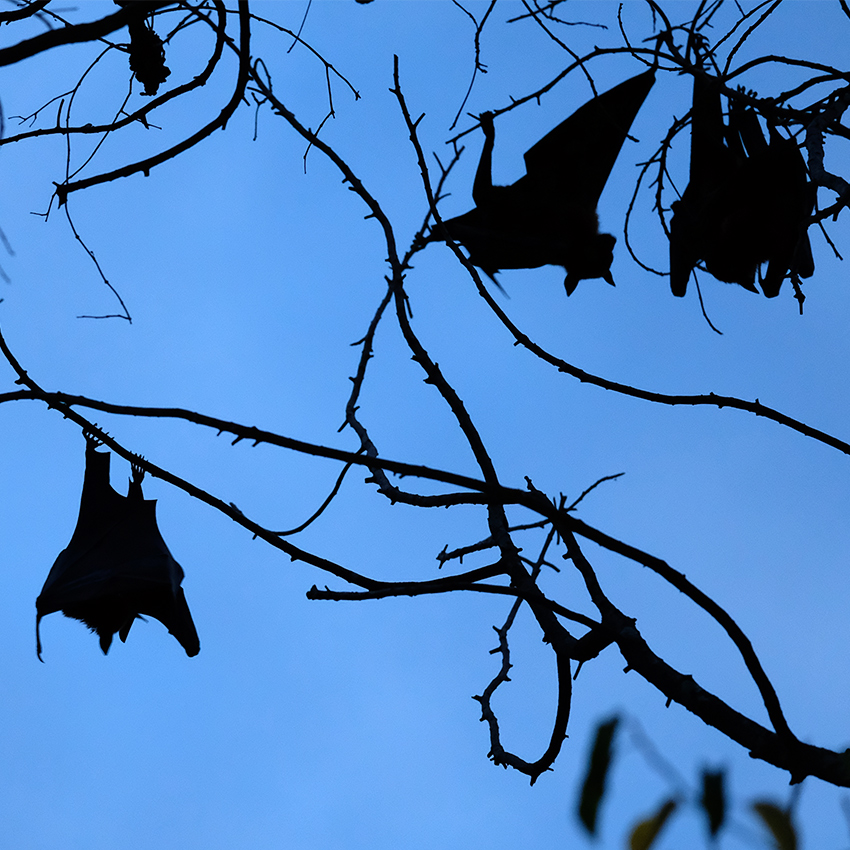 The trees were hung with hundreds of very large fruit bats!
The trees were hung with hundreds of very large fruit bats!
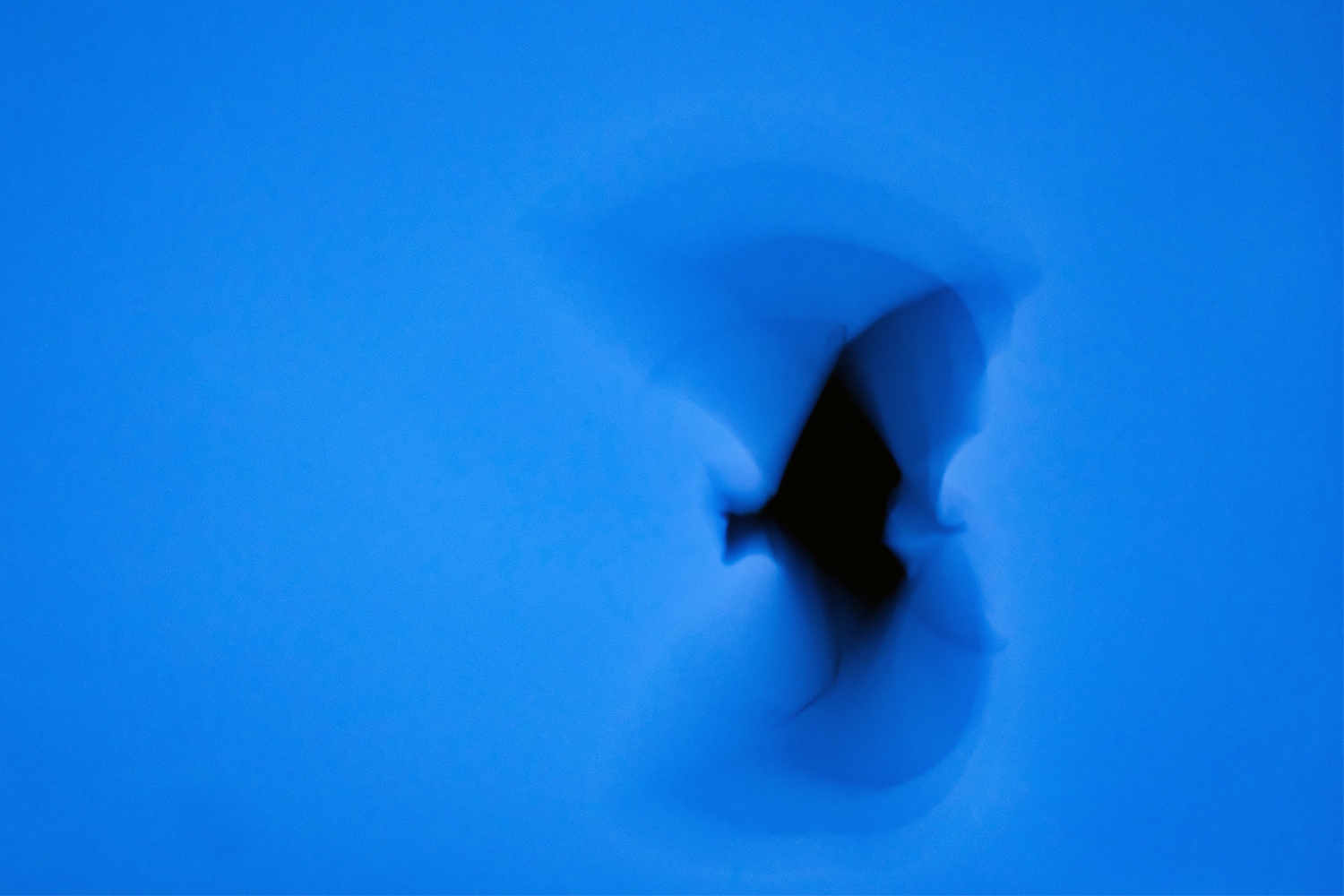 The bats flew around so fast, and it was getting so dark, that it was almost impossible to photograph them . . . but I managed this one shot I like.
The bats flew around so fast, and it was getting so dark, that it was almost impossible to photograph them . . . but I managed this one shot I like.
John and I had a wonderful day trip out of Bangkok. We left at 6:30am and returned to Bangkok at 8:30pm. What a day!
Memories of Scotland: Isle of Mull Road Trip
 Saturday, August 12, 2017 at 8:17AM
Saturday, August 12, 2017 at 8:17AM 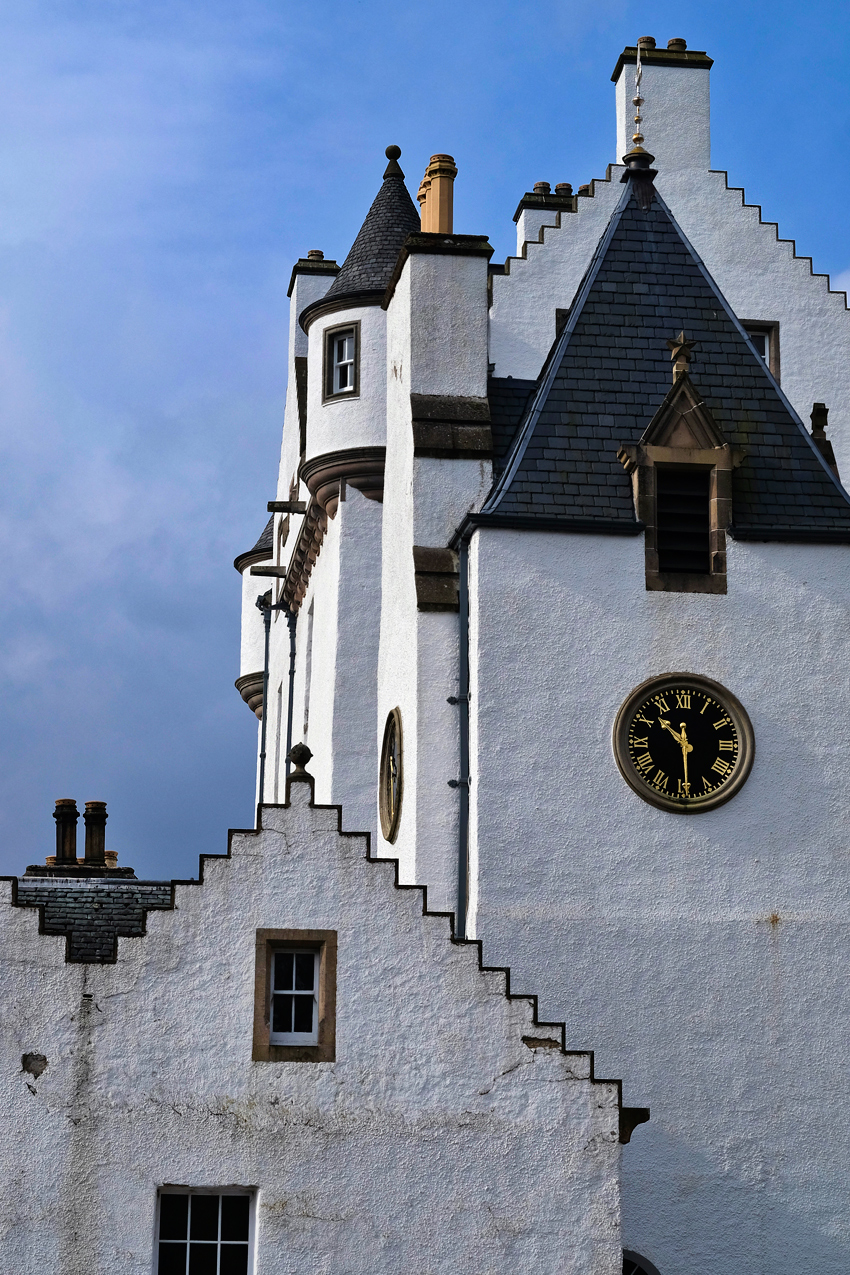 Our trip to the Isle of Mull was, a road trip, and as such, we saw many interesting places on the way there. One such place of interest was not far from where we spent the night, the famous village of Pitlochry . . . Blair Castle.
Our trip to the Isle of Mull was, a road trip, and as such, we saw many interesting places on the way there. One such place of interest was not far from where we spent the night, the famous village of Pitlochry . . . Blair Castle.
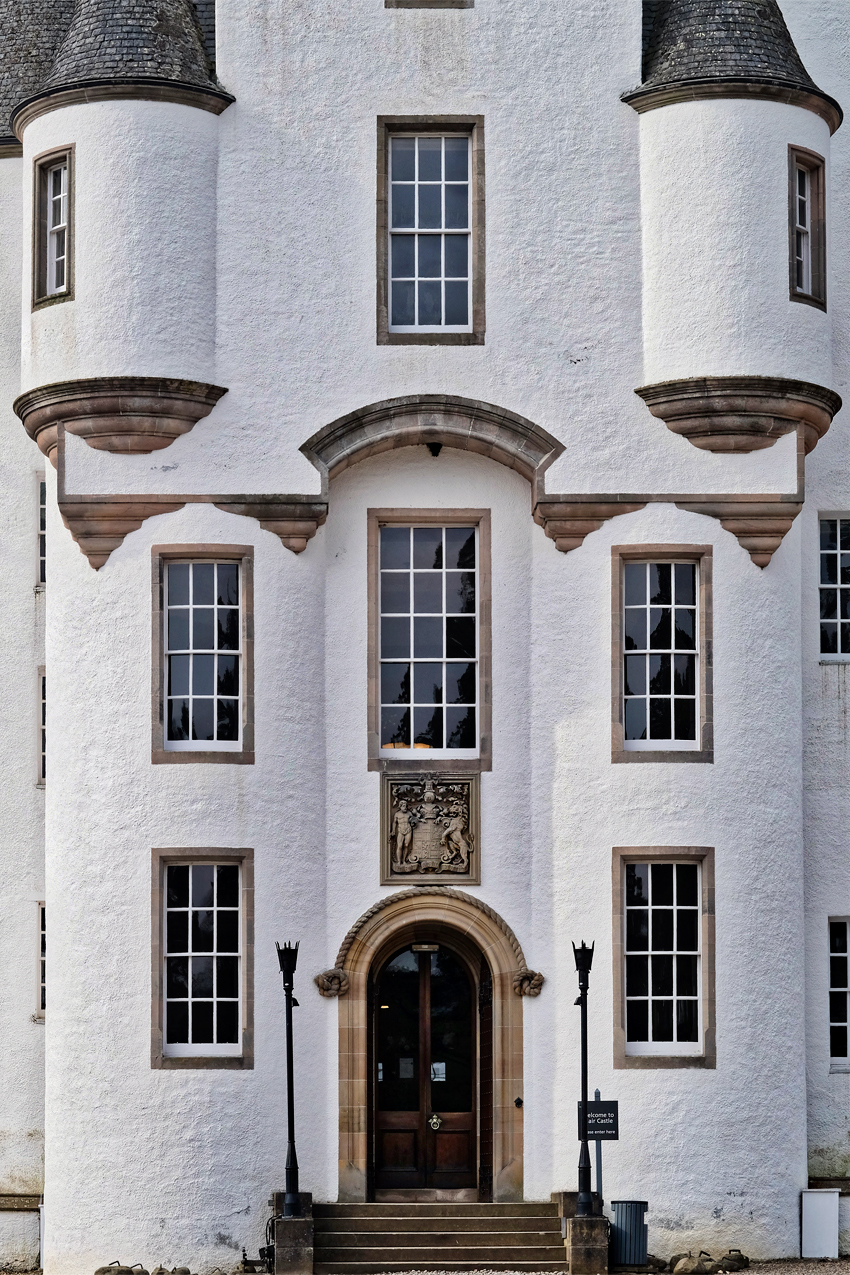 The oldest sections of Blair Castle date from 1269.
The oldest sections of Blair Castle date from 1269.
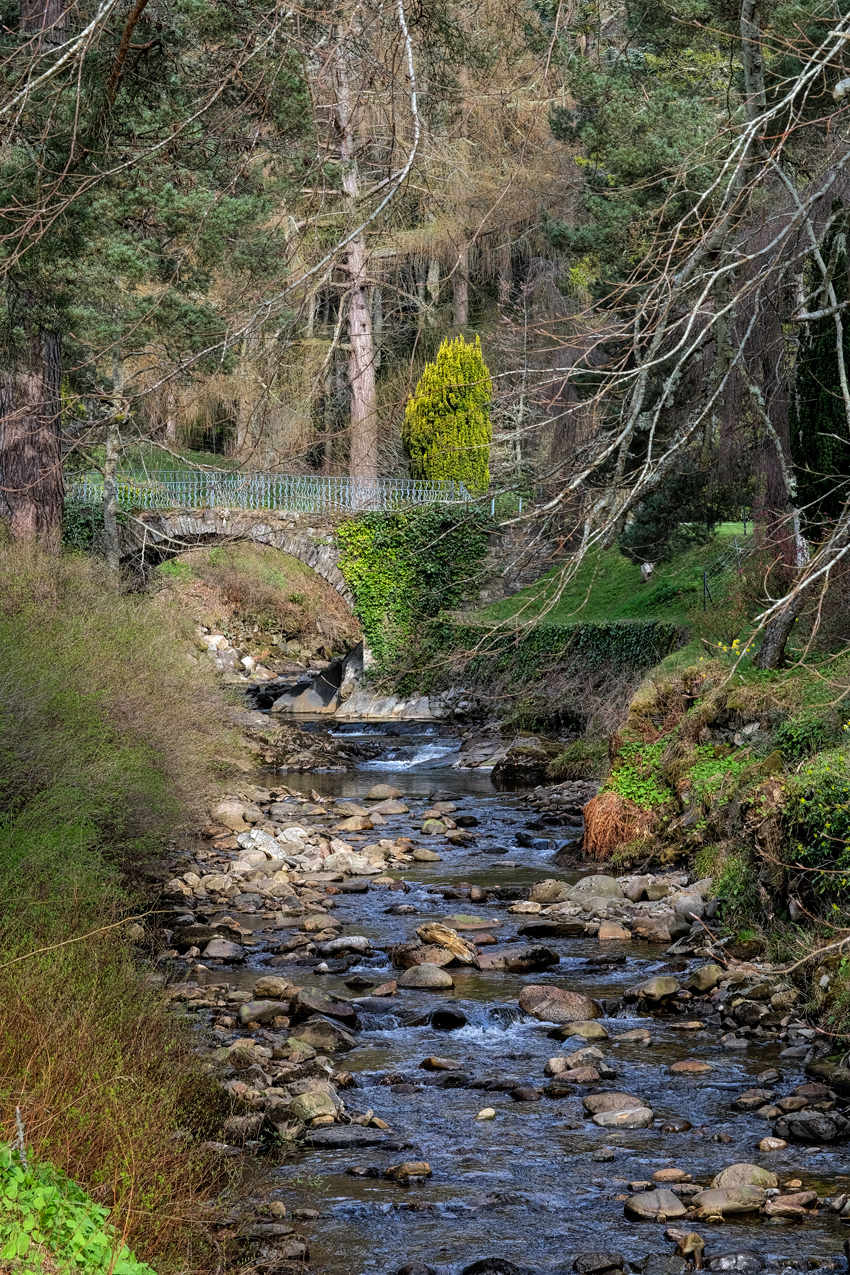 A lovely burn (creek) ran along the side of the castle.
A lovely burn (creek) ran along the side of the castle.
 Like many castles in Scotland, there have been many renovations and much remodeling over the centuries.
Like many castles in Scotland, there have been many renovations and much remodeling over the centuries.
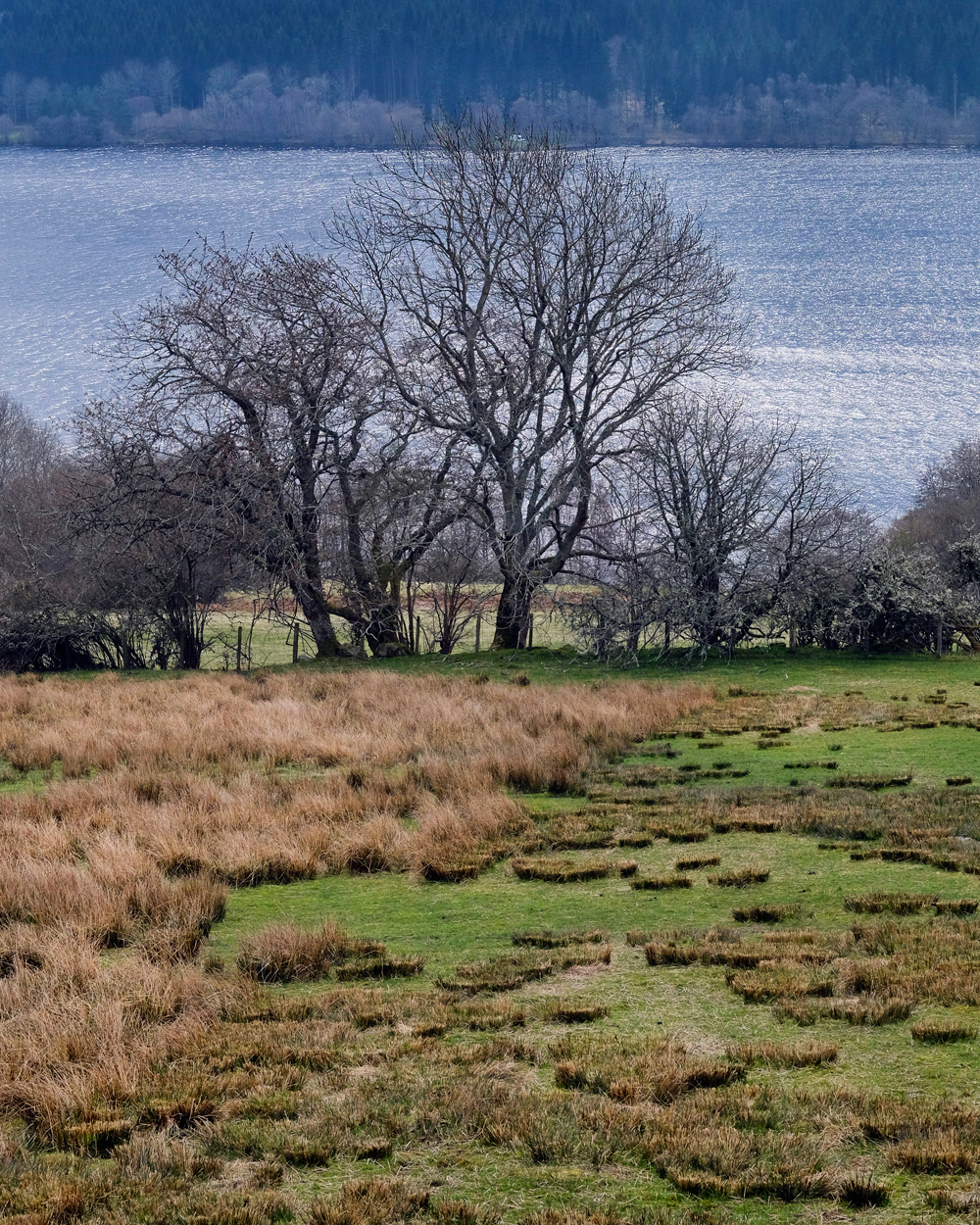 Our route took us along the souther edge of the Highlands, and along Loch Tummel.
Our route took us along the souther edge of the Highlands, and along Loch Tummel.
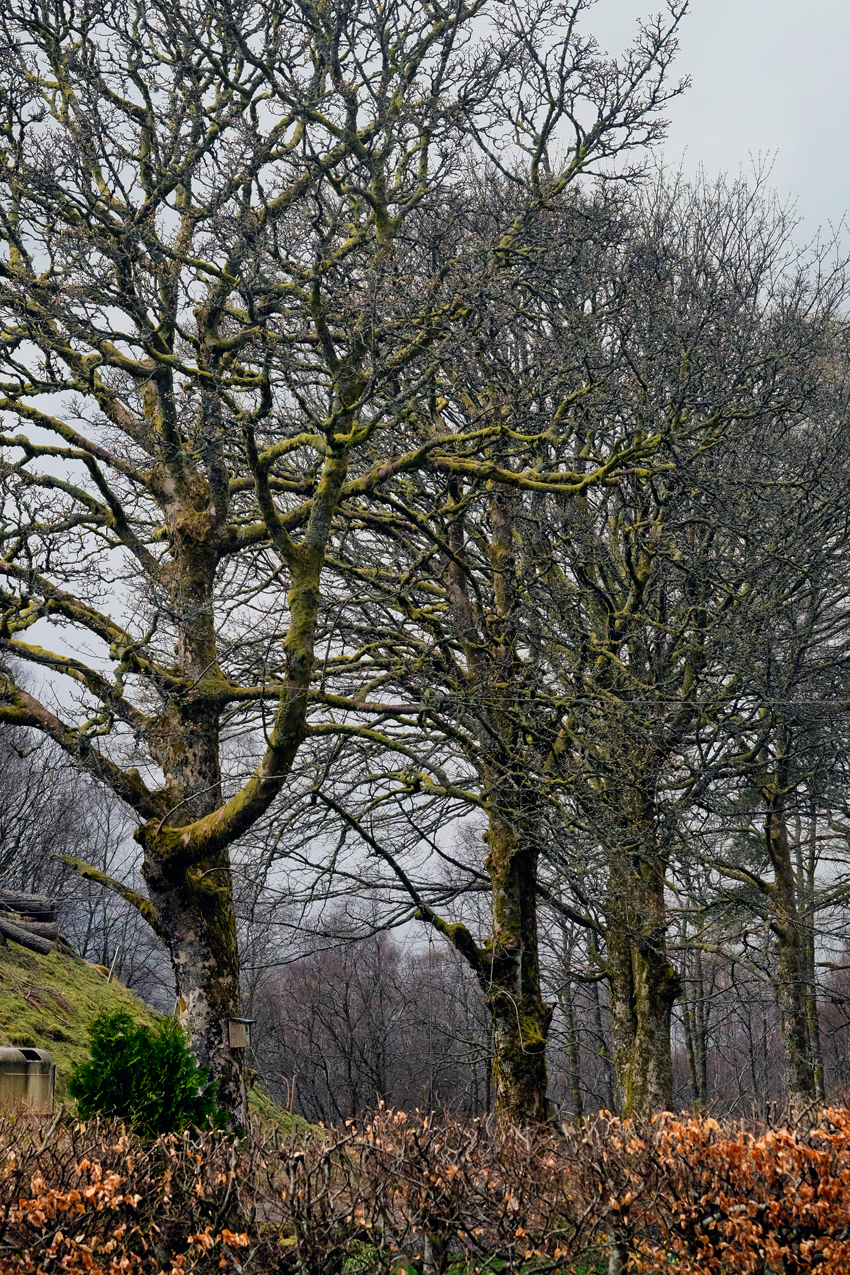 Although it was early April, Spring had not yet reached Scotland.
Although it was early April, Spring had not yet reached Scotland.
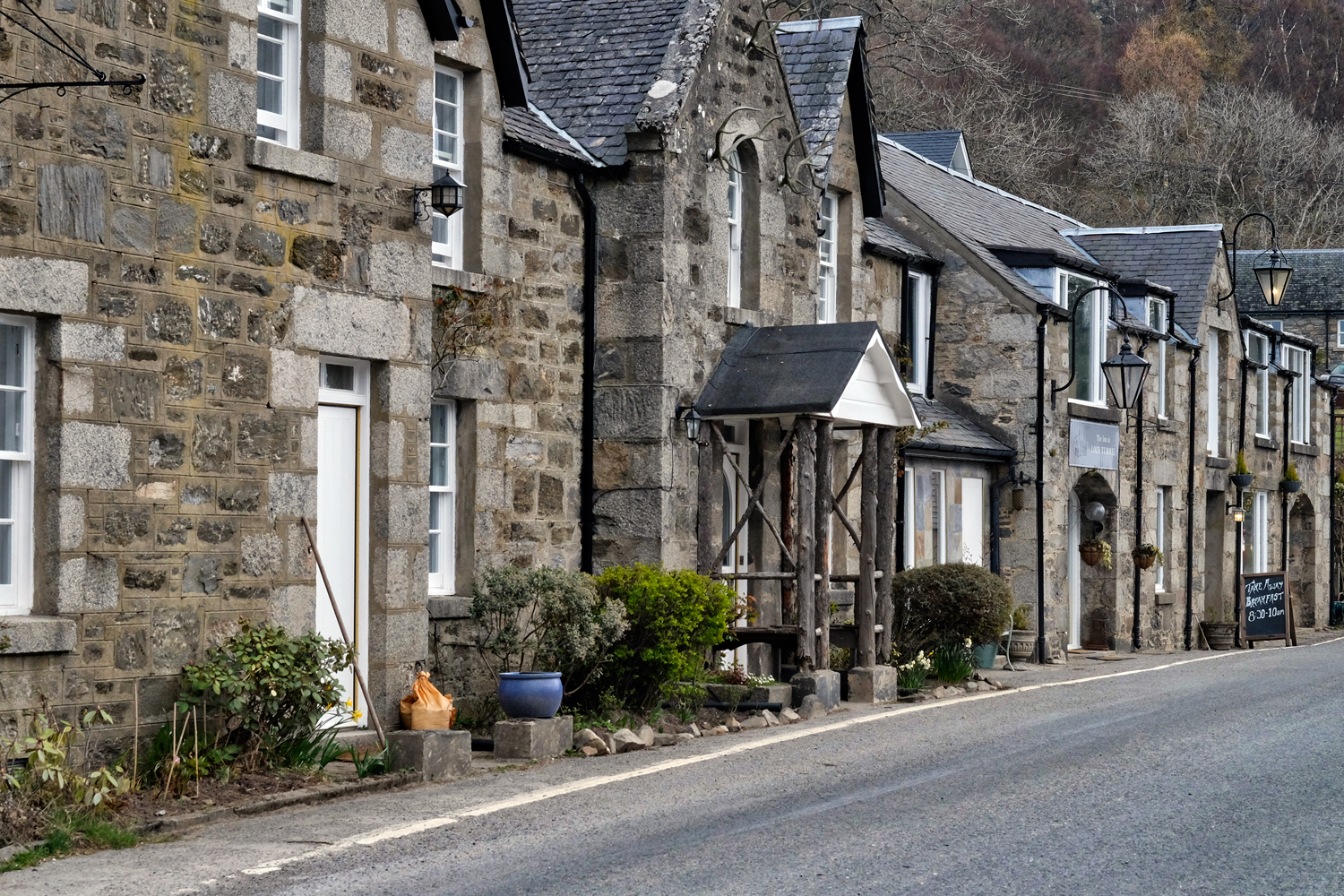 Way out in the countryside, people still built their homes as row houses . . . a statement of the power of the Scottish Lairds as much as anything I guess. Here, along Loch Tummel.
Way out in the countryside, people still built their homes as row houses . . . a statement of the power of the Scottish Lairds as much as anything I guess. Here, along Loch Tummel.
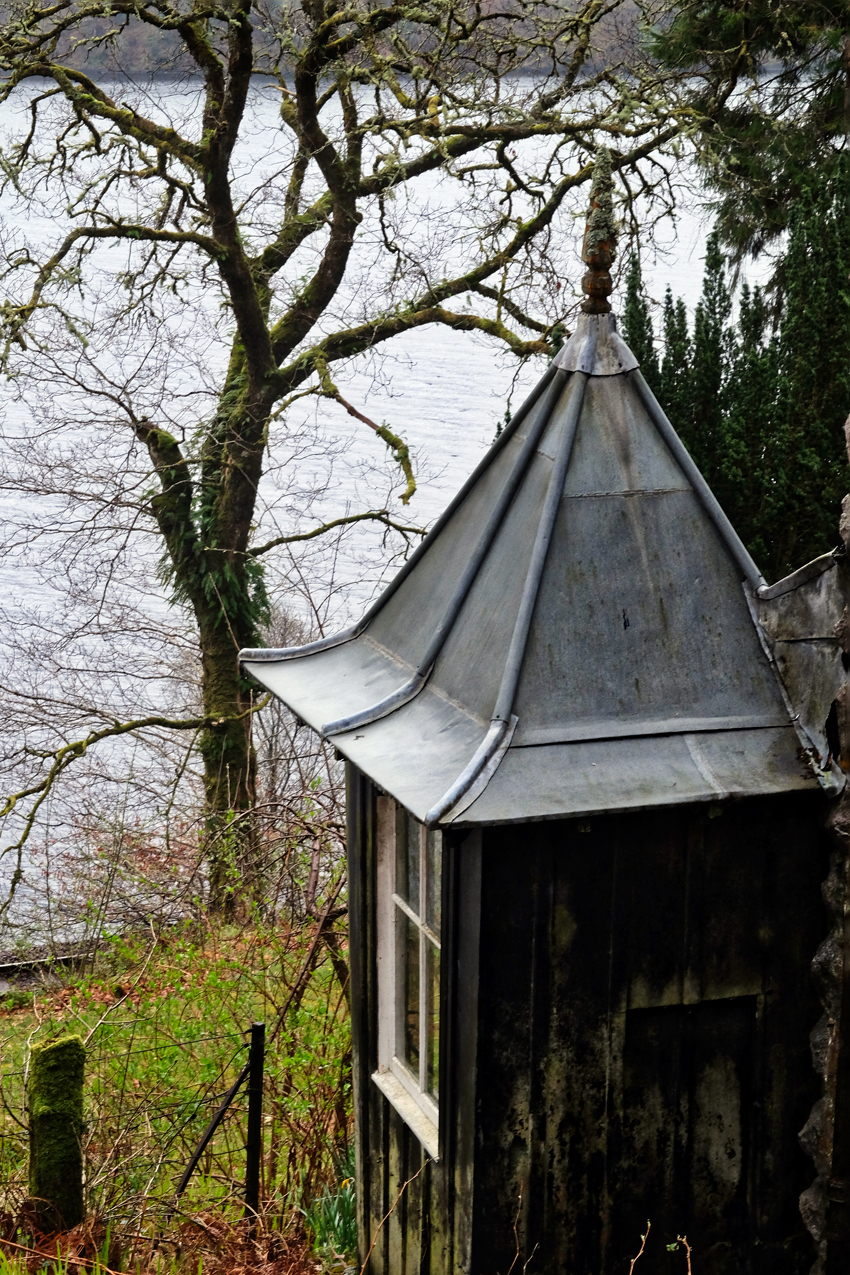 Along the bluff above Loch Awe.
Along the bluff above Loch Awe.
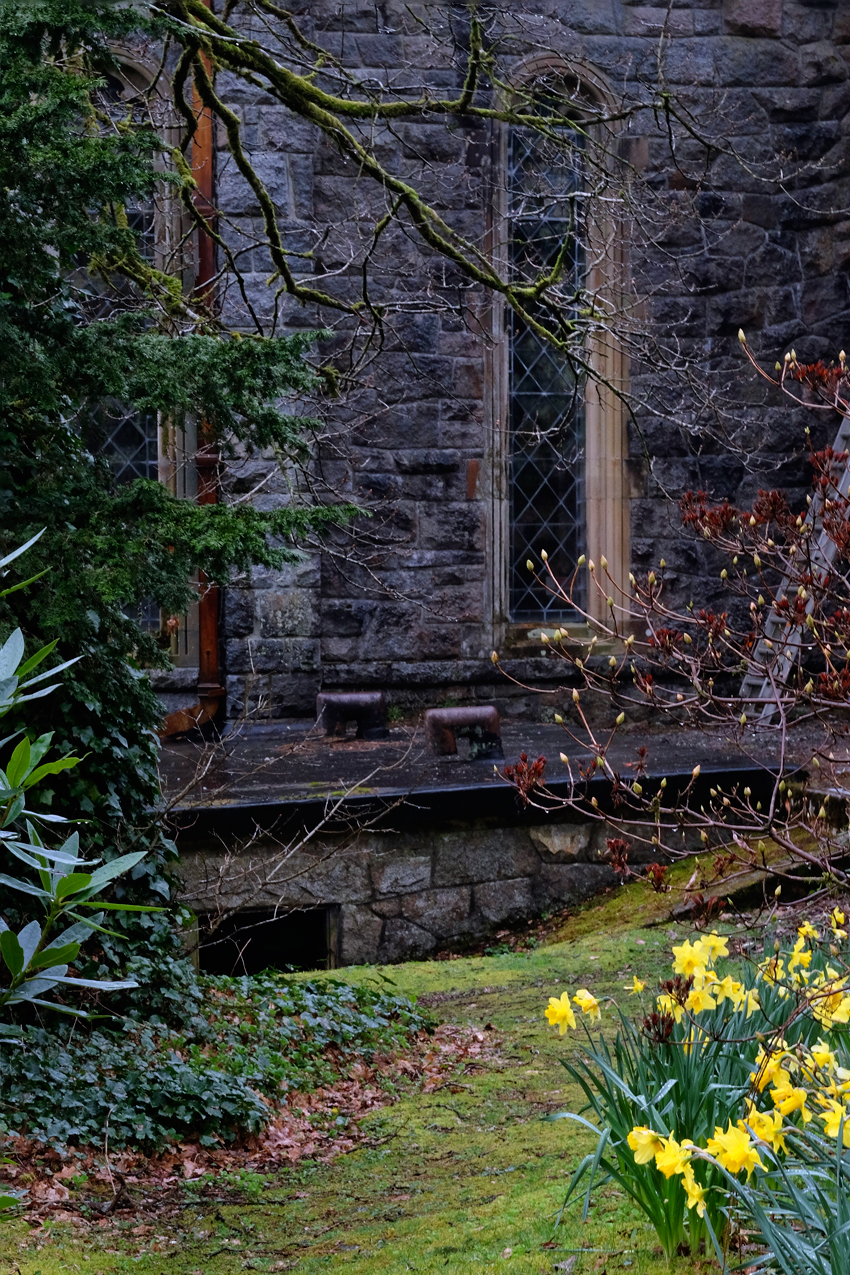 Lovely.
Lovely.
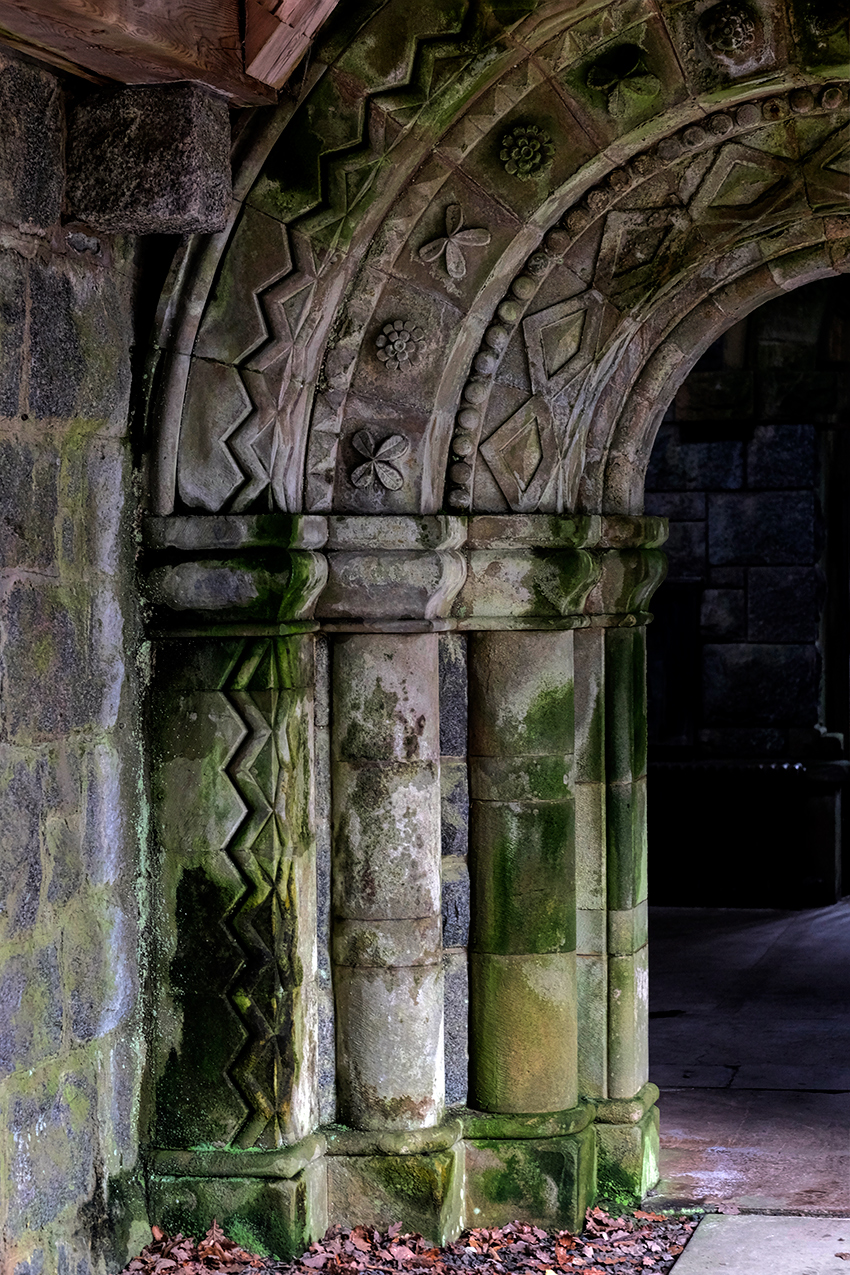 I wanted to take our Thai visitors to a magical place . . .
I wanted to take our Thai visitors to a magical place . . .
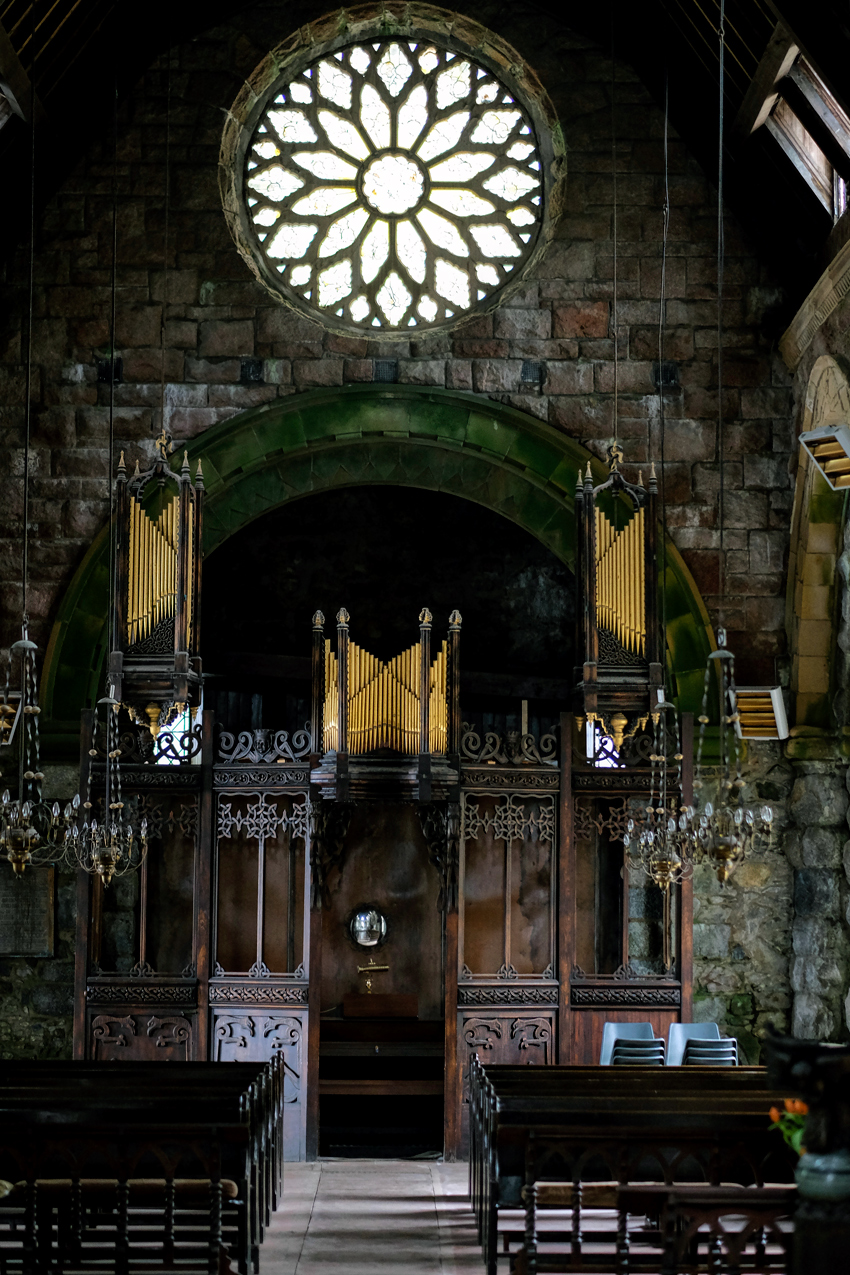 I wanted our visitors to see one of my favorite chapels in Scotland, Saint Conan's Kirke on the shores of Lach Awe.
I wanted our visitors to see one of my favorite chapels in Scotland, Saint Conan's Kirke on the shores of Lach Awe.
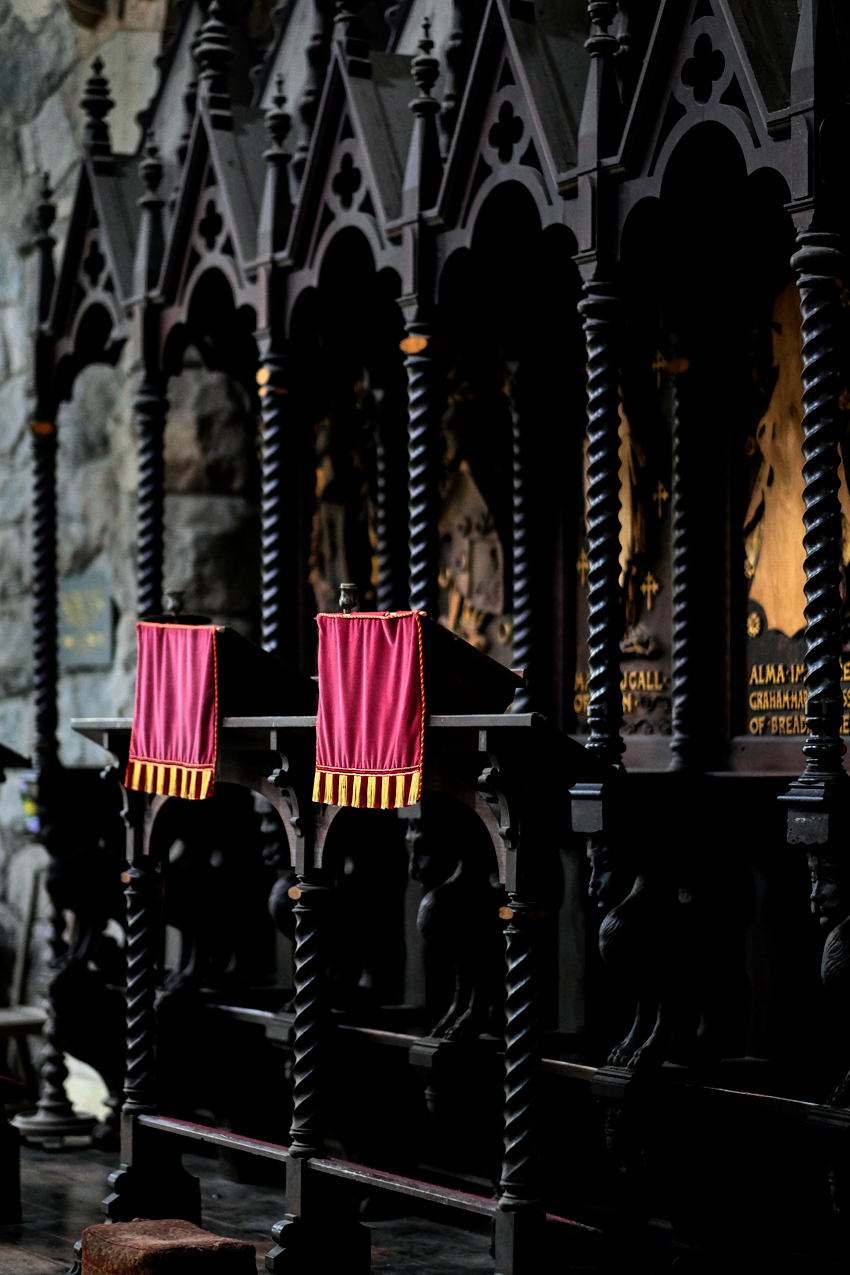 Saint Conan's Kirke is interesting because all the local Clans had a seat of representation in the chapel.
Saint Conan's Kirke is interesting because all the local Clans had a seat of representation in the chapel.
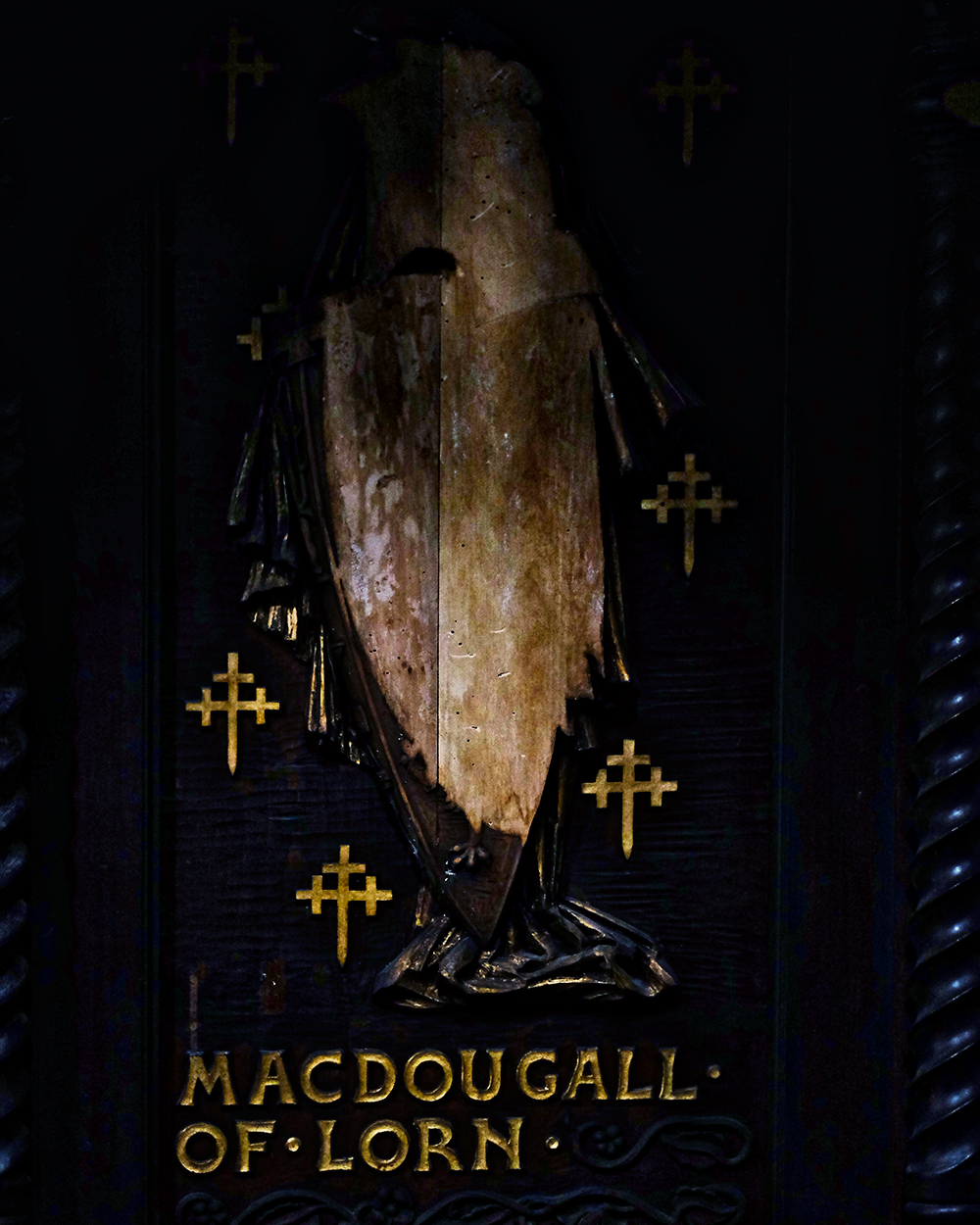 The Clan seats were reserved with their coat of arms. Fascinating cultural artifact.
The Clan seats were reserved with their coat of arms. Fascinating cultural artifact.
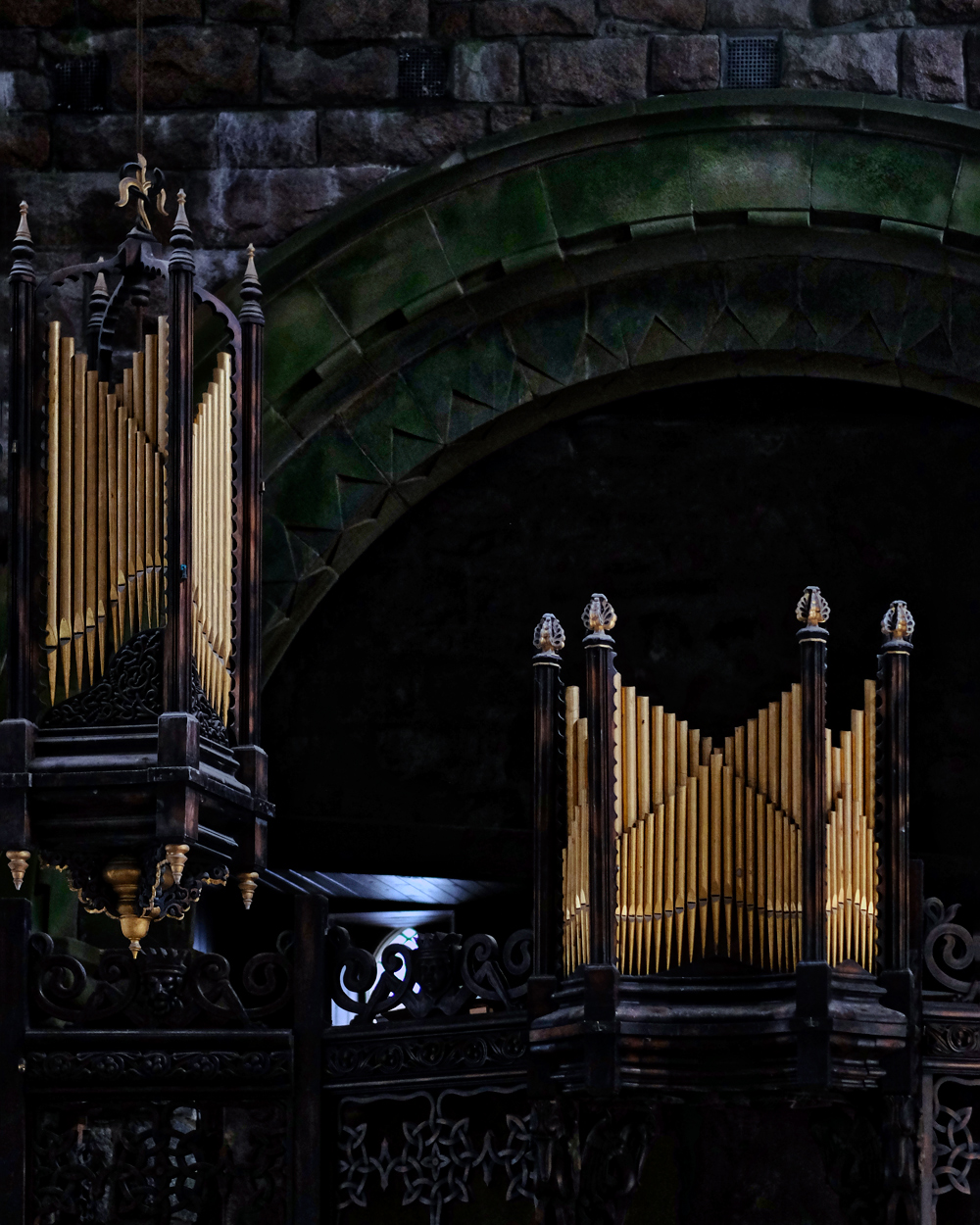 A beautiful pipe organ filled one side of the chapel. I would love to have been there to hear it play.
A beautiful pipe organ filled one side of the chapel. I would love to have been there to hear it play.
 The crypts of nights and clan leaders lined the chapel.
The crypts of nights and clan leaders lined the chapel.
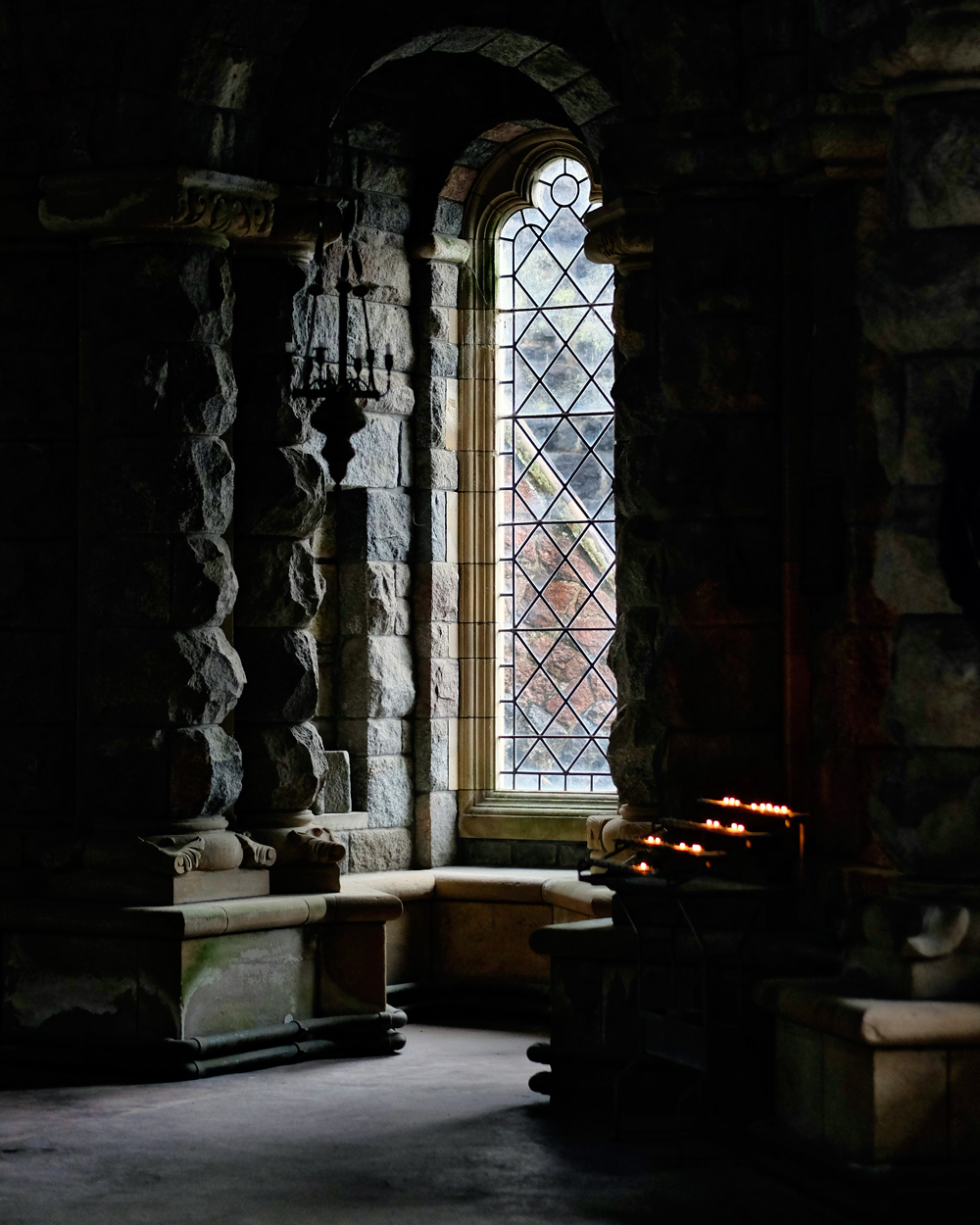 The Saint Conan's Kirke chapel interior with many moods.
The Saint Conan's Kirke chapel interior with many moods.
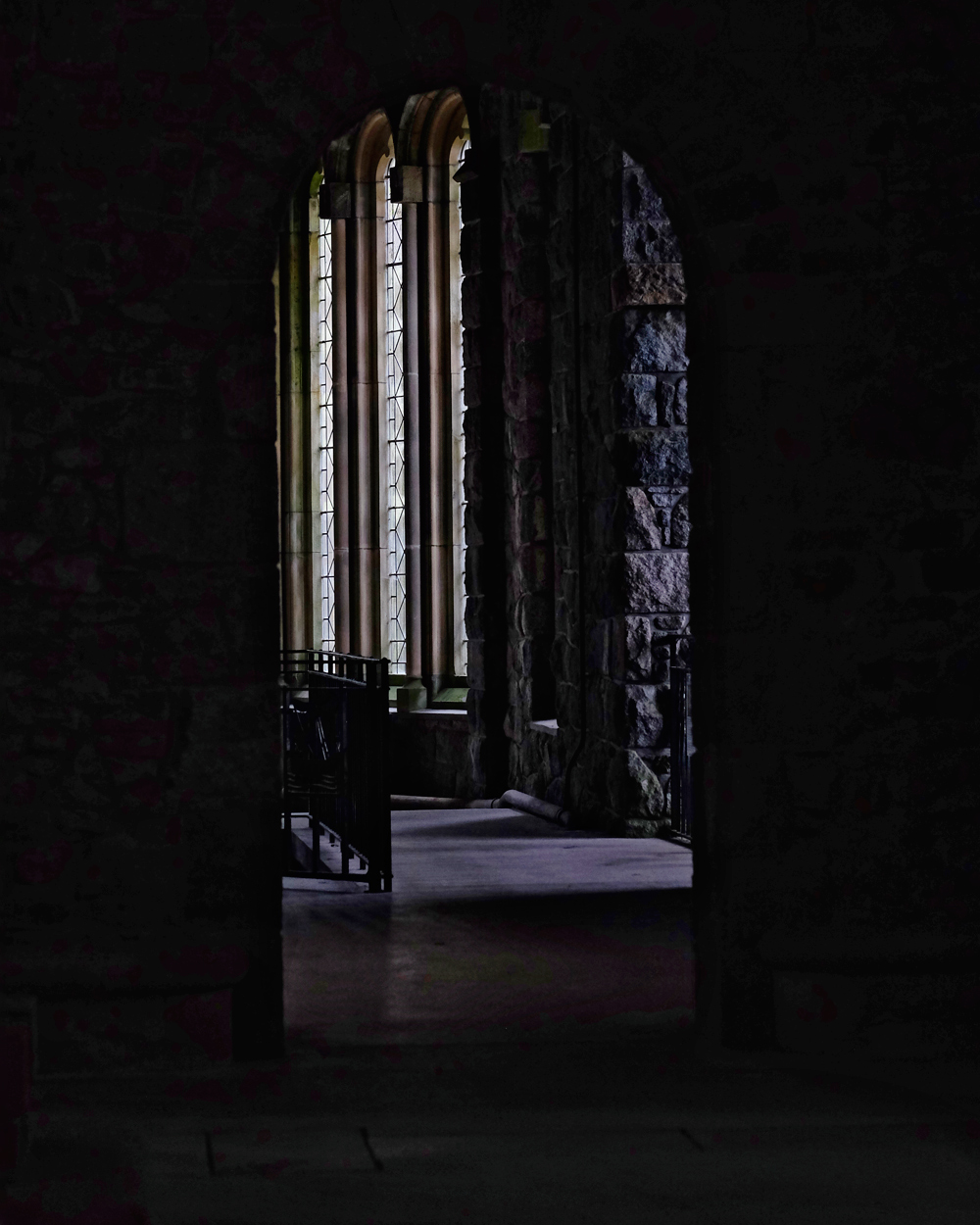 A dark, cloudy day . . .
A dark, cloudy day . . .
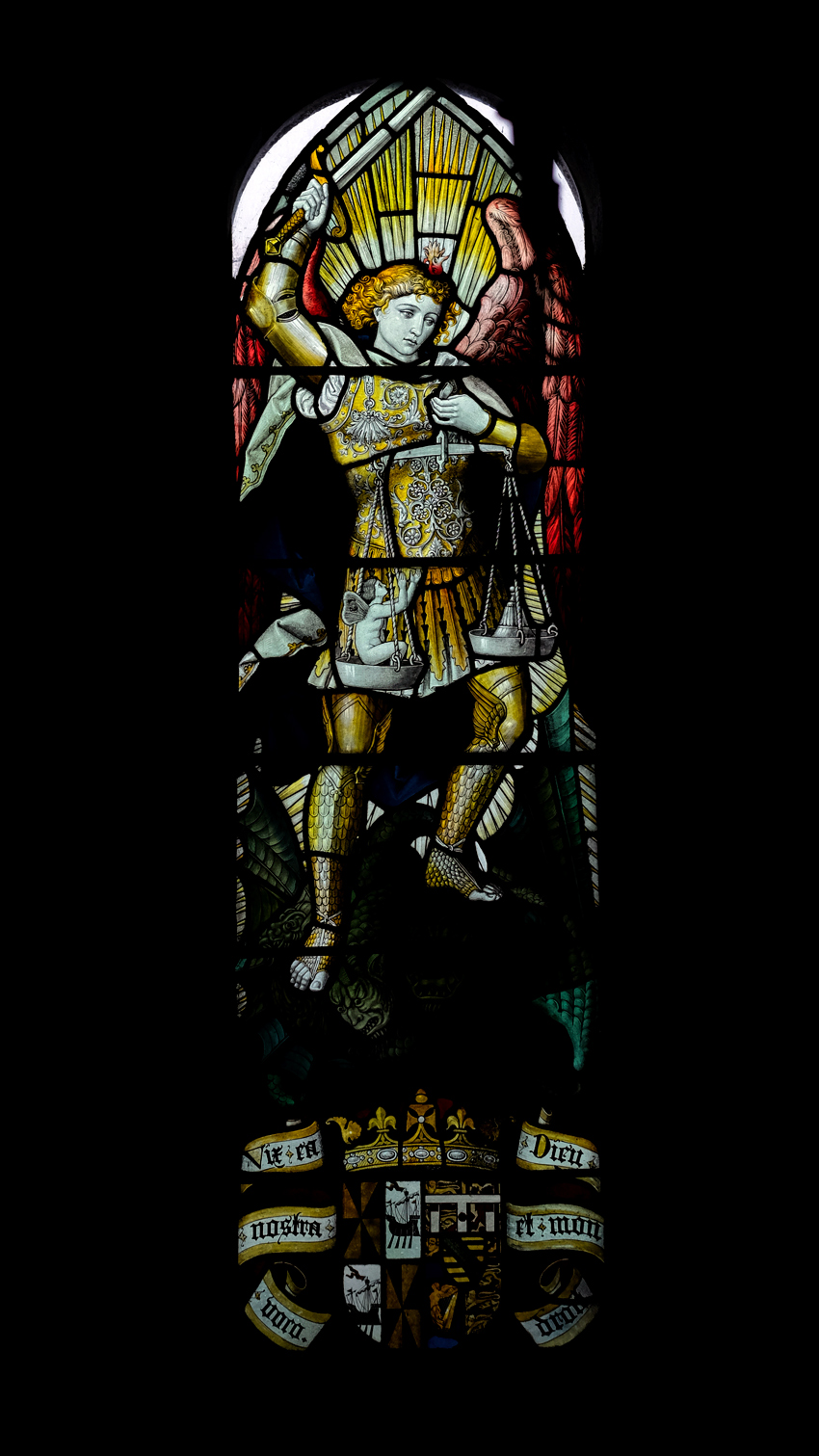 There was some fine stained glass there as well.
There was some fine stained glass there as well.
 A very stylized effect.
A very stylized effect.
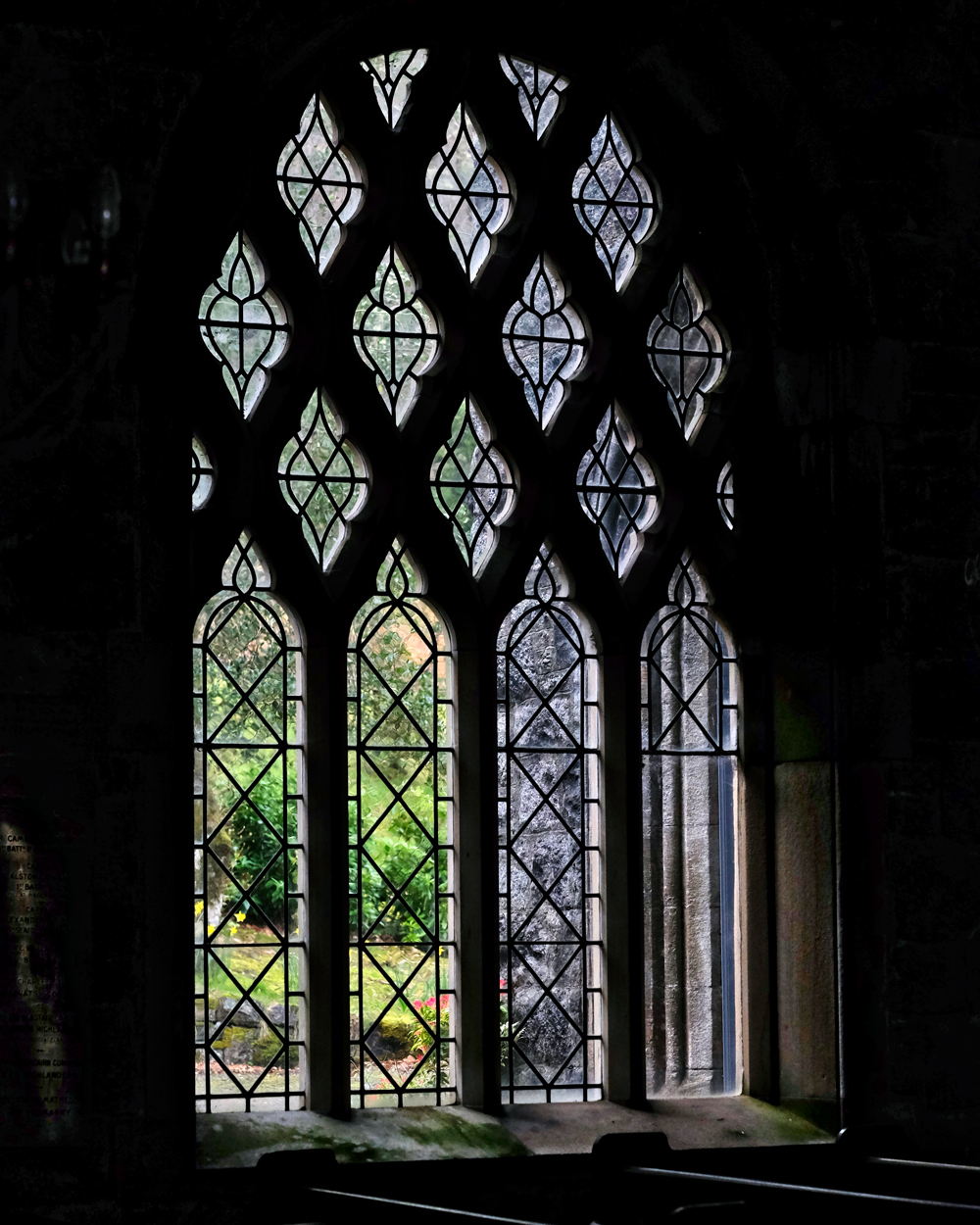 A wonderful window to the world . . .
A wonderful window to the world . . .
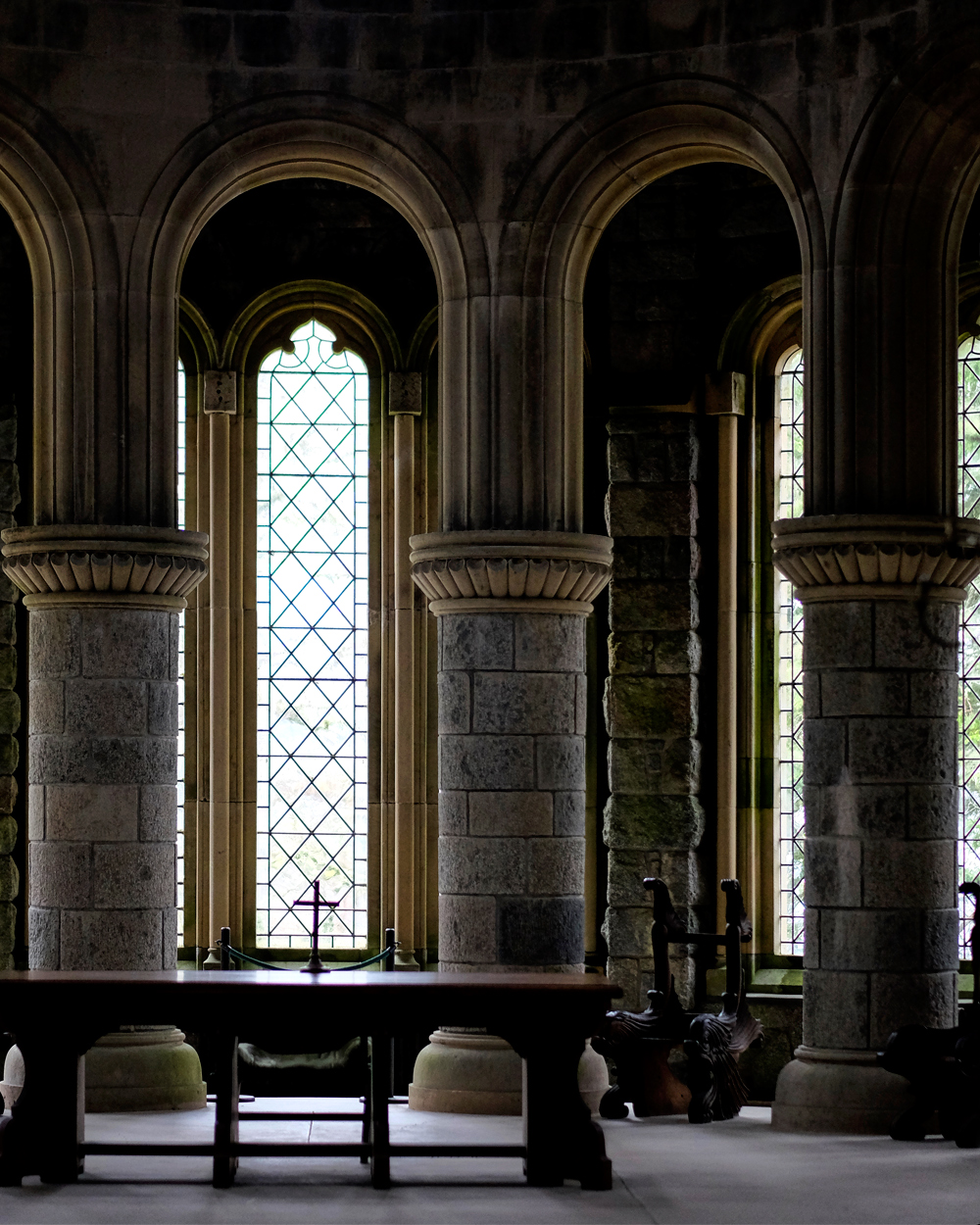 Simple, straightforward furniture.
Simple, straightforward furniture.
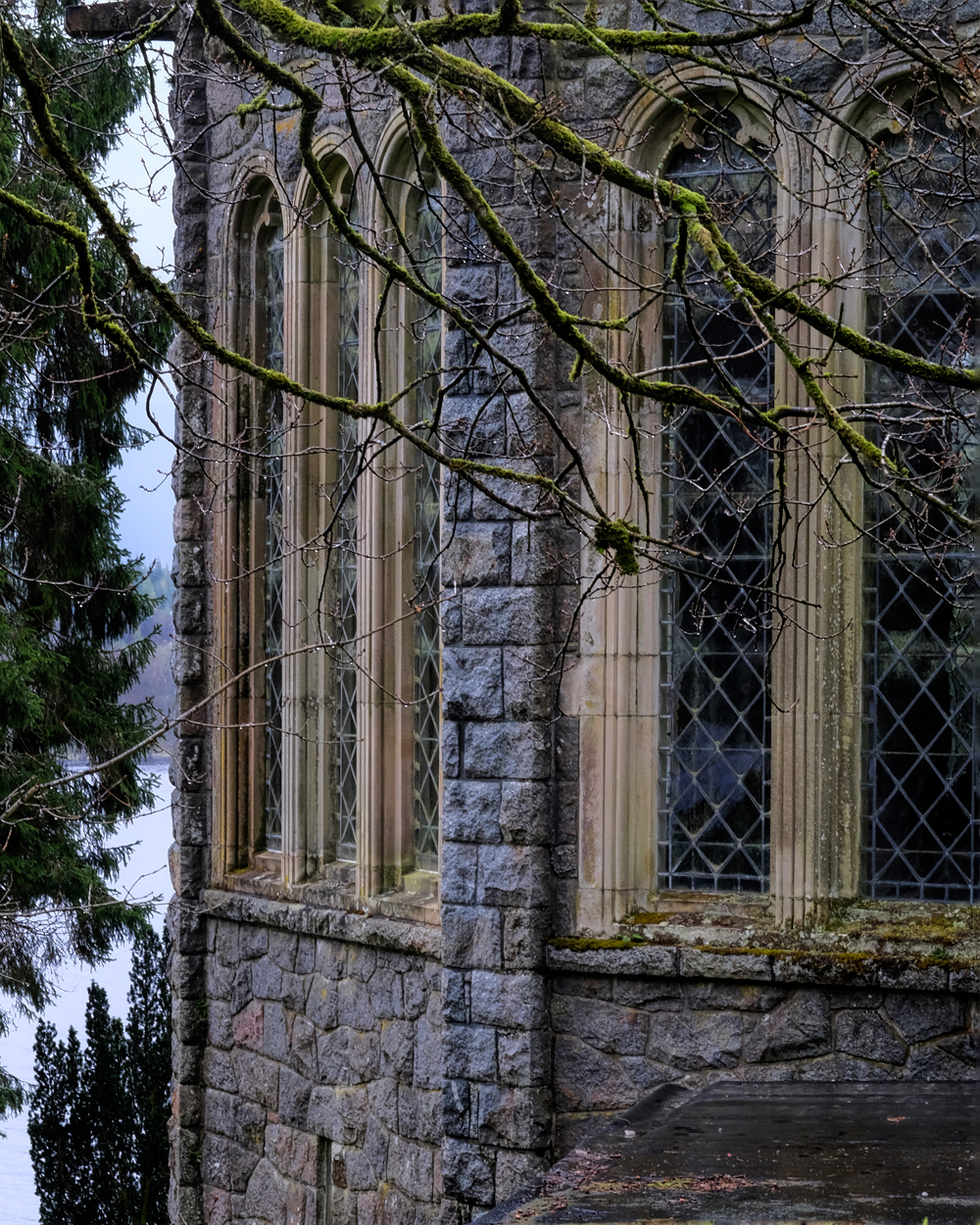 Saint Conan's Kirke.
Saint Conan's Kirke.
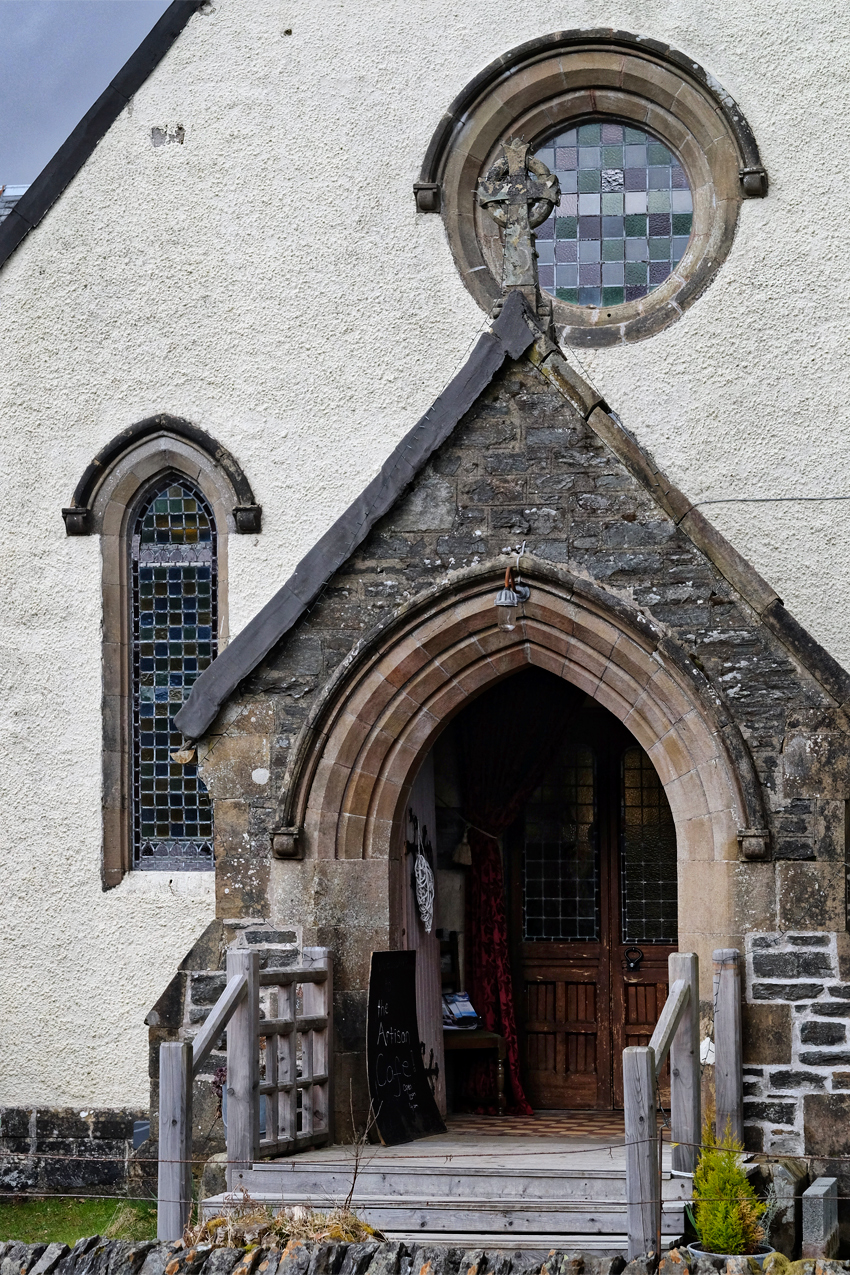 Not all churches are churches. This old rural church has been converted to a cafe . . . we stopped for coffee, tea and, of curse, scones.
Not all churches are churches. This old rural church has been converted to a cafe . . . we stopped for coffee, tea and, of curse, scones.
 The cafe retained many original features of the church.
The cafe retained many original features of the church.
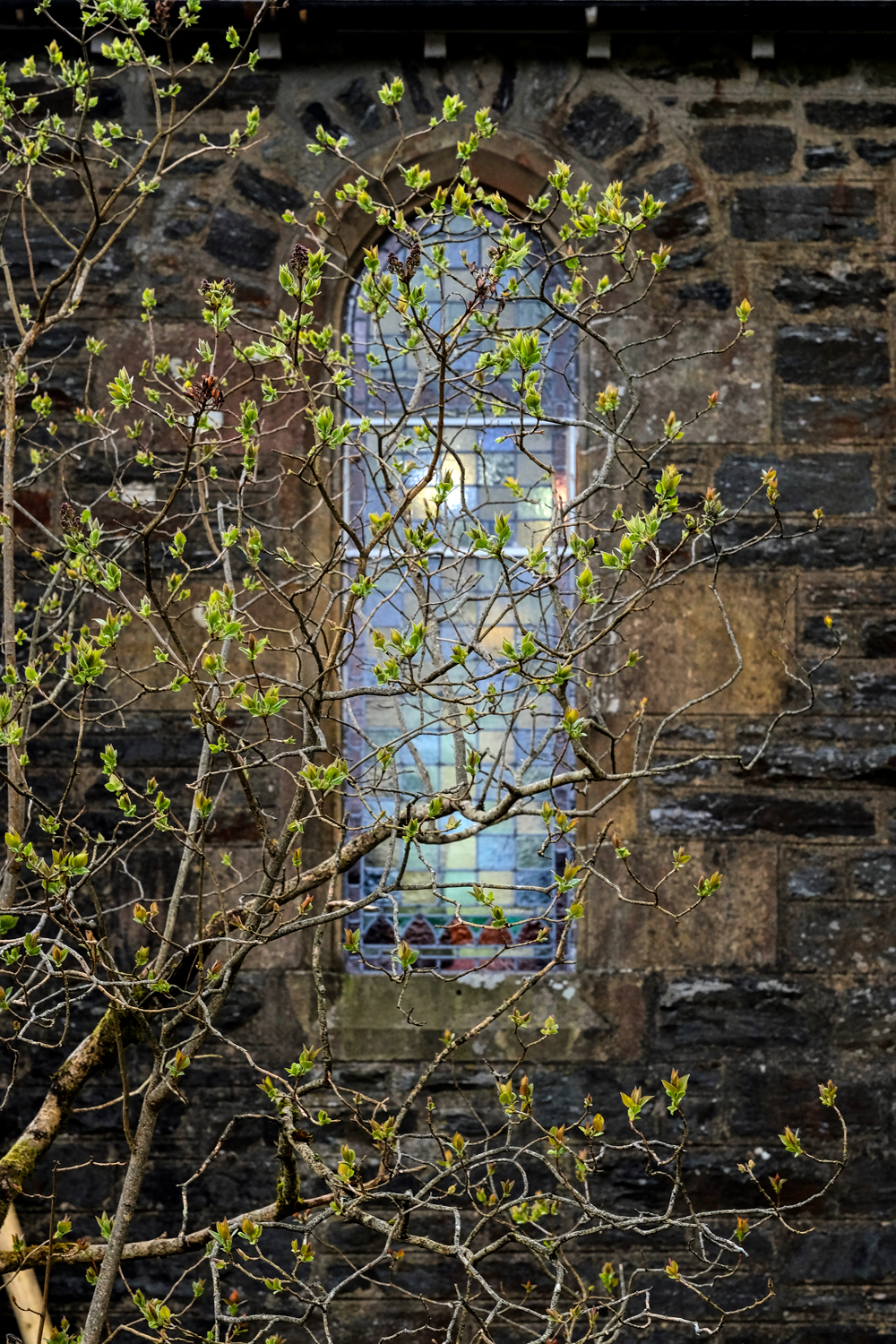 The very beginning of Spring . . . and the first buds.
The very beginning of Spring . . . and the first buds.
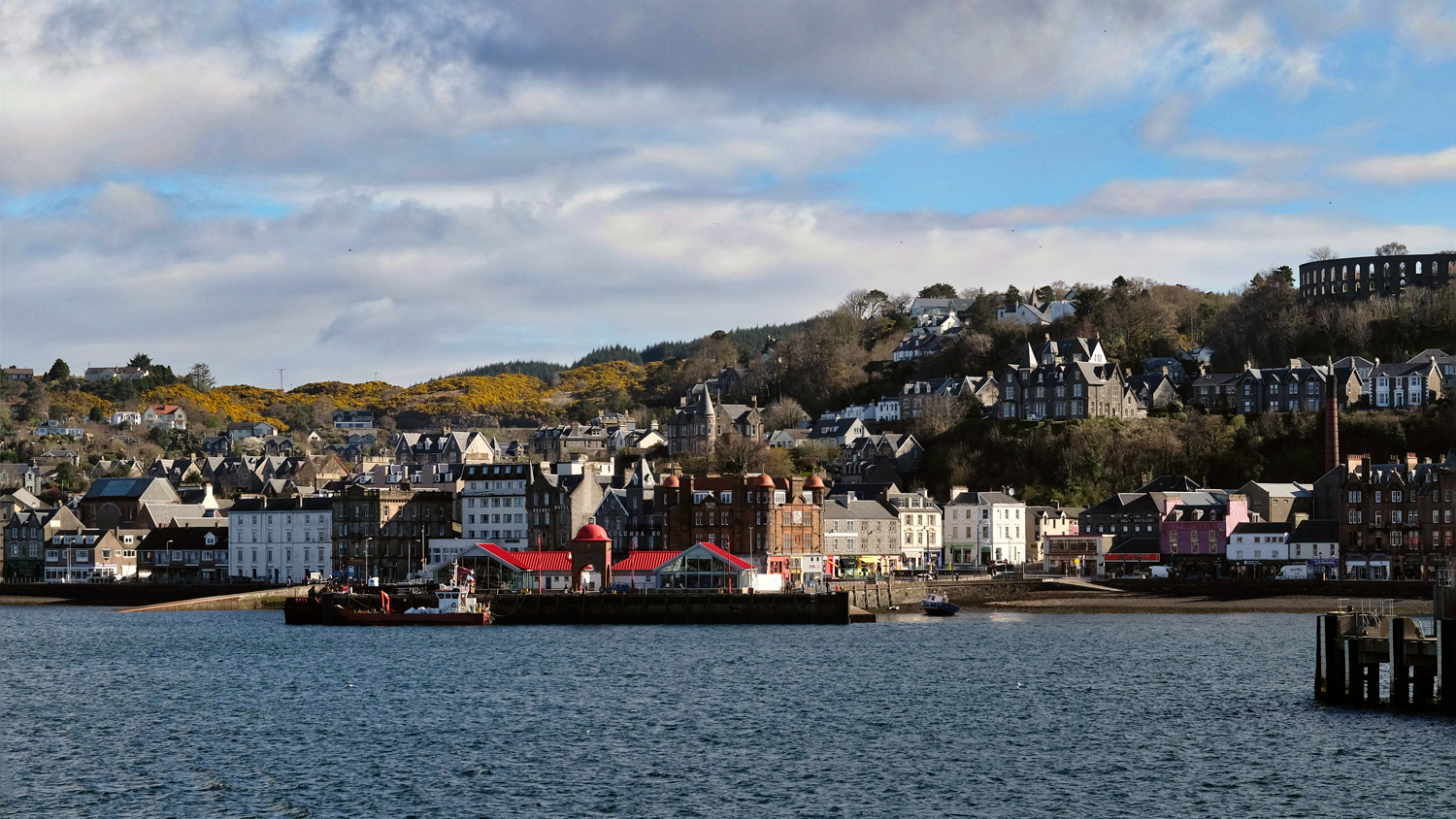 We arrived in the old harbour town of Oban. It is a favorite place of ours to visit, not just because of the ferries we have taken from here, but because our favorite restaurant to have fresh oysters is there (front and center on the dock with the bright red roof). "The best oysters in the world" - my wife says.
We arrived in the old harbour town of Oban. It is a favorite place of ours to visit, not just because of the ferries we have taken from here, but because our favorite restaurant to have fresh oysters is there (front and center on the dock with the bright red roof). "The best oysters in the world" - my wife says.
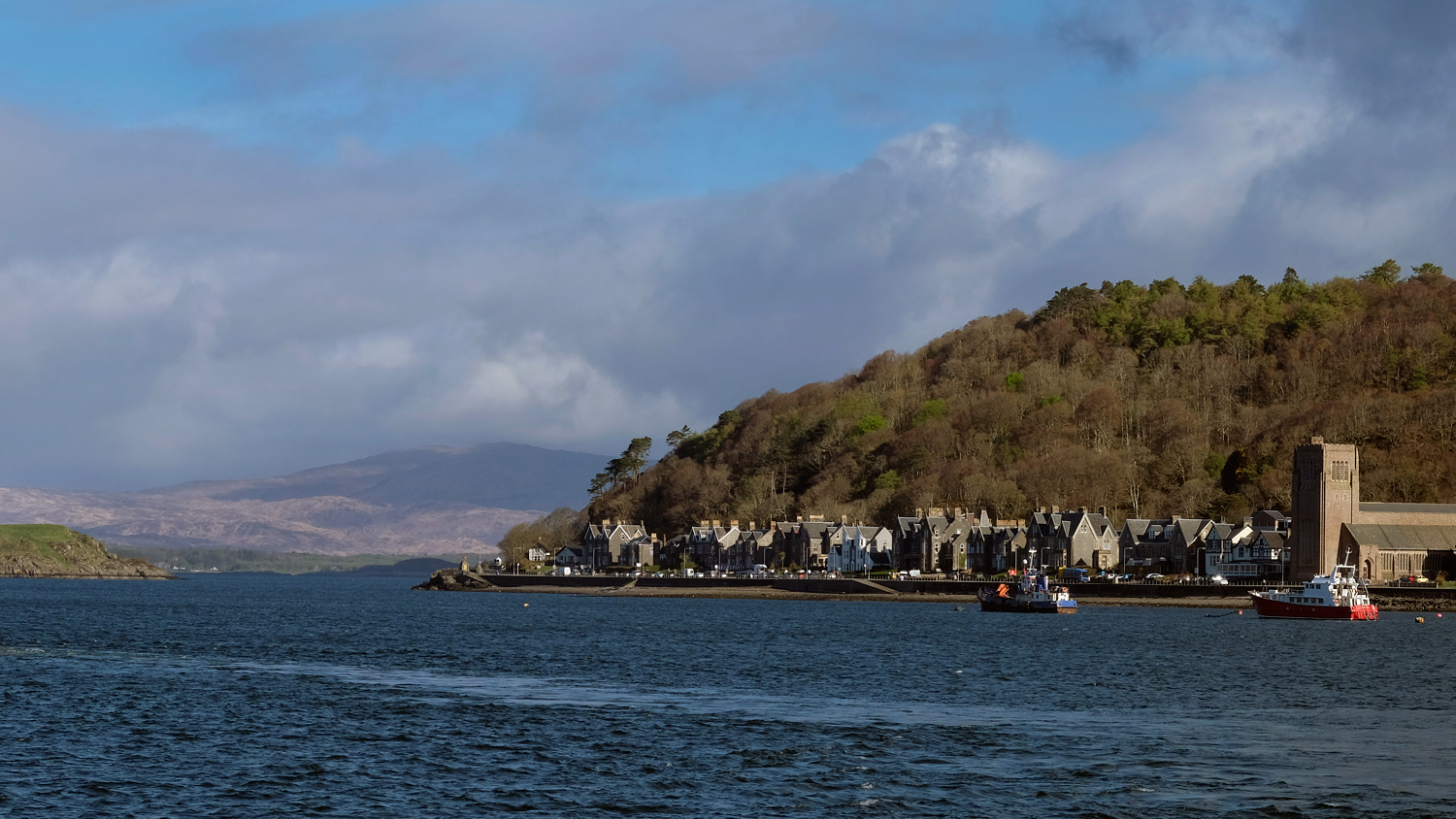 We checked into a nicely restored old seafront hotel (the only white one in the row of guesthouses and B&Bs).
We checked into a nicely restored old seafront hotel (the only white one in the row of guesthouses and B&Bs).
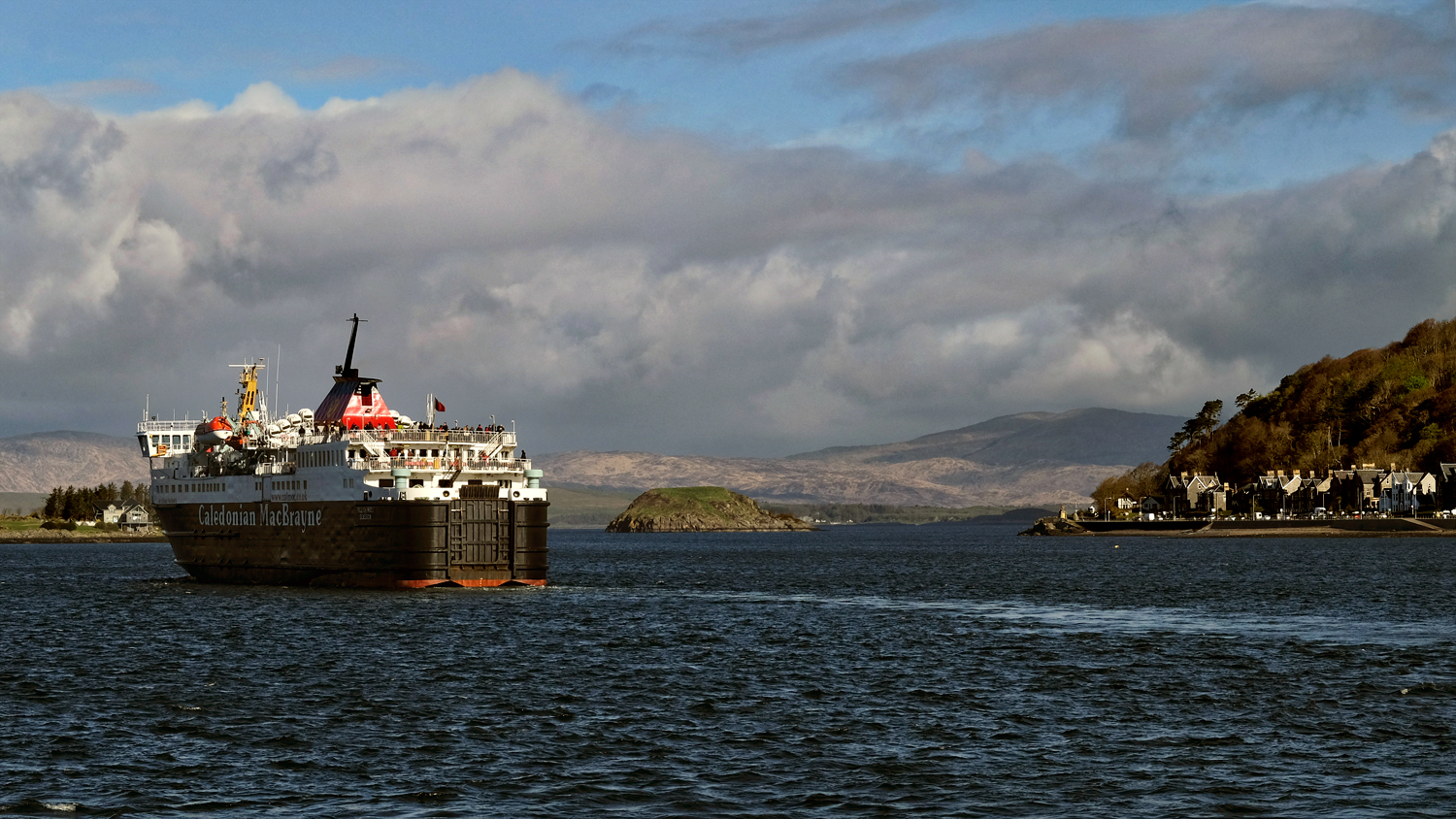 Ferry service to many of the western isles of Scotland originate from Oban.
Ferry service to many of the western isles of Scotland originate from Oban.
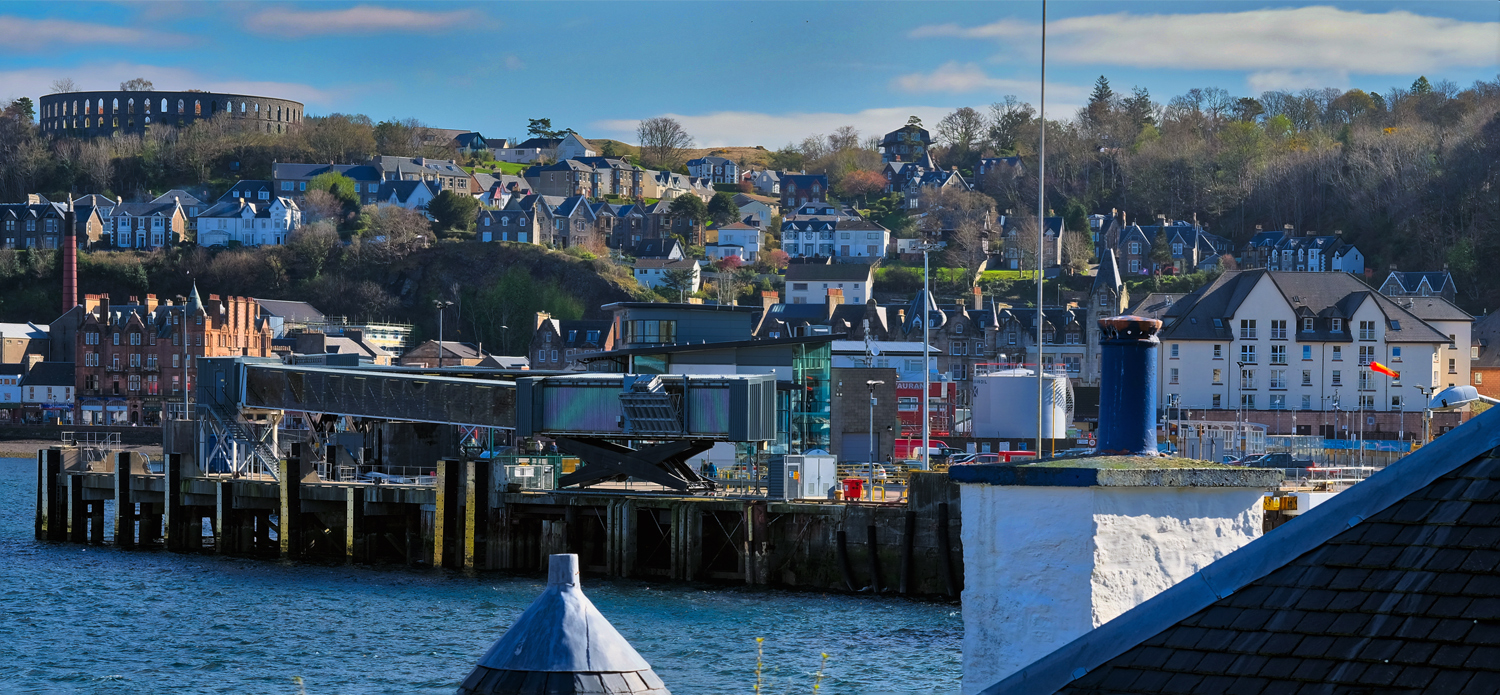 The Oban Ferry Terminal (foreground) where we departed for the Isle of Mull. That is a fake ruin on the horizon, a folly, built in Victorian times when ancient ruins were fashionable to have in your city.
The Oban Ferry Terminal (foreground) where we departed for the Isle of Mull. That is a fake ruin on the horizon, a folly, built in Victorian times when ancient ruins were fashionable to have in your city.
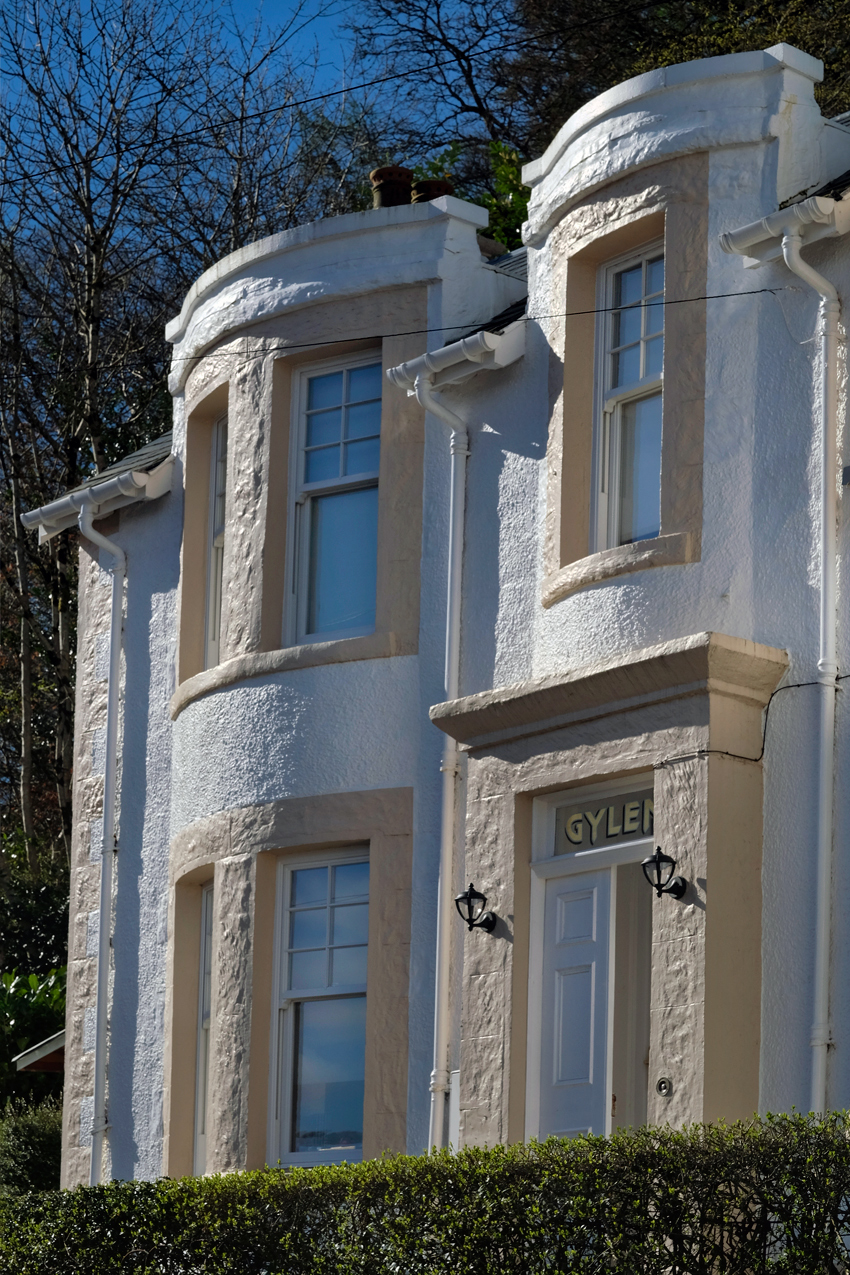 Oban has some fine old architecture. Here, Gaylen House.
Oban has some fine old architecture. Here, Gaylen House.
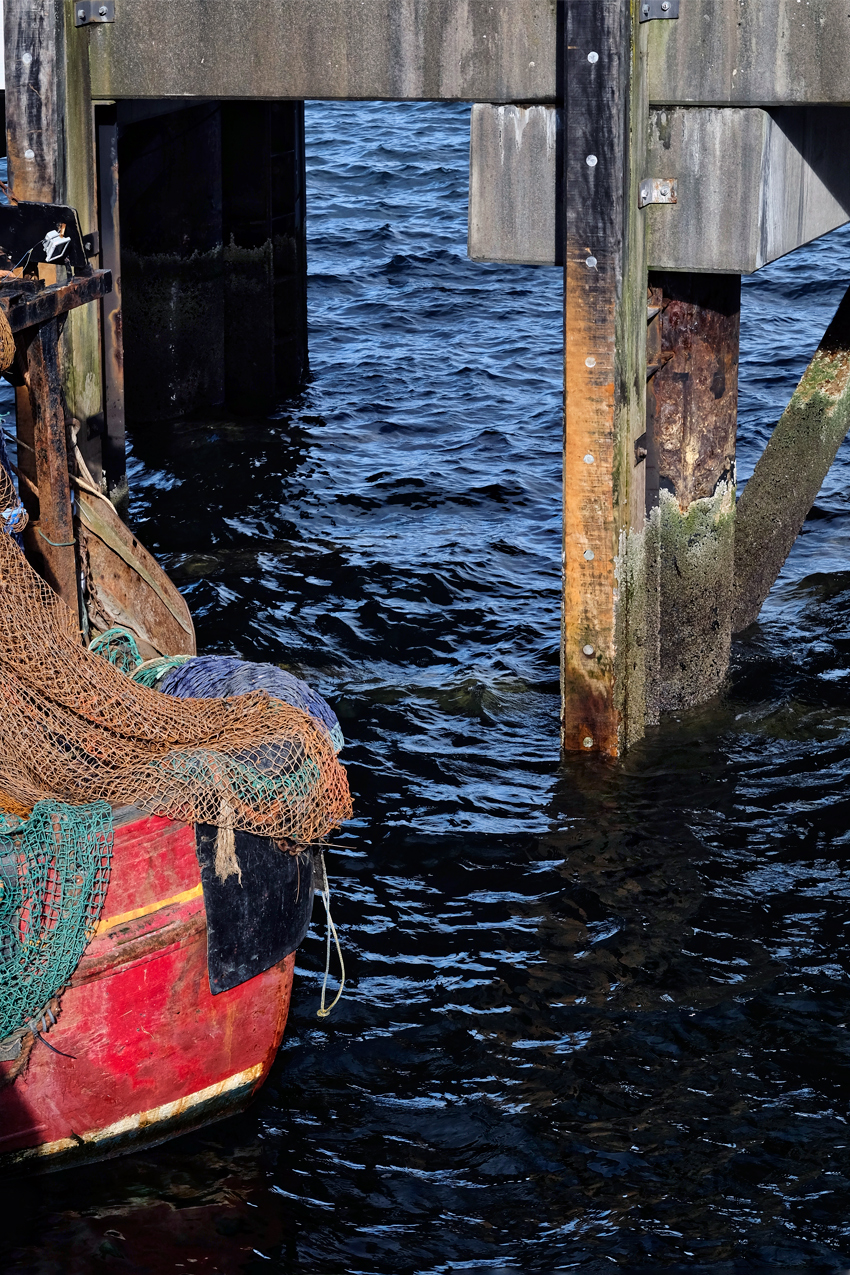 Down along the pier, Oban harbour.
Down along the pier, Oban harbour.
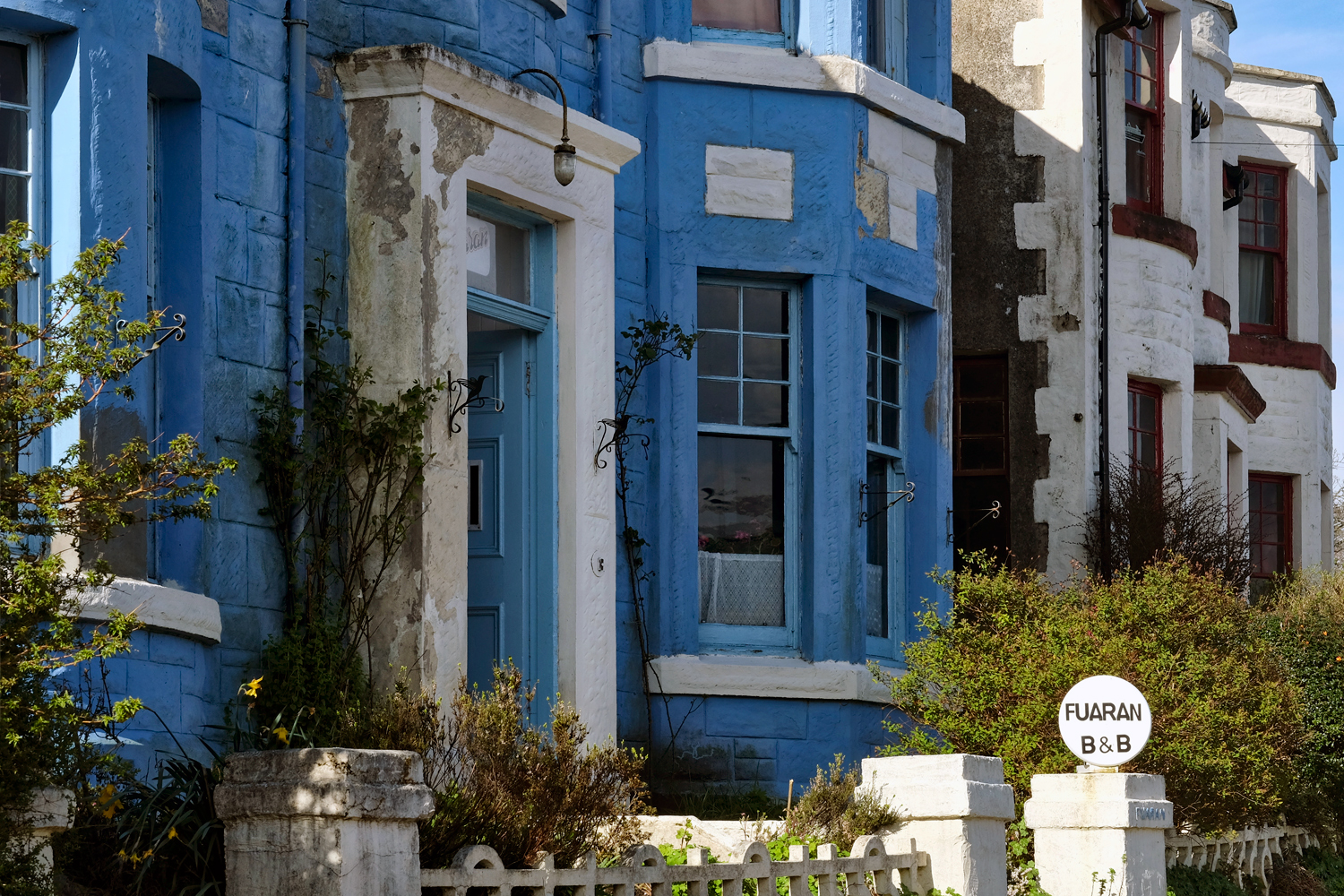 A row of old Oban harbour side B&Bs.
A row of old Oban harbour side B&Bs.
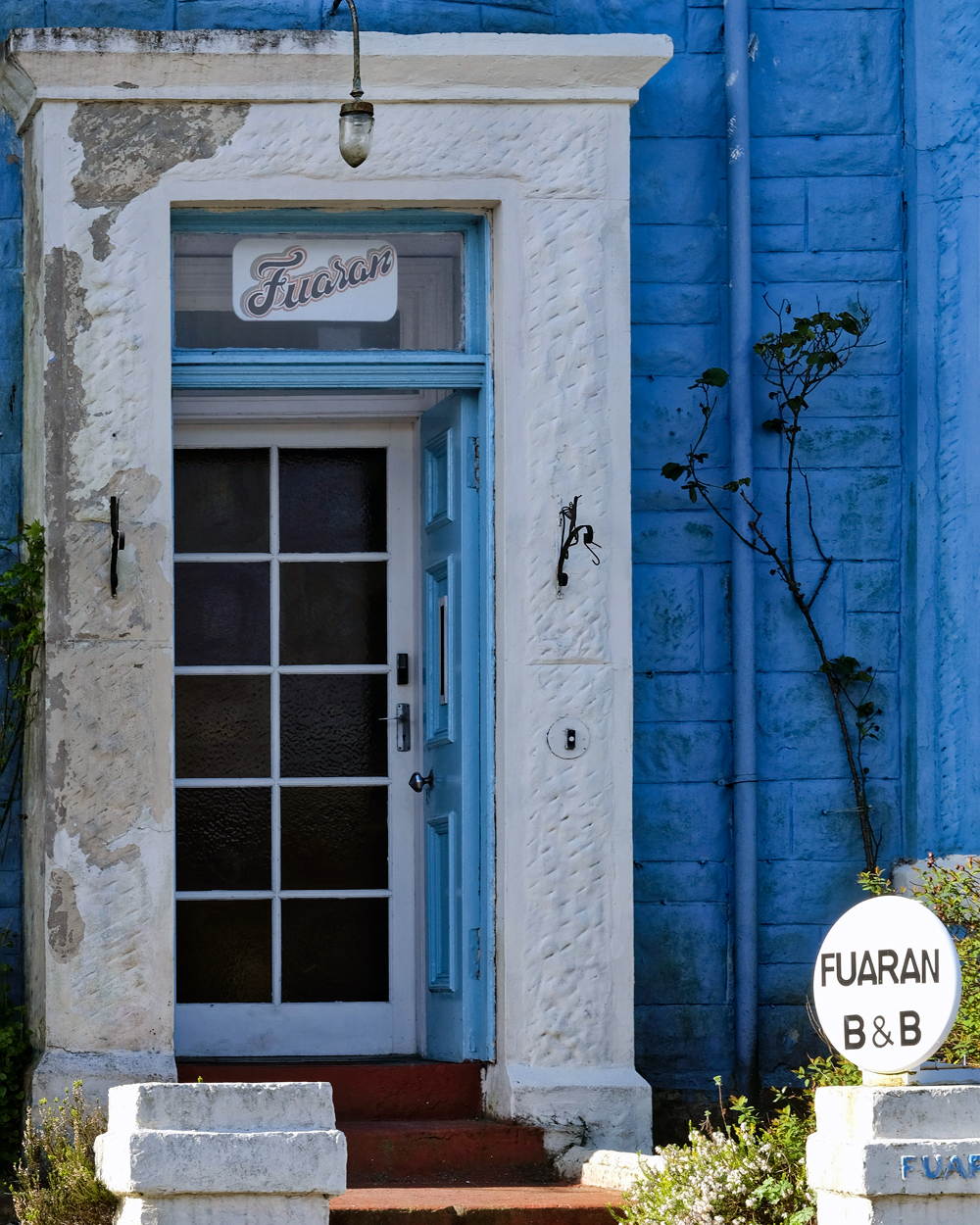 Quaint, weathered, old world charm.
Quaint, weathered, old world charm.
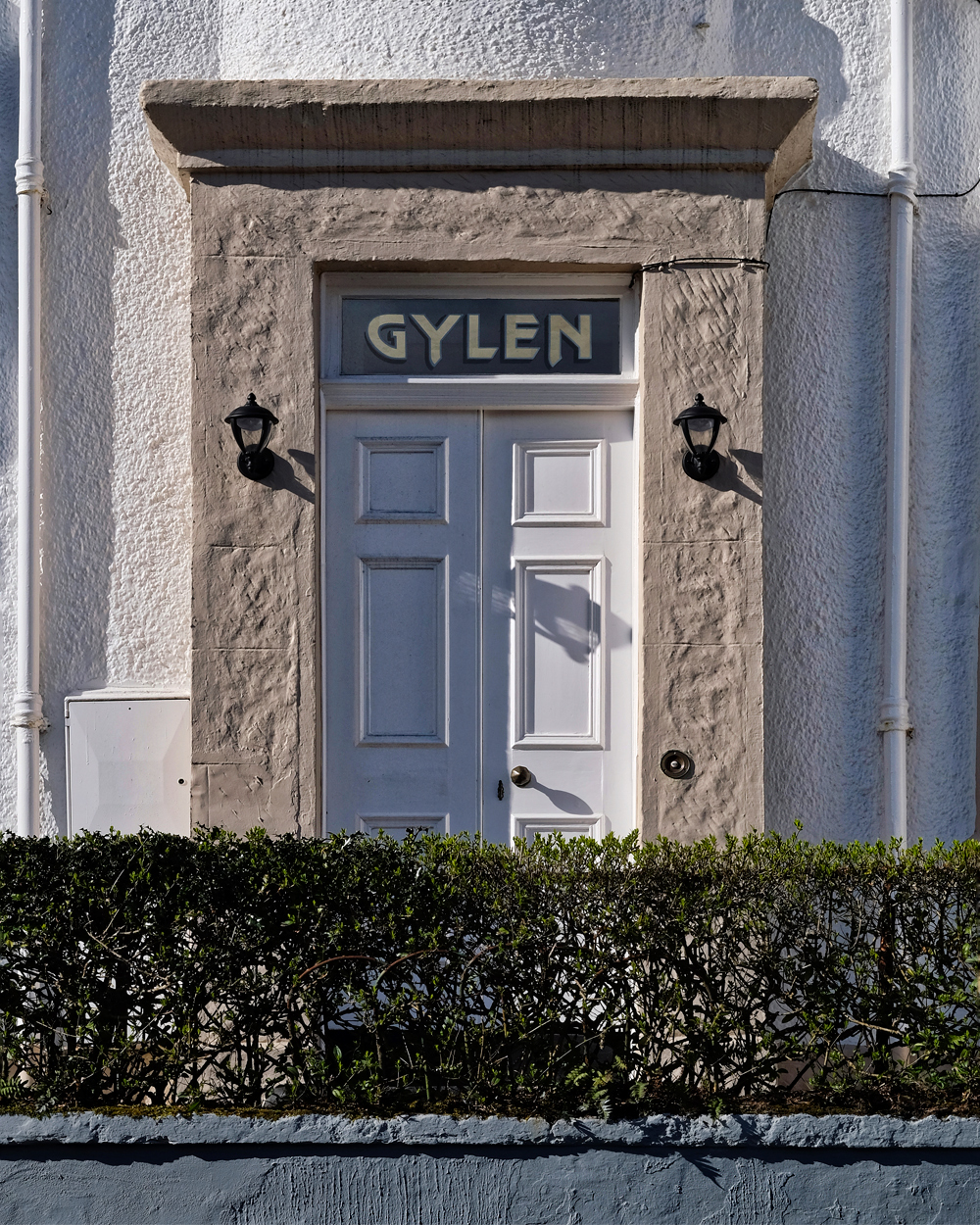 Weathered charm.
Weathered charm.
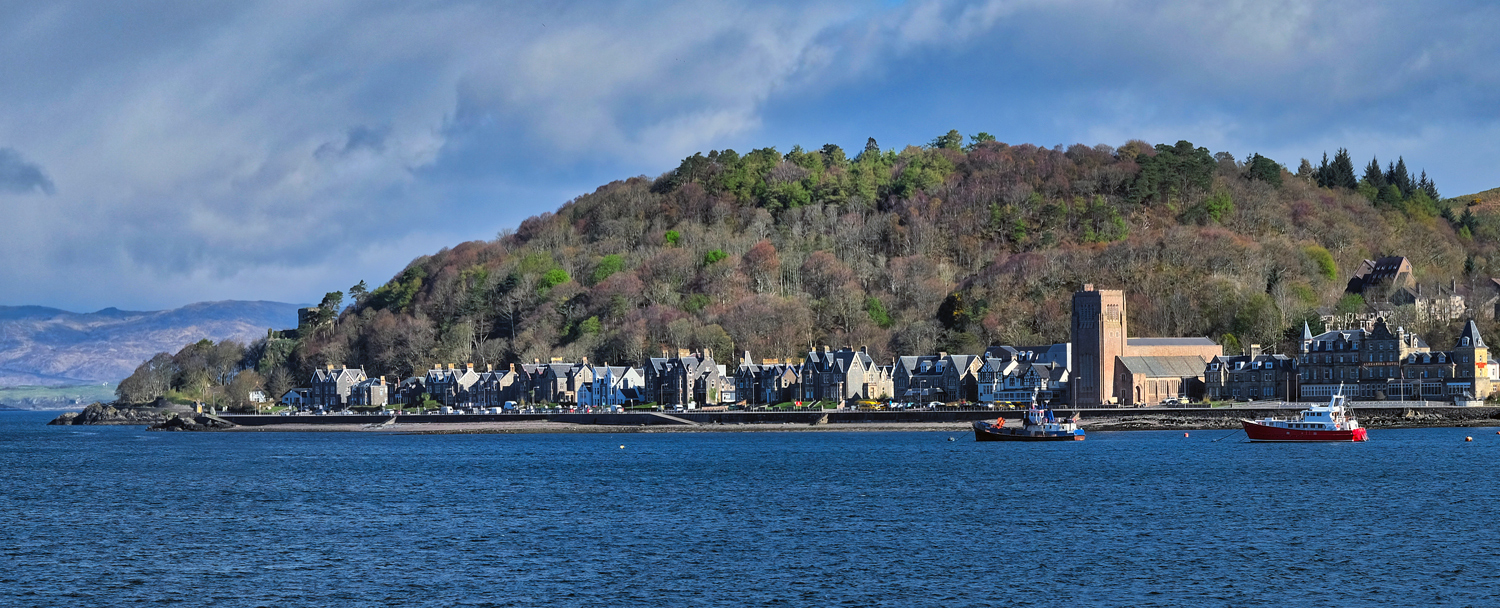 But Oban was just a stopover . . . our destination was across the water . . . the Isle of Mull.
But Oban was just a stopover . . . our destination was across the water . . . the Isle of Mull.
 The ferry that took us to the Isle of Mull as it arrived in Oban.
The ferry that took us to the Isle of Mull as it arrived in Oban.
 The views from the windy deck of the ferry were breathtaking!
The views from the windy deck of the ferry were breathtaking!
 The rugged hills of the Isle of Mull.
The rugged hills of the Isle of Mull.
 The Isle of Mull in a nutshell . . . a sea economy and culture.
The Isle of Mull in a nutshell . . . a sea economy and culture.
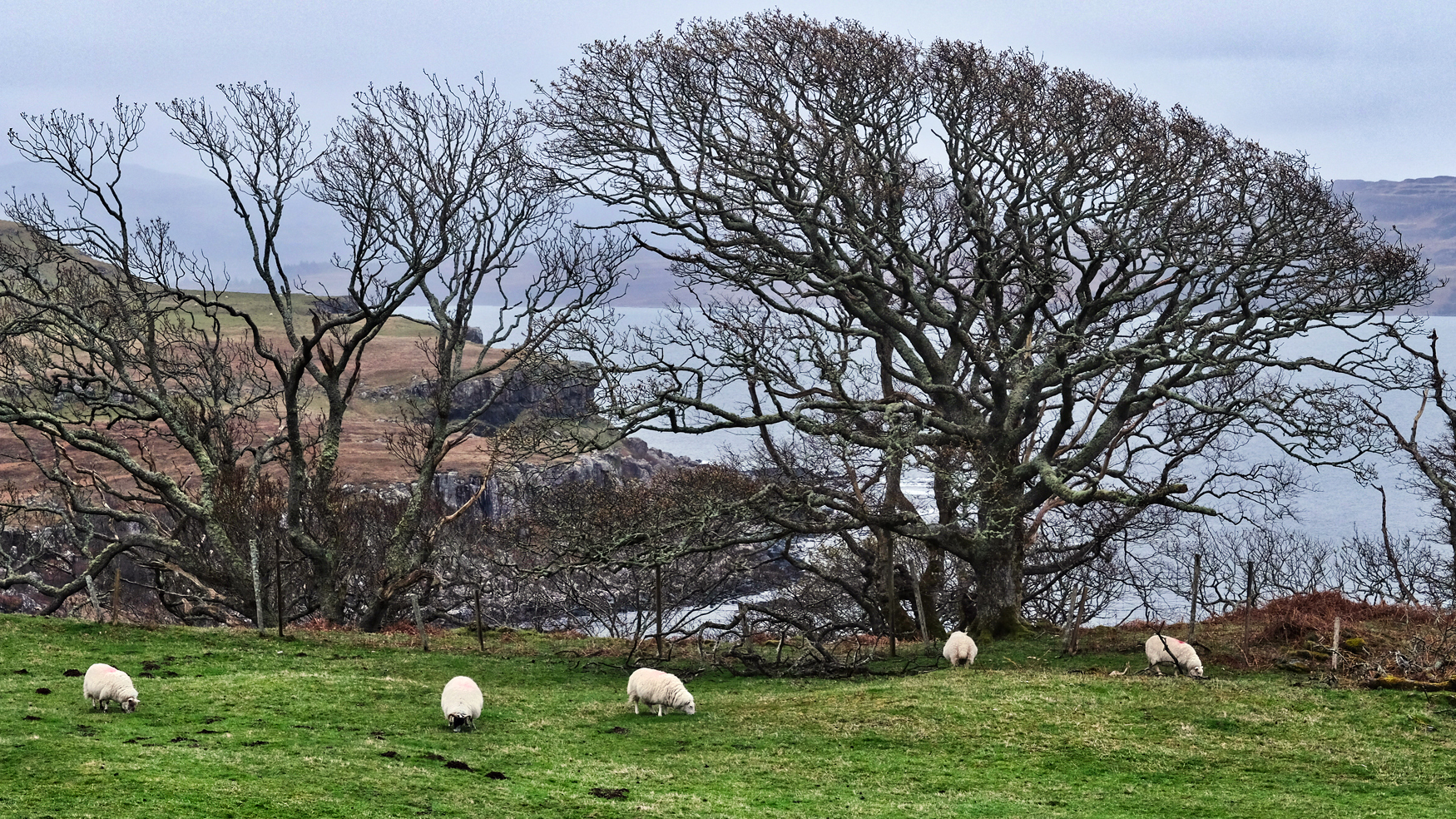 Friends and family visiting from Thailand means an opportunity for a road trip somewhere I have never been. The Isle of Mull, and it's atmospheric and moody landscapes and quaint seaside villages beckoned . . .
Friends and family visiting from Thailand means an opportunity for a road trip somewhere I have never been. The Isle of Mull, and it's atmospheric and moody landscapes and quaint seaside villages beckoned . . .
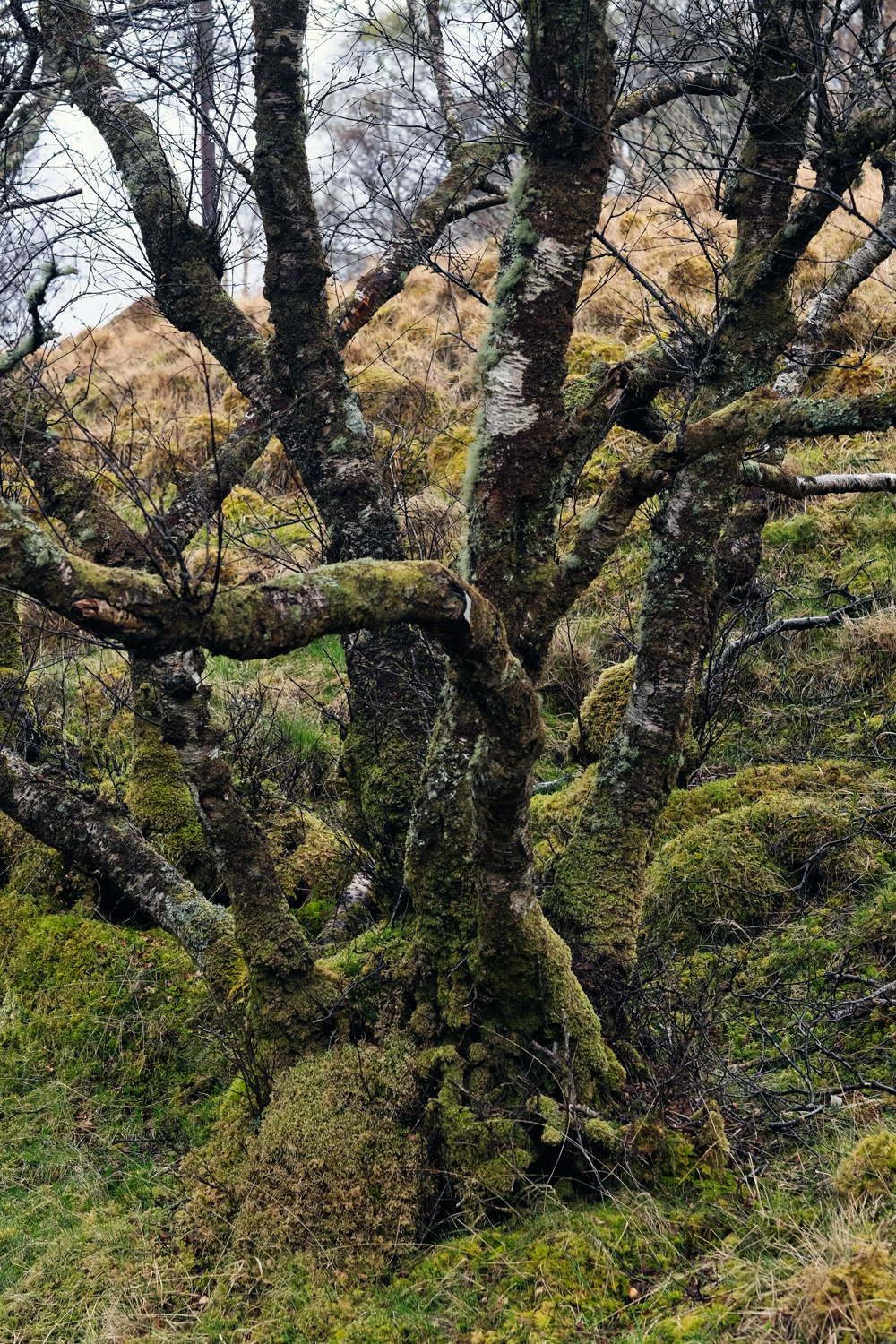 The west coast of the Isle of Mull is wet, wet, wet.
The west coast of the Isle of Mull is wet, wet, wet.
 Thick, wet moss of the west coast.
Thick, wet moss of the west coast.
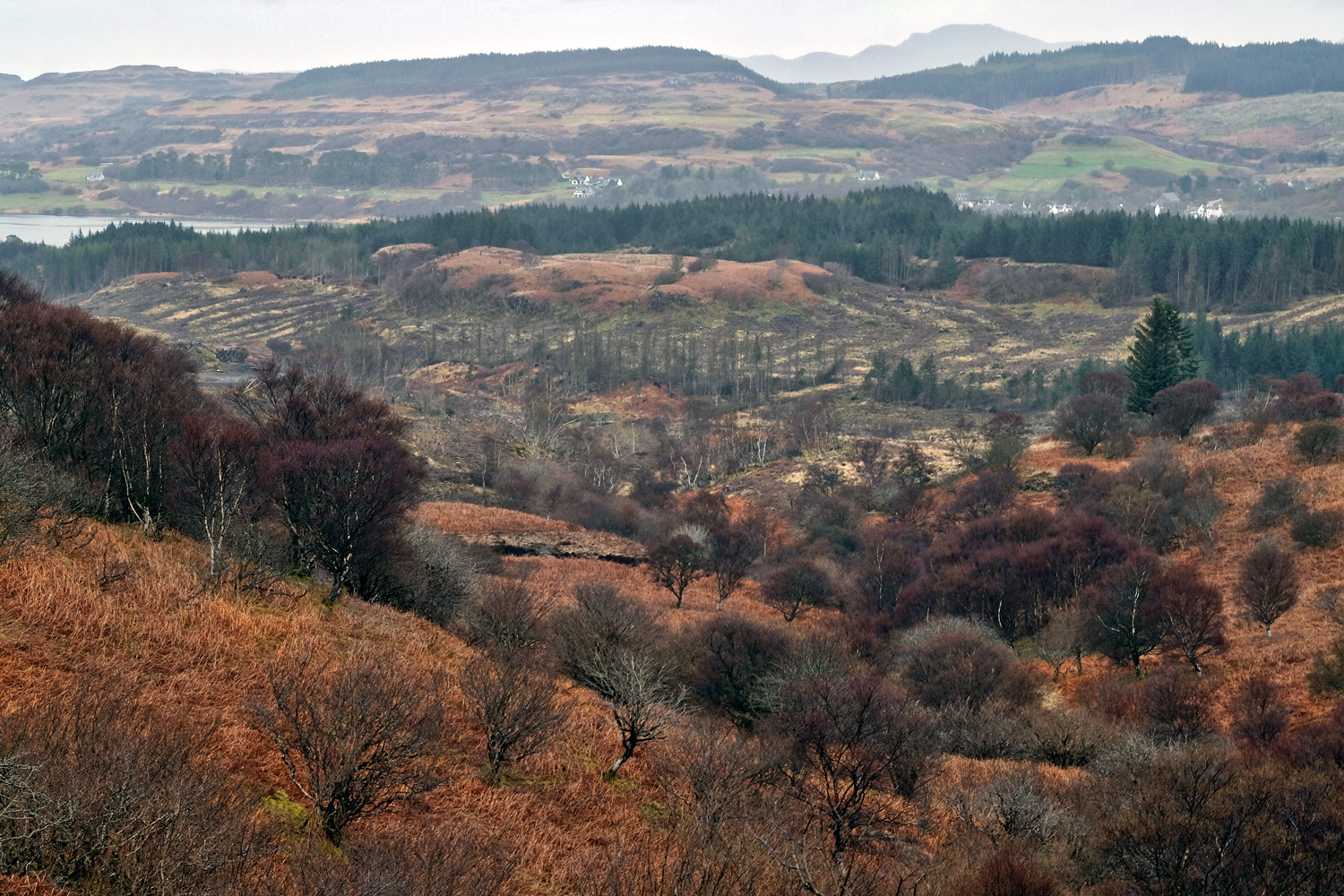 Early April 2017 . . . always very damp Isle of Mull. The dampness on a cloudy day certainly brings out the color of the decomposing autumn foliage. A view from a hill.
Early April 2017 . . . always very damp Isle of Mull. The dampness on a cloudy day certainly brings out the color of the decomposing autumn foliage. A view from a hill.
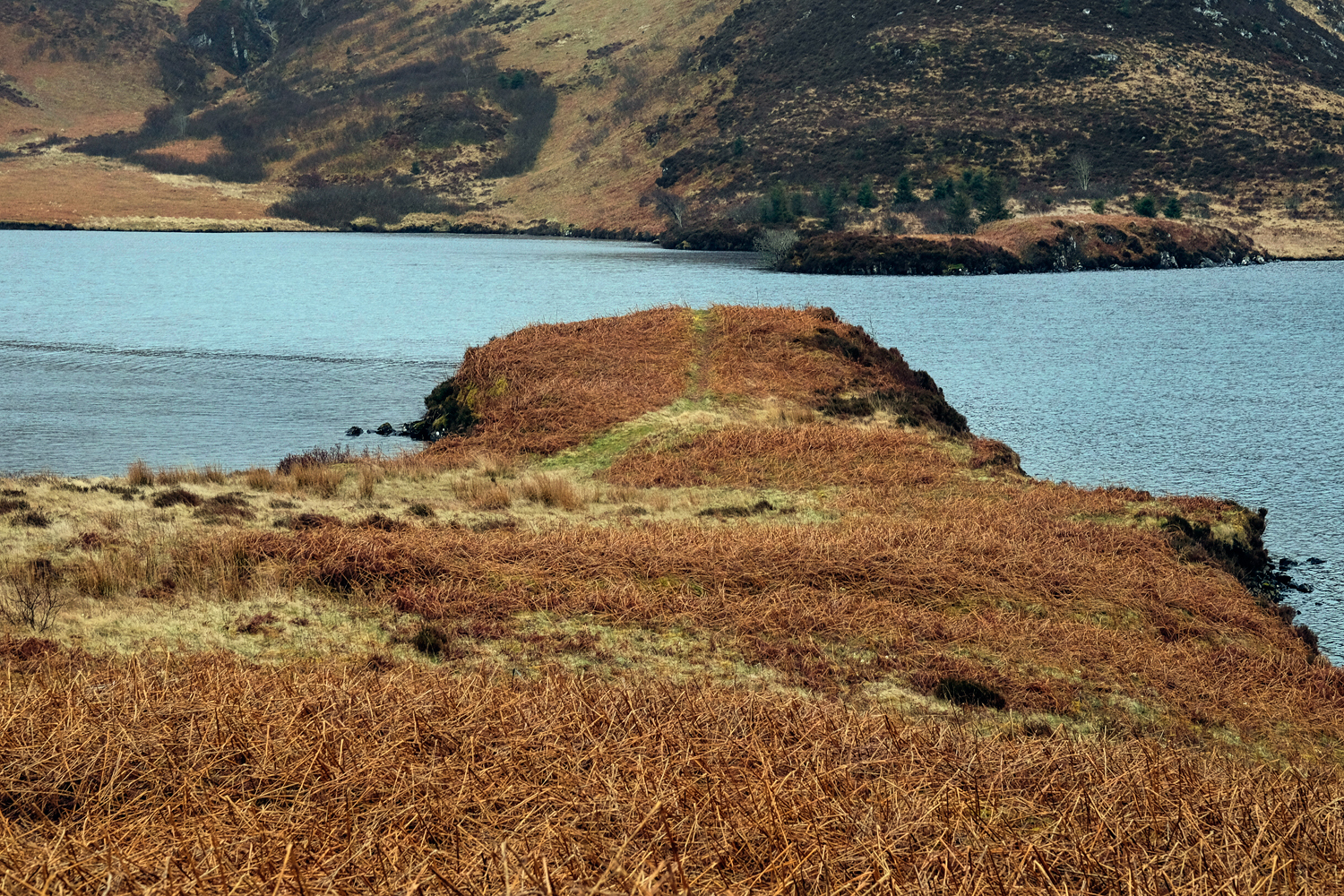 The sea invades the land around the whole of the Isle of Mull.
The sea invades the land around the whole of the Isle of Mull.
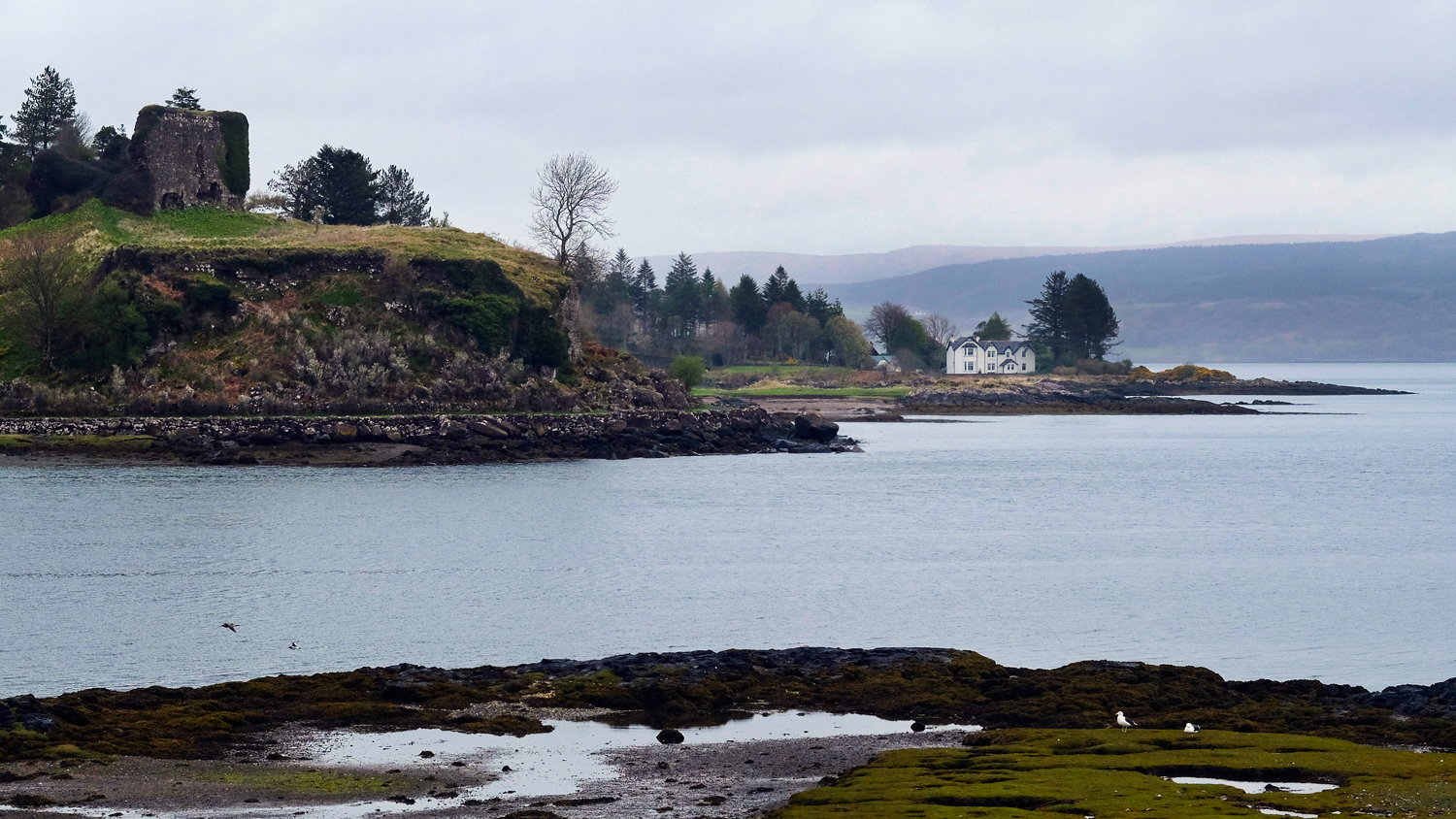 When we saw a castle ruin we would stop for photos.
When we saw a castle ruin we would stop for photos.
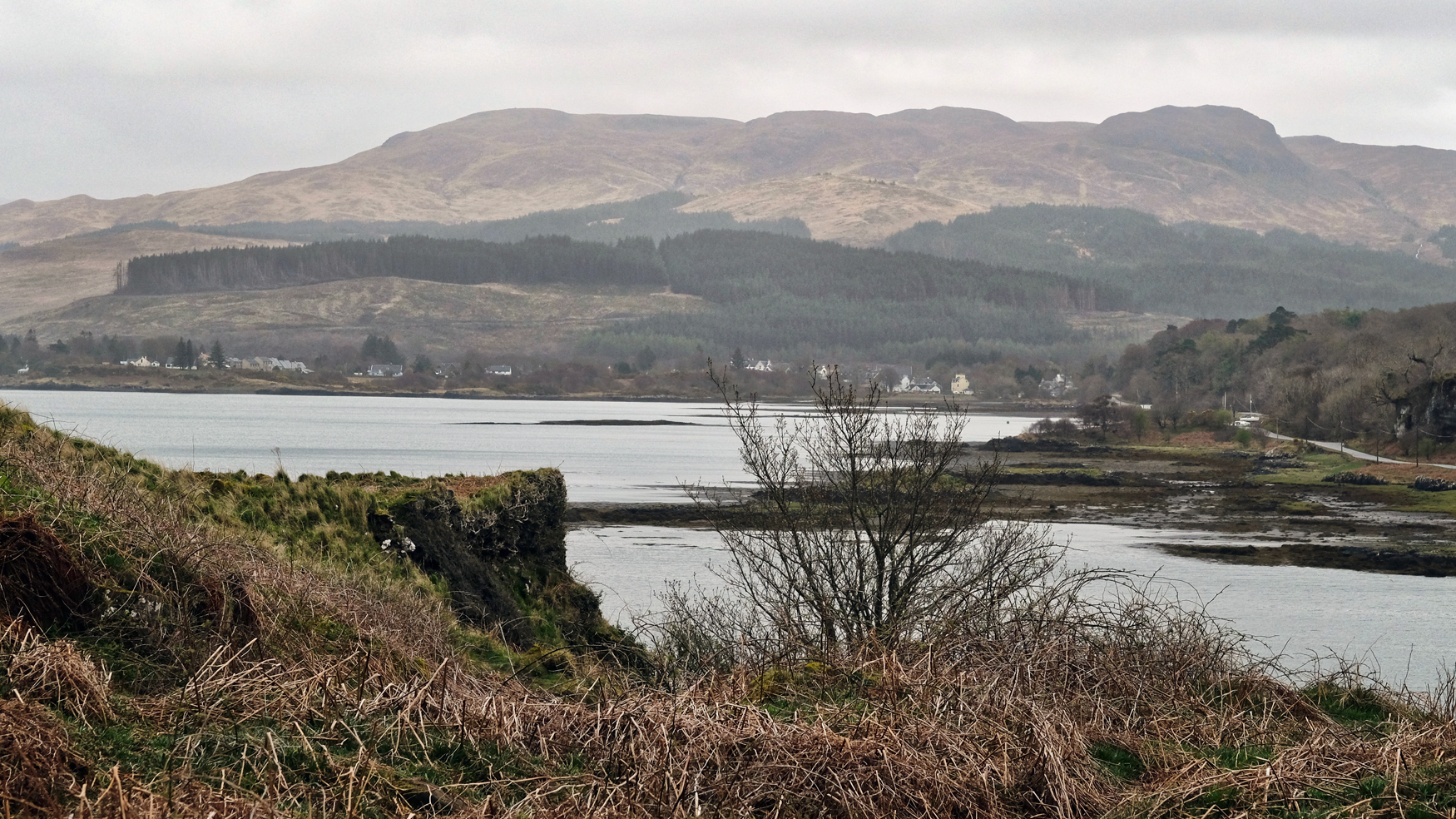 We stopped often and walked out to points of interest and to gaze upon the fantastically moody vistas.
We stopped often and walked out to points of interest and to gaze upon the fantastically moody vistas.
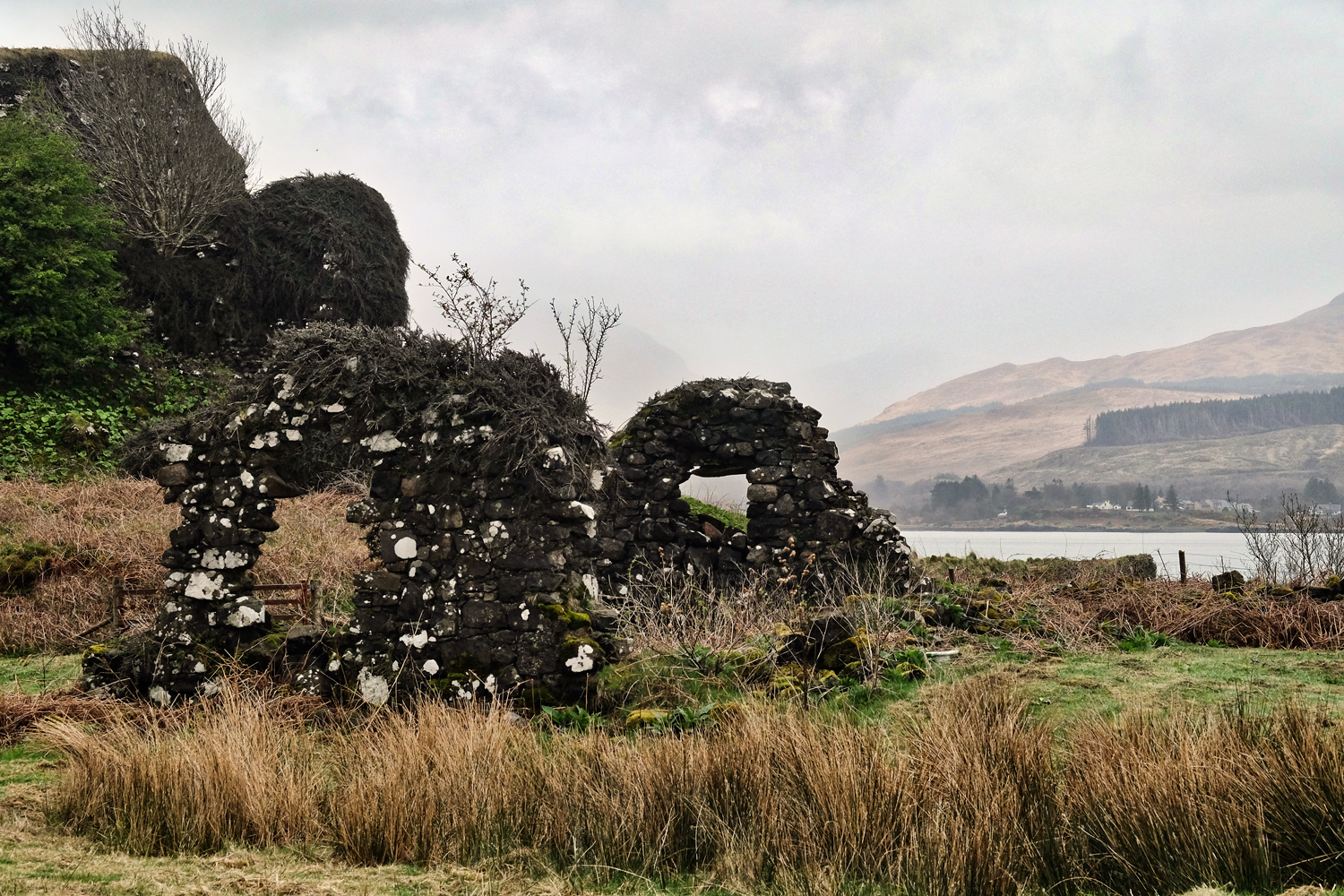 As is true for all of Scotland, there are always castle ruins to explore.
As is true for all of Scotland, there are always castle ruins to explore.
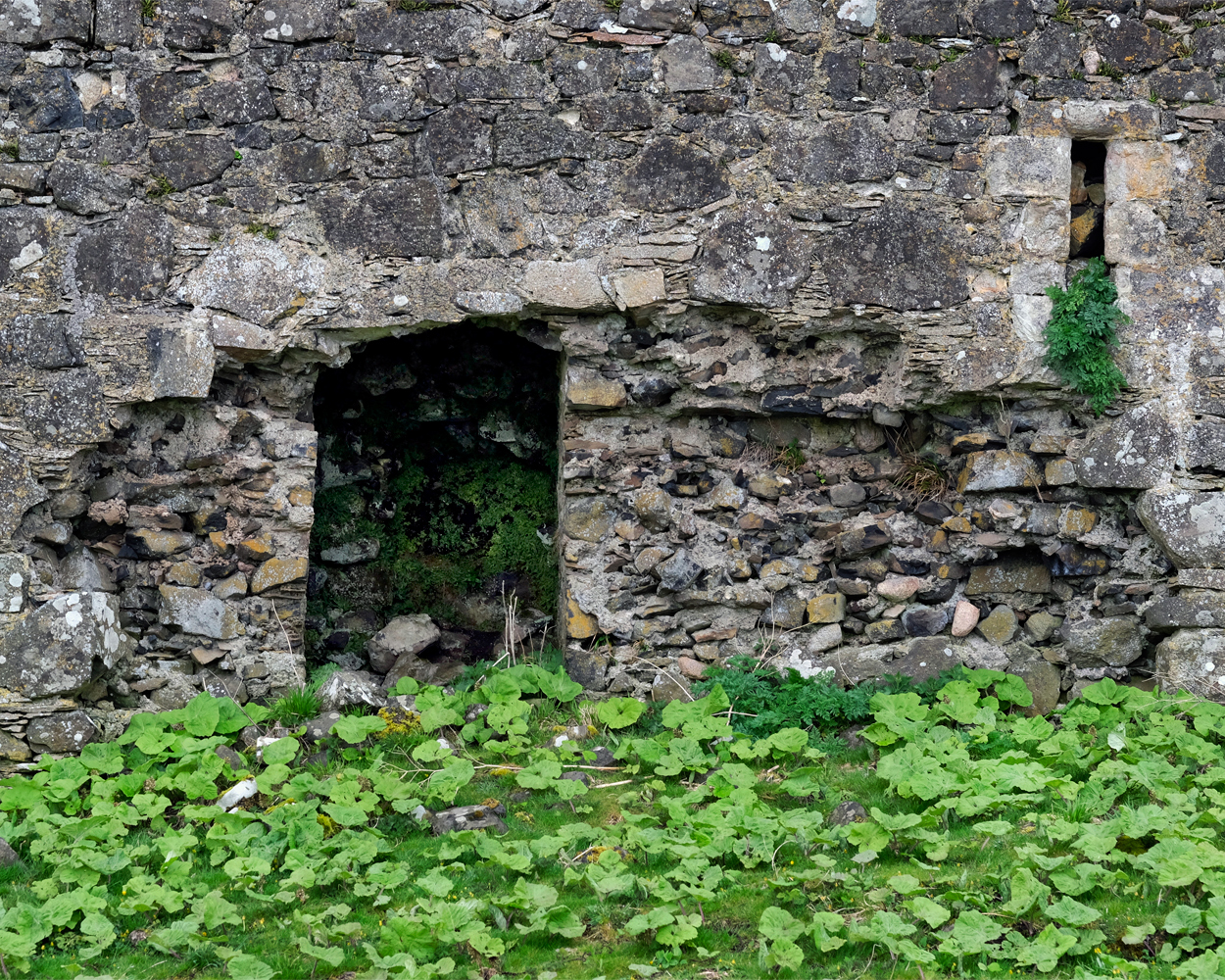 Castle ruins everywhere. These are the ruins of 14th century Aros Castle.
Castle ruins everywhere. These are the ruins of 14th century Aros Castle.
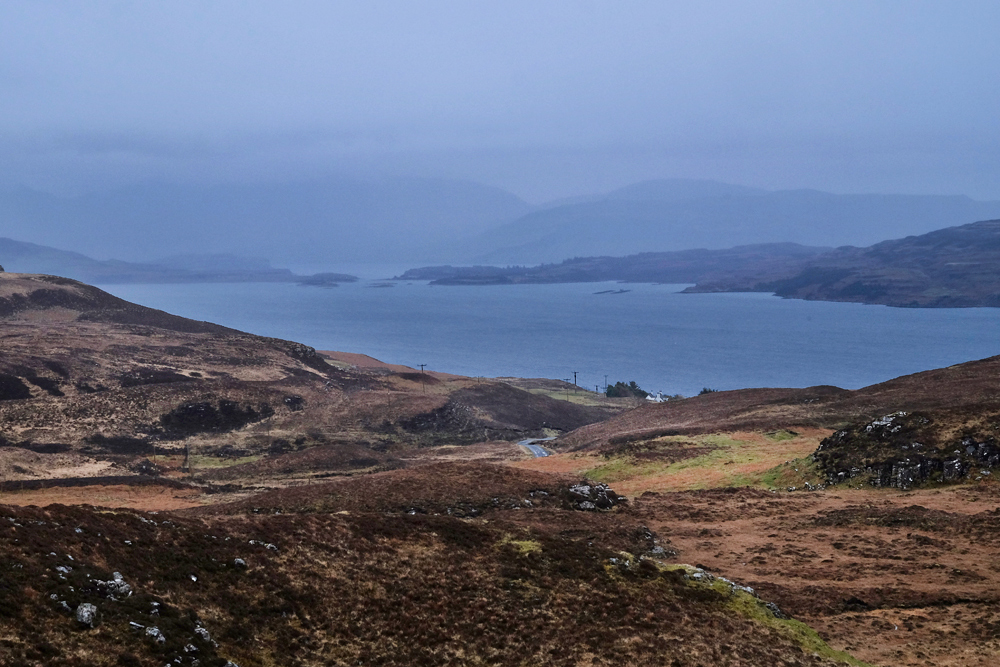 Isle of Mull always presents a strange, otherworldly view.
Isle of Mull always presents a strange, otherworldly view.
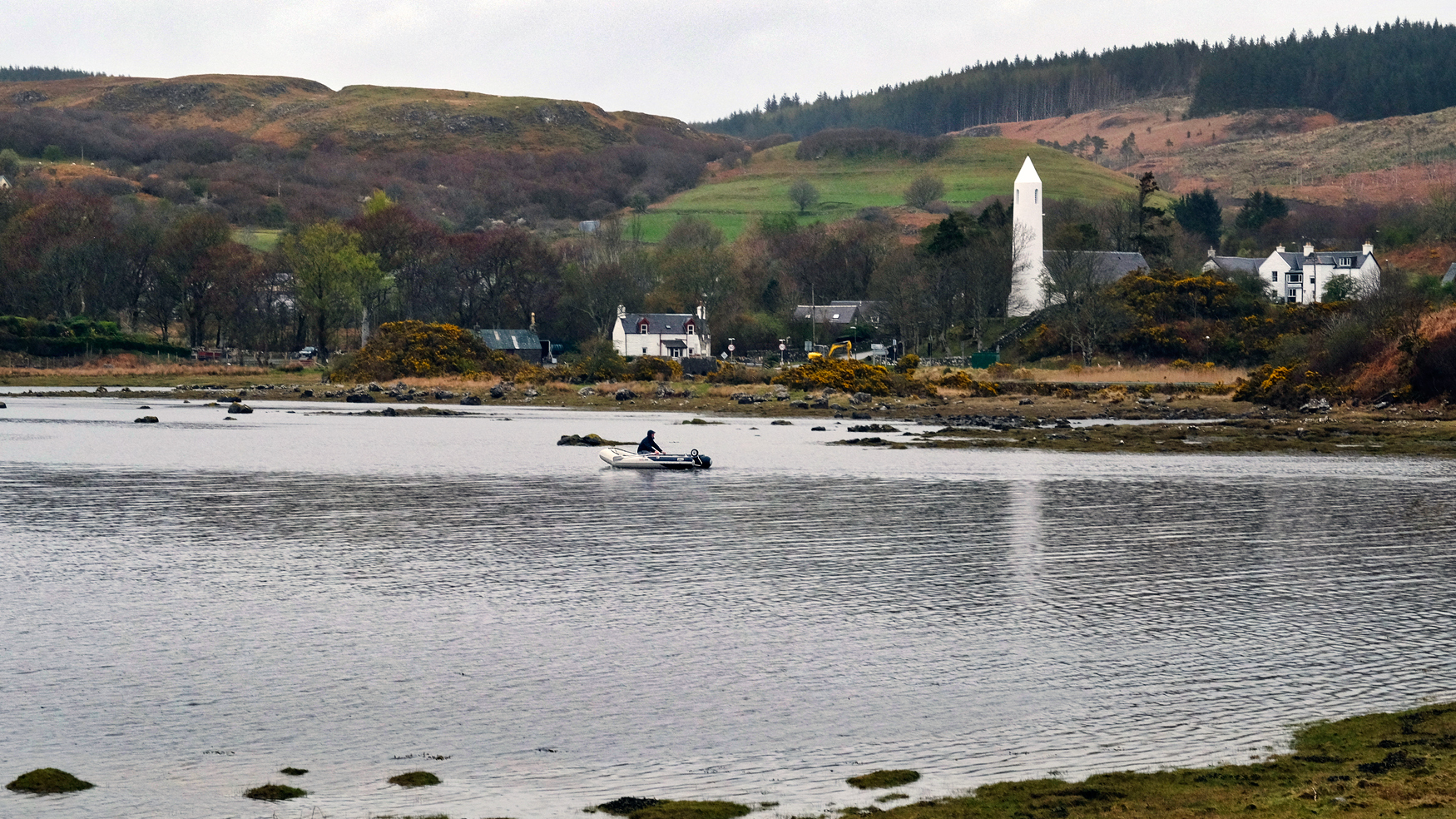 A fisherman out on an Isle of Mull inlet.
A fisherman out on an Isle of Mull inlet.
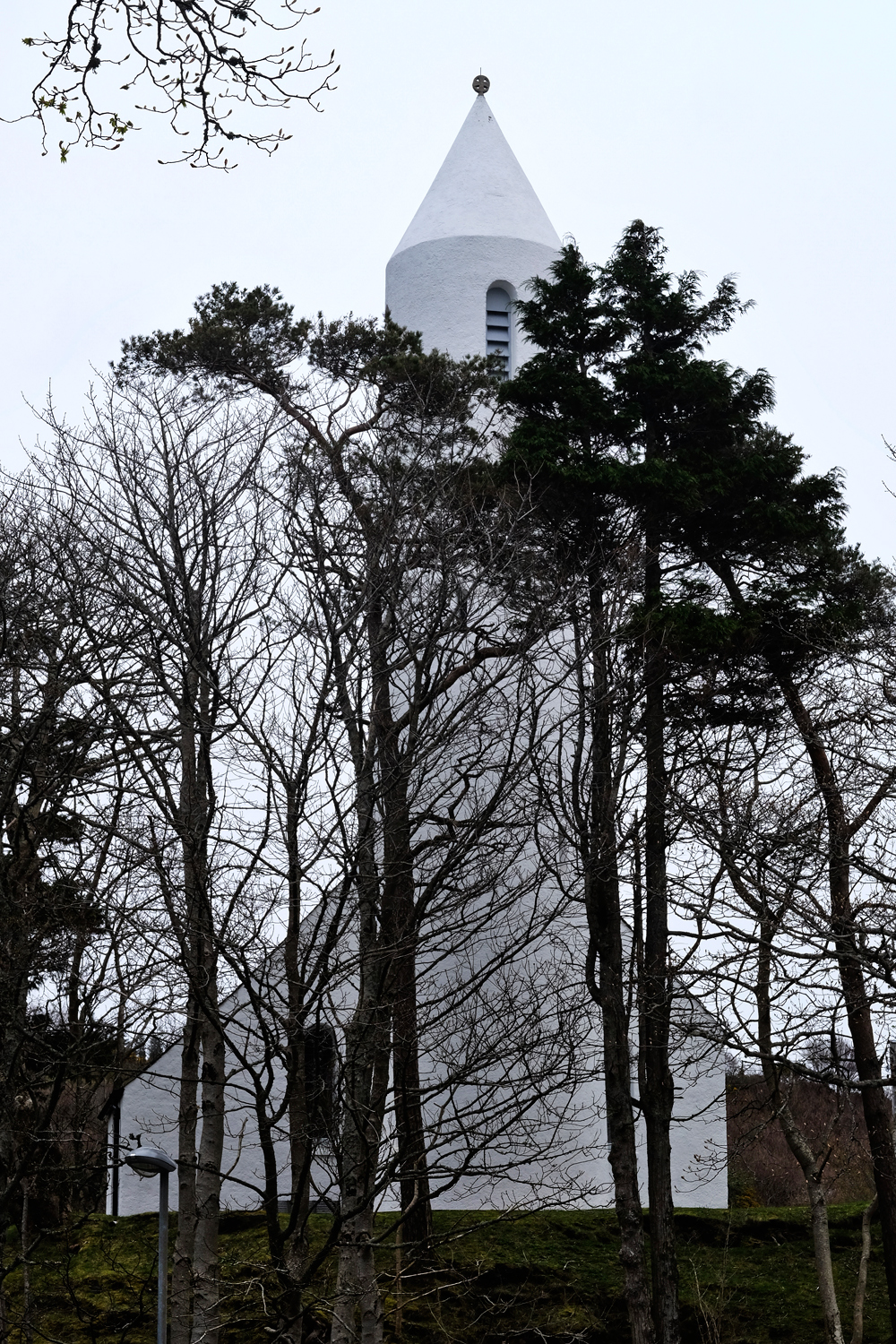 Small villages dot the inlets.
Small villages dot the inlets.
 This church was in a style I had not seen before in Scotland.
This church was in a style I had not seen before in Scotland.
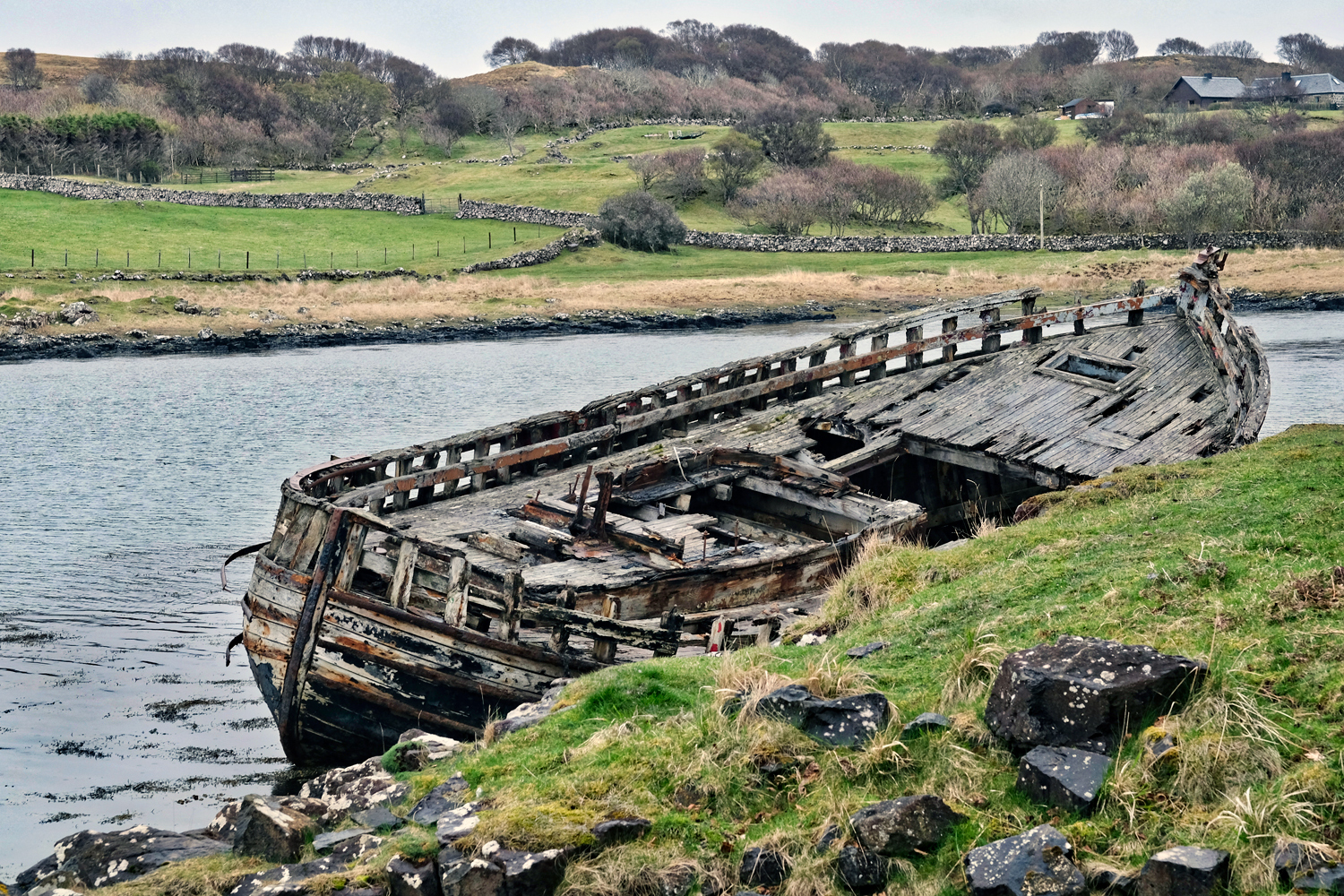 Abandoned and weathering ship on the Isle of Mull.
Abandoned and weathering ship on the Isle of Mull.
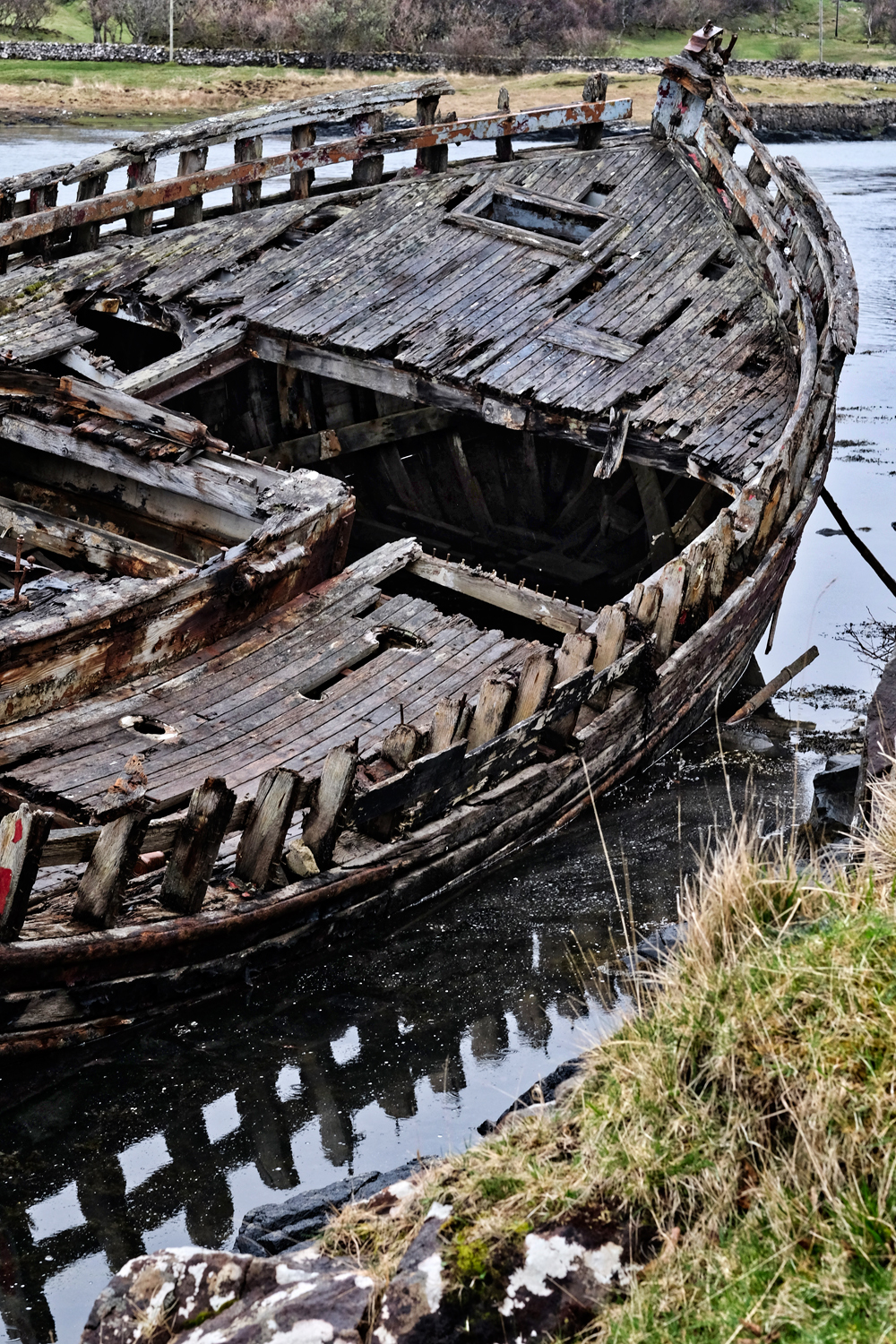 The dampness from a light drizzle brought out the color, pattern, detail, and complexity of the old rotting ship.
The dampness from a light drizzle brought out the color, pattern, detail, and complexity of the old rotting ship.
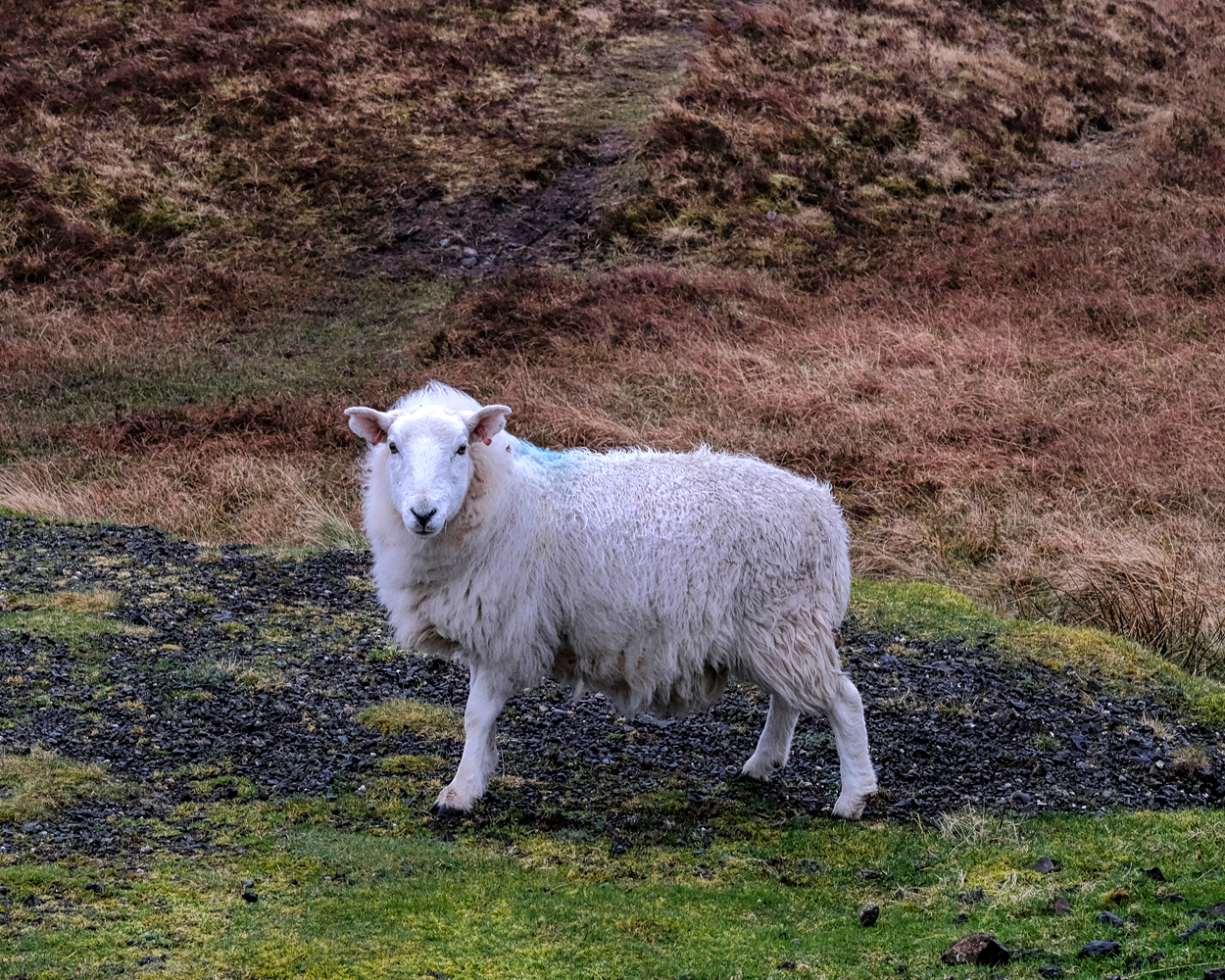 Sheep everywhere. Very wet sheep.
Sheep everywhere. Very wet sheep.
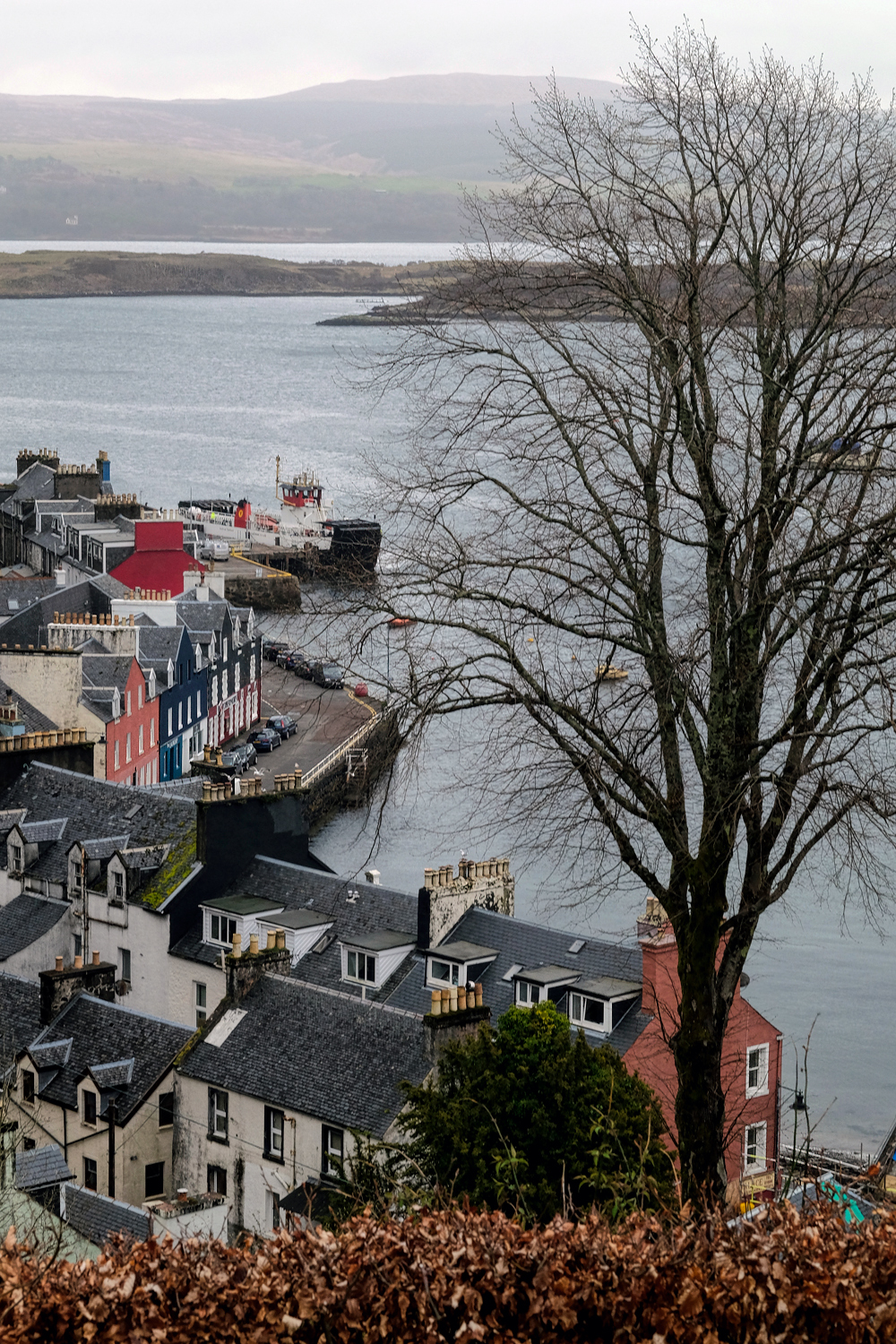 View from our hilltop B&B of the sweet 'town' of Tobermory.
View from our hilltop B&B of the sweet 'town' of Tobermory.
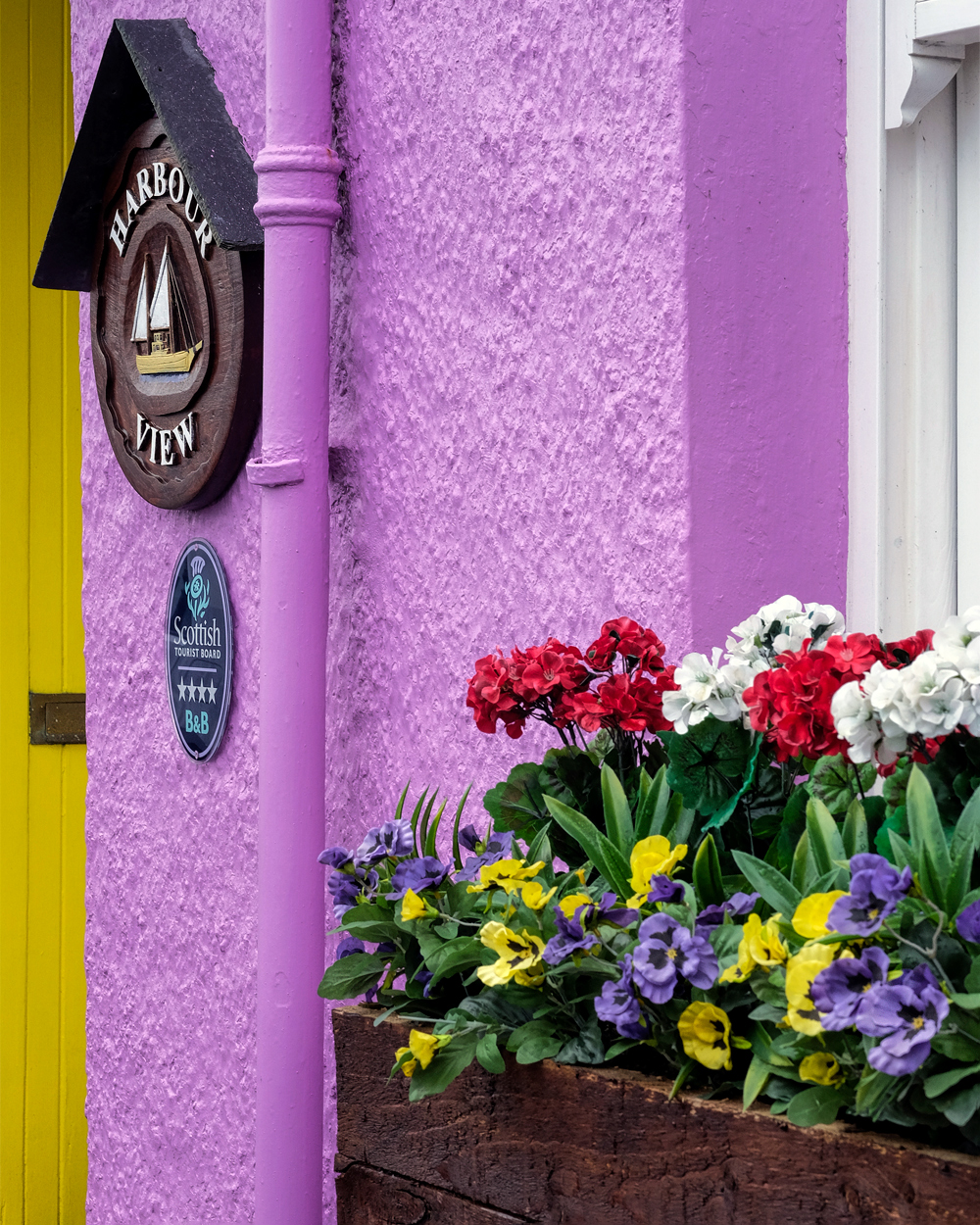 Our very sweet B&B, The Harbour View, was was run by a Scot and a Thai! Our Thai visitors were able to have Thai breakfast!
Our very sweet B&B, The Harbour View, was was run by a Scot and a Thai! Our Thai visitors were able to have Thai breakfast!
 Tobermory, Isle of Mull, has to be one of the most picturesque villages I have ever seen!
Tobermory, Isle of Mull, has to be one of the most picturesque villages I have ever seen!
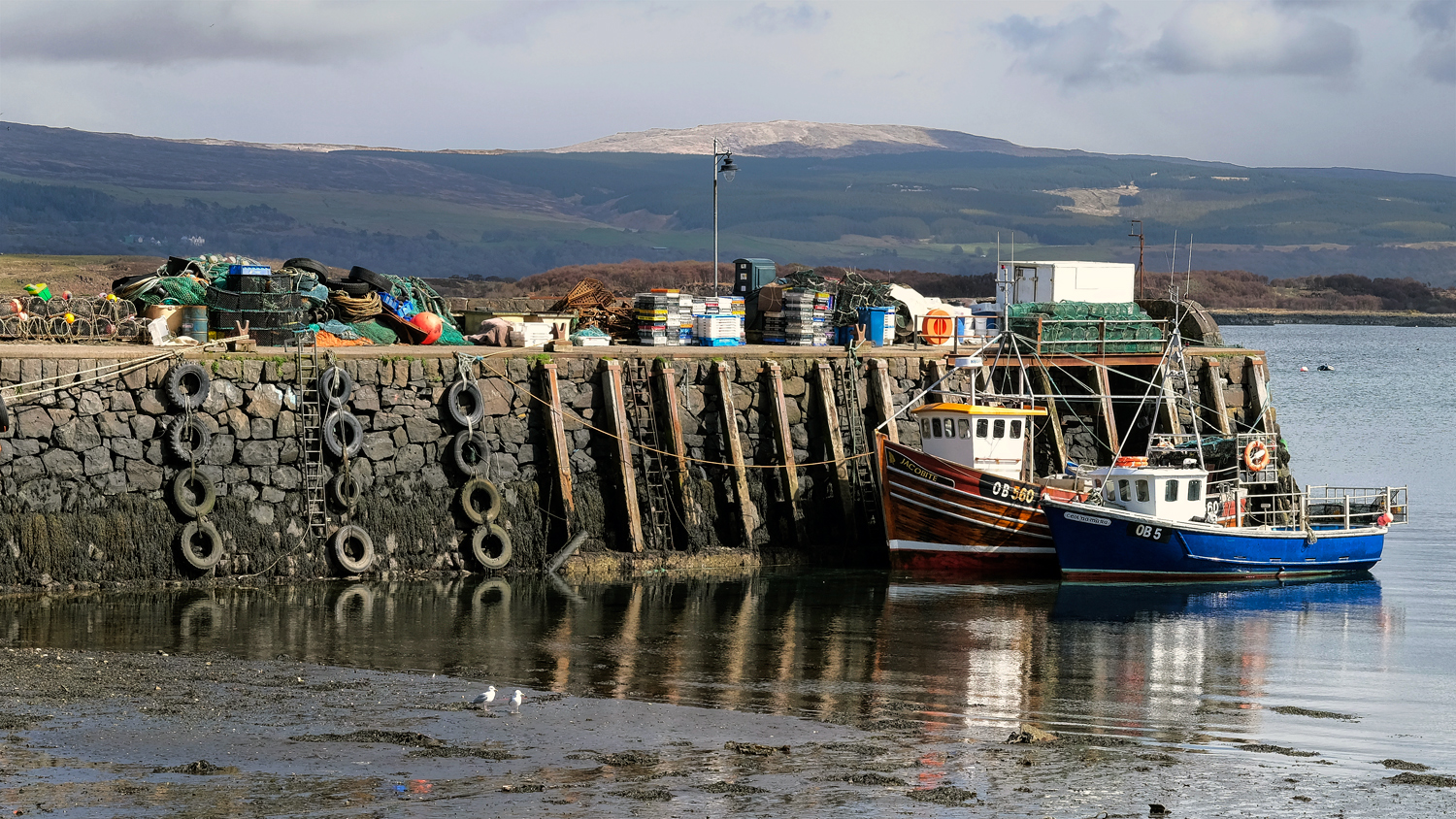 Not only a photographer's dream . . . Tobermory is a painters dream as well.
Not only a photographer's dream . . . Tobermory is a painters dream as well.
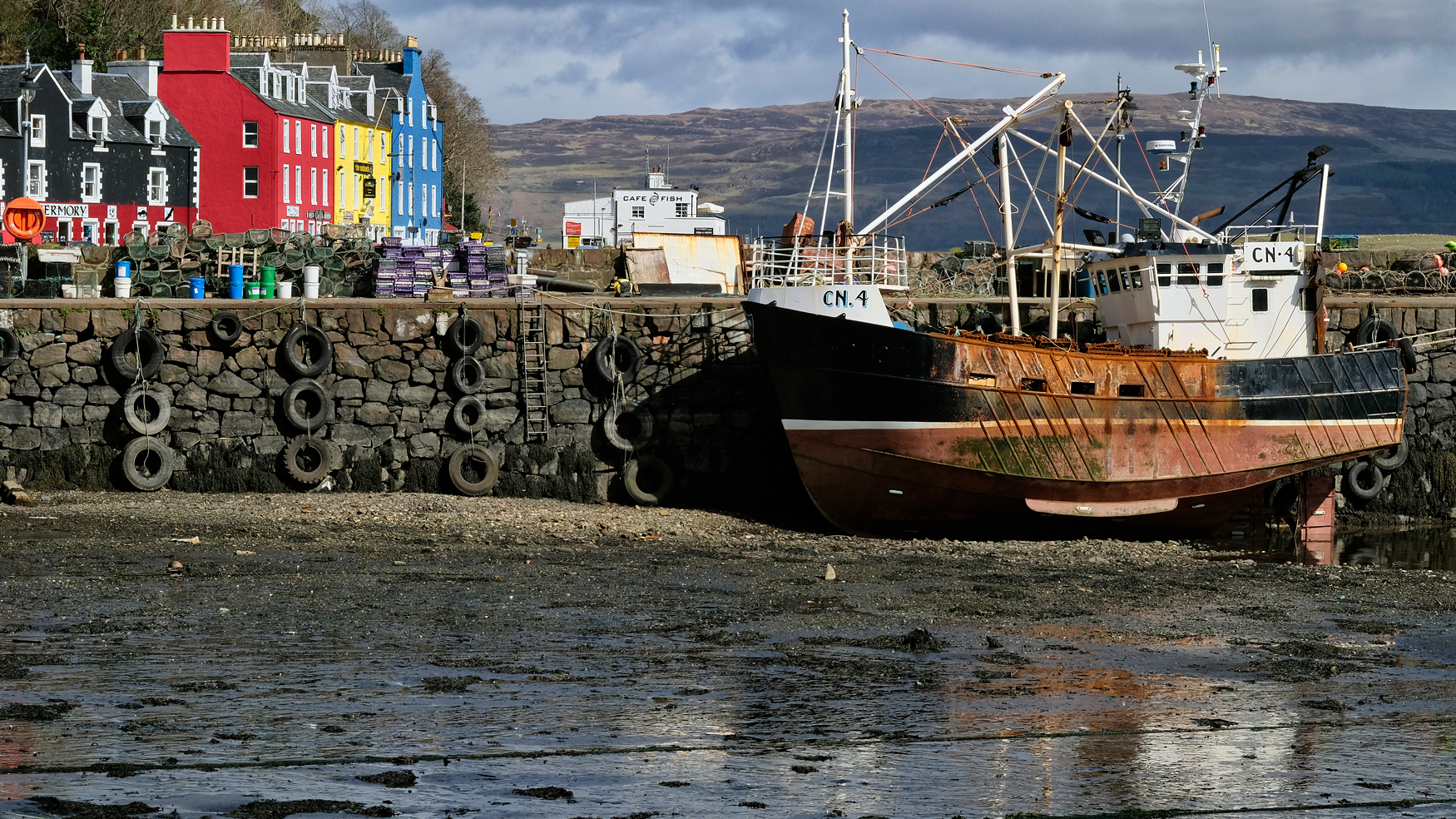 Simply Beautiful.
Simply Beautiful.
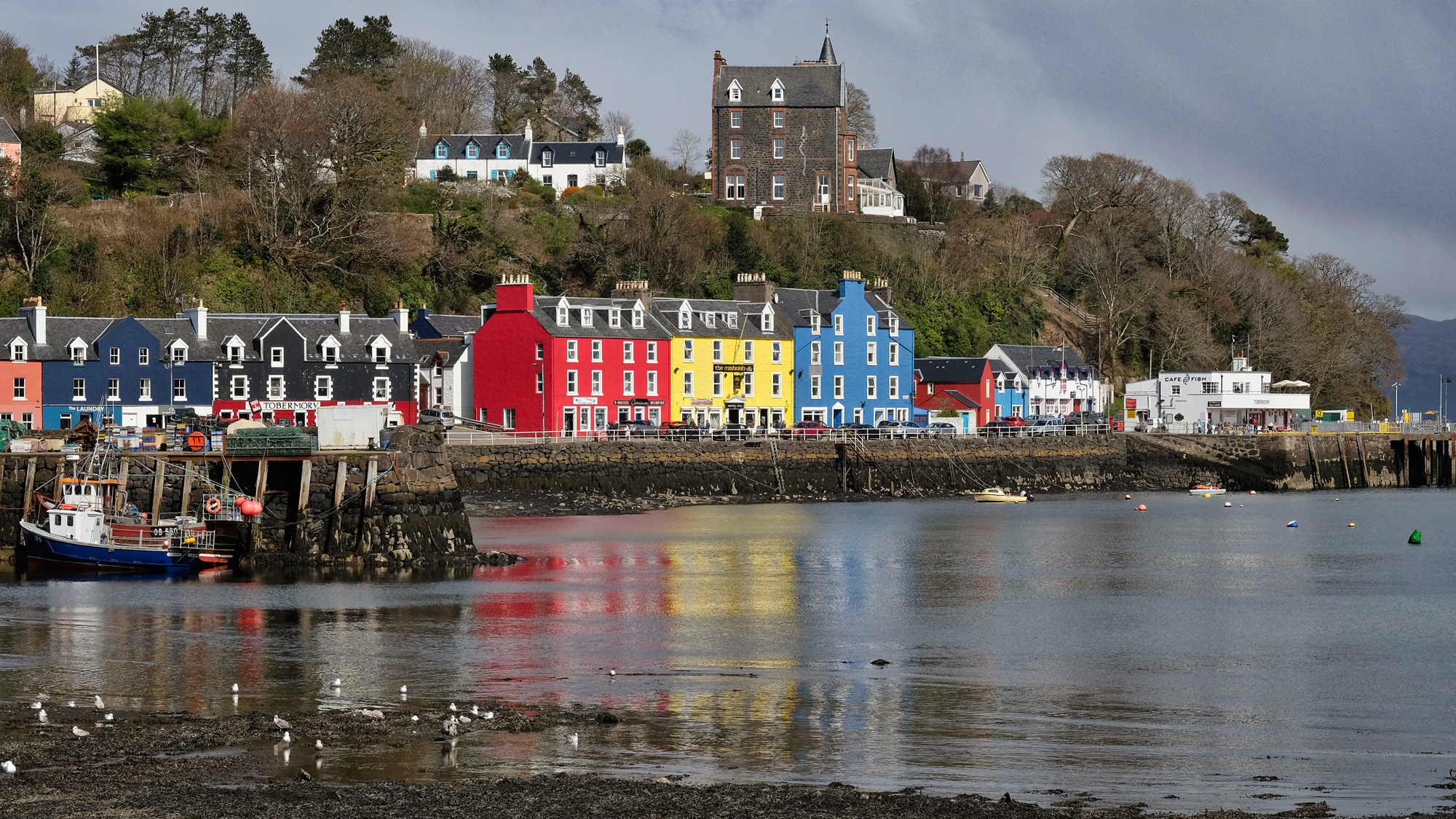 Low tide, Tobermory, Isle of Mull, Scotland. April, 2017.
Low tide, Tobermory, Isle of Mull, Scotland. April, 2017.
 Half of the harbour village of Tobermory.
Half of the harbour village of Tobermory.
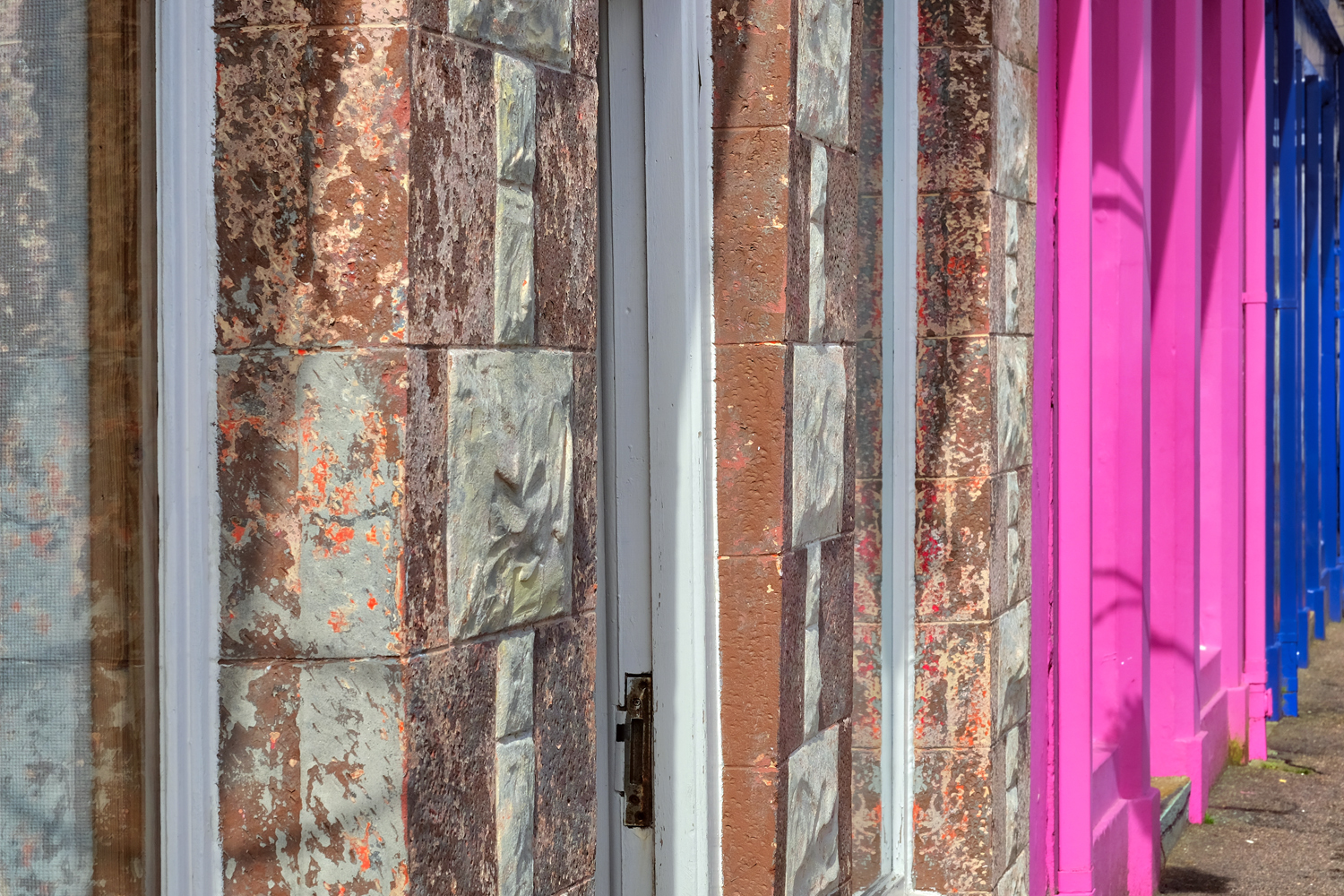 Walls along the colorful streets of Tobermory.
Walls along the colorful streets of Tobermory.
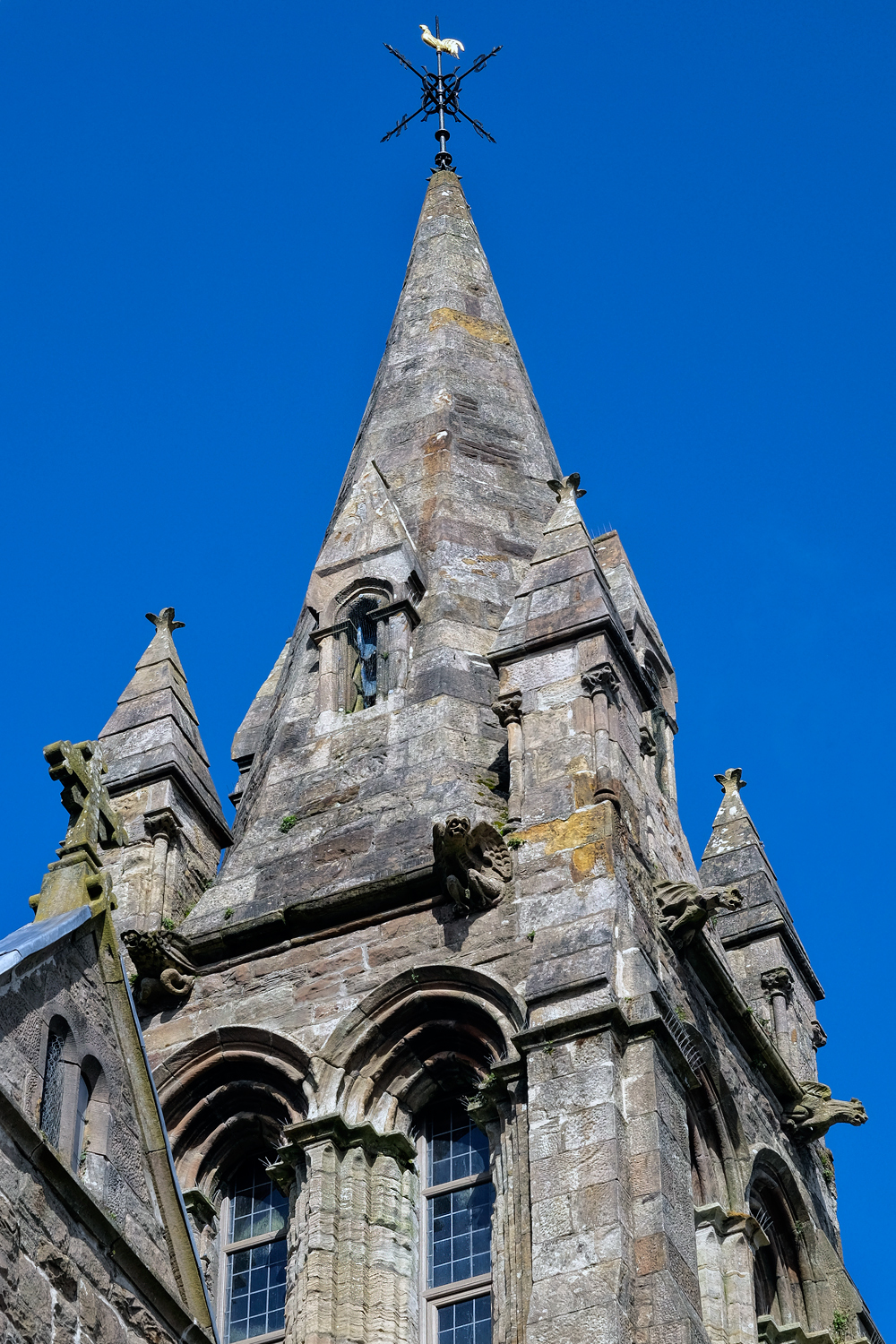 The old Tobermory church steeple against a perfect blue sky . . . in the western isles of Scotland . . . in April. Impossible.
The old Tobermory church steeple against a perfect blue sky . . . in the western isles of Scotland . . . in April. Impossible.
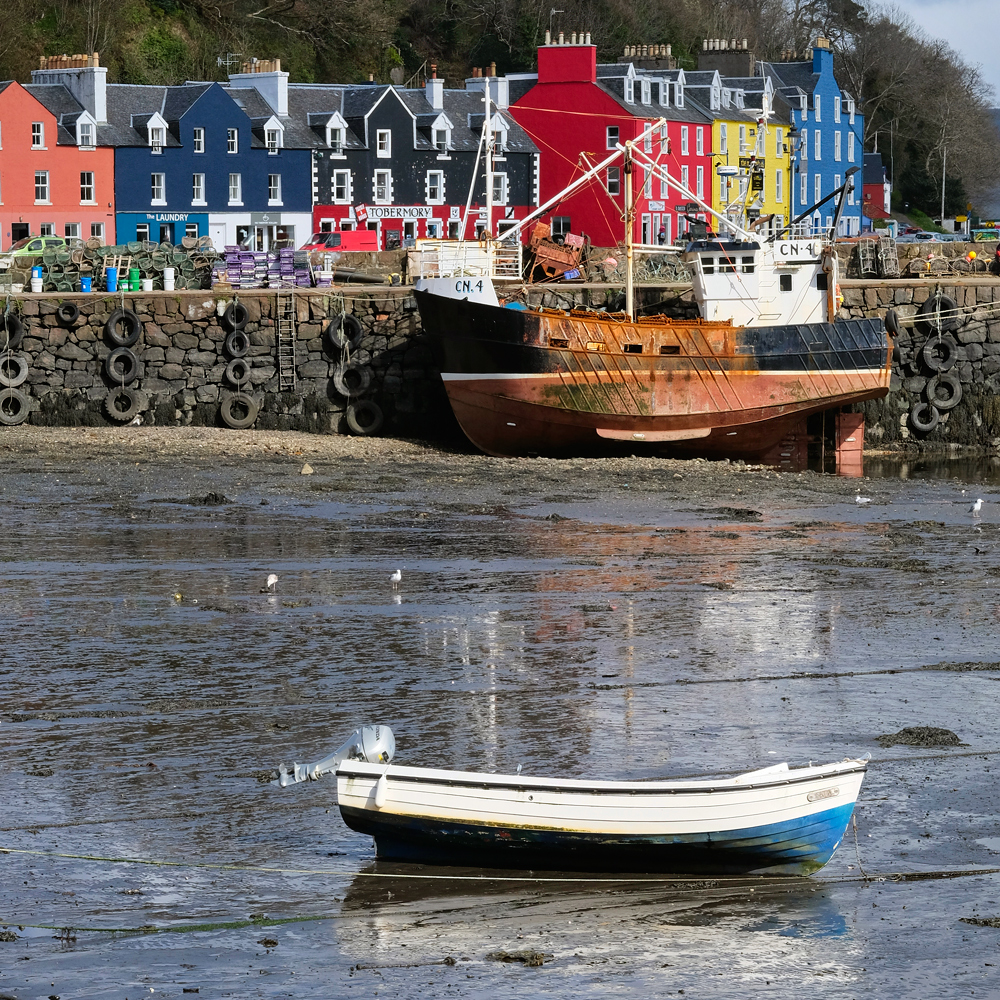 I never tire of this view.
I never tire of this view.
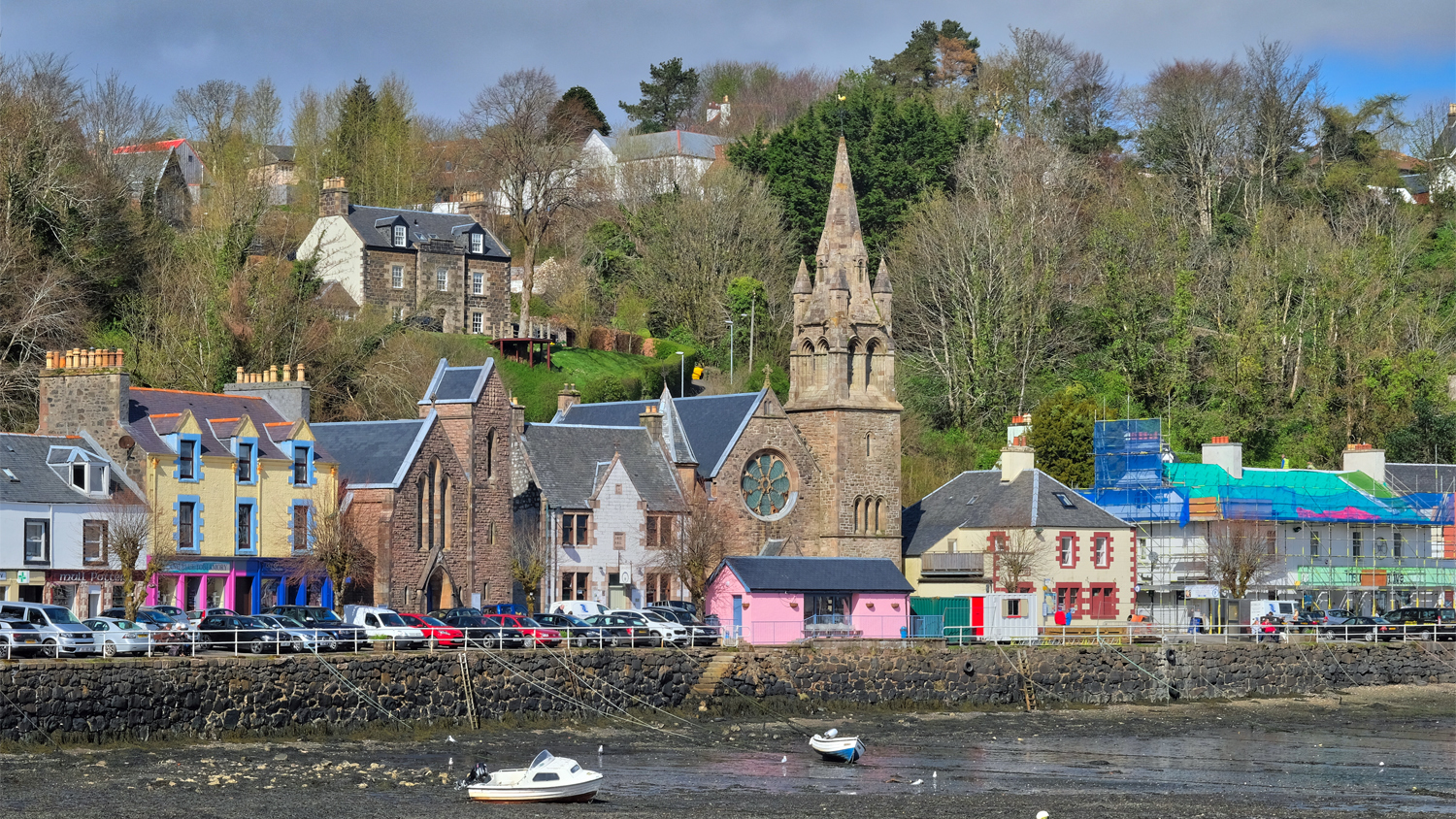 The small pink shed next to the harbour sold excellent ice cream. Our B&B was on the hill above the village.
The small pink shed next to the harbour sold excellent ice cream. Our B&B was on the hill above the village.
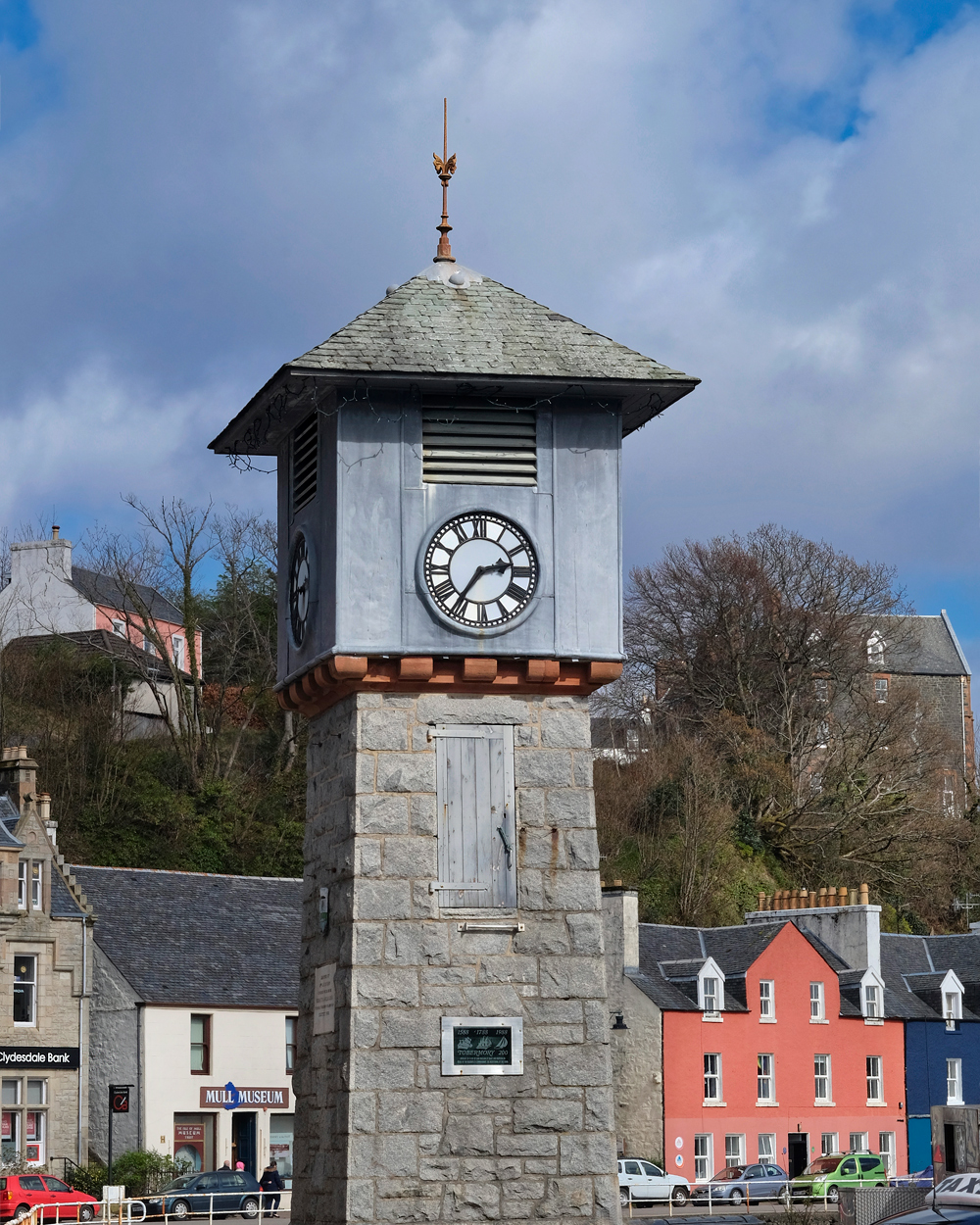 The old Tobermory town clock.
The old Tobermory town clock.
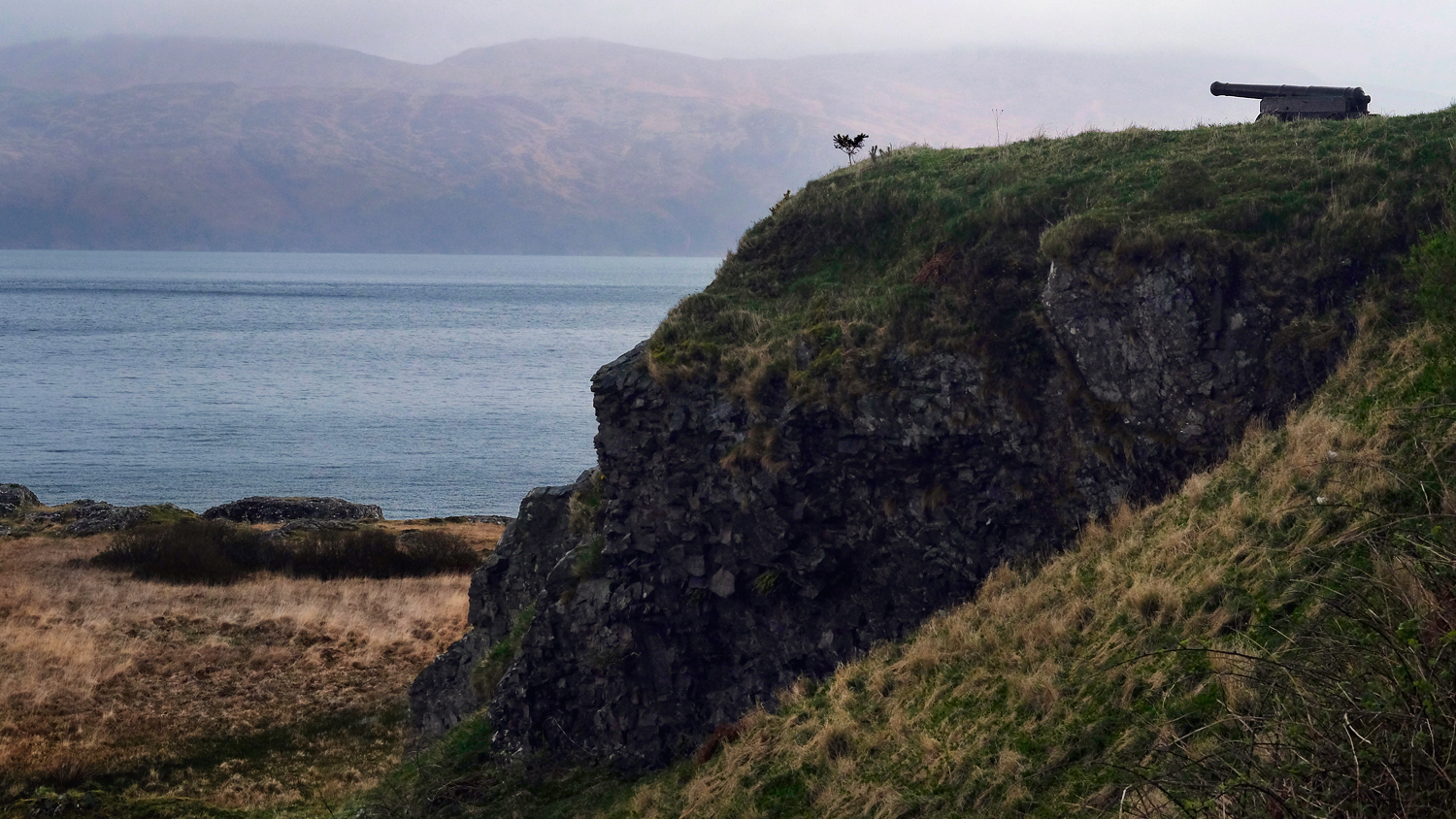 History marks itself.
History marks itself.
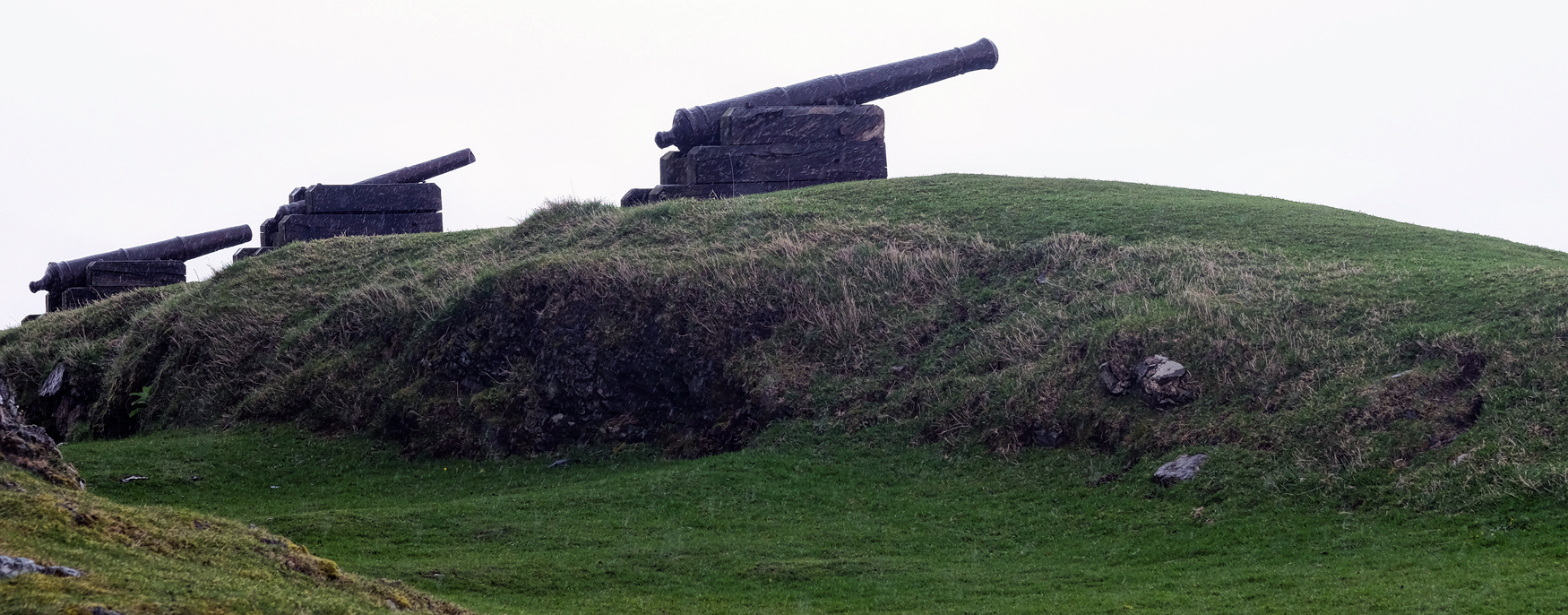 Ancient battles fought and castles defended near here.
Ancient battles fought and castles defended near here.
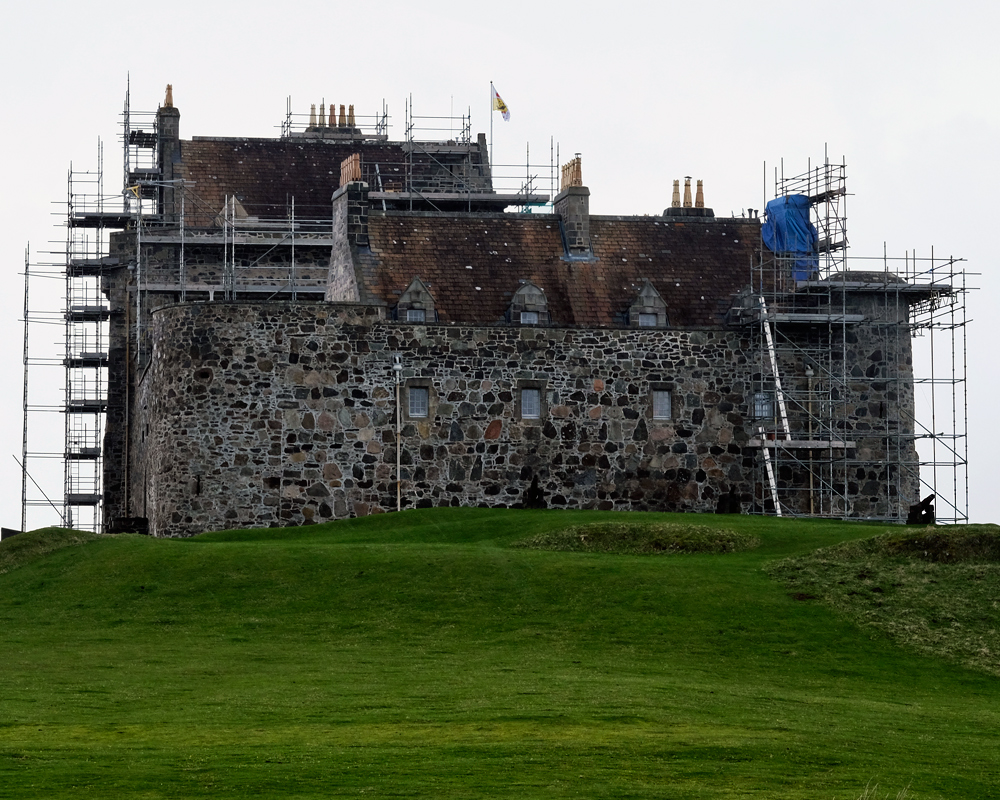 Castle Duart (c1350) under renovation.
Castle Duart (c1350) under renovation.
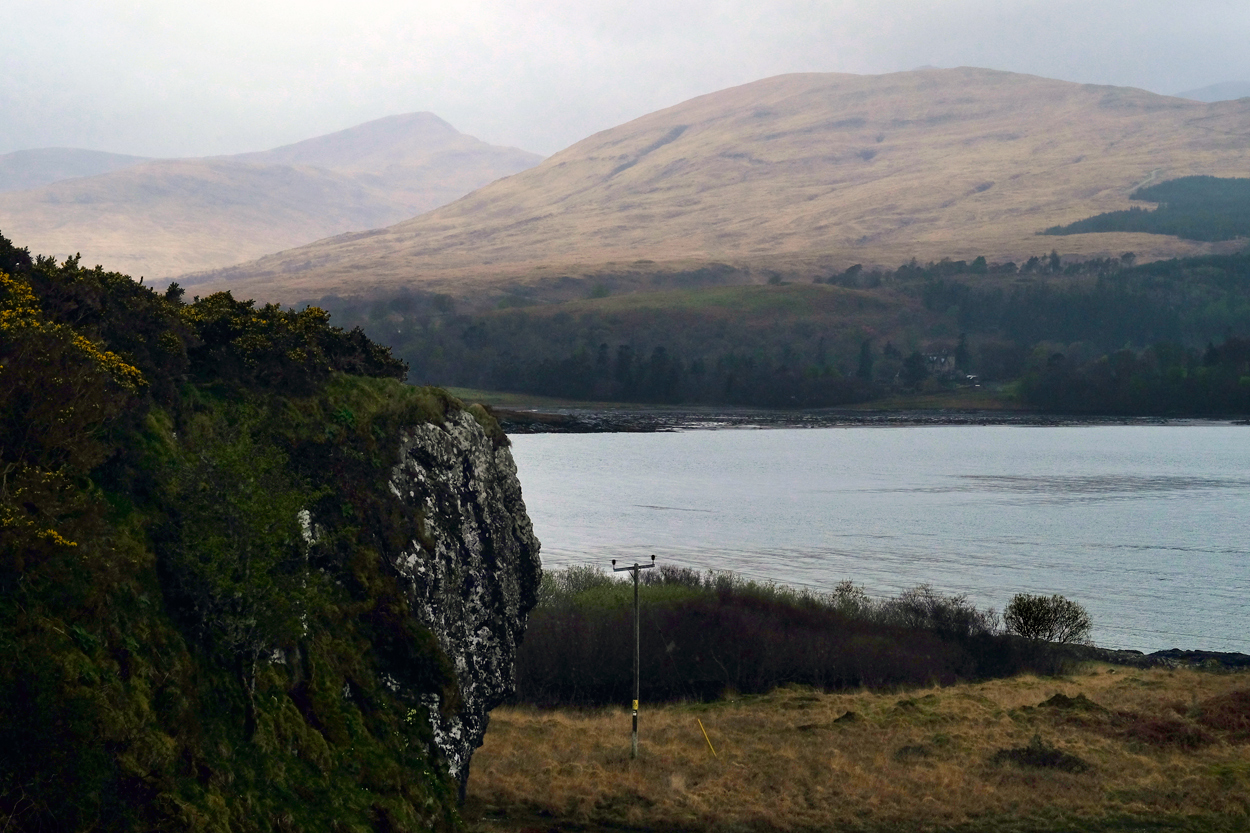 The atmospheric view from Castle Duart on a cold, rainy day on the Isle of Mull.
The atmospheric view from Castle Duart on a cold, rainy day on the Isle of Mull.
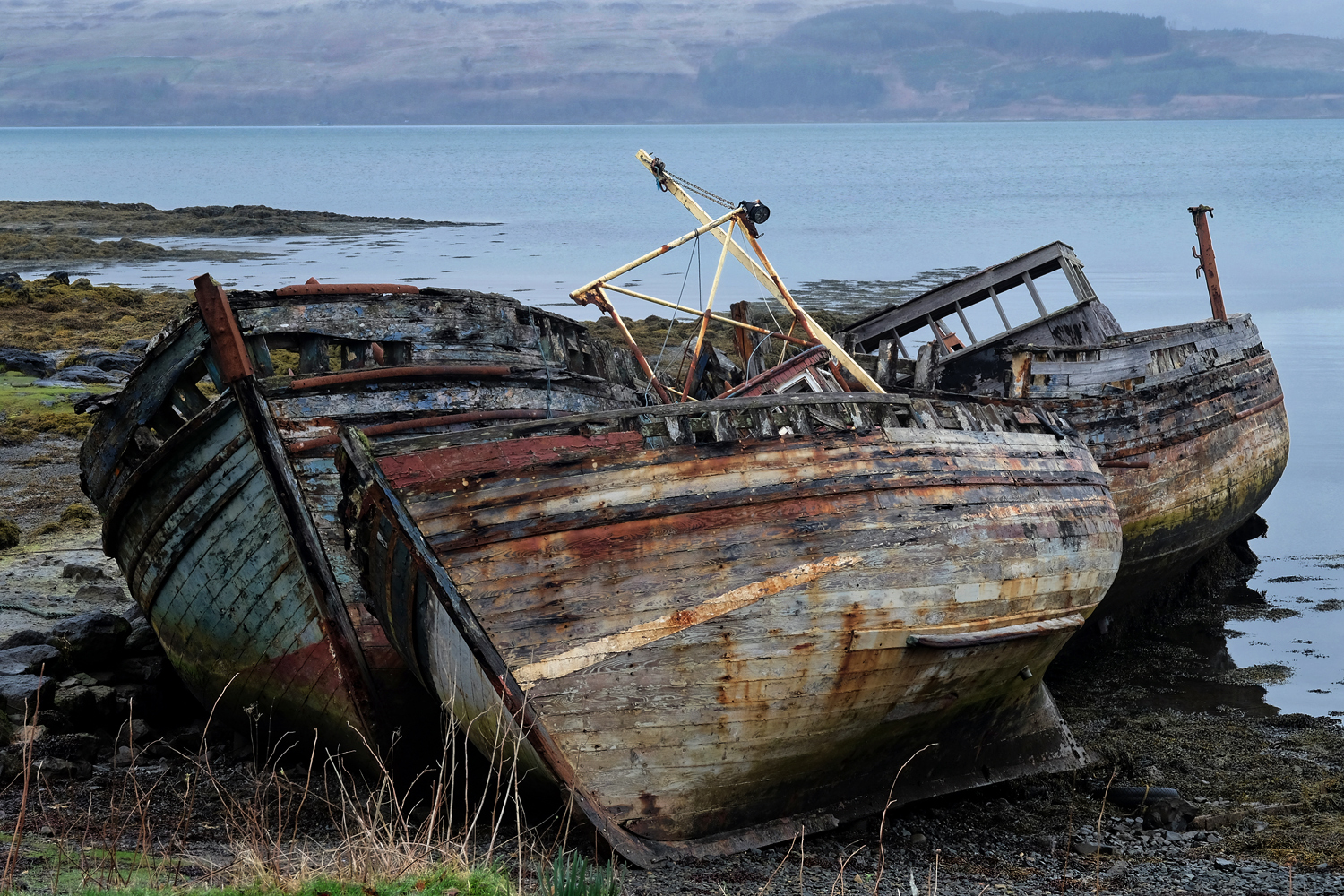 Then, around a bend . . . . a photographer's dream come true!
Then, around a bend . . . . a photographer's dream come true!
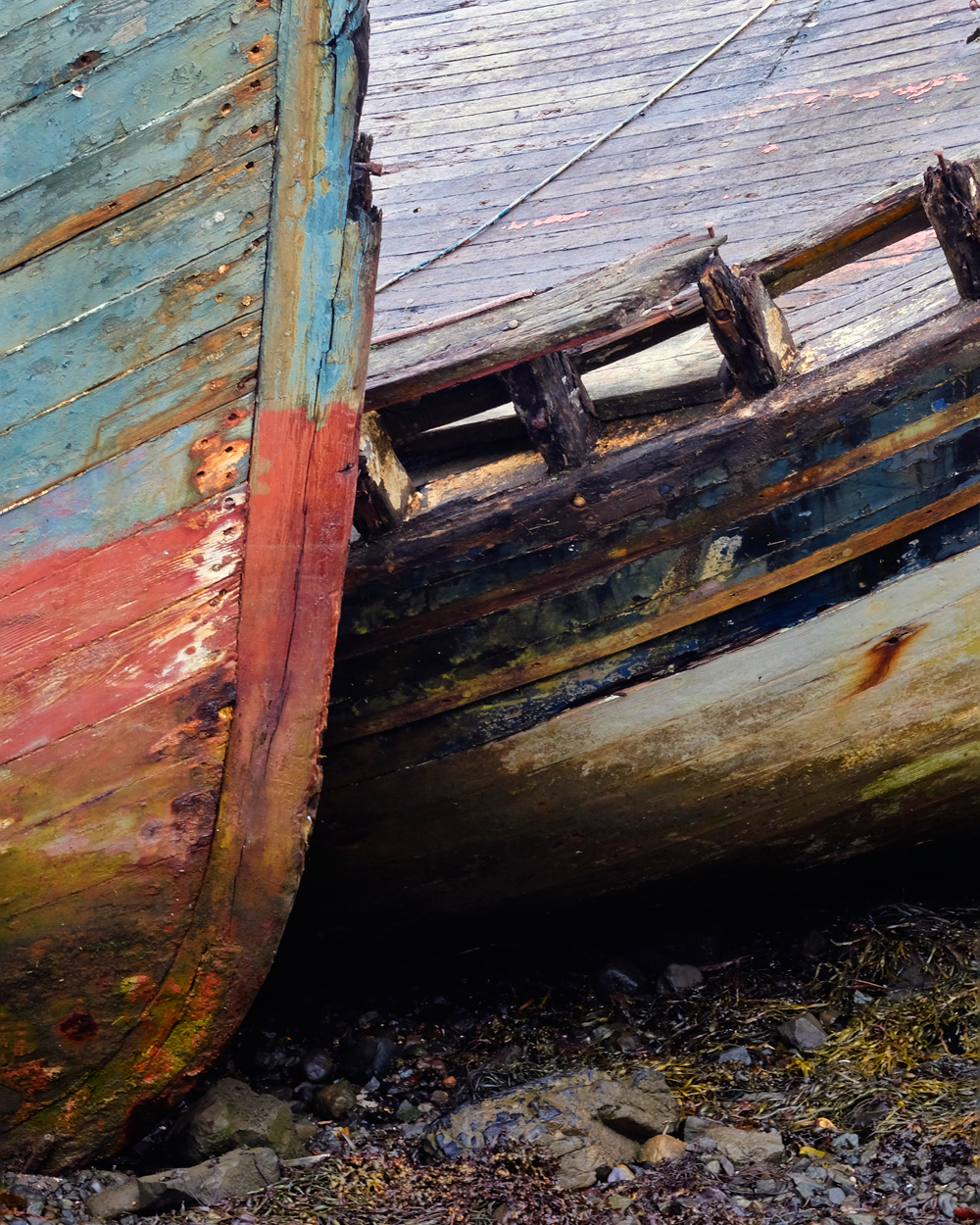 Fantastic patina of age and deterioration.
Fantastic patina of age and deterioration.
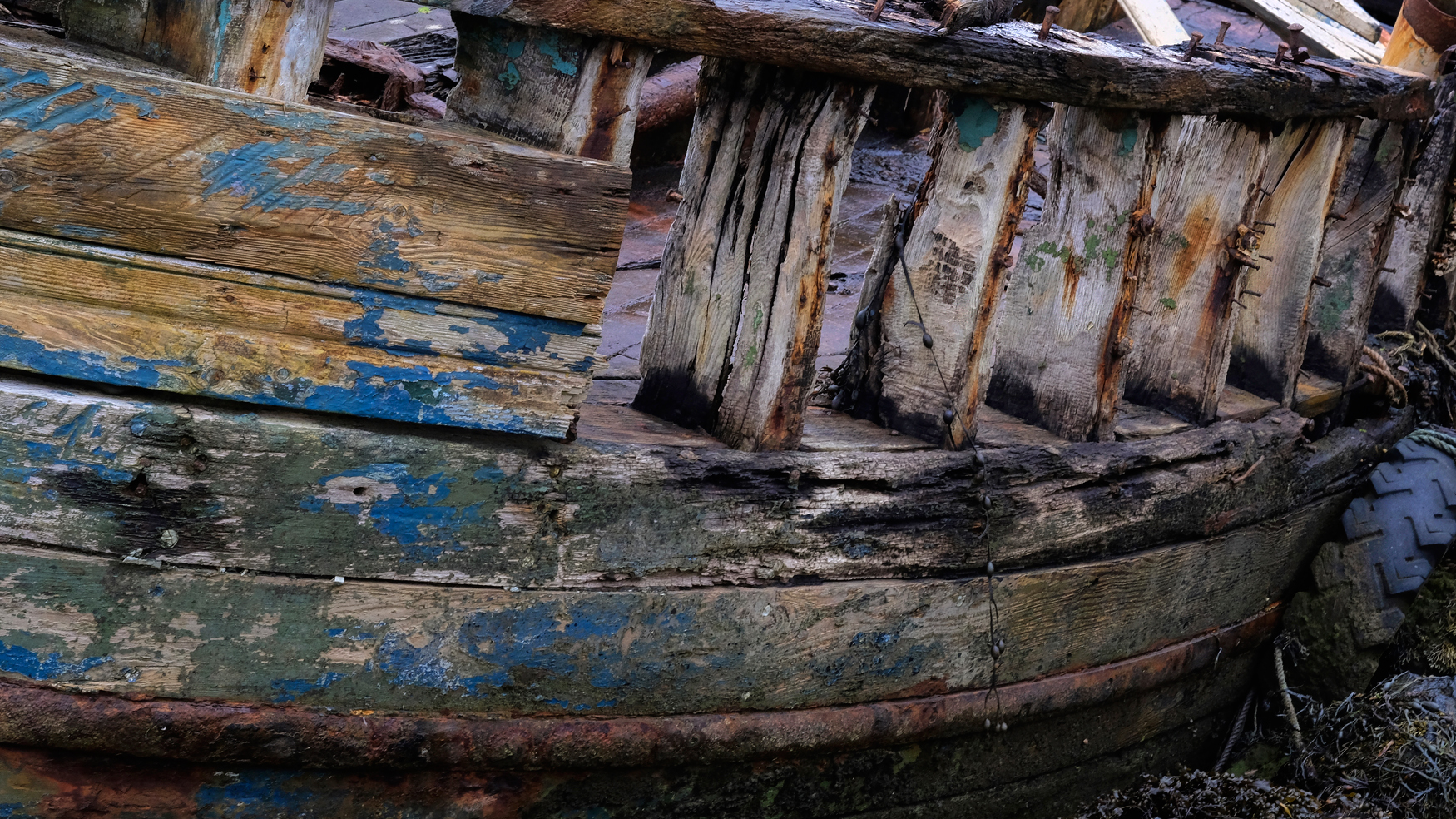 Abandoned after years of service.
Abandoned after years of service.
 There are no bad light days in photography . . . .
There are no bad light days in photography . . . .
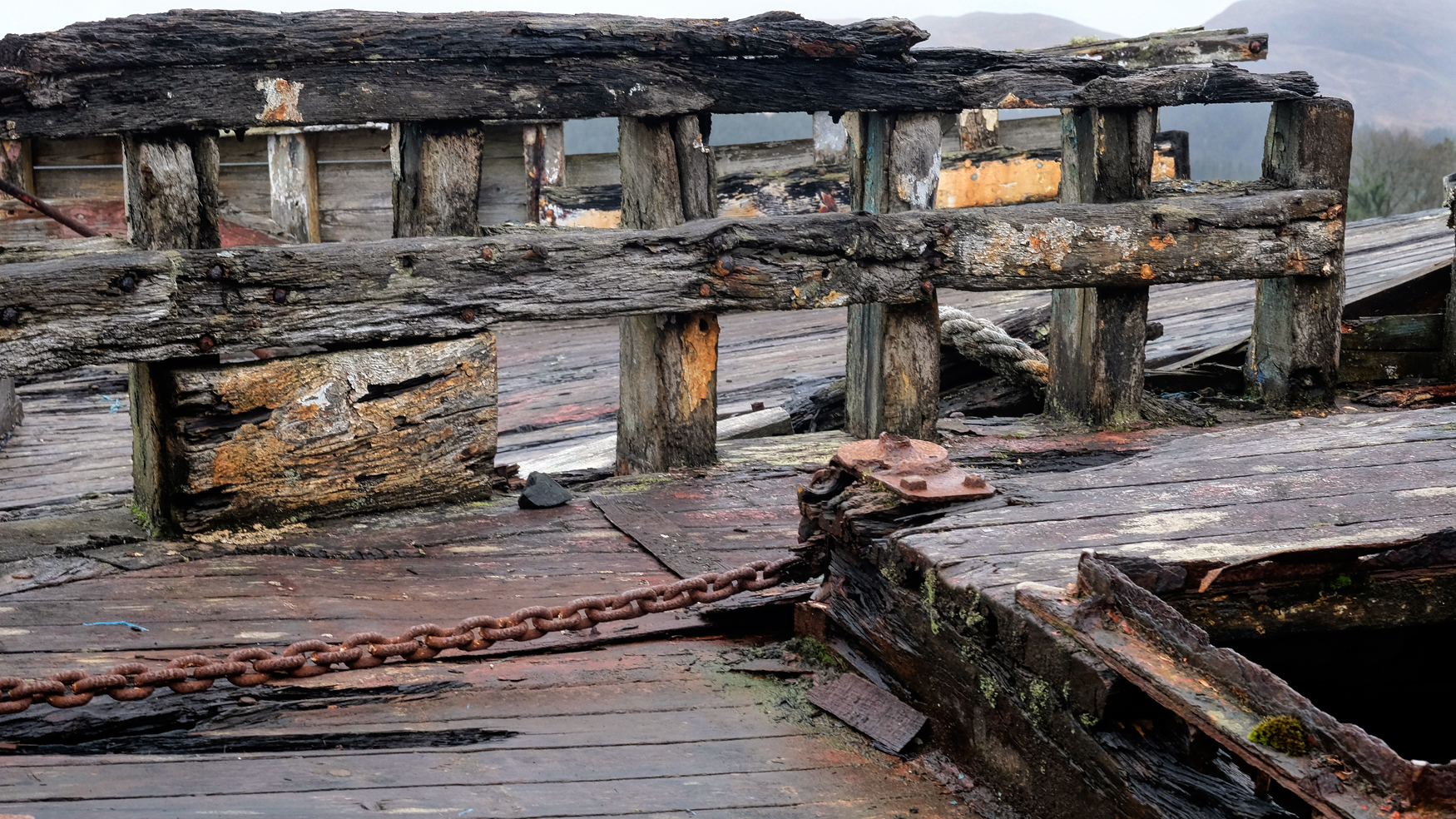 Not too long before this ship completely disappears. I wonder if this is an Aberdeen Trawler.
Not too long before this ship completely disappears. I wonder if this is an Aberdeen Trawler.
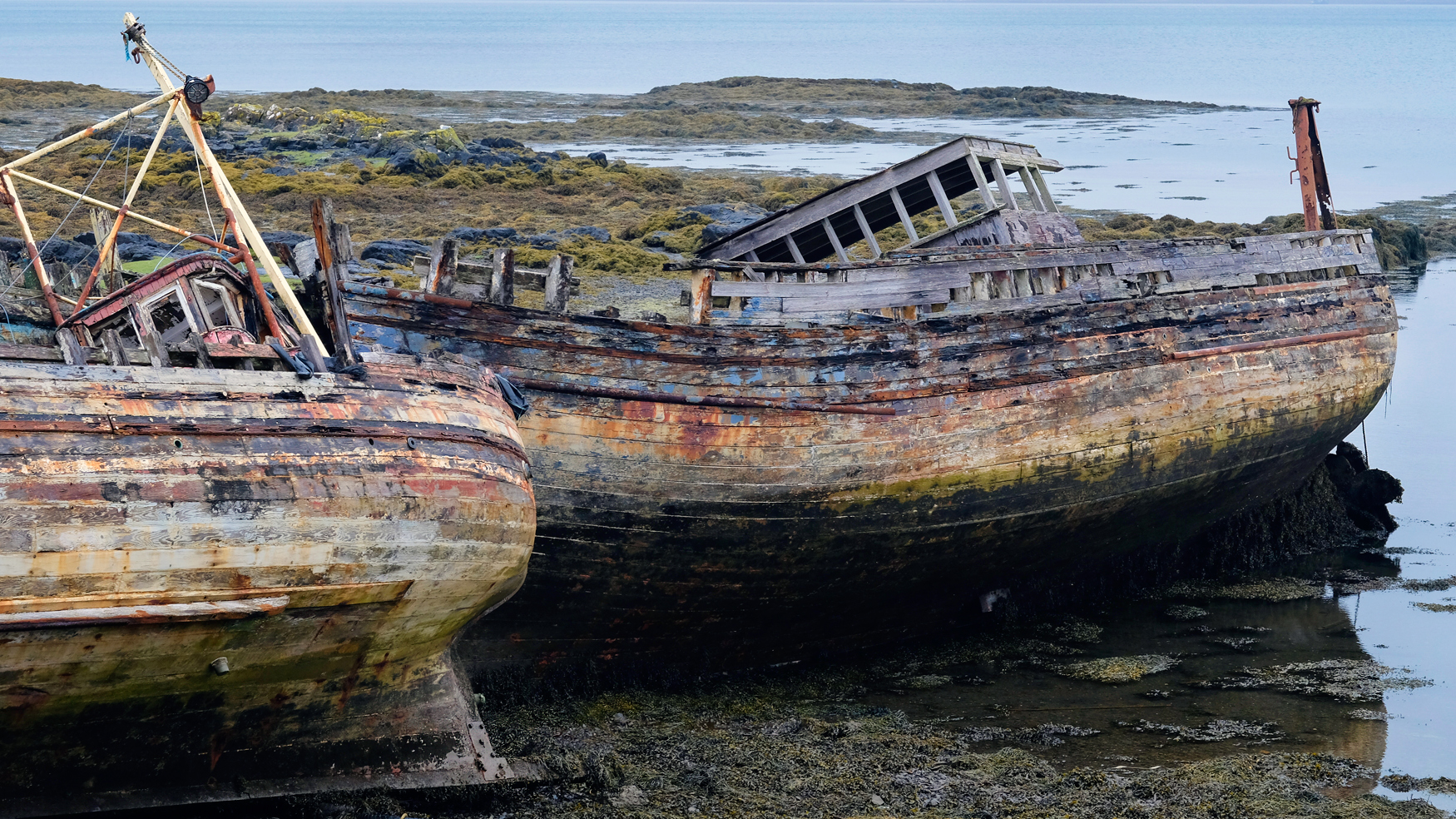 Three old fishing trawlers abandoned.
Three old fishing trawlers abandoned.
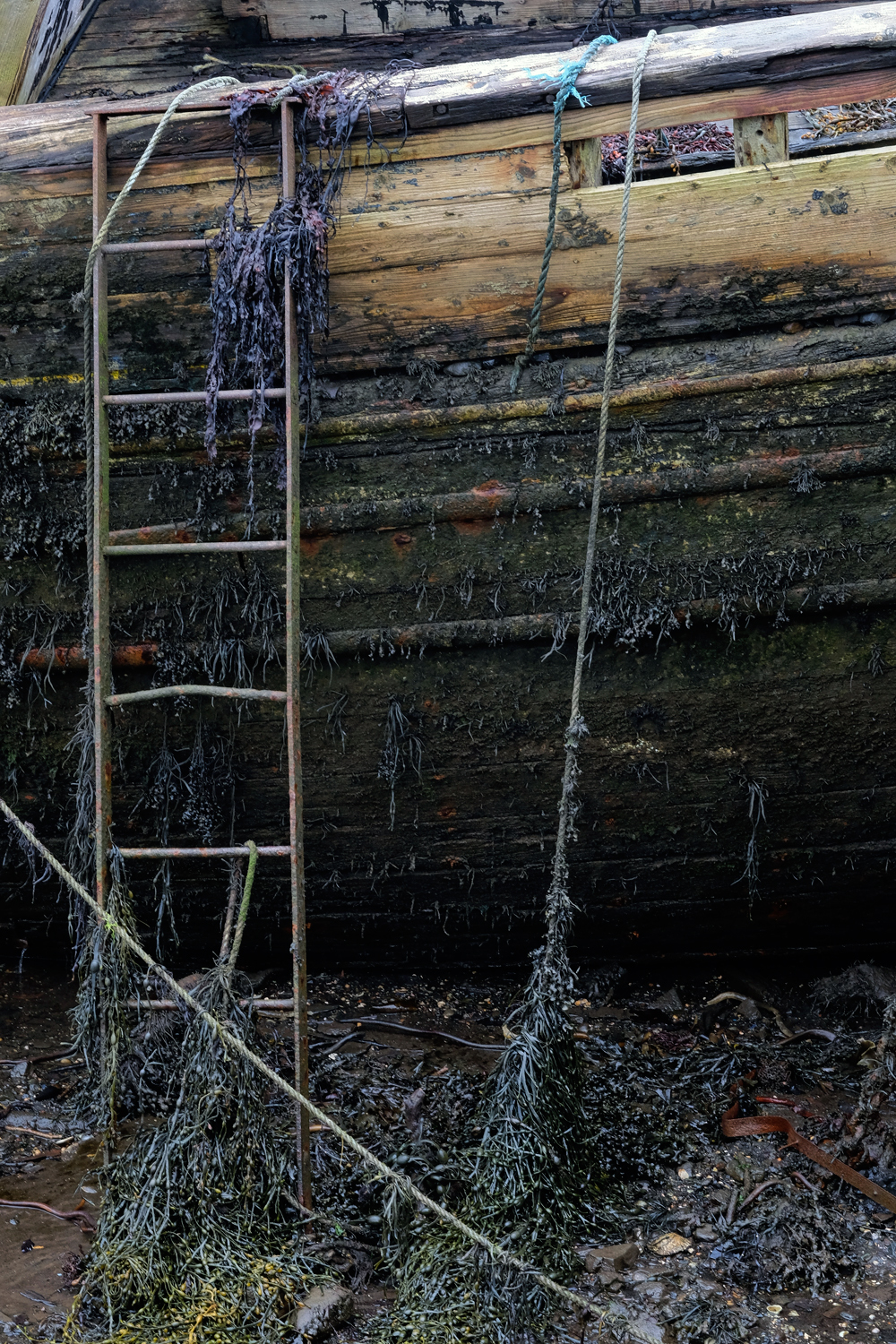 Nature taking over.
Nature taking over.
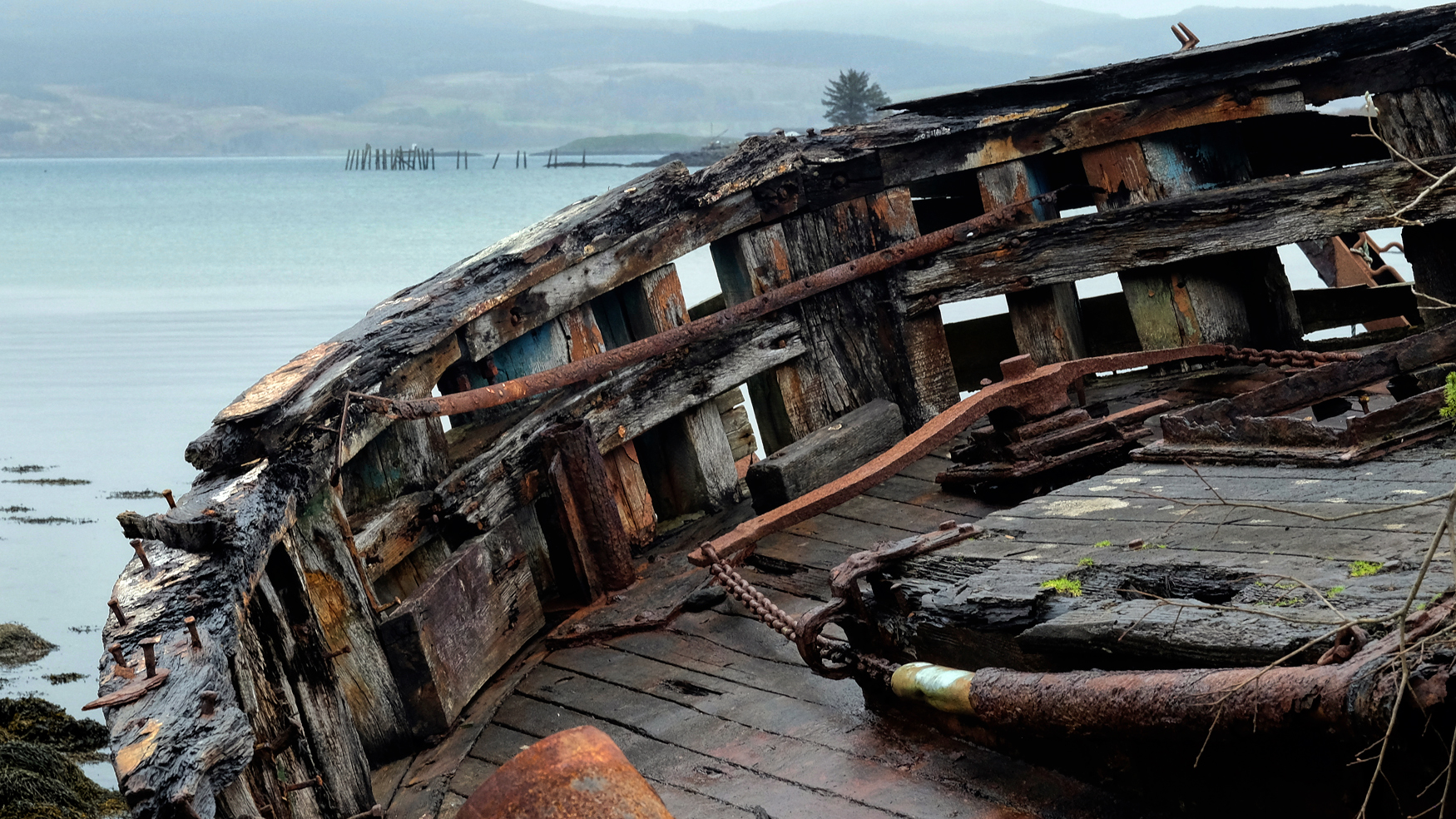 Fishermen worked these decks for how long?
Fishermen worked these decks for how long?
 Always a view of sea and rising hills.
Always a view of sea and rising hills.
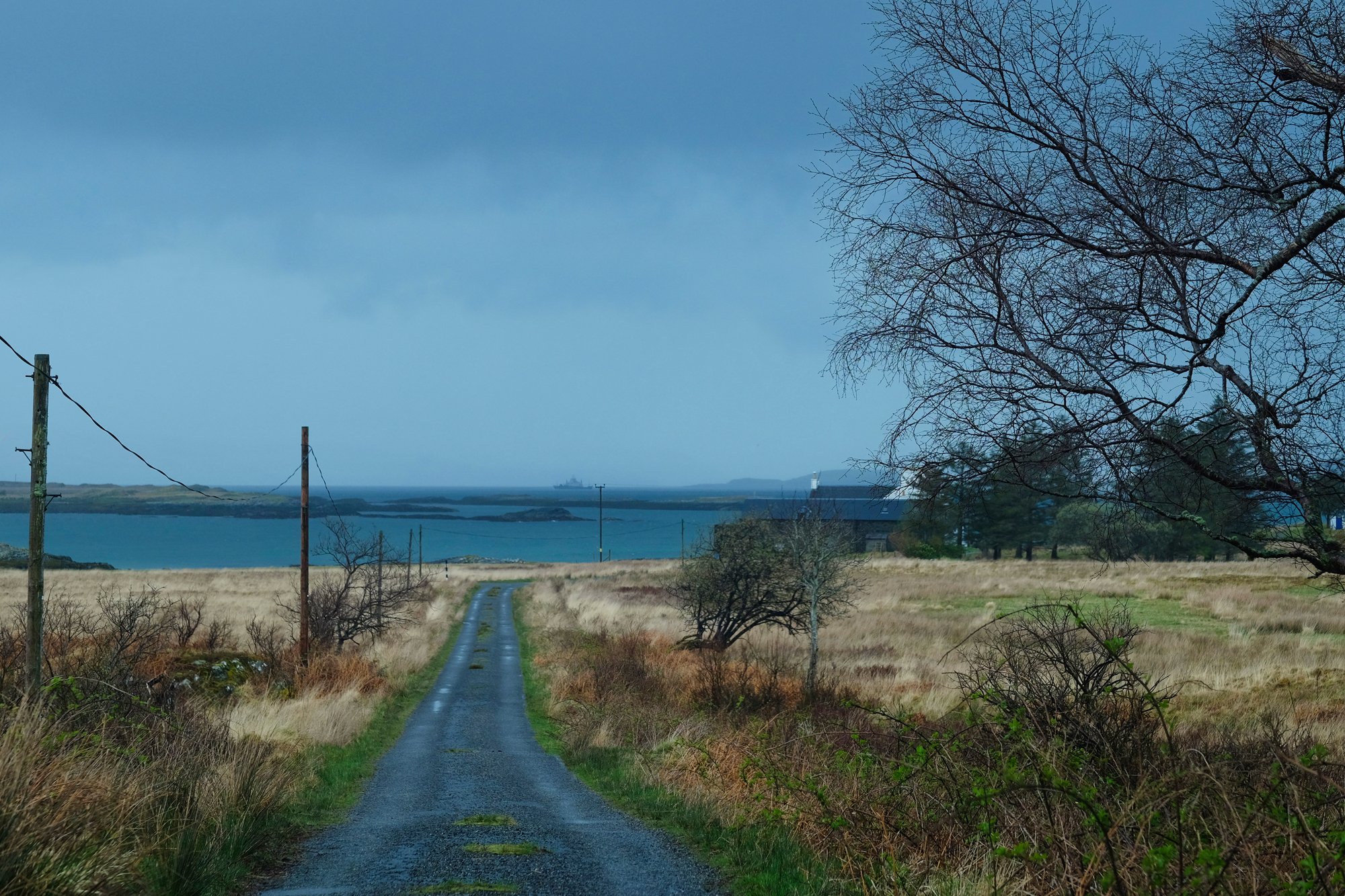 On another day . . . sun and blue sky along the tiny roads . . .
On another day . . . sun and blue sky along the tiny roads . . .
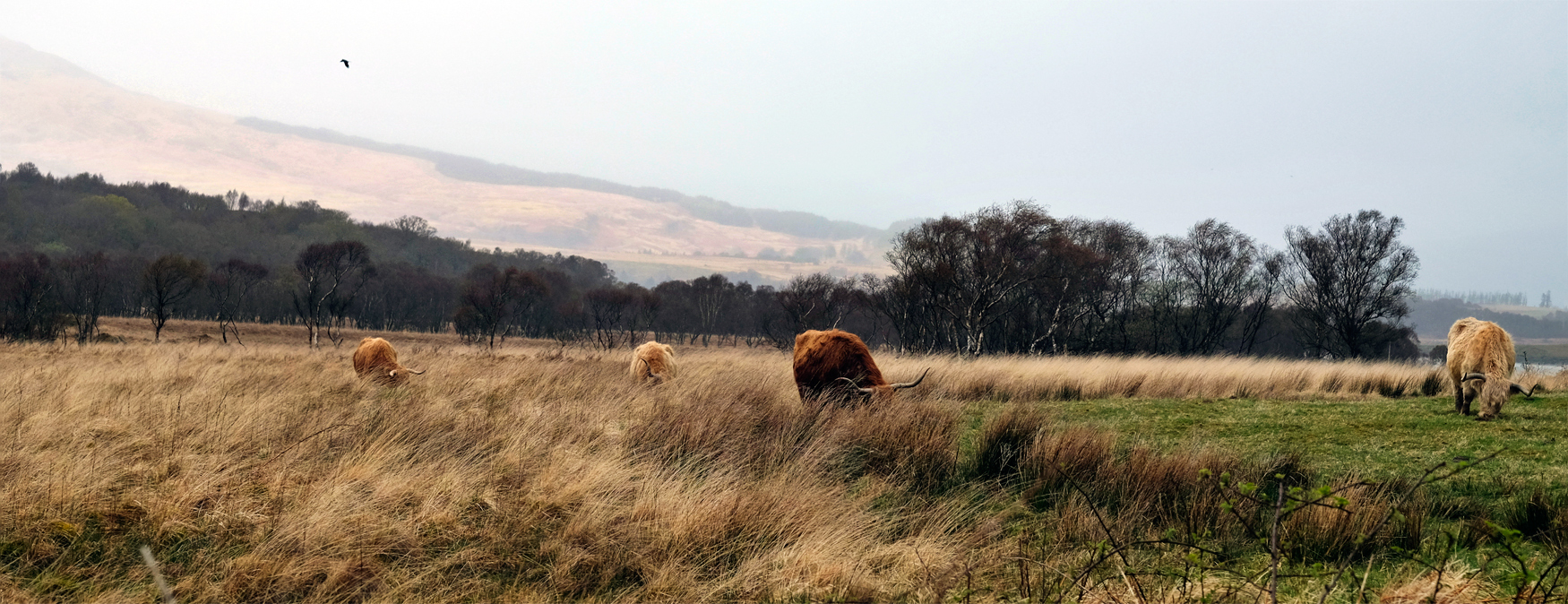 Cattle and sheep augment the fishing industries of Mull. These are Highland cows.
Cattle and sheep augment the fishing industries of Mull. These are Highland cows.
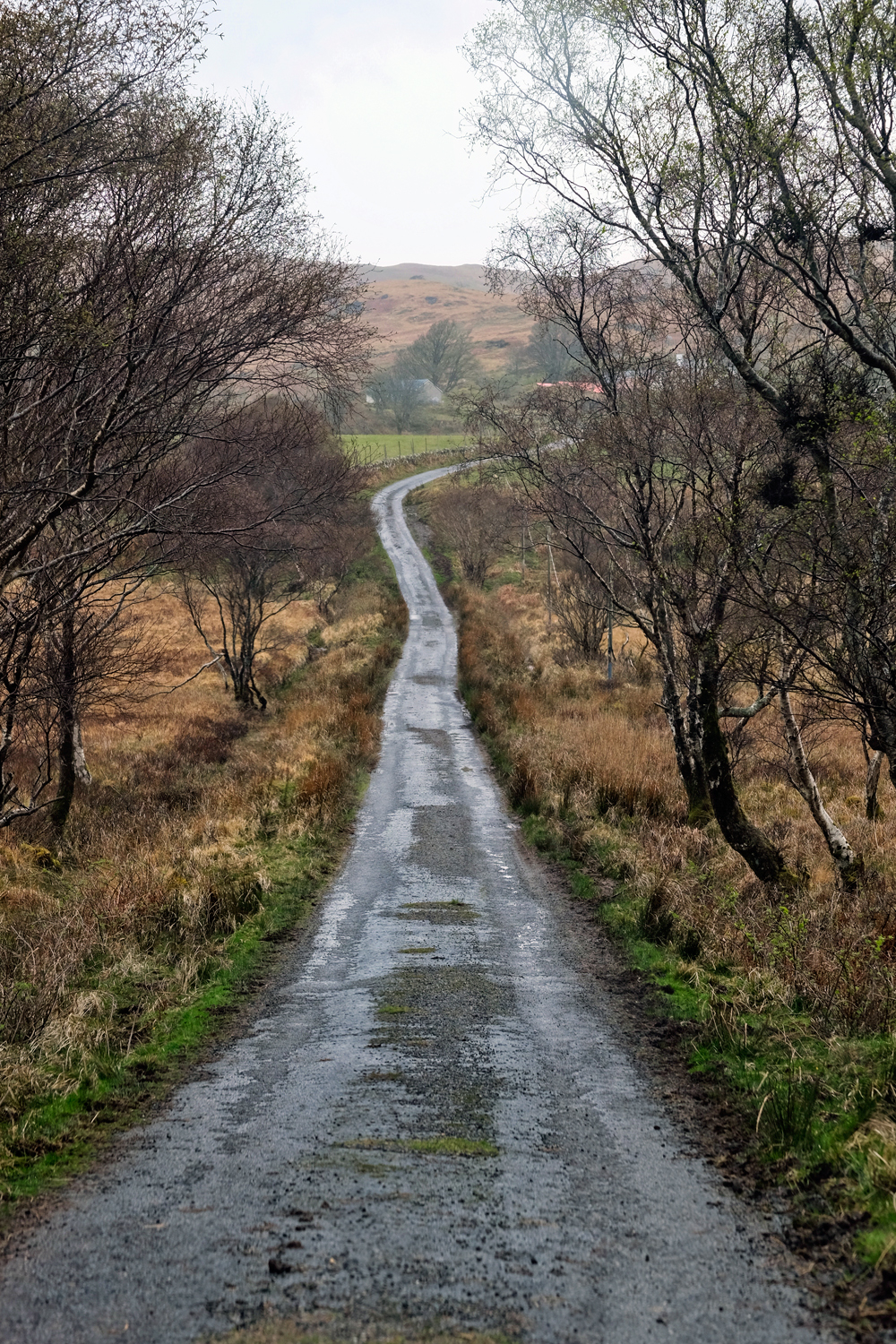 We meandered along these small roads using Google maps to guide us to points of interest.
We meandered along these small roads using Google maps to guide us to points of interest.
 After a long drive in the rain on tiny roads, we reached a small valley rimmed with low clouds and this austere church.
After a long drive in the rain on tiny roads, we reached a small valley rimmed with low clouds and this austere church.
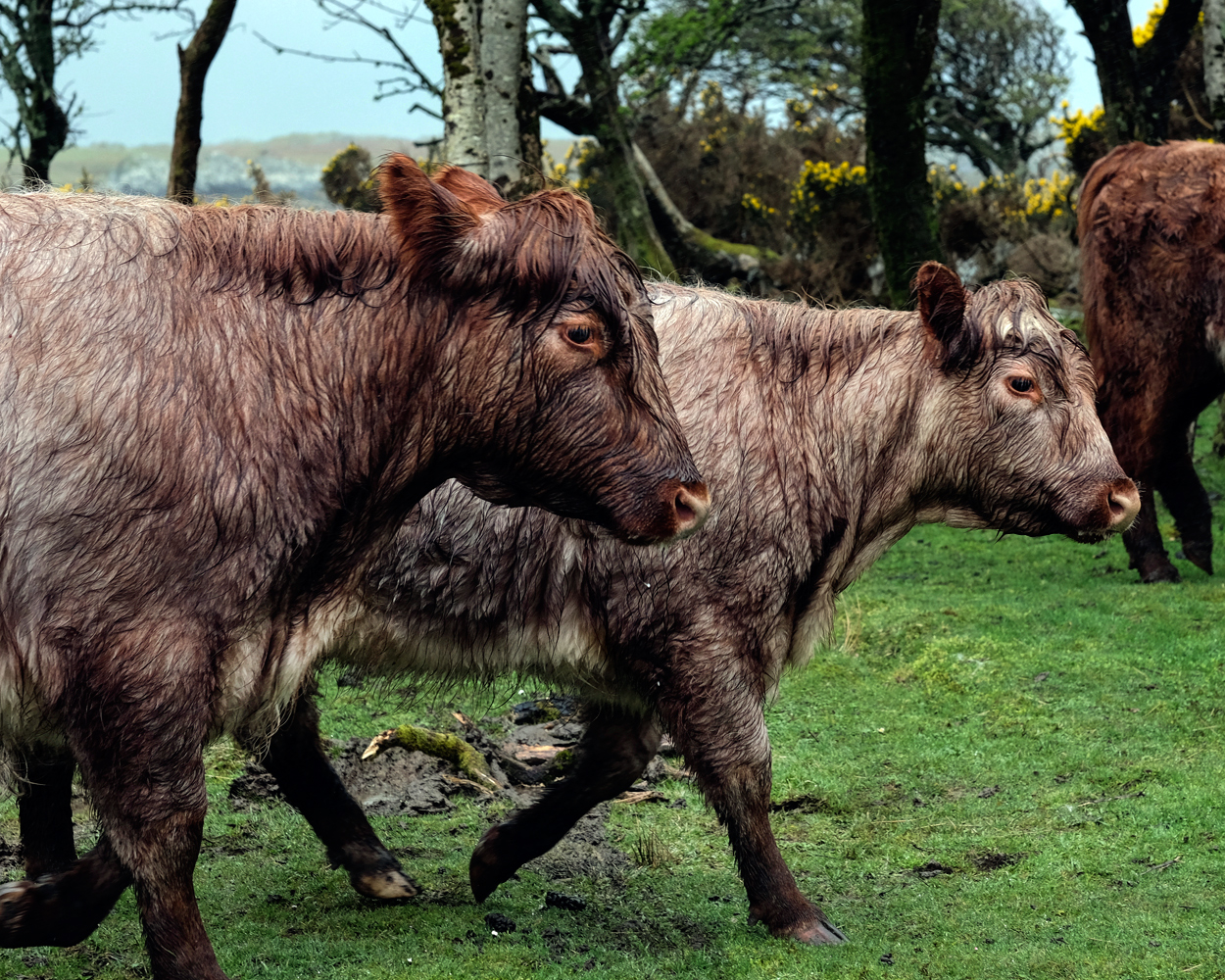 The rain came and went on all days. These cattle were very wet!
The rain came and went on all days. These cattle were very wet!
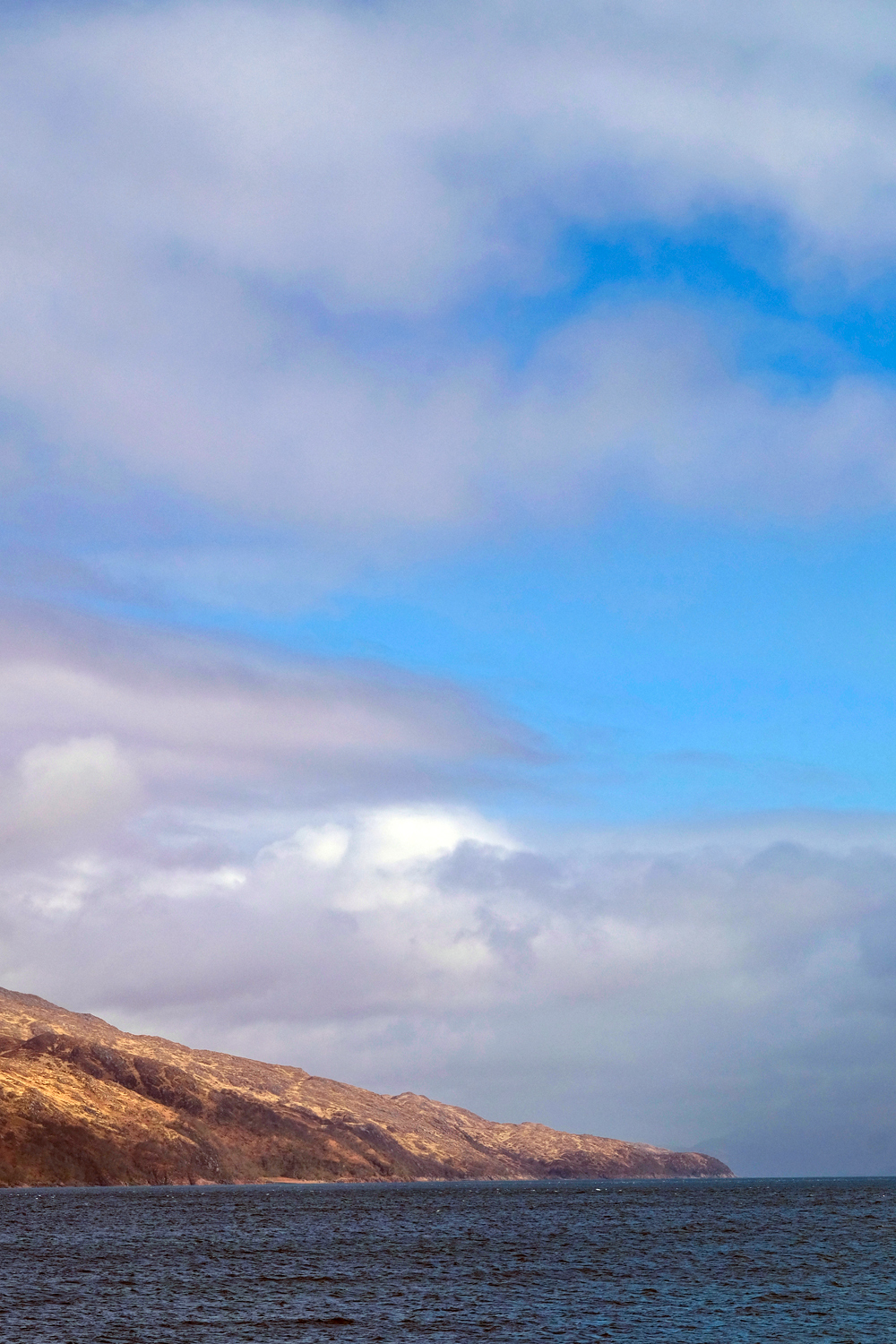 The morning we were leaving the Isle of Mull the weather turned wonderful . . . of course!
The morning we were leaving the Isle of Mull the weather turned wonderful . . . of course!
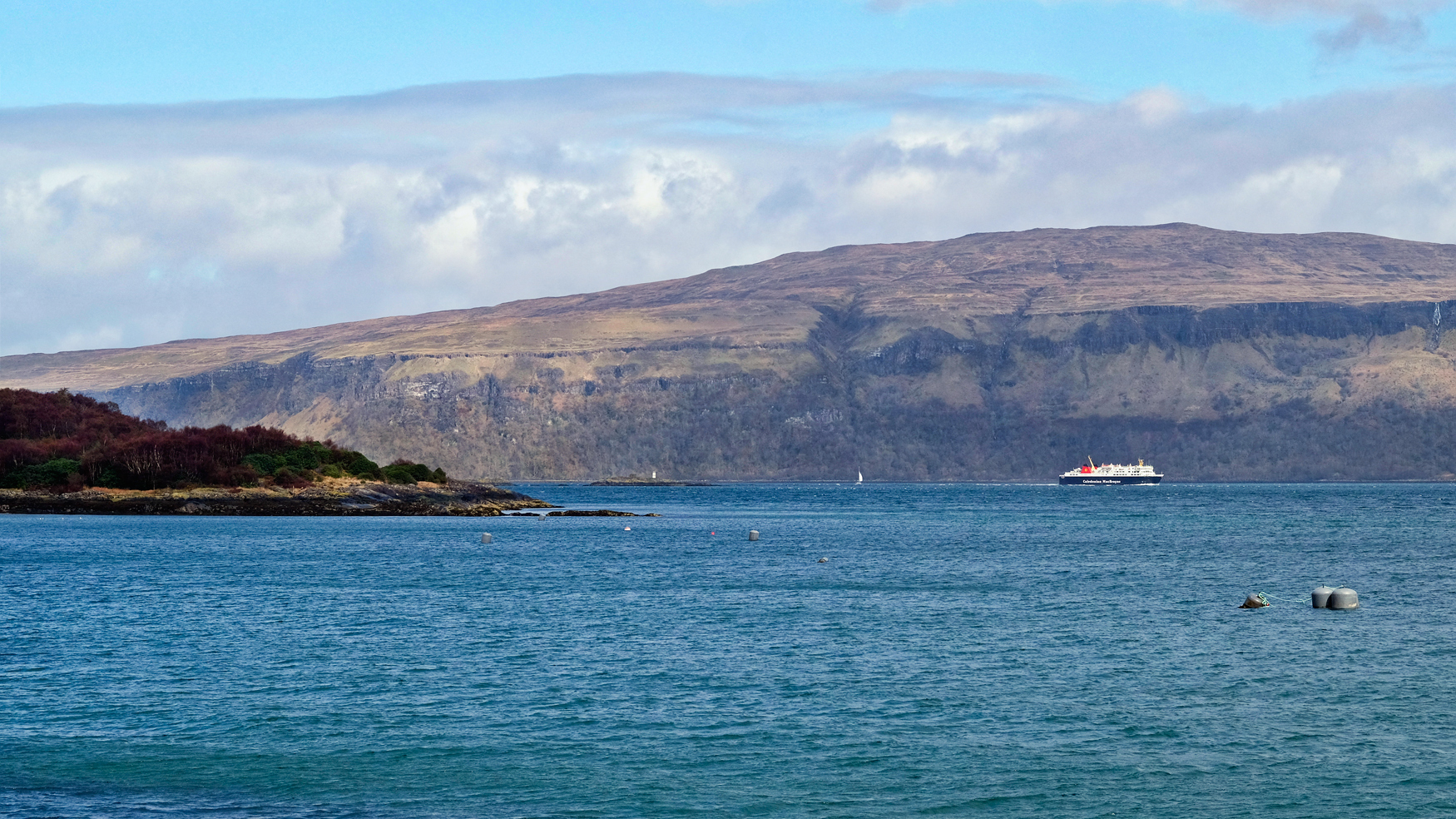 Ships to and from the Outer Hebrides pass through the Sound of Mull. We took one of these ferries there last year.
Ships to and from the Outer Hebrides pass through the Sound of Mull. We took one of these ferries there last year.
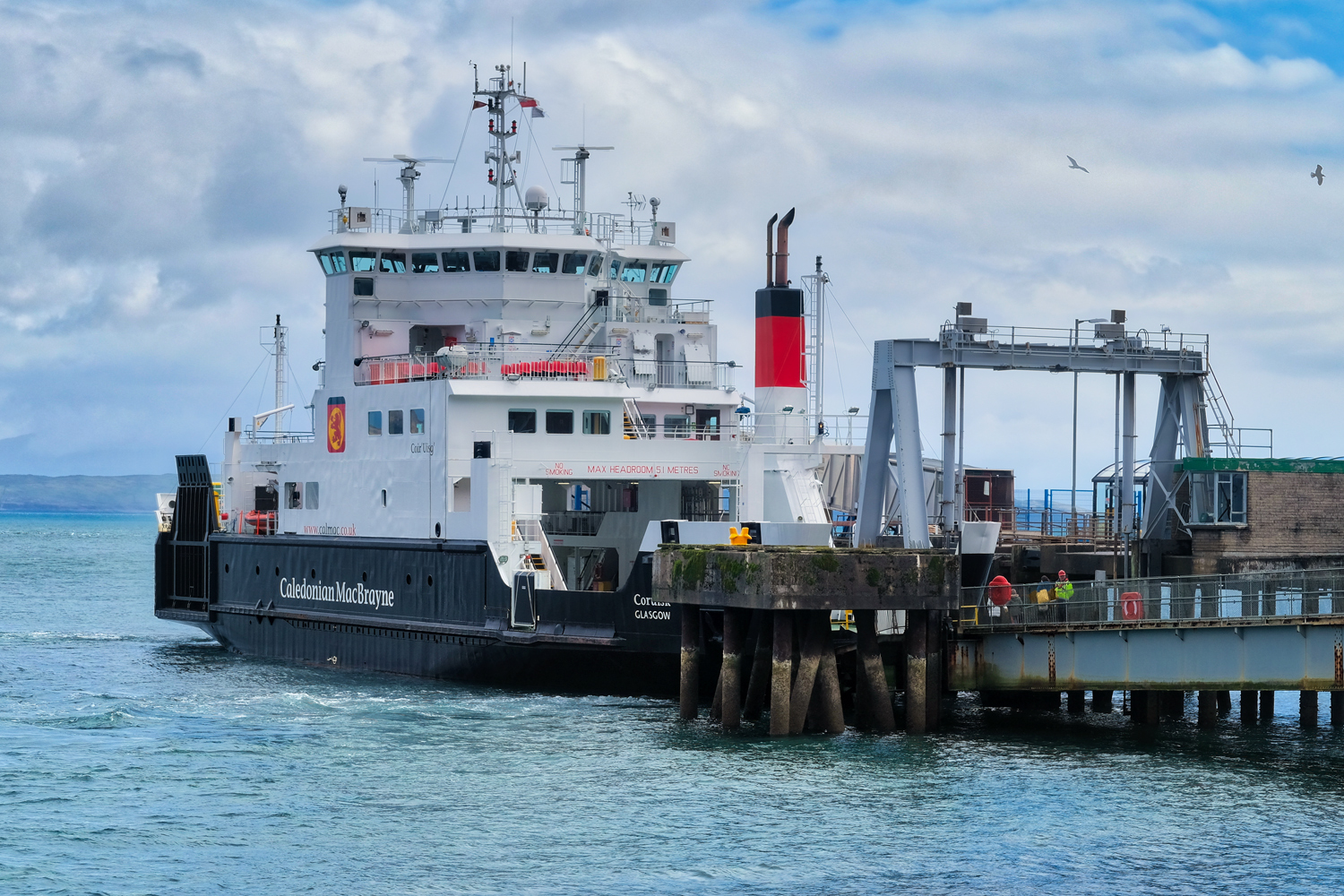 We boarded our ferry back to Oban on a beautiful morning.
We boarded our ferry back to Oban on a beautiful morning.
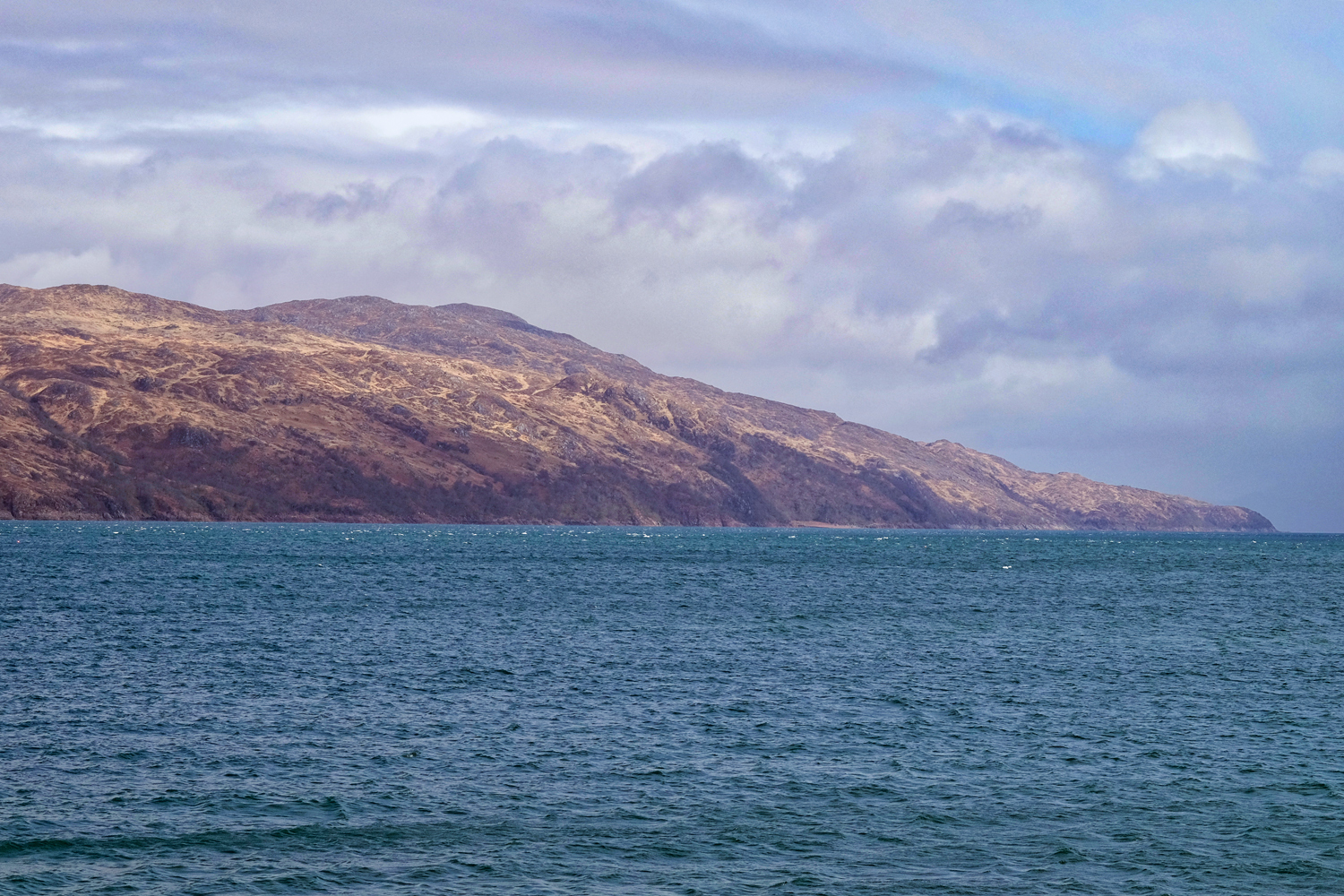 It was a smooth passage home.
It was a smooth passage home.
Scotland - Summer Visitors 2016, Part II
 Saturday, September 3, 2016 at 8:59PM
Saturday, September 3, 2016 at 8:59PM  I always enjoy visitors to my little corner of Scotland. It gives me an excuse to go out and see things I haven't already seen in this beautiful country. I wanted to check out the Crathes Castle Rail Station for a couple of years, and a visit by my buddy from Liverpool provided the excuse. This is the station master, not my visitor.
I always enjoy visitors to my little corner of Scotland. It gives me an excuse to go out and see things I haven't already seen in this beautiful country. I wanted to check out the Crathes Castle Rail Station for a couple of years, and a visit by my buddy from Liverpool provided the excuse. This is the station master, not my visitor.
 The Royal Deeside Railway runs a summer steam train from Crathes to Banchory, only a couple of miles away.
The Royal Deeside Railway runs a summer steam train from Crathes to Banchory, only a couple of miles away.
 I love these old steam engines. The British and Scottish are great restorers and maintainers of these old treasures.
I love these old steam engines. The British and Scottish are great restorers and maintainers of these old treasures.
 All Aboard!
All Aboard!
 We spent a lot of time wandering around the country roads of Aberdeenshire.
We spent a lot of time wandering around the country roads of Aberdeenshire.
 Further up the River Dee are several Victorian-era suspension bridges . . . this one damaged by a huge flood last winter.
Further up the River Dee are several Victorian-era suspension bridges . . . this one damaged by a huge flood last winter.
 Abergeldie Castle was nearly lost to the raging River Dee this year. (The castle is not actually leaning . . . it is a distortion caused by my 10mm lens.)
Abergeldie Castle was nearly lost to the raging River Dee this year. (The castle is not actually leaning . . . it is a distortion caused by my 10mm lens.)
 Finding a gate house along the road usually means there is either a castle of grand manor house nearby.
Finding a gate house along the road usually means there is either a castle of grand manor house nearby.
 Not all country houses are grand . . . not every farmer 'makes it.'
Not all country houses are grand . . . not every farmer 'makes it.'
 Lovely, bucolic rural Scotland on a rare perfect day.
Lovely, bucolic rural Scotland on a rare perfect day.
 One of the sites I wanted to see was the Natural Burial Ground near Alford. Cothiemuir Hill Natural Burial Ground was quite fascinating. People had chosen to be buried not in church or public grounds, but in nature, under the trees. Stones here and there, rocks, and a few plaques marked the burials.
One of the sites I wanted to see was the Natural Burial Ground near Alford. Cothiemuir Hill Natural Burial Ground was quite fascinating. People had chosen to be buried not in church or public grounds, but in nature, under the trees. Stones here and there, rocks, and a few plaques marked the burials.
 The burial grounds were in an especially beautiful forest. I might like this as a burial option.
The burial grounds were in an especially beautiful forest. I might like this as a burial option.
 It was interesting to walk among the ferns looking for markers . . . an exercise in reflecting on our mortality.
It was interesting to walk among the ferns looking for markers . . . an exercise in reflecting on our mortality.
 It's also nice to have visitors so you can have a photograph of yourself once in awhile.
It's also nice to have visitors so you can have a photograph of yourself once in awhile.
_______________________________________________________________________________________________________________
 The next day we headed south, along the old road along the North Sea to the famous fishing village of Arbroath.
The next day we headed south, along the old road along the North Sea to the famous fishing village of Arbroath.
 We walked around the village, ate a fine seafood dinner quay-side, and walked around the old harbour. The air was so still, the water so calm.
We walked around the village, ate a fine seafood dinner quay-side, and walked around the old harbour. The air was so still, the water so calm.
 I have been to Arbroath many times. I always make a point of taking visitors there . . . the sweet pastel buildings and harbour boats are extremely picturesque.
I have been to Arbroath many times. I always make a point of taking visitors there . . . the sweet pastel buildings and harbour boats are extremely picturesque.
 Yes, it is a fishing village and they do have fishing trawlers based here. Those colors! Yes, the colors that day were intense.
Yes, it is a fishing village and they do have fishing trawlers based here. Those colors! Yes, the colors that day were intense.
 Never in my life have I seen such a dramatic sky reflected in the sea! Astonishing!
Never in my life have I seen such a dramatic sky reflected in the sea! Astonishing!
 The strong golden afternoon light played well on the moored fishing boats.
The strong golden afternoon light played well on the moored fishing boats.
 Arbroath Harbour is a living, working harbour. We walked up to the harbour breakwater wall to see what was on the other side . . . .
Arbroath Harbour is a living, working harbour. We walked up to the harbour breakwater wall to see what was on the other side . . . .
 The view from the top of the harbour wall was up the coast of the North Sea to the Angus headlands. What magical light I had that day!
The view from the top of the harbour wall was up the coast of the North Sea to the Angus headlands. What magical light I had that day!
 As it was getting late, we decided to drive back to Aberdeen . . . the late afternoon light on the Angus fields were spectacular. We stopped many times to gape at the view and take photos.
As it was getting late, we decided to drive back to Aberdeen . . . the late afternoon light on the Angus fields were spectacular. We stopped many times to gape at the view and take photos.
 Wild flowers lined the fields and roads.
Wild flowers lined the fields and roads.
 Golden fields of grain fringed by clusters of wild flowers. Ah! Scotland!
Golden fields of grain fringed by clusters of wild flowers. Ah! Scotland!
 Late afternoon golden light, deep shadows.
Late afternoon golden light, deep shadows.
 Lovely daises everywhere.
Lovely daises everywhere.
 Angus field.
Angus field.
 We drove past these scenes for an hour, completely in awe of the beauty.
We drove past these scenes for an hour, completely in awe of the beauty.
MORE TO COME!
Under Construction
Scotland Coastal Villages - Banff and MacDuff
 Tuesday, June 21, 2016 at 4:21AM
Tuesday, June 21, 2016 at 4:21AM  Here I am again . . . tagging along with my wife on her golf tournament. I dropped her off at Duff House Royal Golf Club and set off for a little photographic expedition to the coastal villeges nearby: Banff and MacDuff. This is the village center of Banff.
Here I am again . . . tagging along with my wife on her golf tournament. I dropped her off at Duff House Royal Golf Club and set off for a little photographic expedition to the coastal villeges nearby: Banff and MacDuff. This is the village center of Banff.
 Banff is a very old village. It had its first castle in 1163, build to repel the invading Vikings.
Banff is a very old village. It had its first castle in 1163, build to repel the invading Vikings.
 Banff is a more prosperous village. It was a trading center until the 1770s, when a port was constructed.
Banff is a more prosperous village. It was a trading center until the 1770s, when a port was constructed.
 Banff is built up the side of a rather steel hill that rises up from a broad bay. There are still narrow walking paths that give the only access to quaint cottages.
Banff is built up the side of a rather steel hill that rises up from a broad bay. There are still narrow walking paths that give the only access to quaint cottages.
 A typical 17th century house in Banff.
A typical 17th century house in Banff.
 Banff is a lovely village. It is just big enough to offer all the amenities, but small enough to still feel like a village. I could see living in this house (it's for sale) on street off the bay.
Banff is a lovely village. It is just big enough to offer all the amenities, but small enough to still feel like a village. I could see living in this house (it's for sale) on street off the bay.
 There are a couple of scaled-down 'supermarkets' in Banff, but the downtown is still vibrant, owing to the fact that the nearest mall is 50 miles away.
There are a couple of scaled-down 'supermarkets' in Banff, but the downtown is still vibrant, owing to the fact that the nearest mall is 50 miles away.
 There are several quaint old hotels in town.
There are several quaint old hotels in town.
 I couldn't resist snooping around the fascinating old cemetery . . . right in the middle of the village.
I couldn't resist snooping around the fascinating old cemetery . . . right in the middle of the village.
 I come from a very wet place (Western Oregon in the USA), so I understand this kind of moss.
I come from a very wet place (Western Oregon in the USA), so I understand this kind of moss.
 There were several extraordinary crypts and carved grave covers.
There were several extraordinary crypts and carved grave covers.
 Just so your survivors wouldn't have to wonder what happened to you . . . you put a skull and bones on your grave marker. [Note to self: do not have horizontal grave stone in rainy environment.]
Just so your survivors wouldn't have to wonder what happened to you . . . you put a skull and bones on your grave marker. [Note to self: do not have horizontal grave stone in rainy environment.]
 I decided to walk back through old town Banff toward the sea and the jetty. These are the oldest continuously inhabited buildings in Banff, dating from the mid-14th century.
I decided to walk back through old town Banff toward the sea and the jetty. These are the oldest continuously inhabited buildings in Banff, dating from the mid-14th century.
 Being such a very old village, there were, of course, a few buildings that were in full deterioration. My favorite photo subject!
Being such a very old village, there were, of course, a few buildings that were in full deterioration. My favorite photo subject!
 House number 30.
House number 30.
 I love the story of time and weather written on these old, unattended, doors.
I love the story of time and weather written on these old, unattended, doors.
 House number 32. Nobody home.
House number 32. Nobody home.
 The sea wall at high tide. I followed the wall out to the jetty next to a raging North Sea.
The sea wall at high tide. I followed the wall out to the jetty next to a raging North Sea.
 Crabbing and shrimping pots lined the old stone jetty.
Crabbing and shrimping pots lined the old stone jetty.
 I studied these for a few minutes, imagining myself as a crab, but I couldn't work out how these thing worked.
I studied these for a few minutes, imagining myself as a crab, but I couldn't work out how these thing worked.
 View from the jetty: A broad bay separates Banff from the even smaller village of MacDuff, seen on the horizon. This is where the River Deveron estuary ends in the North Sea.
View from the jetty: A broad bay separates Banff from the even smaller village of MacDuff, seen on the horizon. This is where the River Deveron estuary ends in the North Sea.
 Ther is a small light at the end of the jetty. At high tide the waves occasionally break over sea wall.
Ther is a small light at the end of the jetty. At high tide the waves occasionally break over sea wall.
 I was getting hungry, so I took a different street back to my car. I passed this relic of days gone bye.
I was getting hungry, so I took a different street back to my car. I passed this relic of days gone bye.
 I often ask myself, what is it about old doors that compel me to take a photograph? Something about mortality, I believe.
I often ask myself, what is it about old doors that compel me to take a photograph? Something about mortality, I believe.
 I made my way back to the village center and then on up the steep hill to a nice cafe and had a bowl of Cullen Skink, a scone, and a cup of coffee.
I made my way back to the village center and then on up the steep hill to a nice cafe and had a bowl of Cullen Skink, a scone, and a cup of coffee.
 After lunch I decided to find the castle whose sign I saw driving in. My GPS said there was a castle only four miles away. I ended up on this gravel road through a beautiful wood.
After lunch I decided to find the castle whose sign I saw driving in. My GPS said there was a castle only four miles away. I ended up on this gravel road through a beautiful wood.
 I knew I was getting close to a castle when I started to see the old outbuildings.
I knew I was getting close to a castle when I started to see the old outbuildings.
 I love these old abandoned stone houses. I have a fantasy each time of fixing it up and living in it.
I love these old abandoned stone houses. I have a fantasy each time of fixing it up and living in it.
 Now I knew I was getting close . . . a castle gate house . . . and occupied too.
Now I knew I was getting close . . . a castle gate house . . . and occupied too.
 AH! There it is. A castle through the trees. I was not sure if this particular castle was occupied by the laird, or was open to the public. I was a little concerned someone would run our and yell at me that I was trespassing.
AH! There it is. A castle through the trees. I was not sure if this particular castle was occupied by the laird, or was open to the public. I was a little concerned someone would run our and yell at me that I was trespassing.
 I stayed back in the trees, just in case . . .
I stayed back in the trees, just in case . . .
 Magnificent and stately Craigston Castle, built in 1604. As it turns out, you can stay in this castle as a "luxury self-catering vacation home." No kidding. You can make a booking here.
Magnificent and stately Craigston Castle, built in 1604. As it turns out, you can stay in this castle as a "luxury self-catering vacation home." No kidding. You can make a booking here.
 I left the castle for a short drive to the harbour village of MacDuff. We stayed in this village right after we moved to Scotland. In fact, it was the first over night stay we made.
I left the castle for a short drive to the harbour village of MacDuff. We stayed in this village right after we moved to Scotland. In fact, it was the first over night stay we made.
 MacDuff has a proper shipyard for refitting fishing boats.
MacDuff has a proper shipyard for refitting fishing boats.
 Shipyards are visually intereting places. What in the world are these sharpened steel 'blades' used for? I have no idea.
Shipyards are visually intereting places. What in the world are these sharpened steel 'blades' used for? I have no idea.
 The rust was thick, but the pattern and color was captivating.
The rust was thick, but the pattern and color was captivating.
 Nice clean and newly painted fishing boats. I got lucky as the sun finally came out in the afternoon.
Nice clean and newly painted fishing boats. I got lucky as the sun finally came out in the afternoon.
 I could have stayed all day in the MacDuff shipyards, but my wife called to say her round was over. Great idea to affix these benches inside the seawall.
I could have stayed all day in the MacDuff shipyards, but my wife called to say her round was over. Great idea to affix these benches inside the seawall.
 We drove on the A947 back to Aberdeen. We passed a sign for Fyvie Castle . . . and I couldn't resist going in. My wife hadn't been before.
We drove on the A947 back to Aberdeen. We passed a sign for Fyvie Castle . . . and I couldn't resist going in. My wife hadn't been before.
 Fyvie castle is a proper castle. Built in 1211, Fyvie was the site of an open-air court held by Robert the Bruce, and Charles I lived there as a child.
Fyvie castle is a proper castle. Built in 1211, Fyvie was the site of an open-air court held by Robert the Bruce, and Charles I lived there as a child.
 Fyvie Castle was closed, but the vast grounds and gardens were opened. I will post more from the fabulous gardens soon.
Fyvie Castle was closed, but the vast grounds and gardens were opened. I will post more from the fabulous gardens soon.
Gardenstown and Pennan - Scottish North Coast Seaside Villages
 Wednesday, February 4, 2015 at 5:40PM
Wednesday, February 4, 2015 at 5:40PM  We took a late November 2014 day trip to see the quaint seaside villages of Gardenstown and Pennan.
We took a late November 2014 day trip to see the quaint seaside villages of Gardenstown and Pennan.
 The quaint village of Pennan, Scotland hugs the North Sea. It's hard to believe that such beautiful places exist!
The quaint village of Pennan, Scotland hugs the North Sea. It's hard to believe that such beautiful places exist!
 Only one fishing boat left in the Pennan harbour.
Only one fishing boat left in the Pennan harbour.
 A dark and stormy morning in Pennan.
A dark and stormy morning in Pennan.
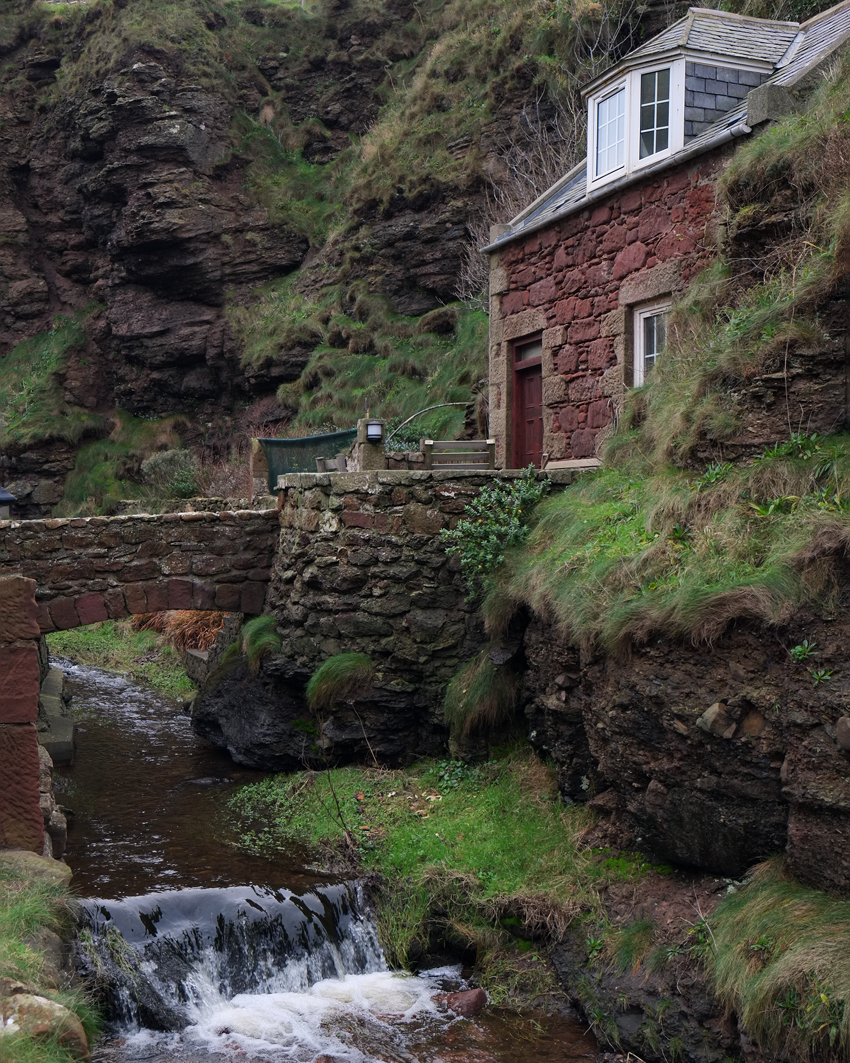 Tucked in behind the village was a remarkable cottage. Amazing! I want to live here! There was a small inn in Pennan (closed) that we vowed to stay in come Spring.
Tucked in behind the village was a remarkable cottage. Amazing! I want to live here! There was a small inn in Pennan (closed) that we vowed to stay in come Spring.
 We drove along the narrow country lanes of north Aberdeenshire.
We drove along the narrow country lanes of north Aberdeenshire.
 We followed the road signs to down a steep hill to Gardenstown.
We followed the road signs to down a steep hill to Gardenstown.
 I loved these Gardenstown fishermens' sheds.
I loved these Gardenstown fishermens' sheds.
 Gardenstown is still a fishing community, but most of its income now comes from tourism and movie production (the TV series The Barons was filmed here).
Gardenstown is still a fishing community, but most of its income now comes from tourism and movie production (the TV series The Barons was filmed here).
 All of Gardenstown's streets ran down to the sea.
All of Gardenstown's streets ran down to the sea.
 A picture perfect seaside village.
A picture perfect seaside village.
 We walked out to the edge of Gardenstown to take in the view looking East - before returning to the town for a drink.
We walked out to the edge of Gardenstown to take in the view looking East - before returning to the town for a drink.
 The pub company was good at the 18th century Garden Arms Hotel.
The pub company was good at the 18th century Garden Arms Hotel.
 We drove further west along the north coast to McDuff, where we stopped for a late lunch/early dinner. It was a wonderful day on the stormy Scottish coast.
We drove further west along the north coast to McDuff, where we stopped for a late lunch/early dinner. It was a wonderful day on the stormy Scottish coast.
